Allison Collection Photos
November, 1943

Named for His Favorite, 11/28/1943. Somewhere in Italy – “Bull of the Woods” is the favorite comic strip character of Private Robert Coba of Pittsburg, Kansas, so he gave that name to the Jeep he drives around the Italian front. Here, the soldier wipes mud from the little car that has seen service in Africa as well as Italy. Credit: (Photo by Bert Brandt, AMCE, photographer for War Picture Pool);
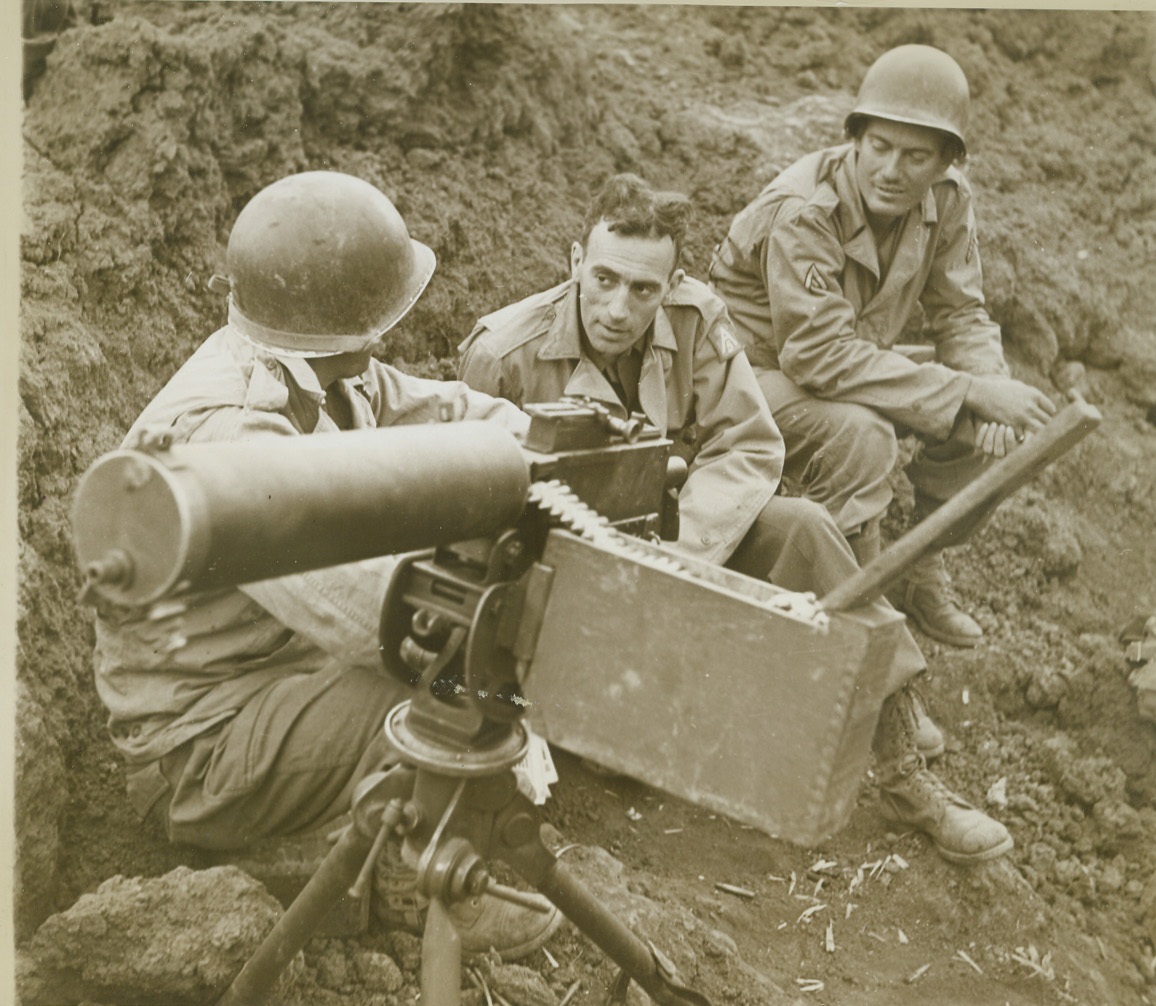
Frontline Interview, 11/23/1943. With the 5th Army in Italy – Cy Korman, (center) Chicago Tribune war correspondent, interviews members of a frontline machine gun post, located in a ten-foot-deep shell crater along the Italian Front. At right is Pfc. Raymond Kubilek, of Vernon, Texas. At left, is Pvt. Frederick Stewart, Hictonville, Ind. Credit: (ACME Photo by Bert Brandt for the War Picture Pool);

Fighting Girls of the Royal Navy, 11/23/1943. England – Cheered on by the crew of a British sub, pretty, hard-working Wrens wheel out a tin fish for a submarine that is soon to go on patrol. By working on torpedo maintenance, the British Navy women release many fighting men formerly tied to bench and workshop jobs. Credit: (ACME);
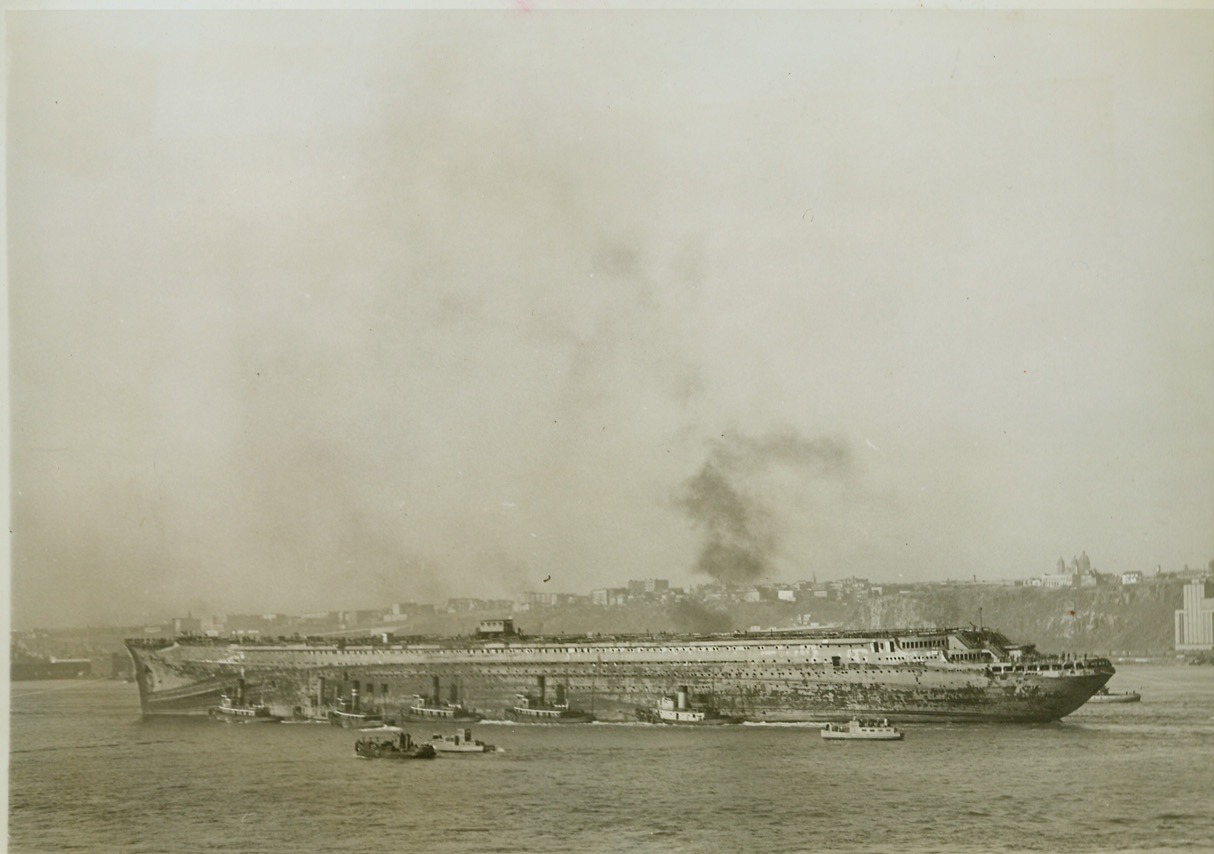
GHOST OF FORMER SELF, 11/3/1943. NEW YORK – Her superstructure removed, the U.S.S. Lafayette, formerly the French Luxury Liner Normandie, is towed down the Hudson River, Nov. 3, en route to drydock at an undisclosed destination. It is the first time the ship left her pier in four years. Time can only tell the next chapter in the life of the great liner. Credit: OWI Radiophoto from ACME;
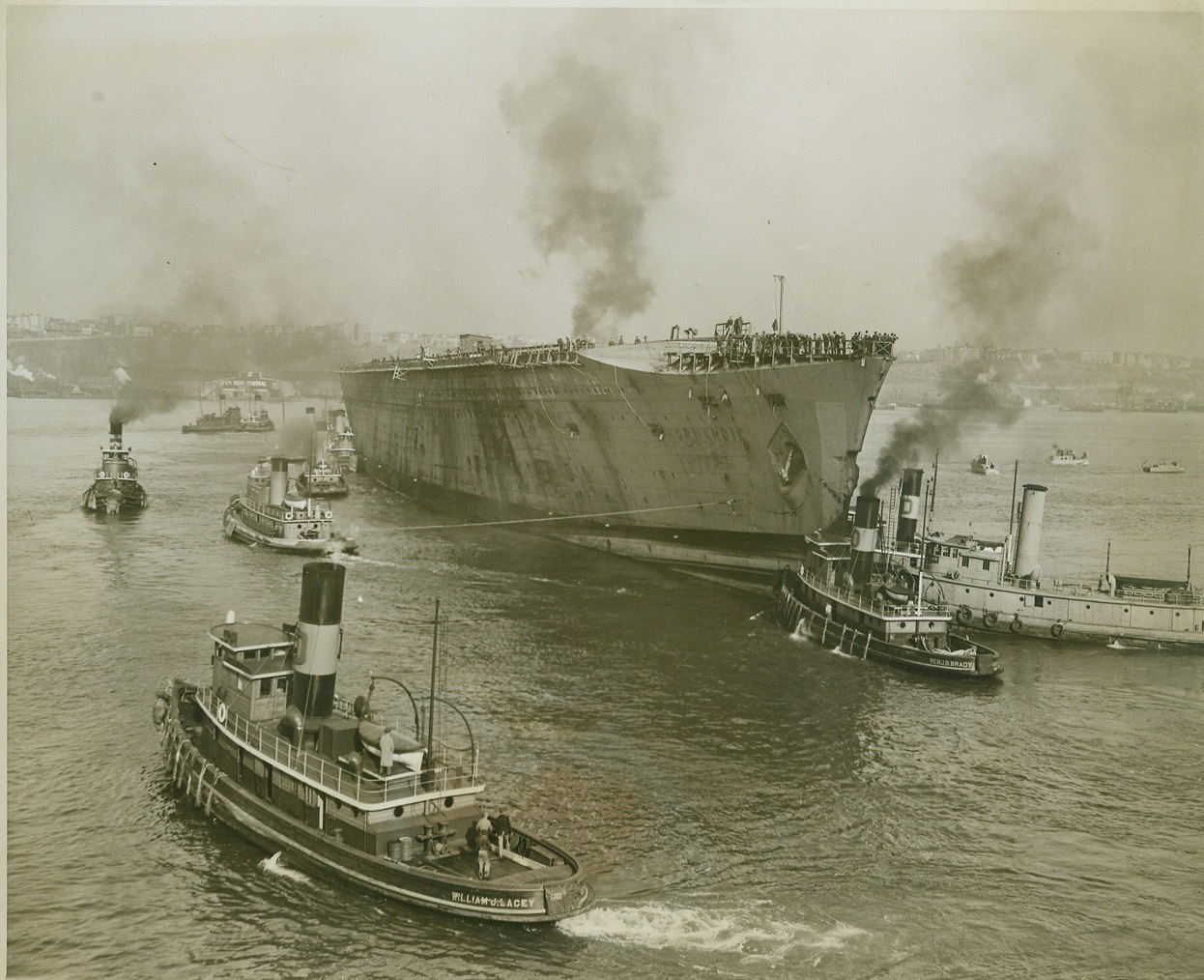
NORMANDIE HEADS FOR DRYDOCK, 11/3/1943. NEW YORK – Twenty tugs pushed and tugged the giant U.S.S. Lafayette, the former French luxury liner Normandie, down the North River when the vessel left its pier for the first time in four years, Nov. 3. Seized by the U.S. Government, almost destroyed by fire, capsized at her dock and later refloated, the great grey ship is en route to drydock at an undisclosed destination. Credit: OWI Radiophoto from ACME;
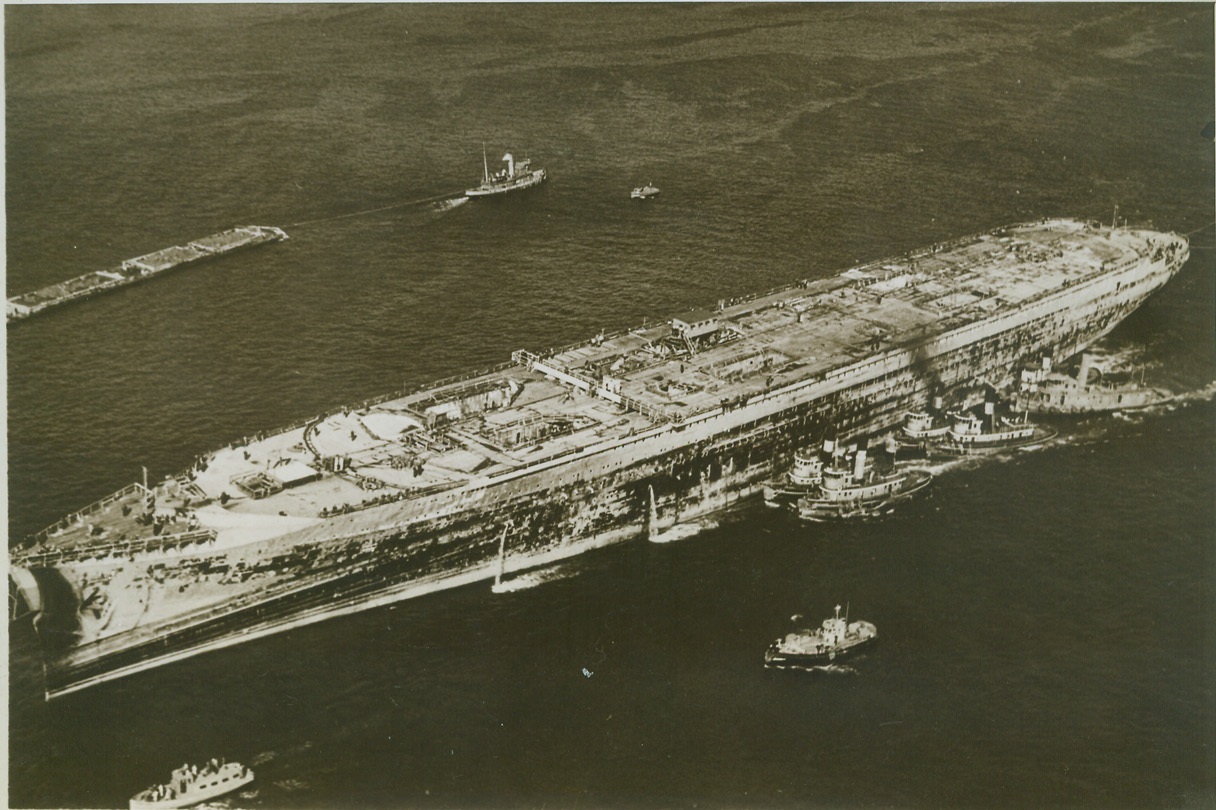
THE NORMANDIE SAILS ONCE MORE, 11/3/1943. NEW YORK, N.Y. – Her hull scarred and blackened by the fire that almost destroyed her, and her graceful superstructure gone, the U.S.S. Lafayette, formerly the French liner Normandie is towed down through New York’s Lower Bay by almost a score of puffing tugs. The vessel is on her way to drydock at an undisclosed point, where she will be refitted as a Naval Auxiliary. Credit: OWI Radiophoto from ACME;
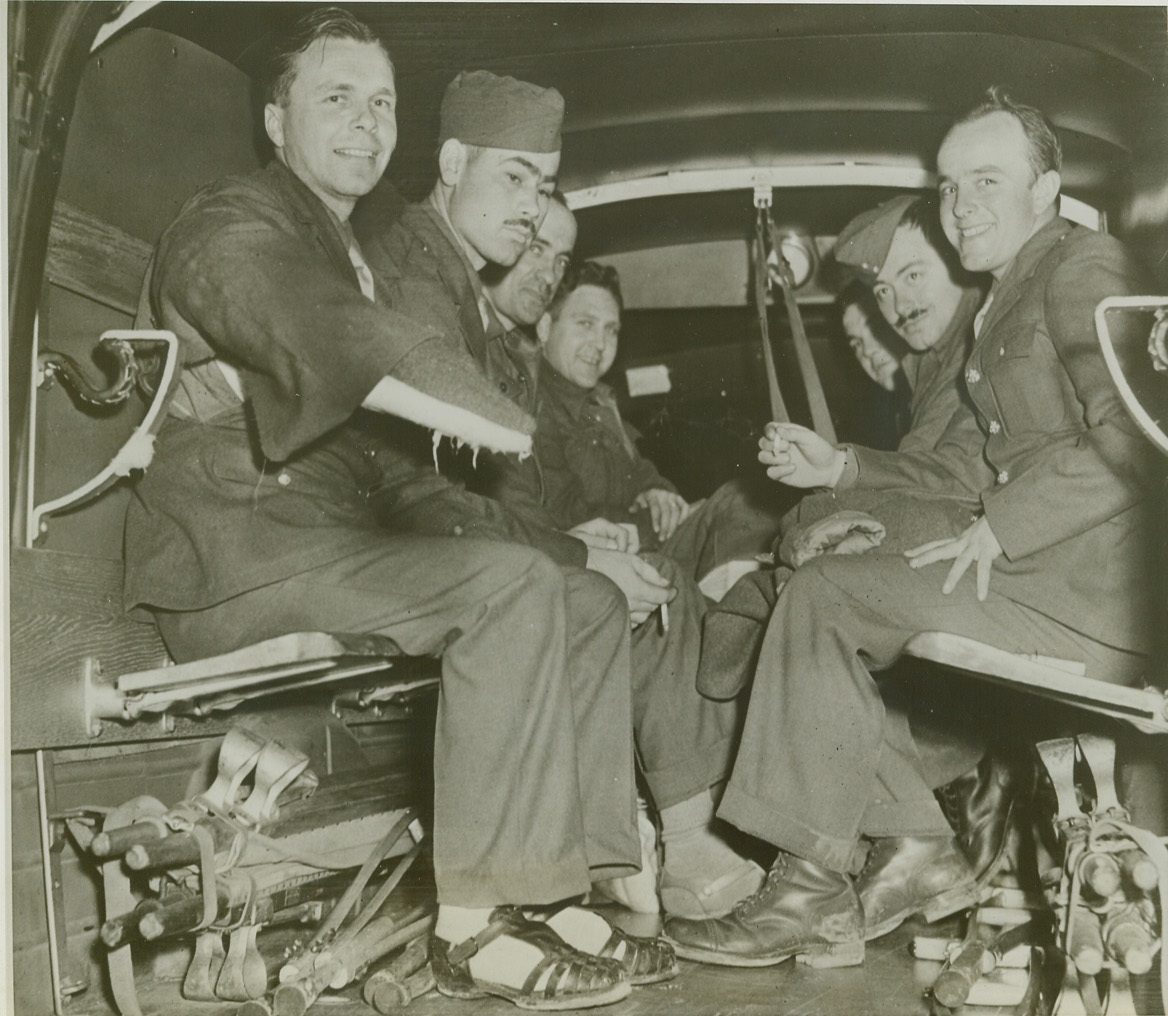
FIRST AMERICAN WOUNDED REPATRIATED FROM GERMANY, 11/2/1943. WASHINGTON, D.C. – Fourteen wounded American soldiers, the first to be repatriated from Germany under an agreement for the exchange of sick and wounded prisoners, arrived by plane at the National Airport and were immediately transferred to Walter Reed Hospital. Shown in the ambulance at the airport-left to right: Sgt. Edwin N. Nelson, Marshall, Minn.; Pvt. Robert M. Scott, Greensboro, N.C.; Staff Sgt. Lester F. Miller, Hartford, CT.; Tech. Sgt. John H. Gardner, Yoakum, Texas; Staff Sgt. Norman C. Goodwin, Bradford, Mass.; Tech. Sgt. Frank J. Bartnicki, Baltimore, MD.; and Pfc. Herbert L. Ehrich, Brooklyn, N.Y. Credit: U.S. Army photo via OWI Radiophoto from ACME;
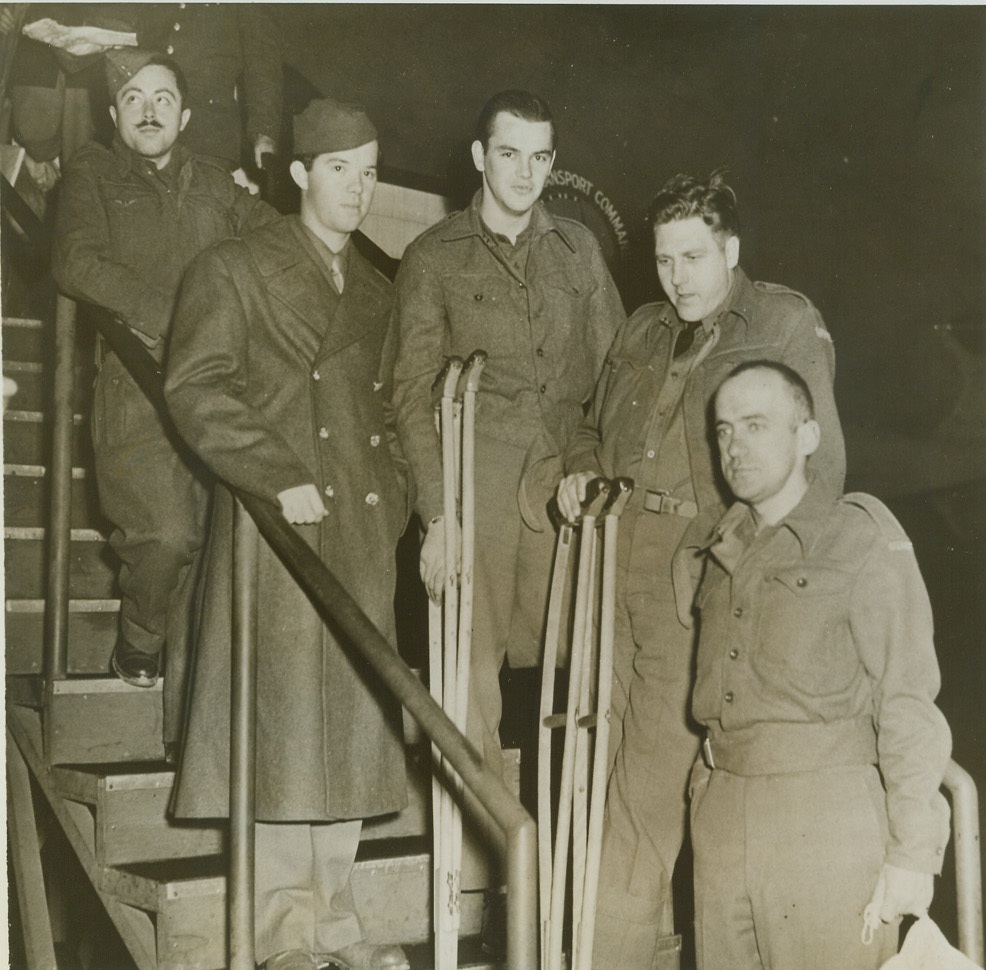
FIRST AMERICAN WOUNDED REPATRIATED FROM GERMANY, 11/3/1943. WASHINGTON, D.C. – Fourteen wounded American soldiers, the first to be repatriated from Germany under an agreement for the exchange of sick and wounded prisoners, arrived by plane at the National Airport and were immediately transferred to Walter Reed Hospital. At the airport on arrival are (left to right) T/Sgt. Frank J. Bartnicki, Baltimore, MD.; S/Sgt. Milton K. Williams, St. Louis, MO., S/Sgt. Norman C. Goodwin, Bradford, Mass.; T/Sgt. John H. Garder, Yoakum, Tex.; and S/Sgt. Lester F. Miller, Hartford, Conn. Credit: U.S. Army photo via OWI Radiophoto from ACME;
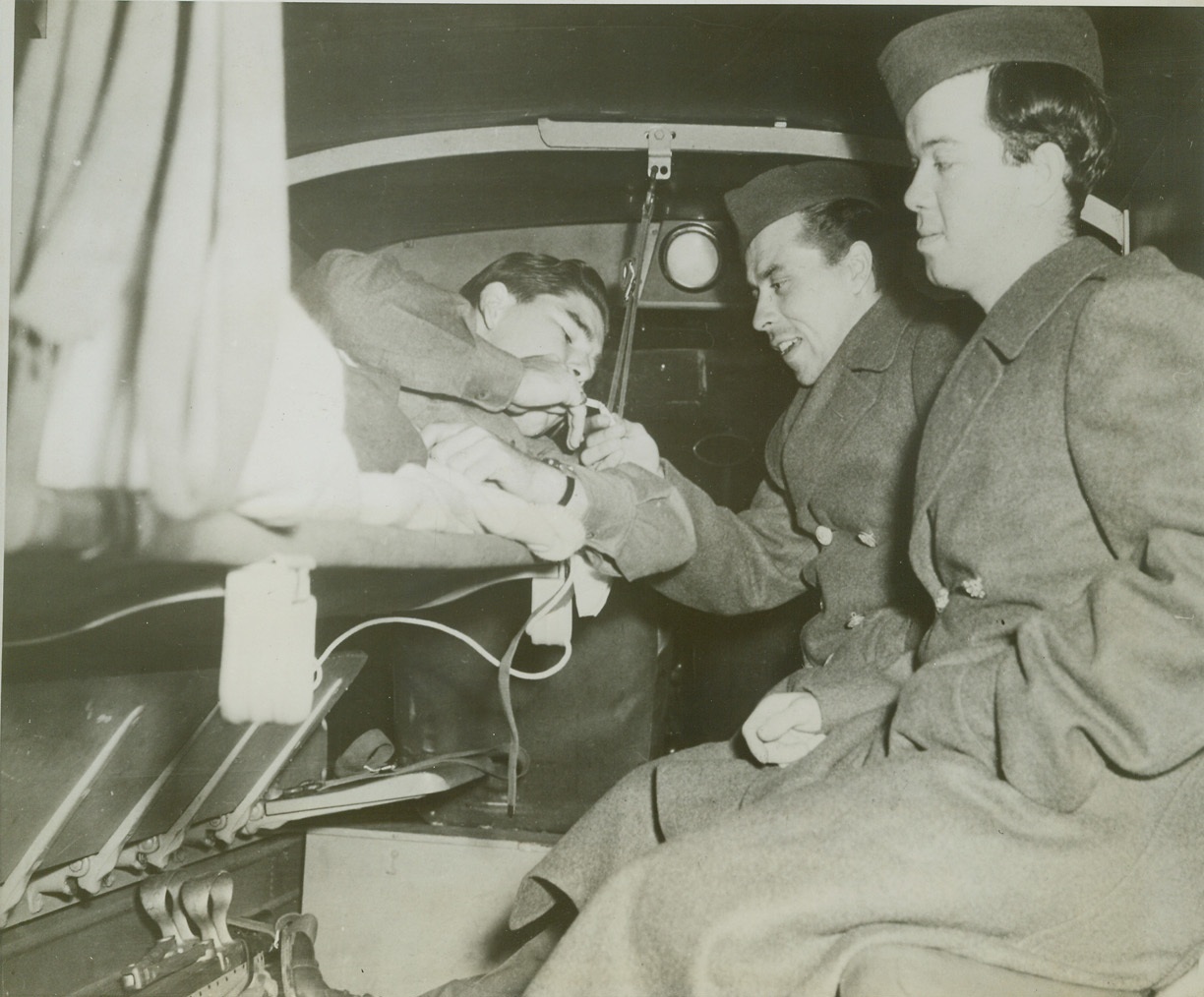
FIRST AMERICAN WOUNDED REPATRIATED FROM GERMANY, 11/2/1943. WASHINGTON, D.C. – Fourteen wounded American soldiers, the first to be repatriated from Germany under an agreement for the exchange of sick and wounded prisoners, arrived by plane at the National Airport and were immediately transferred to Walter Reed Hospital. Staff Sgt. August E. Tornow, of Springfield, Ore., (center) lights a cigarette for Corporal Rodney M. Graham, (left) of Atoka, Okla., as Tech Sgt. John H. Gardner, Yoakum, Texas, (right) looks on. Credit: U.S. Army photo via OWI Radiophoto from ACME;
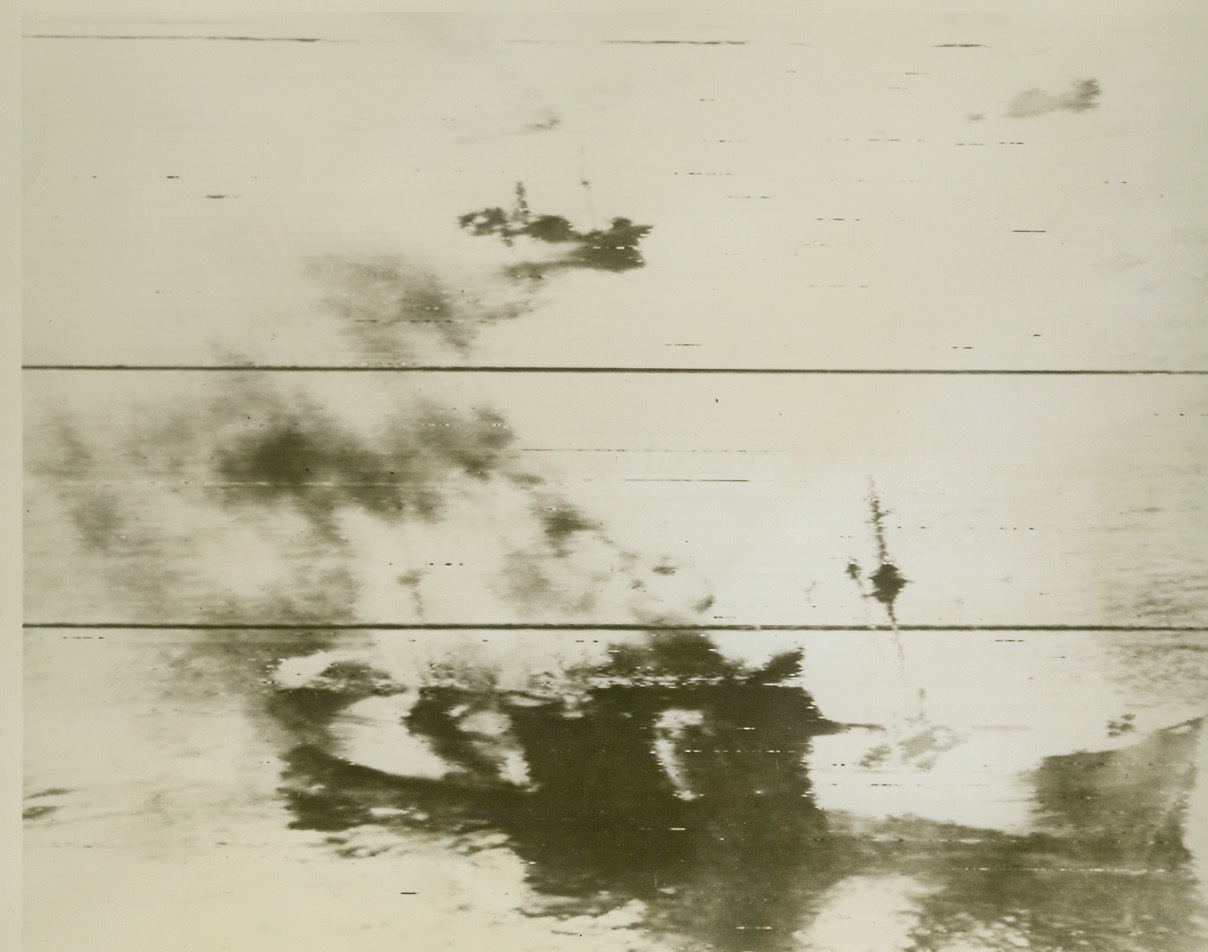
RABAUL BLASTED AGAIN, 11/4/1943. Two Jap cargo vessels blaze furiously in Rabaul Harbor after American airmen smashed at the powerful Nip New Britain base, recently, in one of a series of raids which are neutralizing Jap power in the area. Last Tuesday, the Yank fliers struck the Rabaul base again, damaging or destroying 26 ships, including five warships, and blasting 108 planes. Our losses were 19 planes. Credit: U.S. Signal Corps radiotelephoto from ACME;
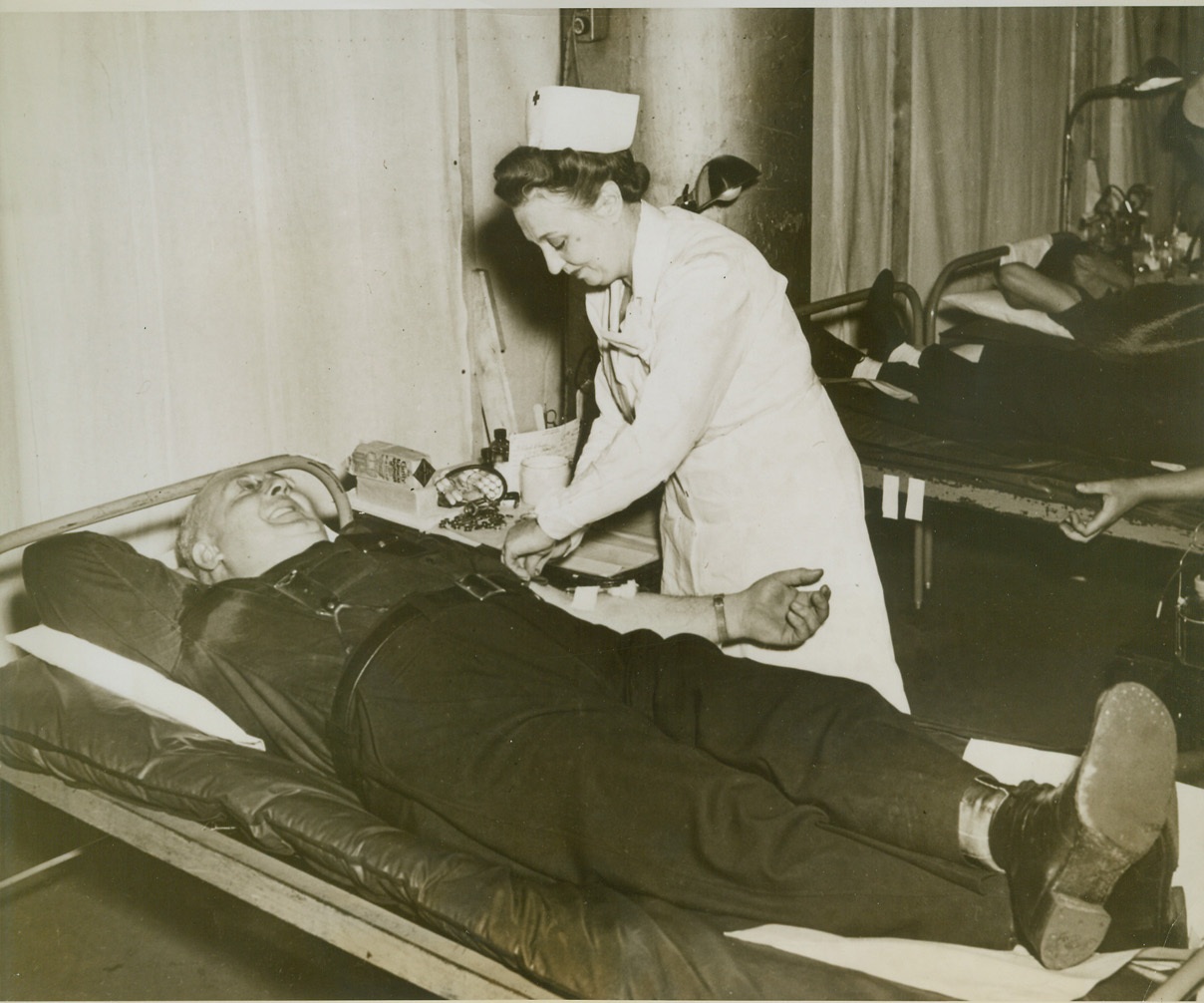
REUNION AT A BLOOD BANK, 11/10/1943. DETROIT, MICH. – When Karl Miller came to the Red Cross Blood Bank Mobile Unit to give his donation he found Nurse Freida Schaub in attendance. The two had worked at the same base hospital in Scouilly, France, during the First World War. They are shown in the Mobile Unit as it stopped at the Hudson Motor Car Co. Detroit Plant. Credit: ACME;

INSIGNIA OF HEROES, 11/26/1943. Here is the new insignia of the U.S. 14th Air Force, serving in China under Maj. General Claire L. Chennault. Designed by S/Sgt. Howard M. Arnegard of Hillsboro, N.D., the patch shows a winged, rampaging Bengal Tiger, topped by the star of the U.S.A.A.F. The new insignia soared over Japan yesterday (Nov. 25th) when American and Chinese bombers and fighters paid a destructive visit to the Jap Airdrome at Shinchiku, on Formosa. Credit: OWI Radiophoto from ACME;
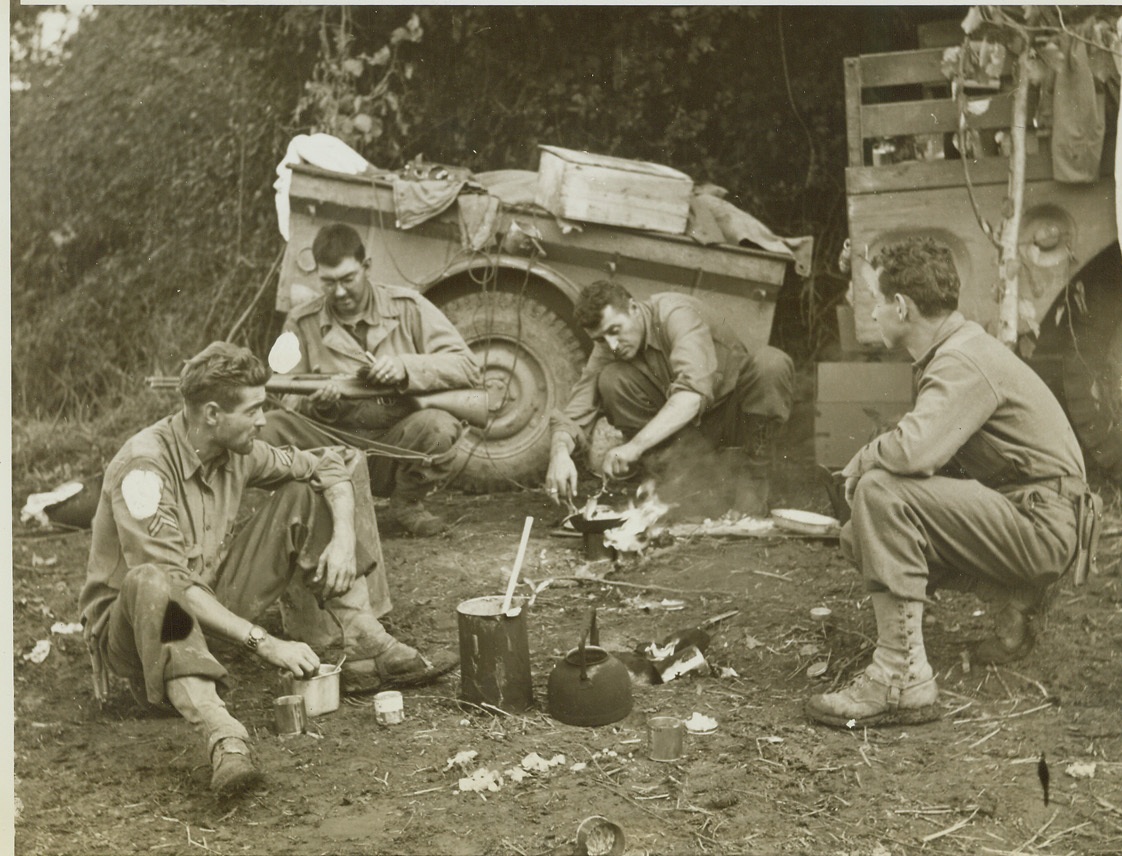
A Snack at the Front., 11/8/1943. PIETRAVAIRANO, ITALY - It may not be eight-course dinner at the Ritz, but this snack cooked over a campfire near the front, tastes just as good to these U.S. Infantrymen. Left to right, are: Pfc. Stanley Machinski, of Toledo, Ohio; Pvt. Alvin Kennedy, Harrisonburg, VA., who uses part of his lunch hour to clean his gun; Pvt. Harvey Craig, Stigler, Ohio; and Corp. Gerald Gould, of Seattle, Wash. (Passed by Censors). Credit: ACME photo by Bert Brandt for the War Picture Pool;

American Dead in Italy, 11/9/1943. CASERTA, ITALY – Sgt. R. Strebe, of Washington state, checks the identification of the bodies of these American soldiers, who were killed in the fighting on the outskirts of Caserta.;
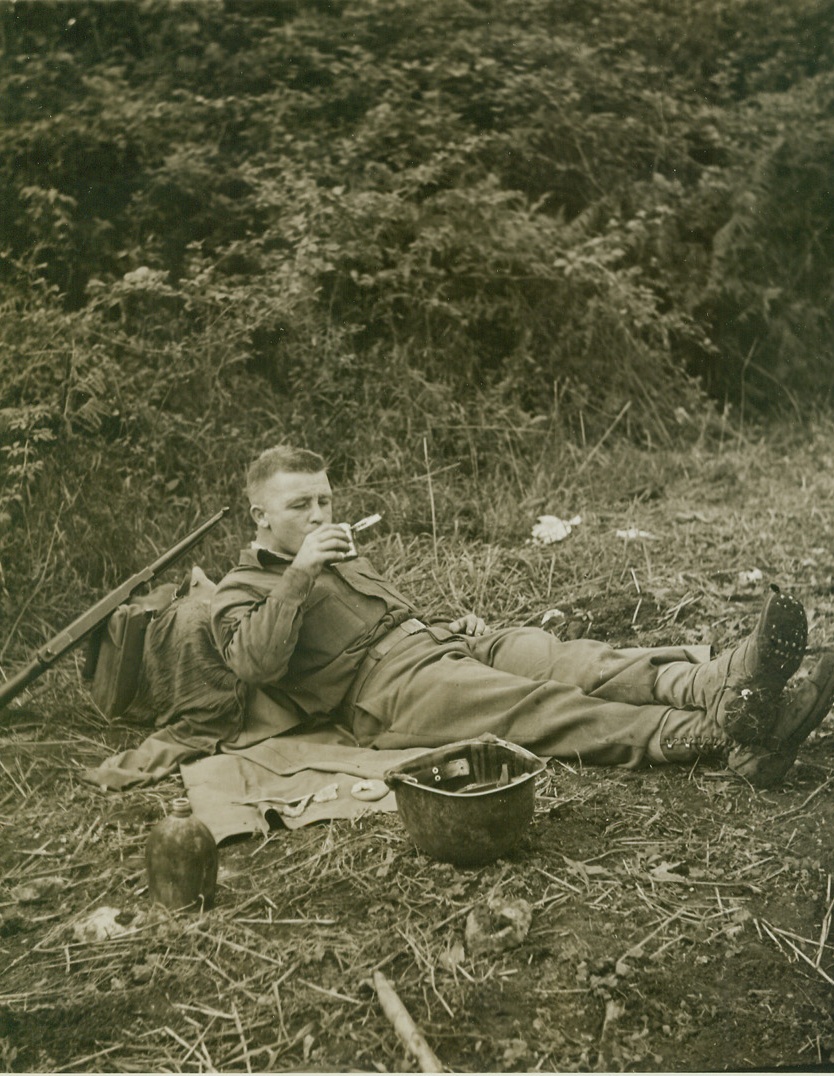
Some Like It Cold, 11/8/1943. ITALY – Though many members of a U. S. infantry regiment making a half-hour stop for lunch near Pietravairano heated their rations before having their noon-time meal, Sgt. James Schwartz, Lorane, PA., preferred to have his food cold. He drinks some cold chocolate beverage which he’s mixed in a empty C-ration can, the contents of which he’s just eaten cold.Credit—WP—(ACME PHOTO by Bert Brandt, war pool photographer );
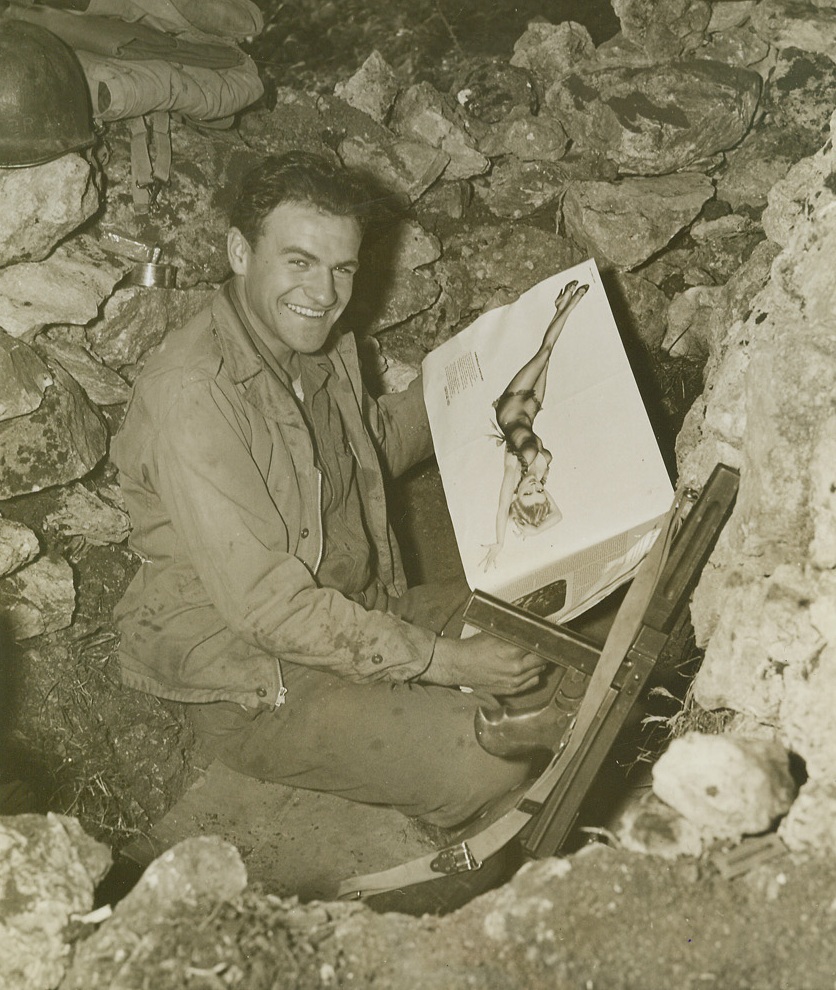
One Vote For the Varga Miss, 11/27/1943. SOMEWHERE IN ITALY -- While the Varga Girl controversy rages back home, a Yank in a foxhole opens his October issue of Esquire which has just arrived, and turns immediately to the drawing of the luscious lady. By his expression, PVT. Richard Oster of Greely, Colo., casts a vote in the Varga girl’s favor. That happy smile, symbol of soaring morale, ought to convince a deliberating post office board where its decision should lie.Credit:-- WP—(Photo by Bert Brandt ACME);
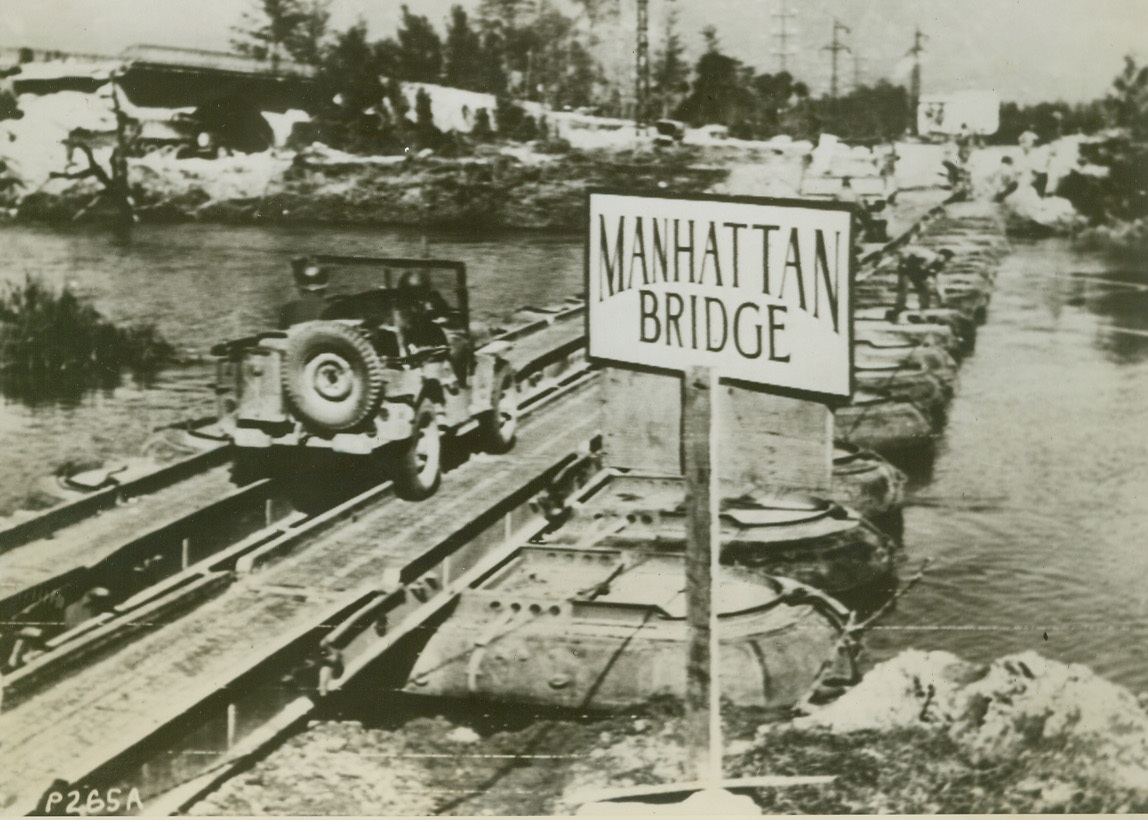
A BIT OF OLD NEW YORK, 11/5/1943. ITALY—This “Manhattan Bridge” is…from its name-sake that crosses the…The pontoon version spans the Vol…is sturdy enough to be used by…To the left may be seen the…original stone bridge, east of…demolished by the retreating…Credit: Acme photo by Bert…War Picture Pool via Army…;
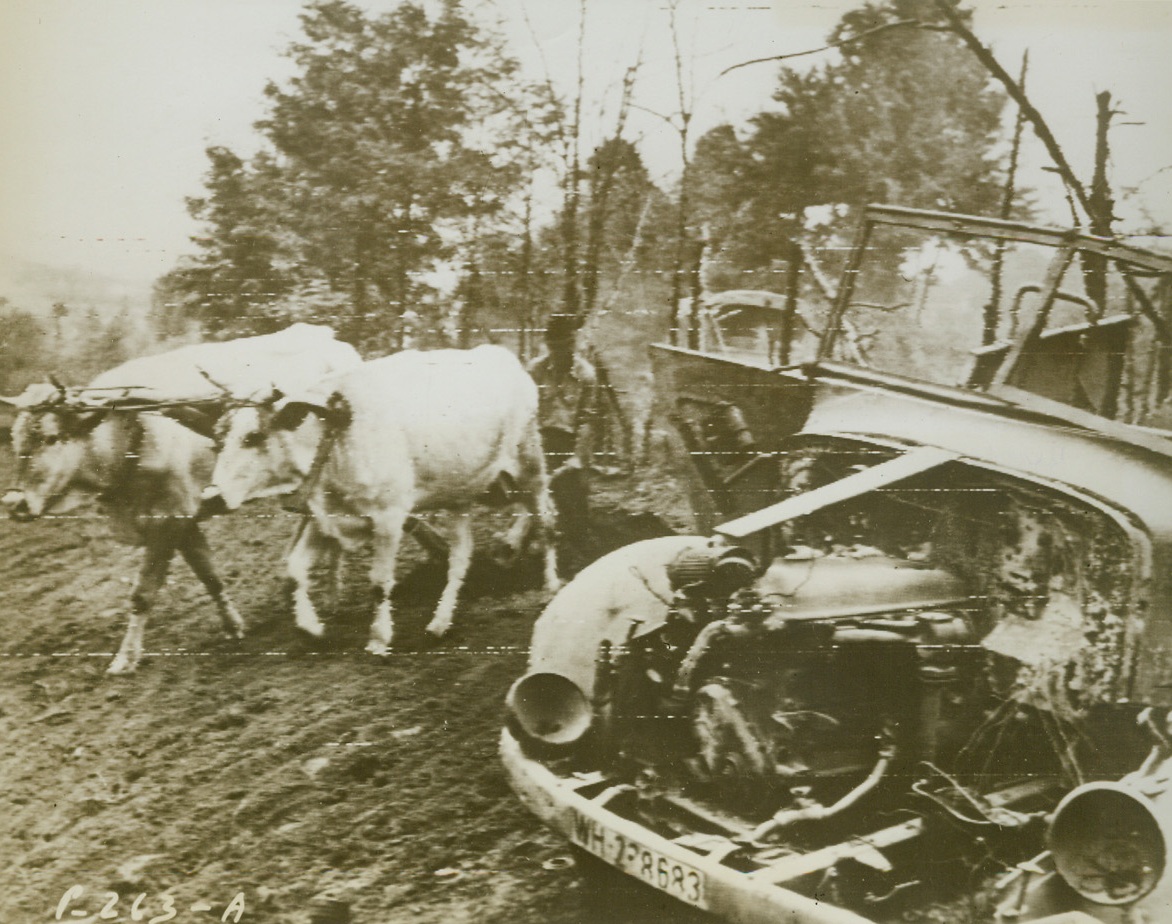
BUSINESS “AS USUAL”, 11/4/1943. An Italian farmer, whose land has been cleared of Germans by the Allies, wastes no time in getting about the all-important business of producing food. Not even the wreckage ofa blasted Nazi troop carrier, (right), deters him from his work. Somehow, the devastation of battle has spared him his two white oxen, which pull his plow.Credit: Acme photo by Bert Brandt for the War Picture Pool via Army radiotelephoto;
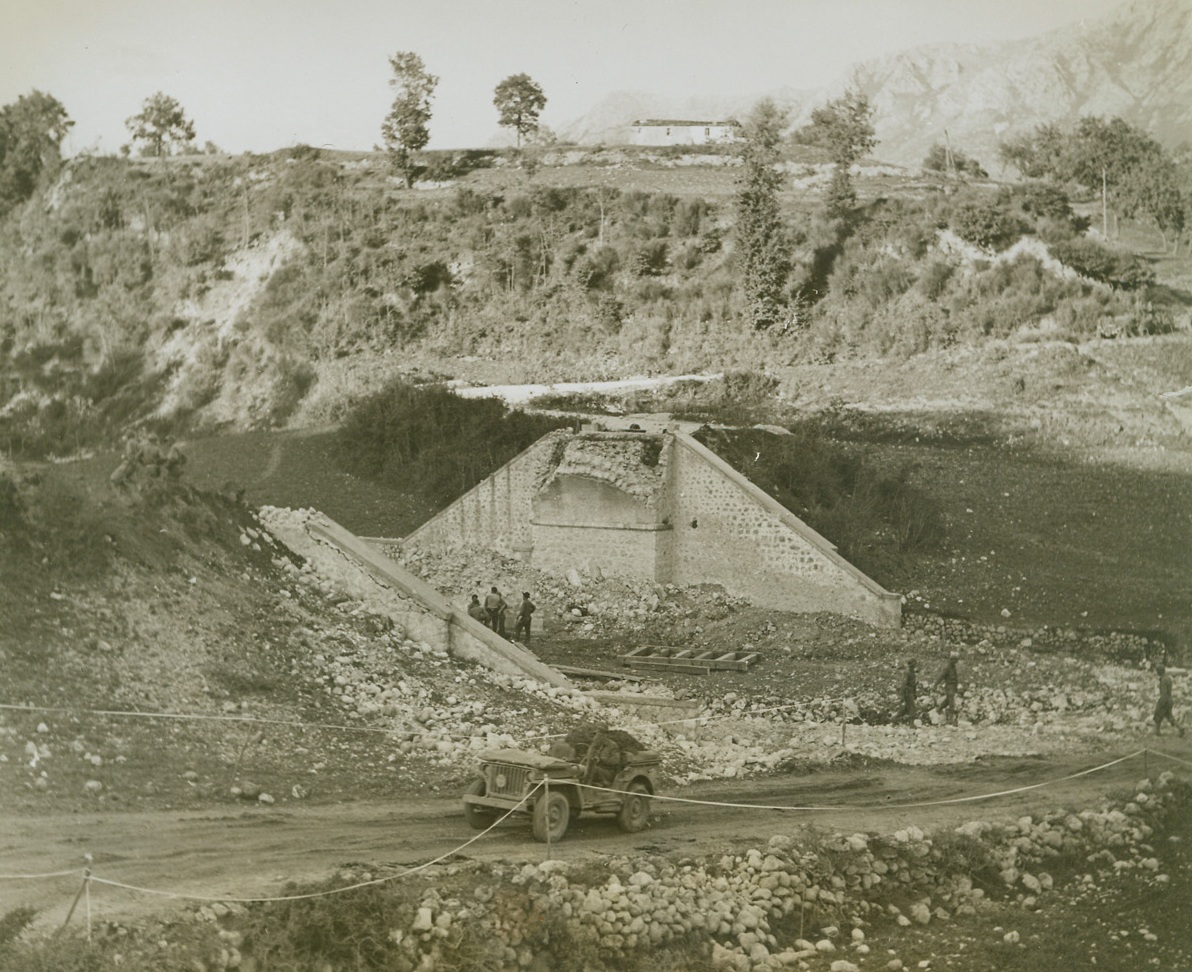
Nazi Inspired Detour, 11/19/1943. ITALY – The Fifth Army in Italy disproves an old proverb by not crossing its bridges even after it comes to them. By dynamiting this bridge, the retreating Nazis forced the Americans to cross a filled-in ravine and climb a steep by-pass before they could regain the road that leads to the front. The bridge formerly spanned the ravine. Credit (ACME Photo by Bert Brandt, War Pool Correspondent;
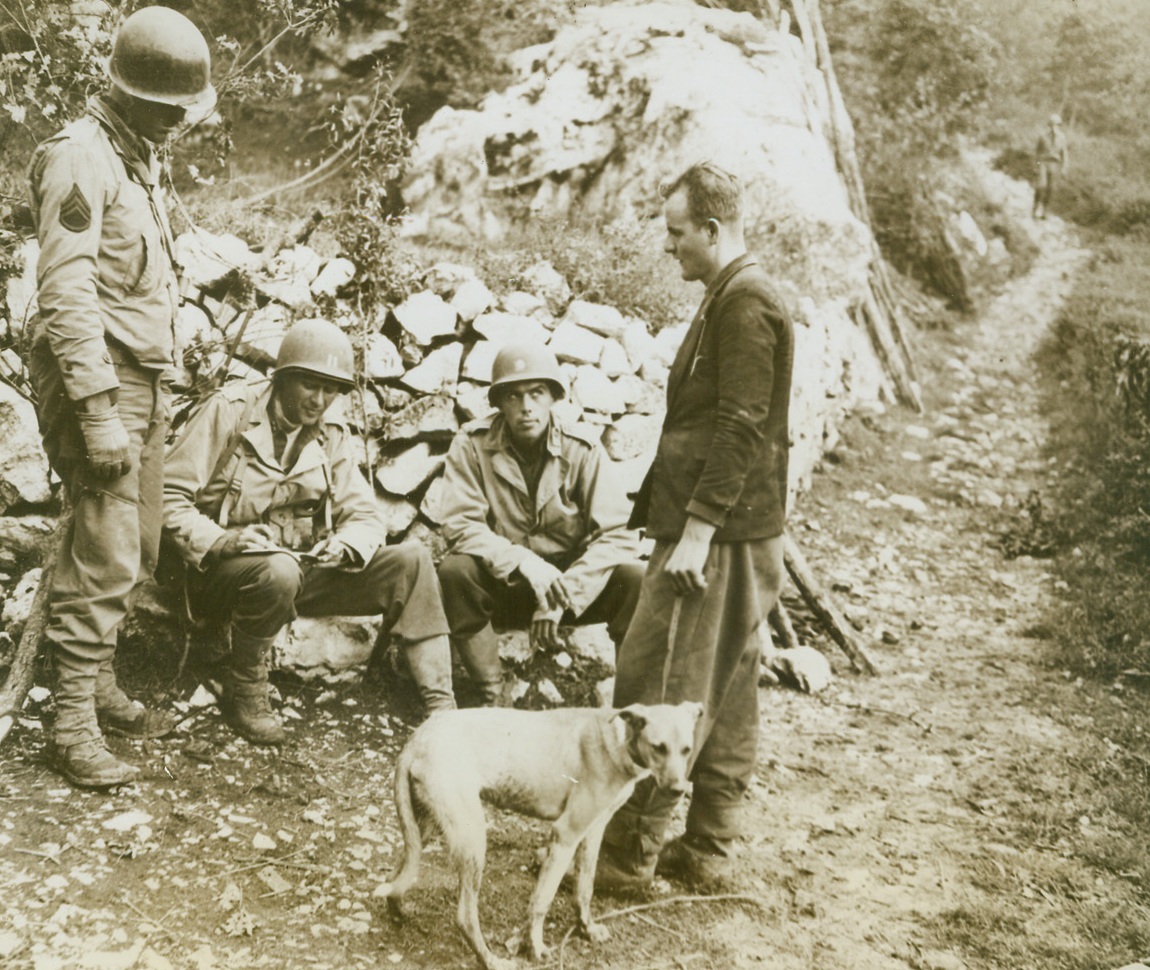
Canine Causes Capture of Master, 11/20/1943. ITALY – Sgt. Roy Biekn, of Klemath Falls, Ore., attached to Prisoner of War section of the Military Police; Capt. Richard A. Smith, and Lieut. Roy Moore, of Fargo, N.D., (left to right), cross-examine a German prisoner, garbed in civilian dress, who was captured by Captain Smith when he overheard the prisoner give orders to the dog in German. The dog was used for messenger services by German troops. The three Americans are attached to an Infantry regiment. Credit Line (U.S. Army Official Photo from Acme);
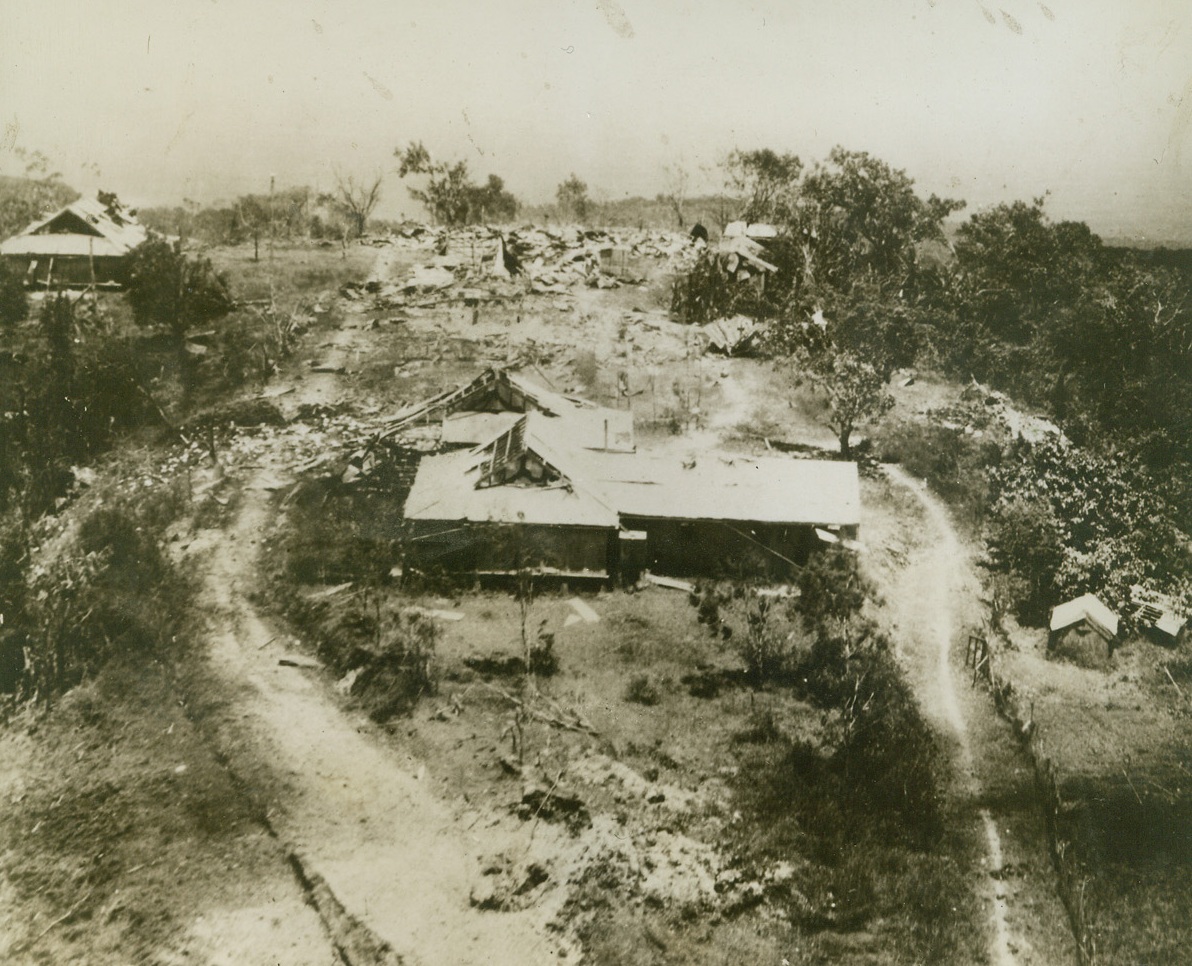
Once A German Mission Station, 11/27/1943. SATTLEBERG, NEW GUINEA – Ruined by U.S.A.A.F. bombers, this former German mission station at Sattleberg was used by Japs as a fortified point before the Aussies captured the town on November 27th (New Guinea time). While the installation’s flimsily constructed buildings were few in number, they could easily have concealed heavy guns to retard the advance of Allied ground units. Credit (U.S. Army Air Forces Photo from ACME);
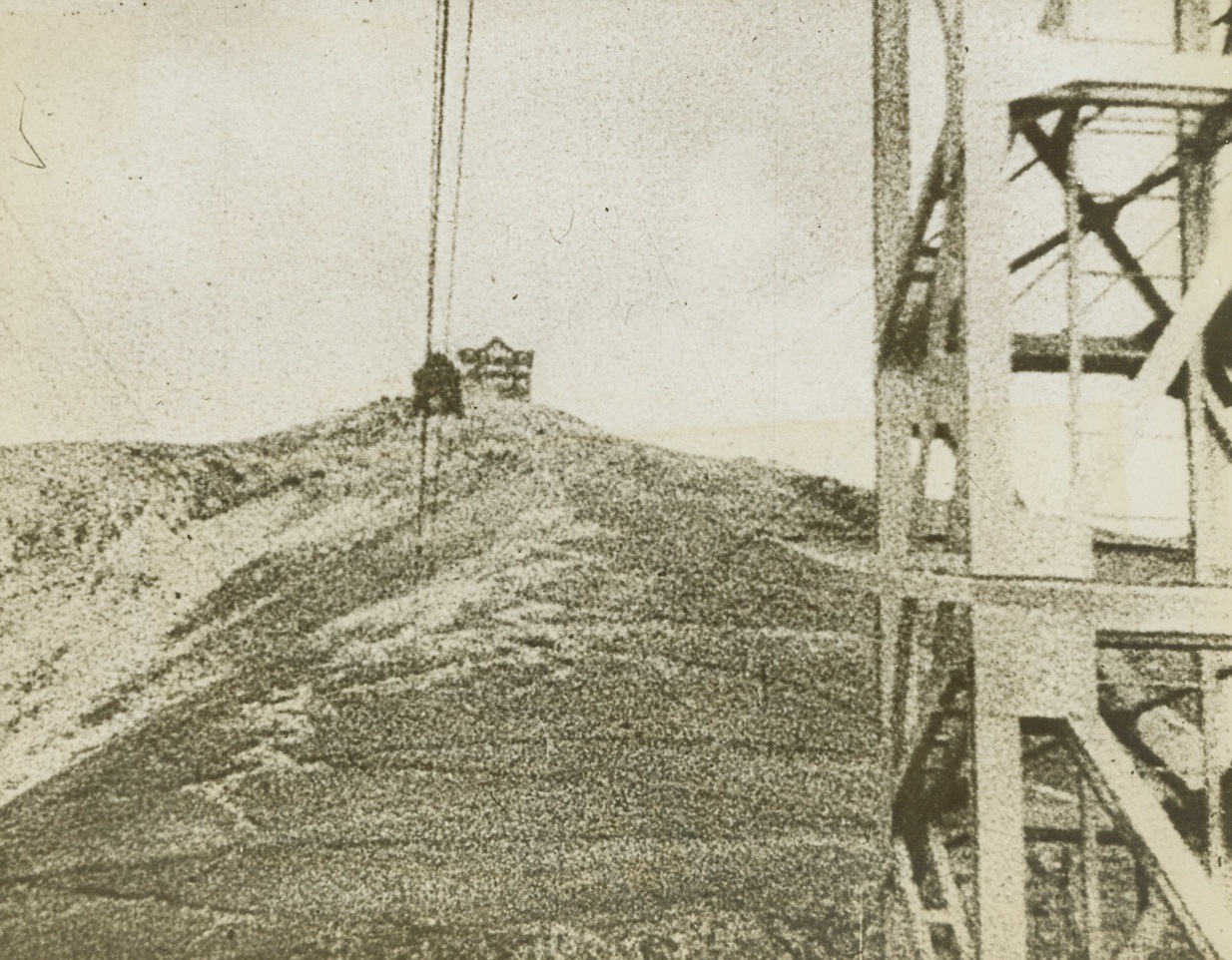
RETURN TO THE FOLD OR—“WELCOME BACK, DEAR MUSSO!”, 11/30/1943. (A farce in 6 acts)--Herewith, we present excerpts from a stirring (it says here) movie film received from Lisbon which would have one believe that Hitler’s Supermen have added an eighth to the Seven Wonders of the World by rescuing an obviously bedraggled, and slightly moth-eaten Benito Mussolini from under the very guns of the Allies using dodges that would have utterly enthralled a modern “Tom Swift,” Der Fuehrer called in his strictly Aryan Parachute corps, his Luftwaffe (maybe that’s where it was during the Battle of Russia!), and wound up by announcing over the German radio, with the fanfare that only a Goebbels can inspire, that the great Italian leader had been “rescued from his prison atop a peak in the Abruzzi Mountains near the village of Assergi, Italy. The “world-shattering” announcement was made last Sept. 16th, and only now, has his film been “allowed” to be “smuggled” out of Germany (Hollywood could have turned the whole thing out in a week or so!). Anyhow, here are a few scenes from the film, which bear the unmistakable Goebbels touch and Hitlerian Fantasy. New York Bureau With a bang-up opening, the film grinds through his scene showing the cable car that “is the only mean of access” to Mussolini’s prison, the Camp Imeratore, (distant background, center of photo). Of course, Hitler’s para-troopers had to do it the hard way—they hit the silk, landing in the valley and swarmed up over the mountain to the hotel. Credit: ACME.;
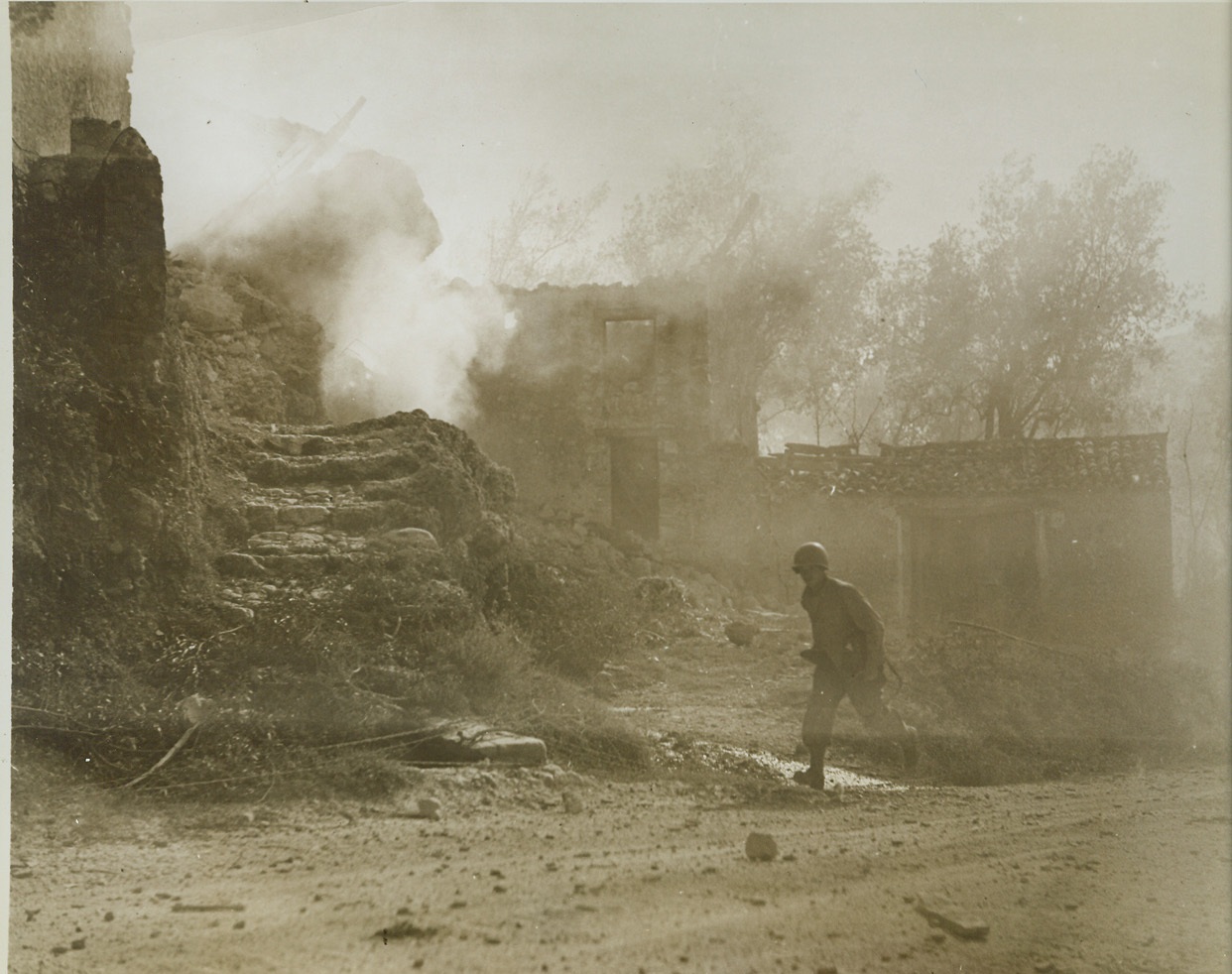
Busy Signal, 11/19/1943. Italy – A Signal Corps telephone lineman takes it on the double past a blazing house at Capriati, Italy, set afire by a direct hit from a German dive bomber. The picturesque Italian dwelling is just one more inanimate casualty of war. Credit (ACME Photo by Bert Brant, War Pool Correspondent);
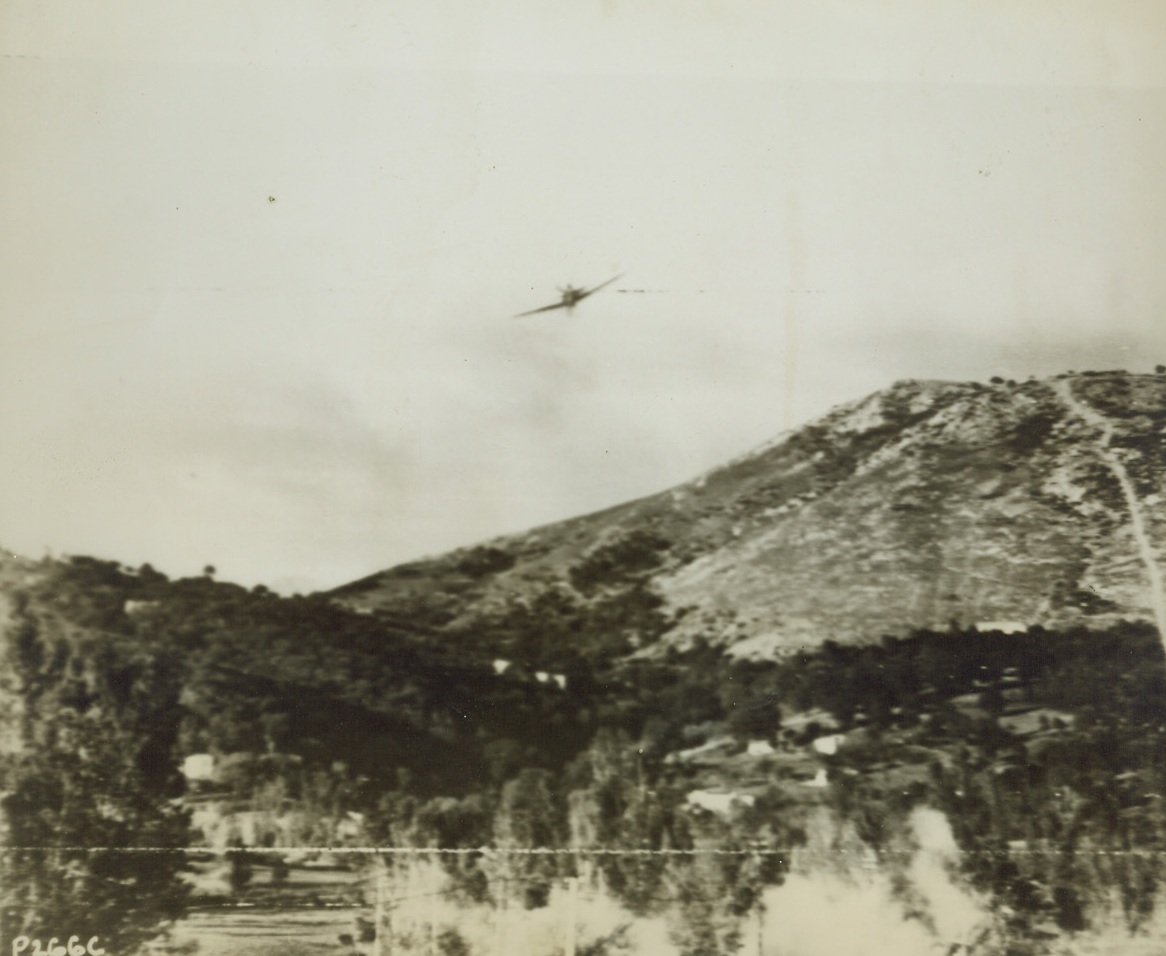
Making it Tough for the Yanks, 11/5/1943. ITALY—A Nazi plane flies low and at a terrific speed to strafe a road in Italy that is choked with U.S. Army vehicles. Machine guns blazing, the German aircraft peppers the American equipment with bullets, smoke and dust arising as the shells hit. Credit: ACME Photo via U.S. ARMY SIGNAL CORPS RADIOTELEPHOTO.;
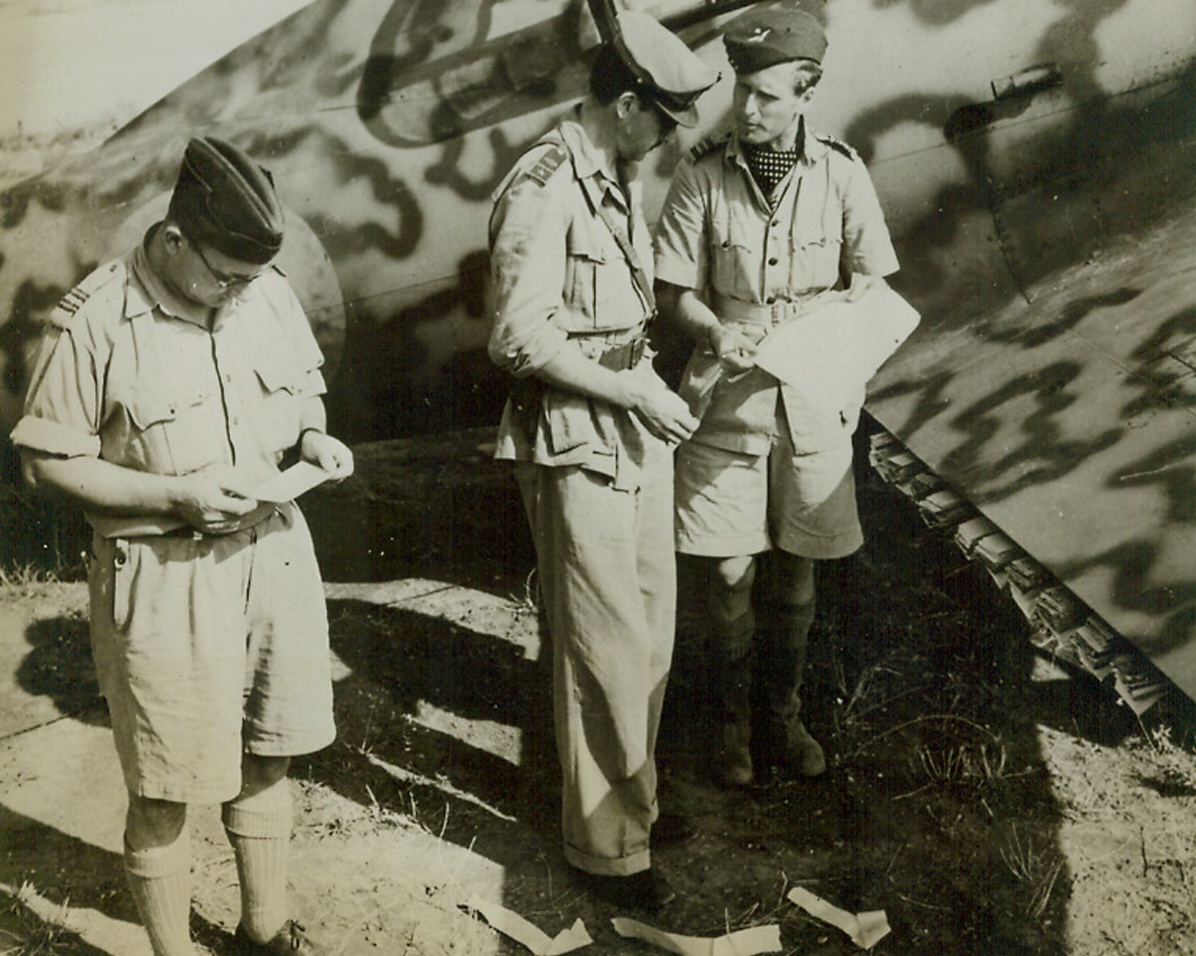
We “Bomb” Rome With Leaflet, 11/5/1943. ITALY—Leaflets are neatly packed between the wing and flaps of this Italian plane which will bombard Rome with messages. R.A.F. officers discuss the route at a recently captured airport. The pilot will lower the flaps over the “Target” area. Credit: ACME.;
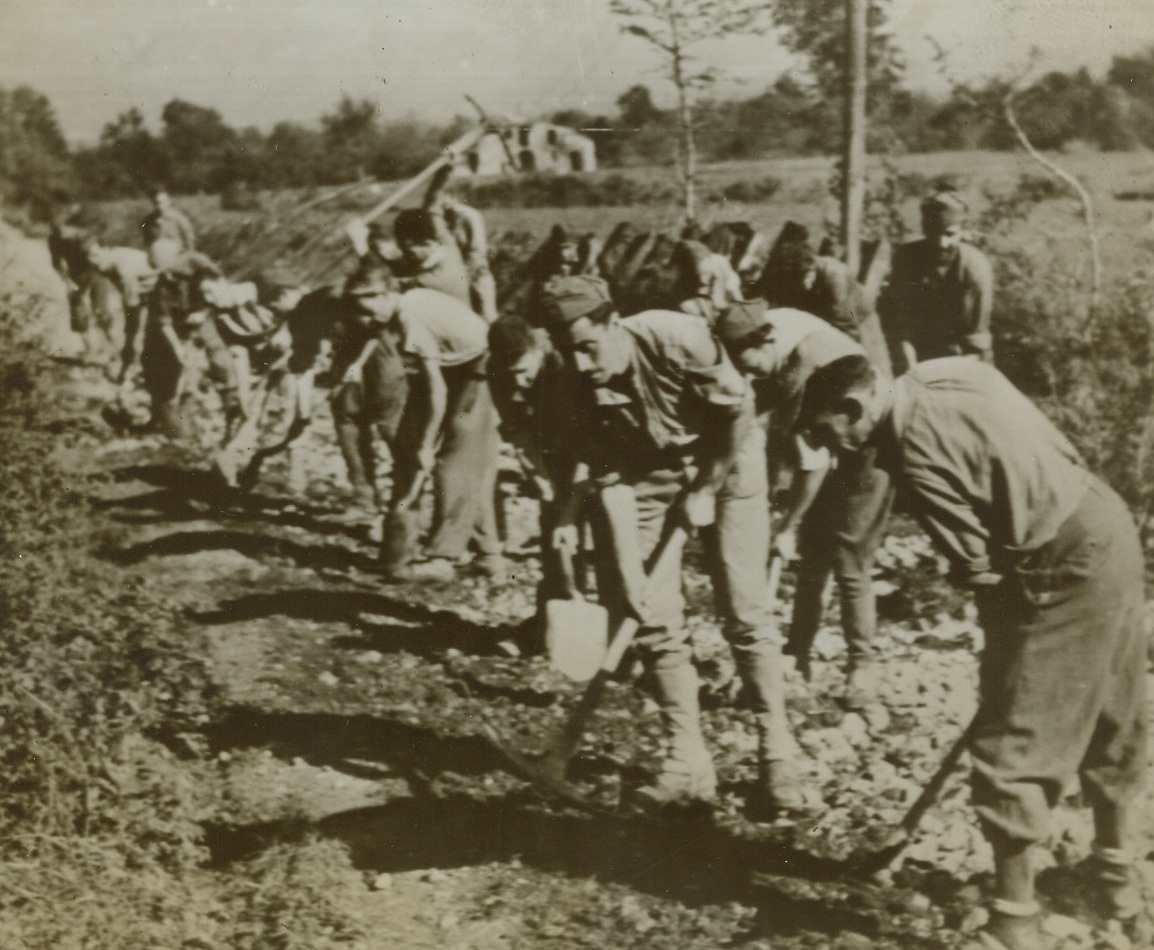
Italians Pave the Way to Rome, 11/5/1943. ITALY—Italian soldiers willingly weld picks and shovels for the Allies as they construct a road near the front of Italy. They are helping pave the way to Rome, now only 80 miles away from advancing Americans. }Credit: ACME PHOTO by Bert Brandt for the War Picture Pool via ARMY RADIOTELEPHOTO.;
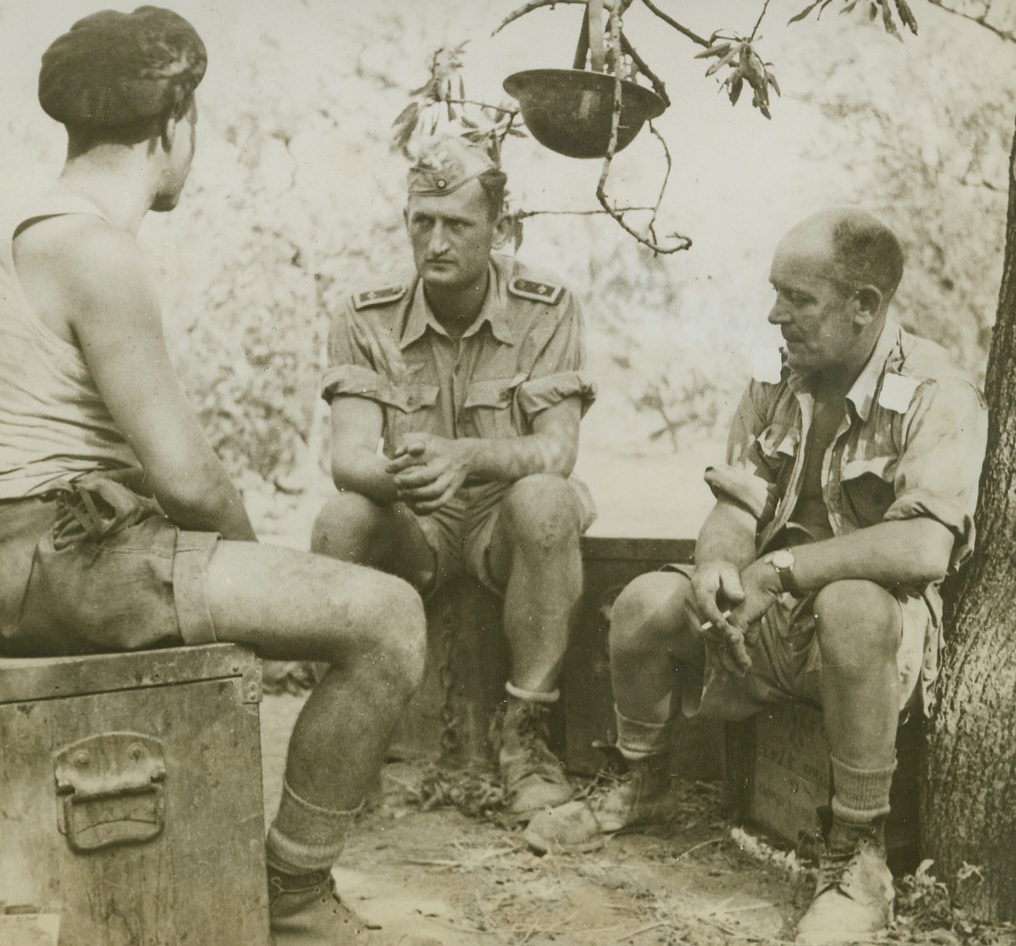
Two Points of View, 11/5/1943. ITALY—“Whatever made the Nazis think they could win this war, anyway,” might be the topic of conversation for this group: a British Corporal, driver, and German prisoner, who chat in Italy. They are Cpl. G.E. Sankey, of Birmingham, Dvr. H. Finamore, from Devon, and Sgt. Emile Ererich (center), of Vienna. The wing of this Allied plane, held in place by the flaps which will be lowered. Credit: ACME.;
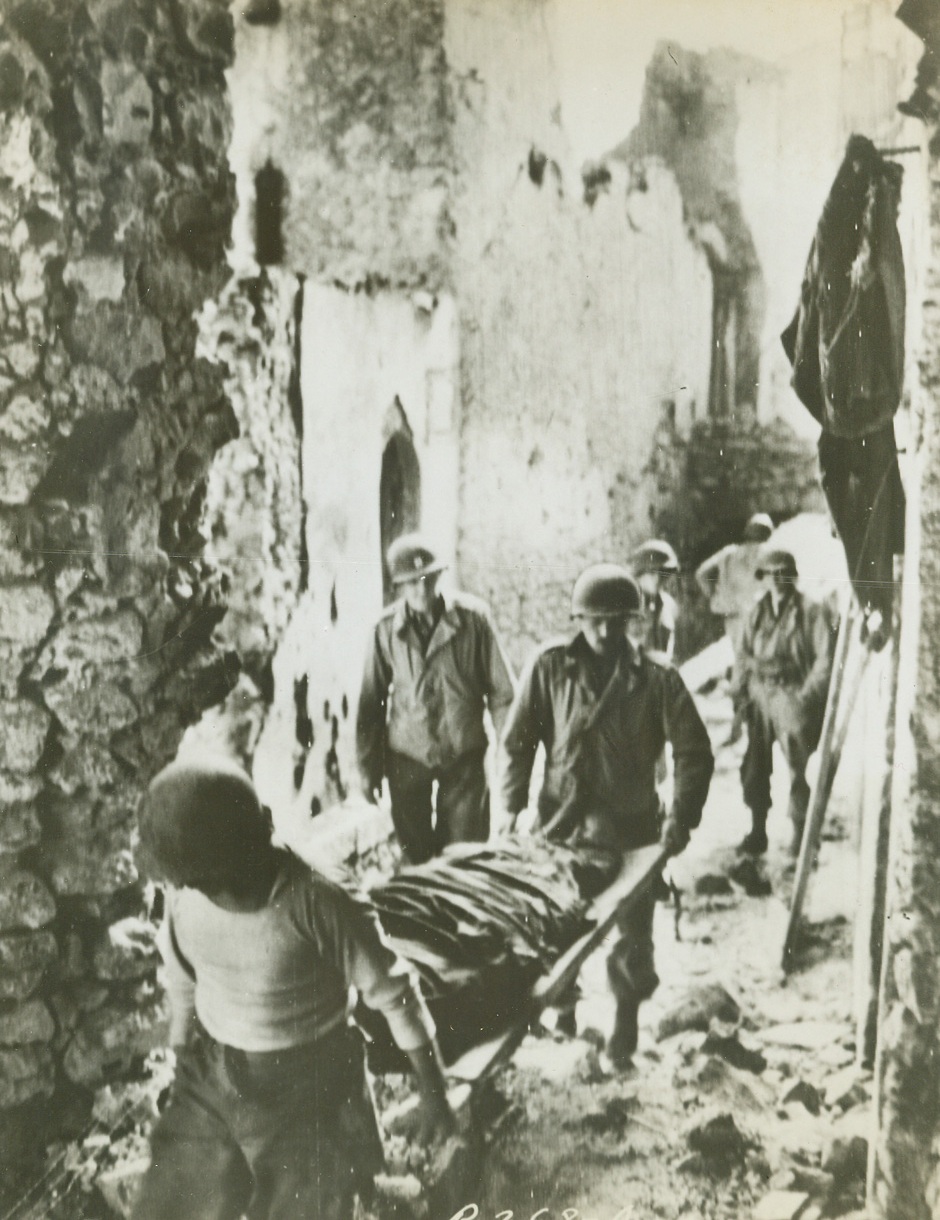
He Died for His Country, 11/8/1943. PIETRAVAIRANO, ITALY—An American soldier, who fought and died in this Italian city, is carried to a burial place through the rubble-strewn streets by two of his buddies. Today, it was announced that the Allied 5th Army was only 9 miles from the important port of Gaeta, where Germans are feverishly destroying harbor installations in preparation to abandoning it. Credit: U.S. SIGNAL CORPS RADIOTELEPHOTO from ACME.;
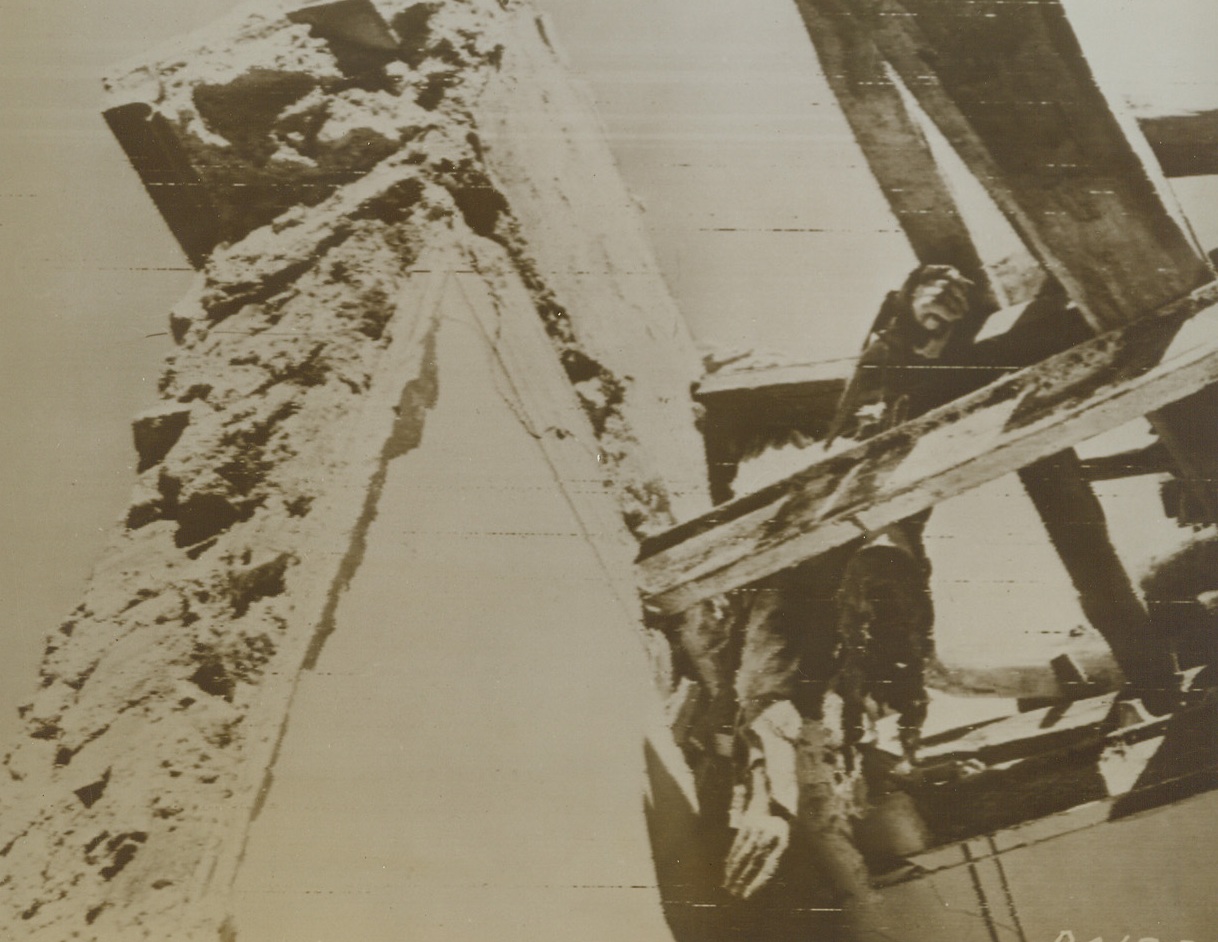
Death on the Rafters, 11/6/1943. ITALY—An Italian citizen of Prata paid for a good night’s sleep with his life when the Nazis exploded a road block. Advancing Allied troops found his body hung on the rafters. The night before he had gone to bed on the second floor of his home. Credit: ACME photo via SIGNAL CORPS RADIOTELEPHOTO.;

A Bullet Ends the Game, 11/6/1943. NOCELLETO, ITALY—A far cry from the childhood game of hide-and-seek is the one played by British Tommies and the Nazis in Nocelleto, Italy. The opposition “puts you out” with a bullet if you aren’t quick enough in seeking cover. Credit: ACME photo via SIGNAL CORPS RADIOTELEPHOTO.;
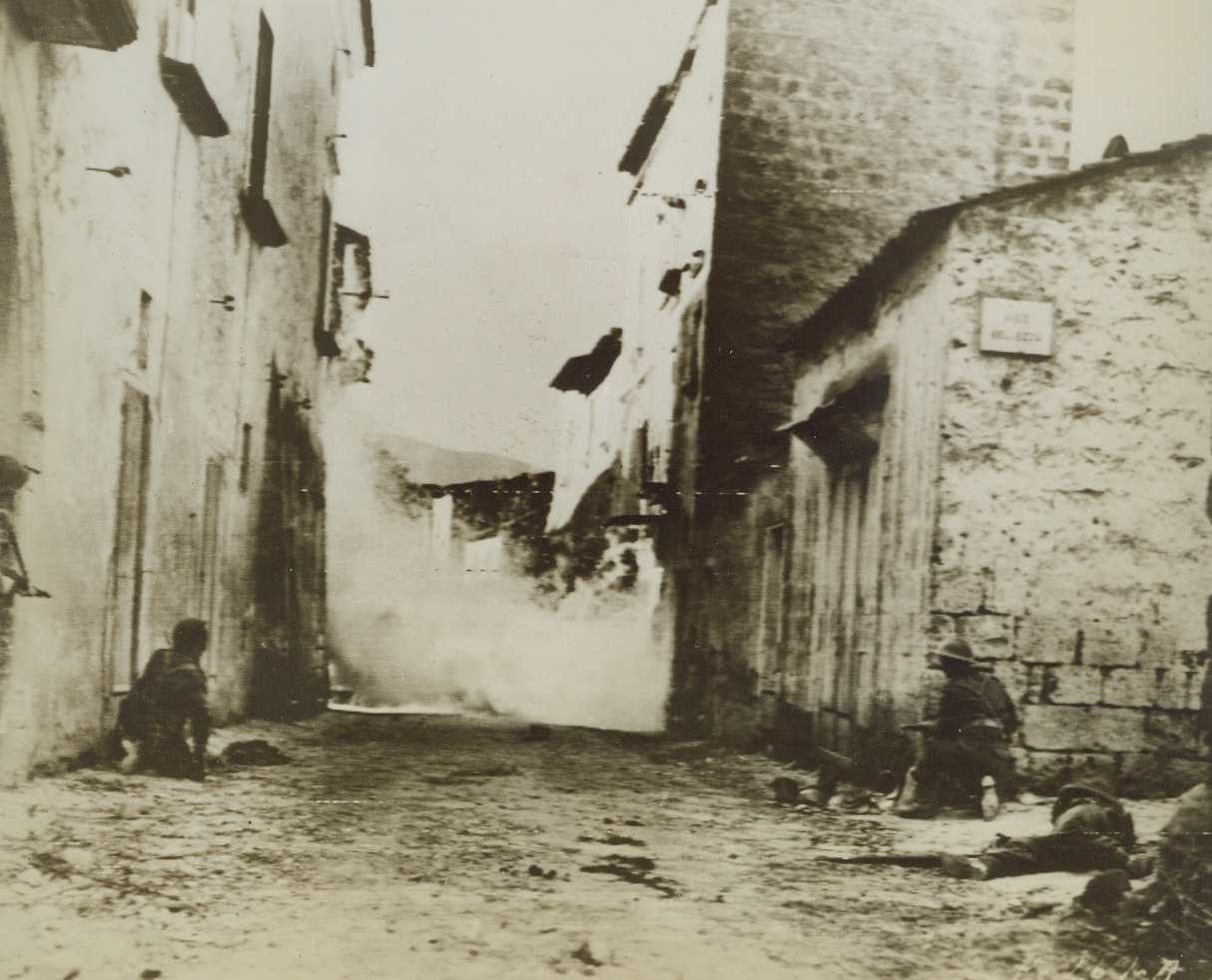
Good Day to Stay Indoors, 11/6/1943. ITALY—Bullets fly thick and fast as members of a British patrol seek out the enemy in some furious street fighting in Nocelleto, Italy. Credit: ACME photo via SIGNAL CORPS RADIOTELEPHOTO.;
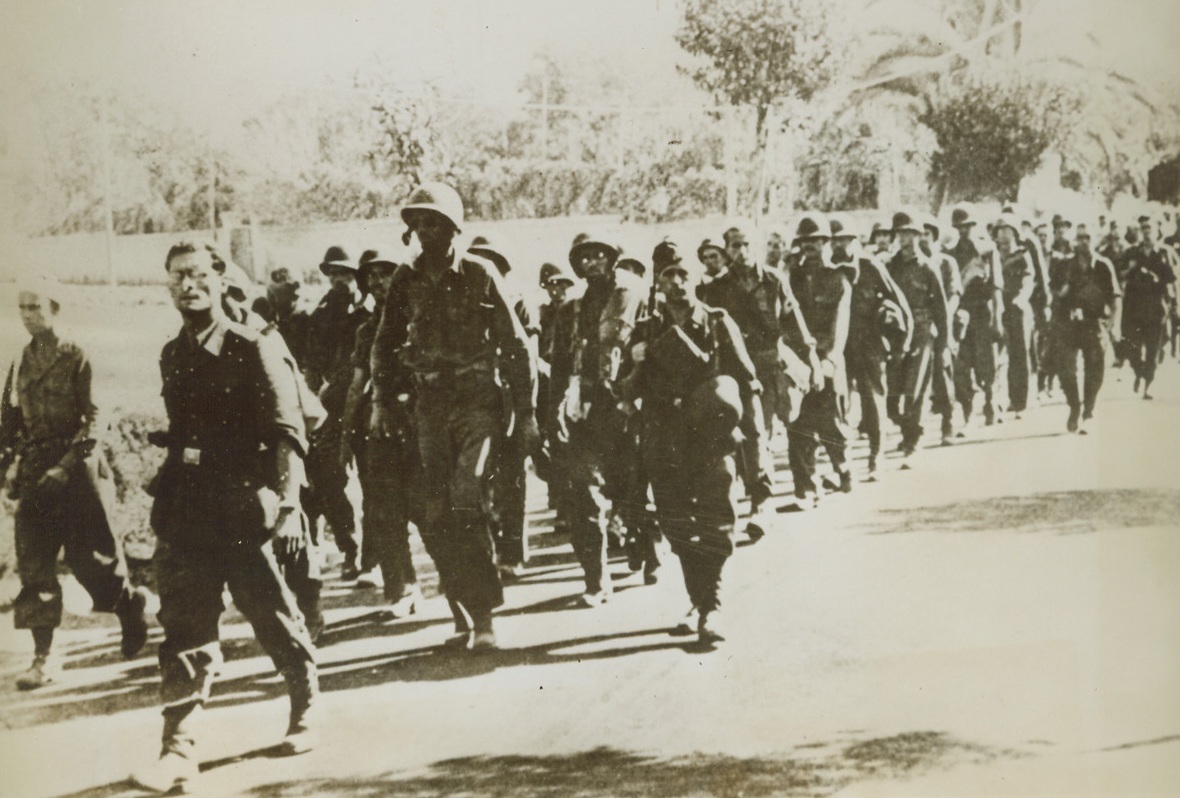
Yanks Seized by Nazis, 11/7/1943. The Germans describe this long column of soldiers as American prisoners of war, captured in Italy. The caption accompanying the photo, received in Lisbon, says the Yanks are being marched off to prison camp.Credit Line (ACME);
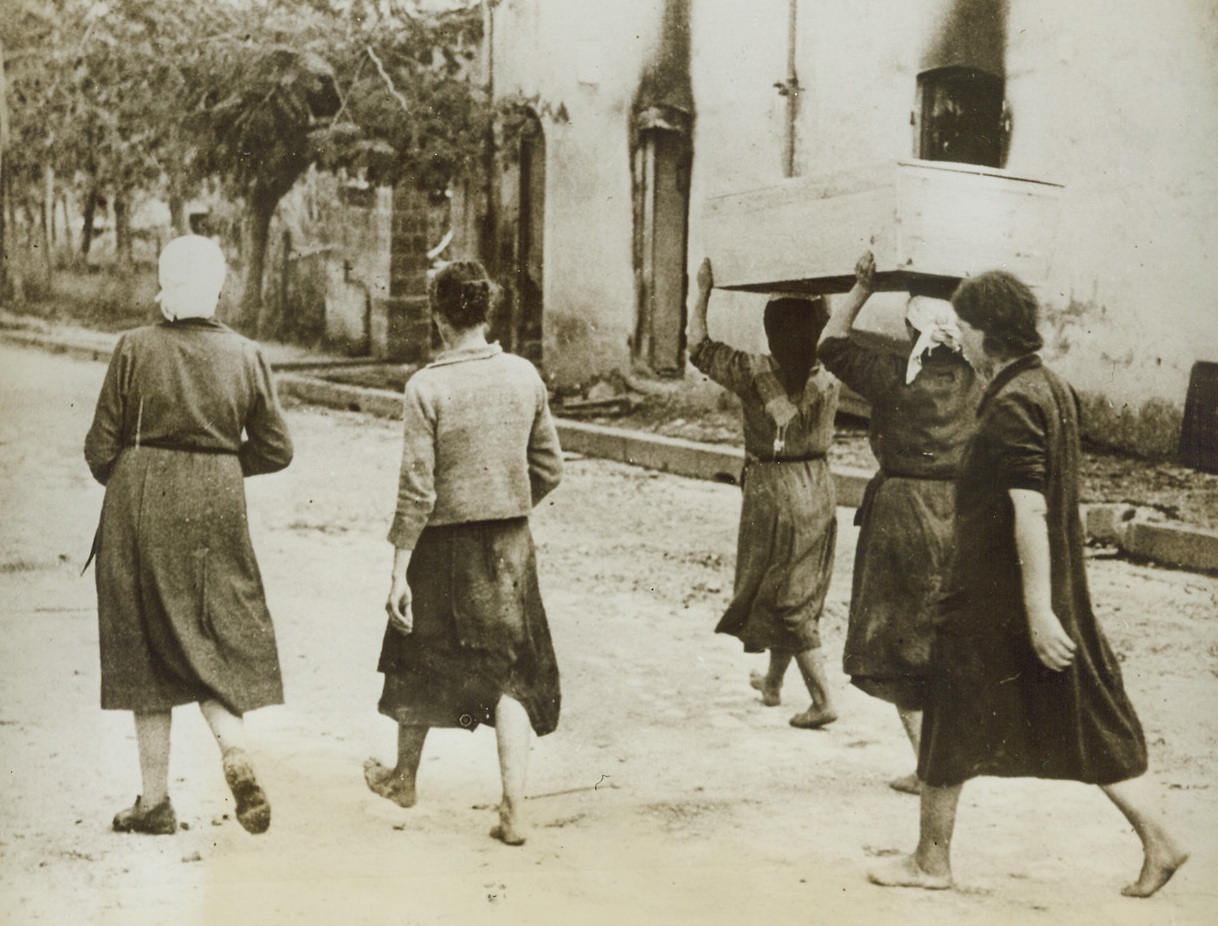
Few Mourners, 11/29/1943. TRAGONE, ITALY—Only a handful of friends—all but one of them barefooted—take part in these simple rites for the innocent victim of warfare in Italy. The crude box, carried by two of the women, contains the body of the mother of two children, who was killed as the Germans retreated through Tragone. Many civilians—including women and children—lost their lives as the tide of battle swept over this part of Italy. Credit: U.S. SIGNAL CORPS photo via OWI from ACME.;
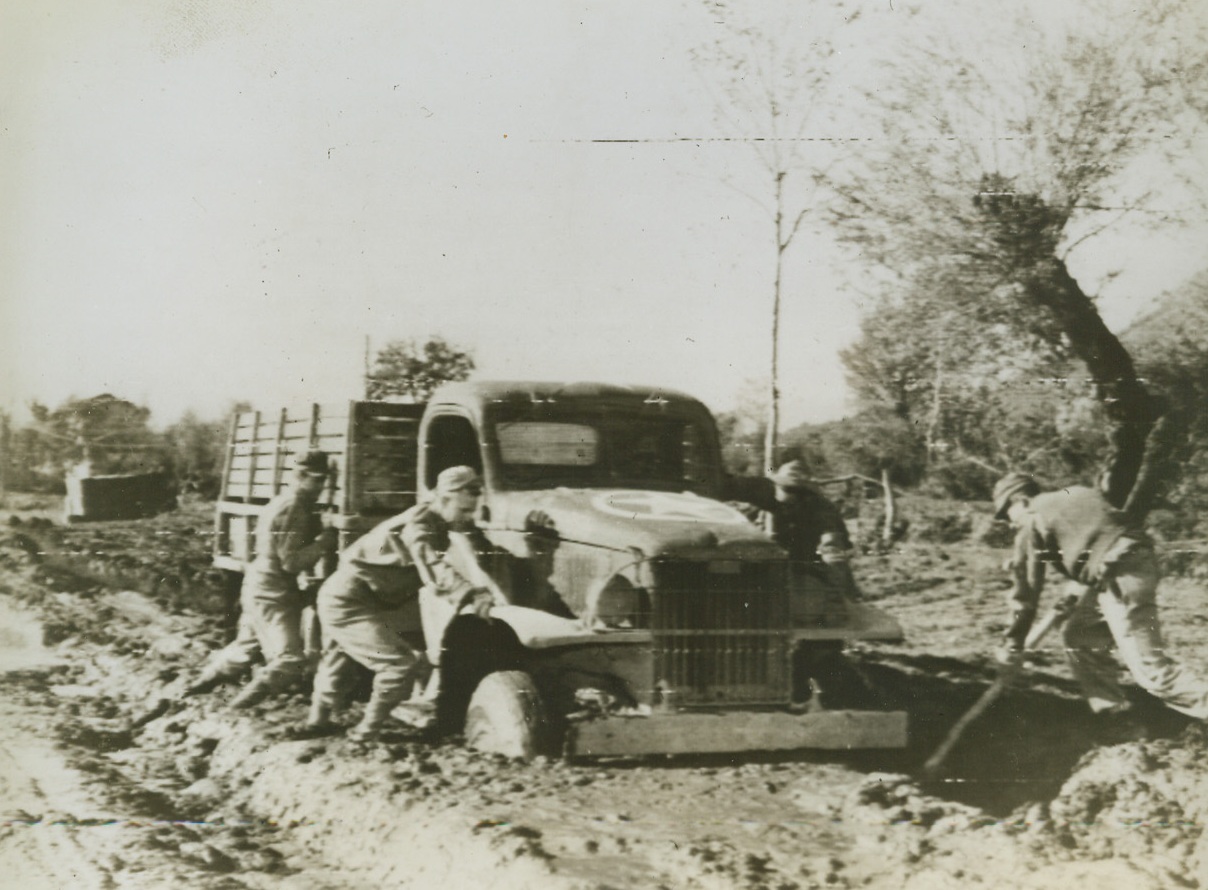
In Italy—It Rains!, 11/30/1943. ITALY—This road near the front in Italy, was one of many turned into a quagmire by recent rains, and this truck seems to be mired down for the duration. Trying to get the vehicle clear of the ooze, are (left to right): Pvt. Joseph F. White, of New Castle, Del.: Cpl. Charles R. Svoboda, Cocero, Ill.: Pfc. Ernest Shronk, (in driver’s seat), Reesburg, Wis.: Pvt. Murray Marks, Bronx, N.Y.; and Cpl. Cecil Cox, (with pole), of Bloomington, Ind. Credit: U.S. SIGNAL CORPS RADIOTELEPHOTO from ACME.;
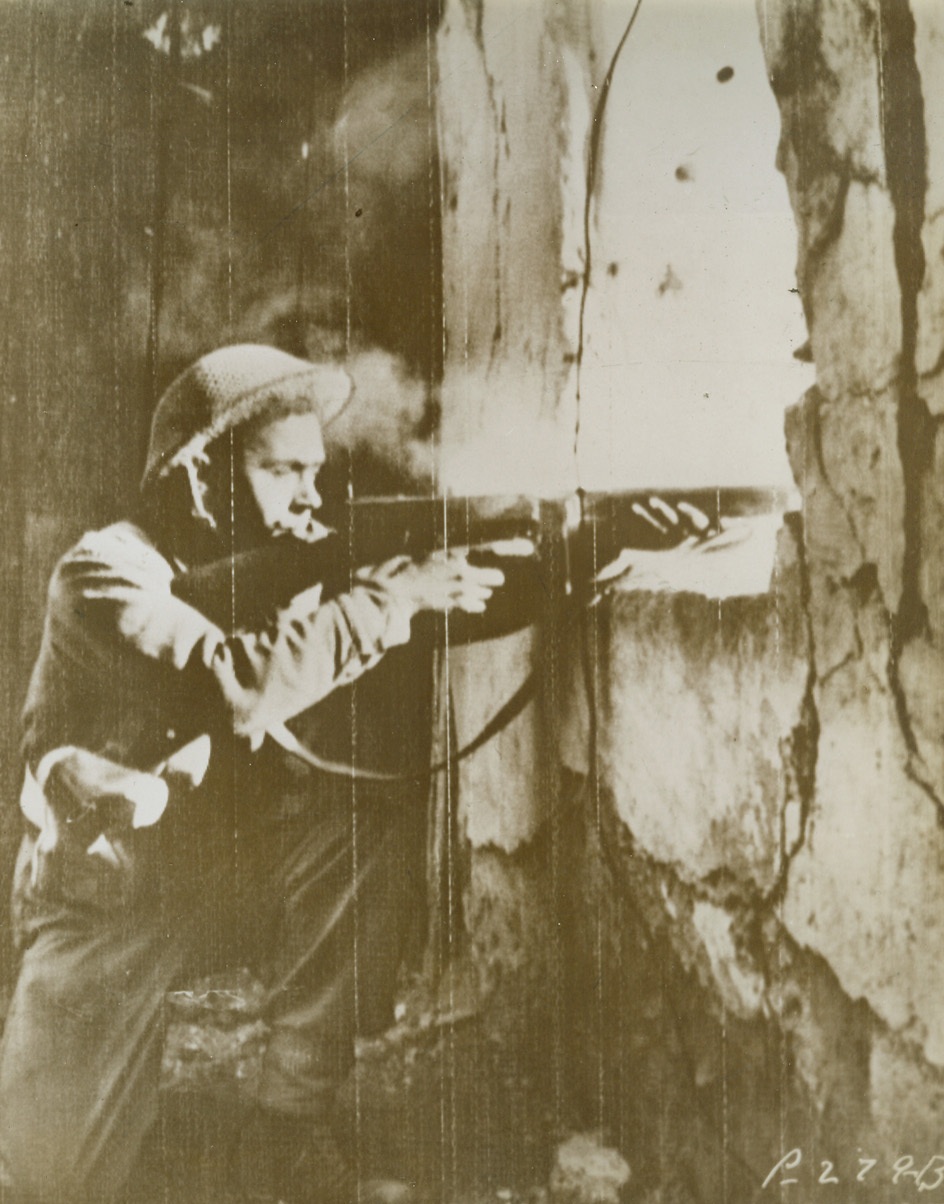
British Sniper in Action, 11/16/1943. CUPA, ITALY—A British sniper in the ruins of a building in Cupa, a few miles from the Gariglaino River, draws a fine bead with his tommy gun through a window. Allied snipers placed in strategic spots in newly captured towns, helped to wipe out many enemy sniper and machine gun nests, as the Allies moved North. Credit: U.S. ARMY RADIOTELEPHOTO from ACME.;
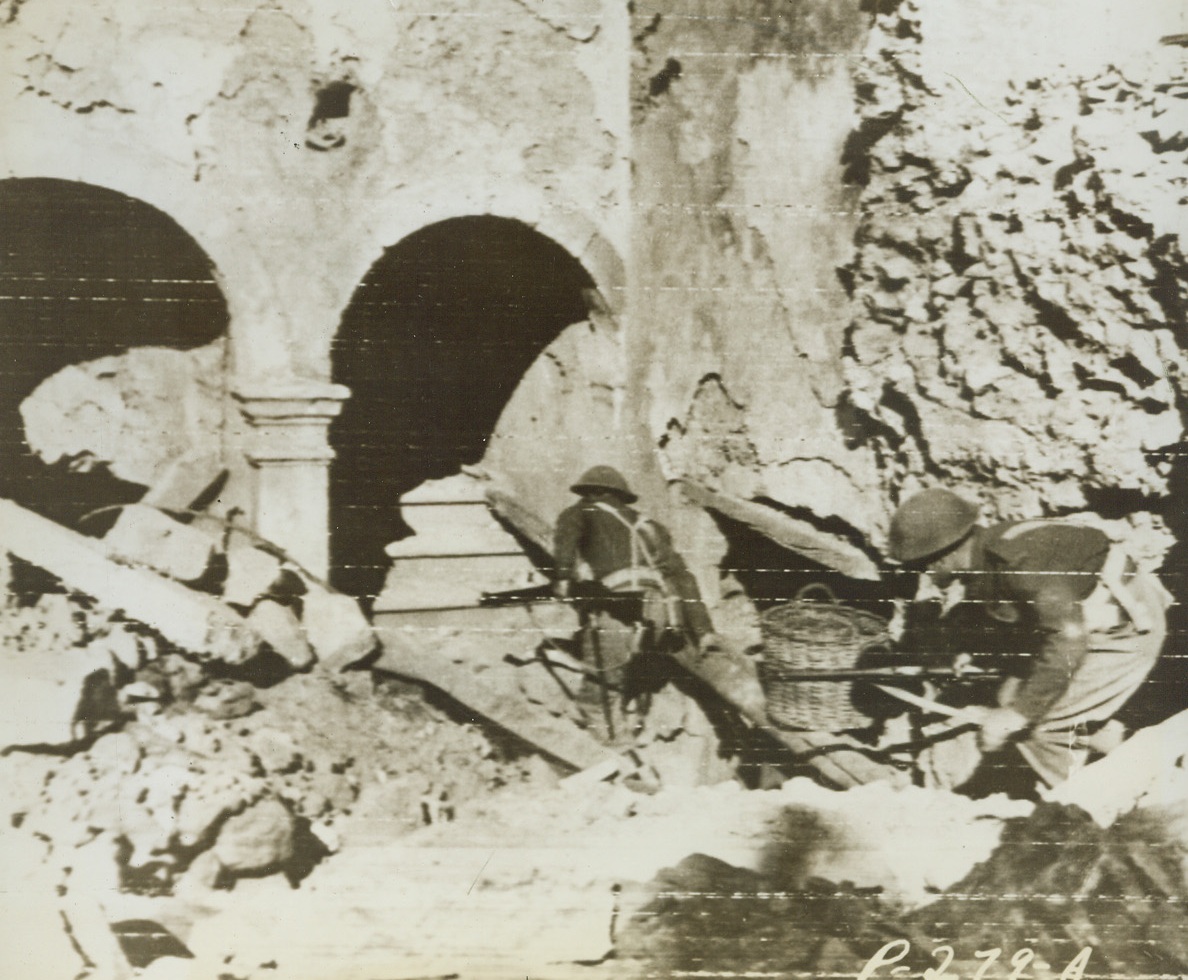
Sniper Hunt in Italy, 11/15/1943. This photo, flashed to the United States by radiotelephoto today, shows British riflemen advancing cautiously through the wreckage of an Italian town, looking for snipers and machine gun nests. Credit: U.S. ARMY RADIOTELEPHOTO from ACME.;
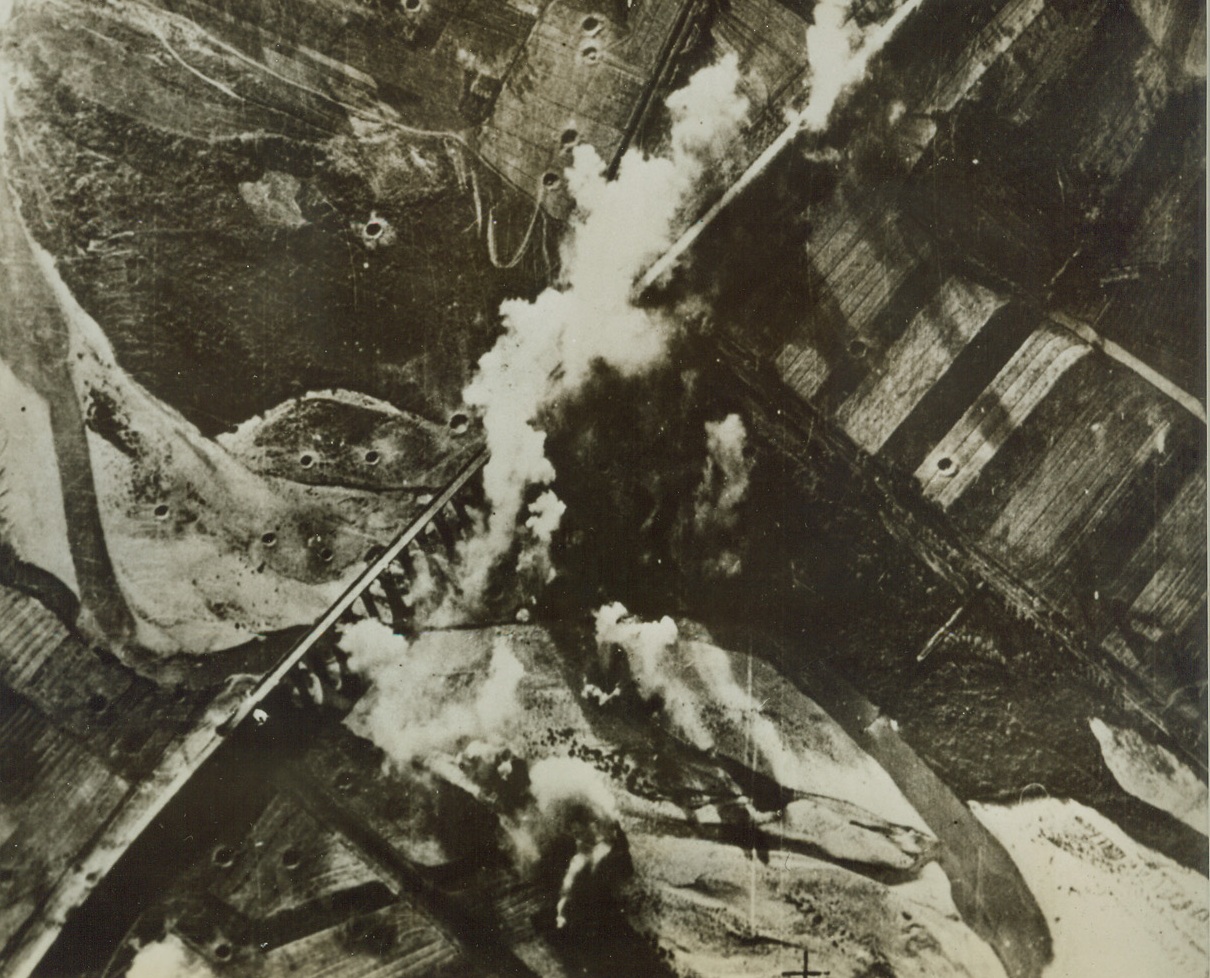
Blasting Enemy Communications, 11/16/1943. ITALY—Bombs from light bombers of the British South African Air Force explode around this vital bridge over the River Sangre in Eastern Italy. On either side of the bridge, crater from previous bomb blasts, can be seen. Credit: ACME.;
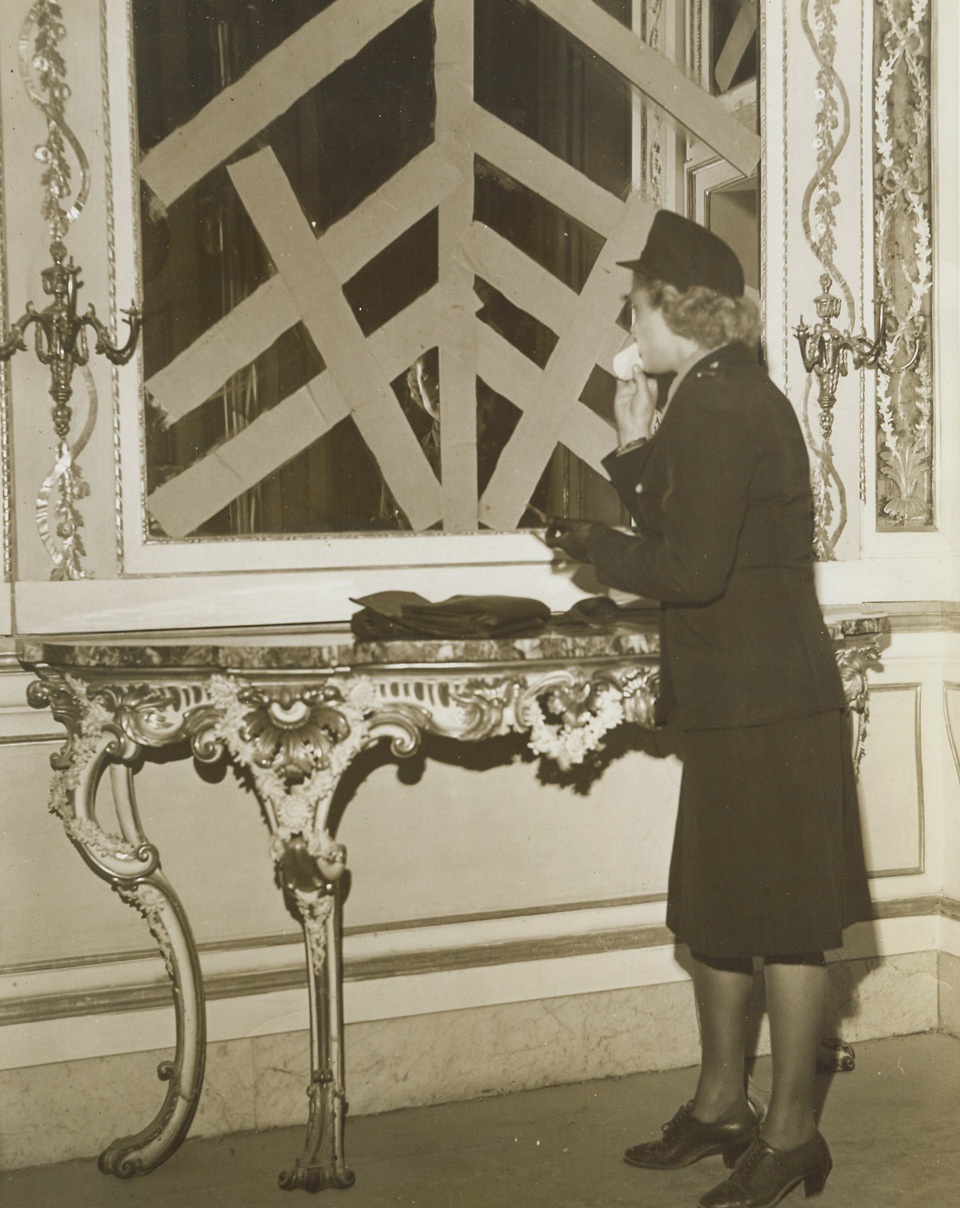
Queenly Operation, 11/17/1943. NAPLES—Taped to prevent damage during bombing raids, the mirror in the Queen’s powder room at one of the royal palaces in Naples serves Lt. Wilma Ward, Army nurse from Birmingham, Mich., as she freshens her makeup, in much the same manner as many Italian queens powdered their noses in the past. Credit: WP photo by Bert Brandt ACME Correspondent.;
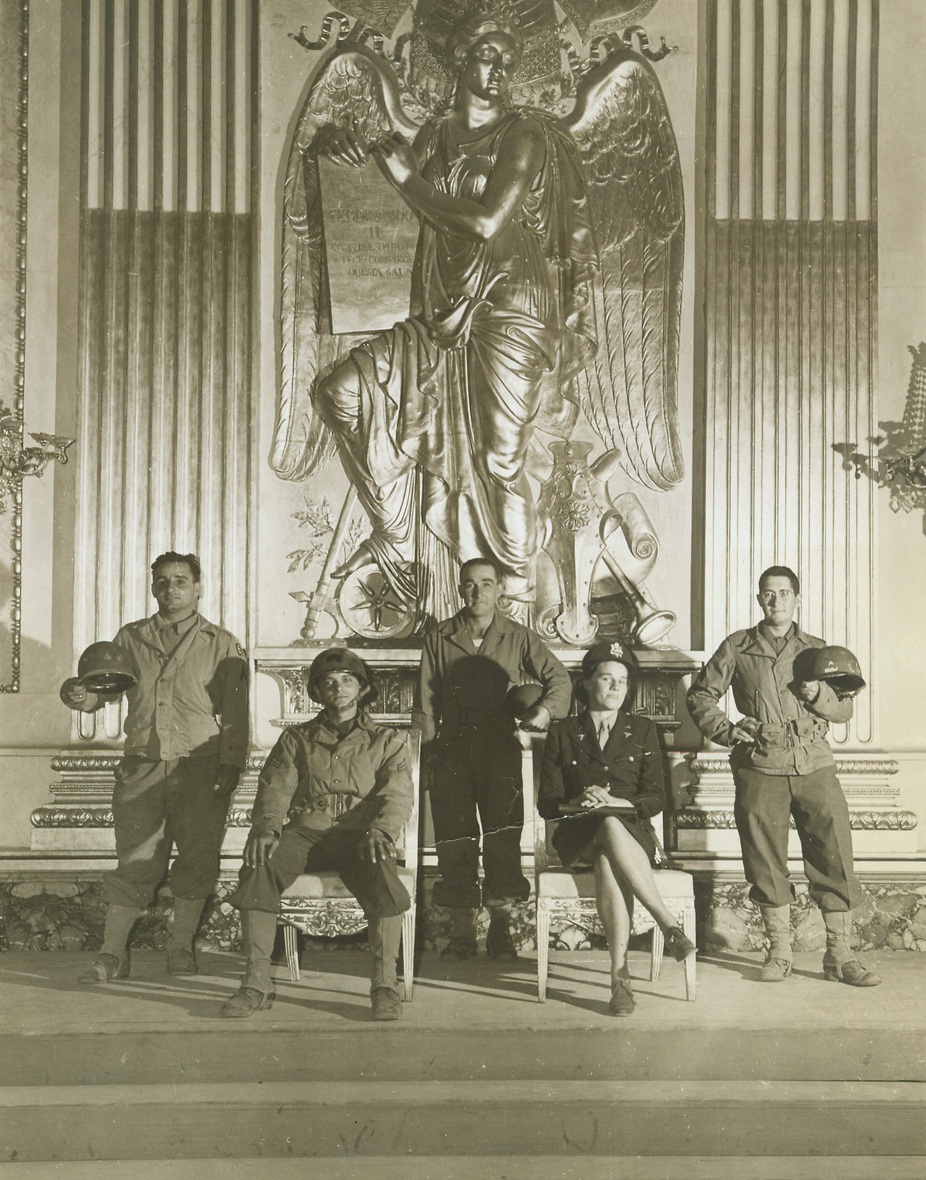
“Royal” Tintype, 11/17/1943. NAPLES—Cpl. Joseph Barber, Girard, Ohio, is “King” and Army nurse Lt. Maryellen McCutcheon, Birmingham, Mich., acts as “Queen” while Pfc. William Dato, Hoboken, N.J.; Pfc. William Montegomery, Detroit, Mich.; and Cpl. Thomas Shaw, New York; are the “courtiers” in this little tableau snapped in the throne room of one of the royal palaces in Naples. The gold throne was removed to another part of the palace for safekeeping, so chairs have to serve the “royal” pair. Credit: ACME photo by Bert Brandt, War Picture Pool Correspondent.;
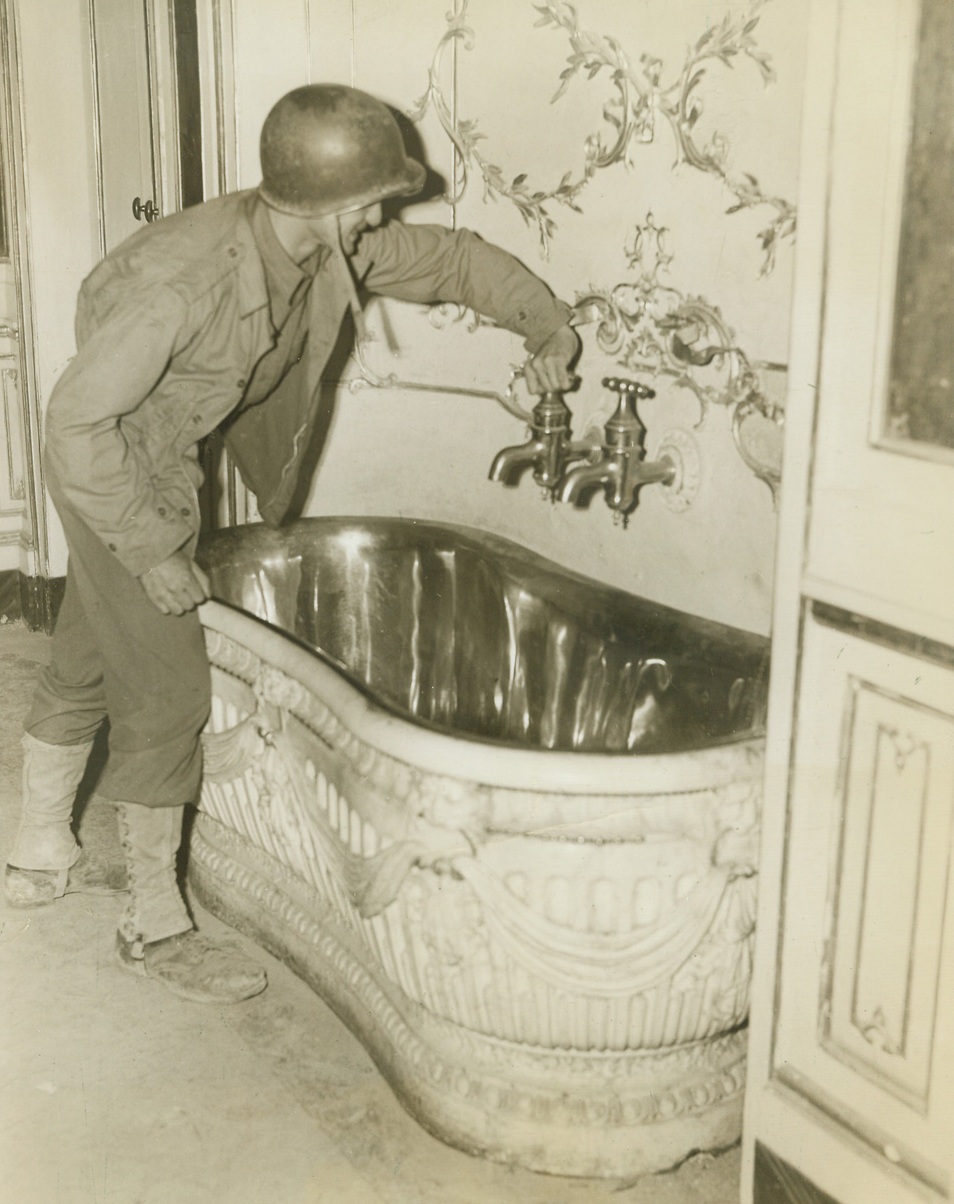
For Scrubbing the Royal Back, 11/17/1943. NAPLES—The hot and cold brass faucets are of heroic size but the tub itself seems a wee bit cramped in the royal bathroom in one of the King’s palaces in the Naples area. Cpl. William Polzin, Chicago, Ill., tries out the luxurious bath fixture. The Baroque tub is lined with brass, too. Credit: ACME photo by Bert Brandt, War Picture Pool Correspondent.;
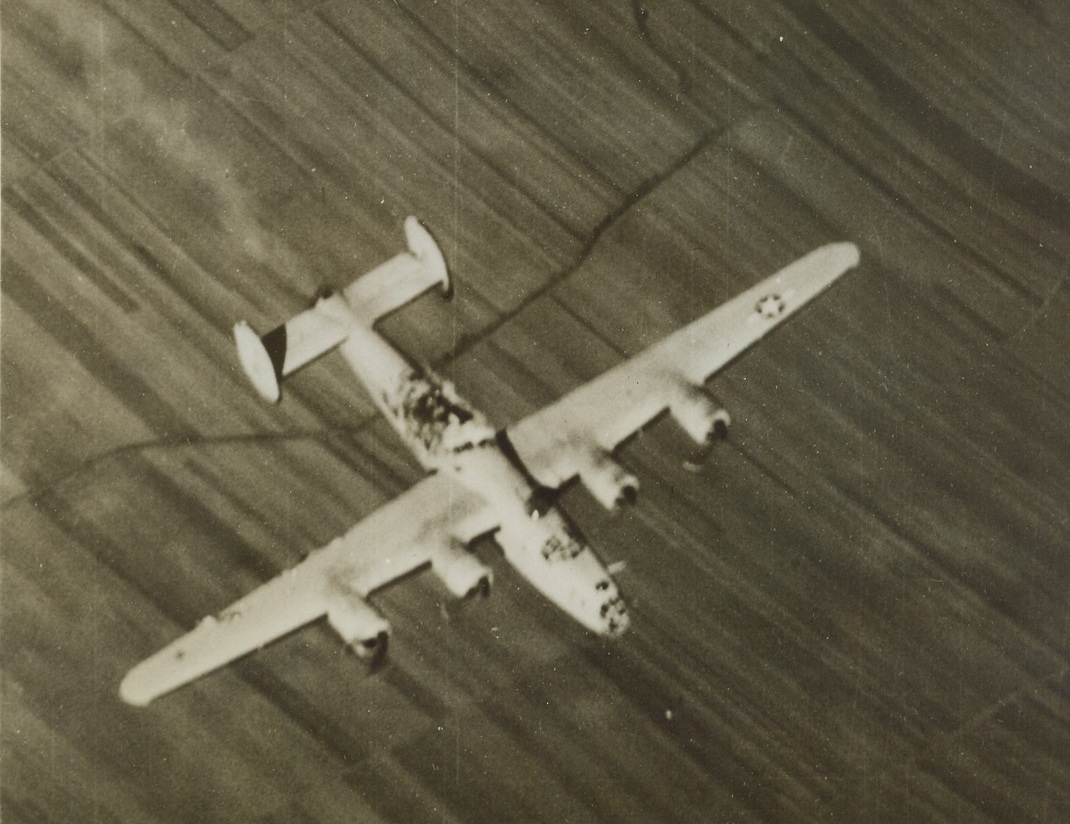
Torn by Enemy Flak, 11/16/1943. Enemy flak tore a five foot by thirteen foot gap in the fuselage of this American Liberator, as it accompanied other bombers in the Nov. 2nd raid on the German Messerschmitt Airplane works near Vienna, only 550 miles northeast of Naples. Mortally, wounded, the Liberator fell shortly after this photo was made.Credit (U.S. Army Air Forces Photo from ACME);
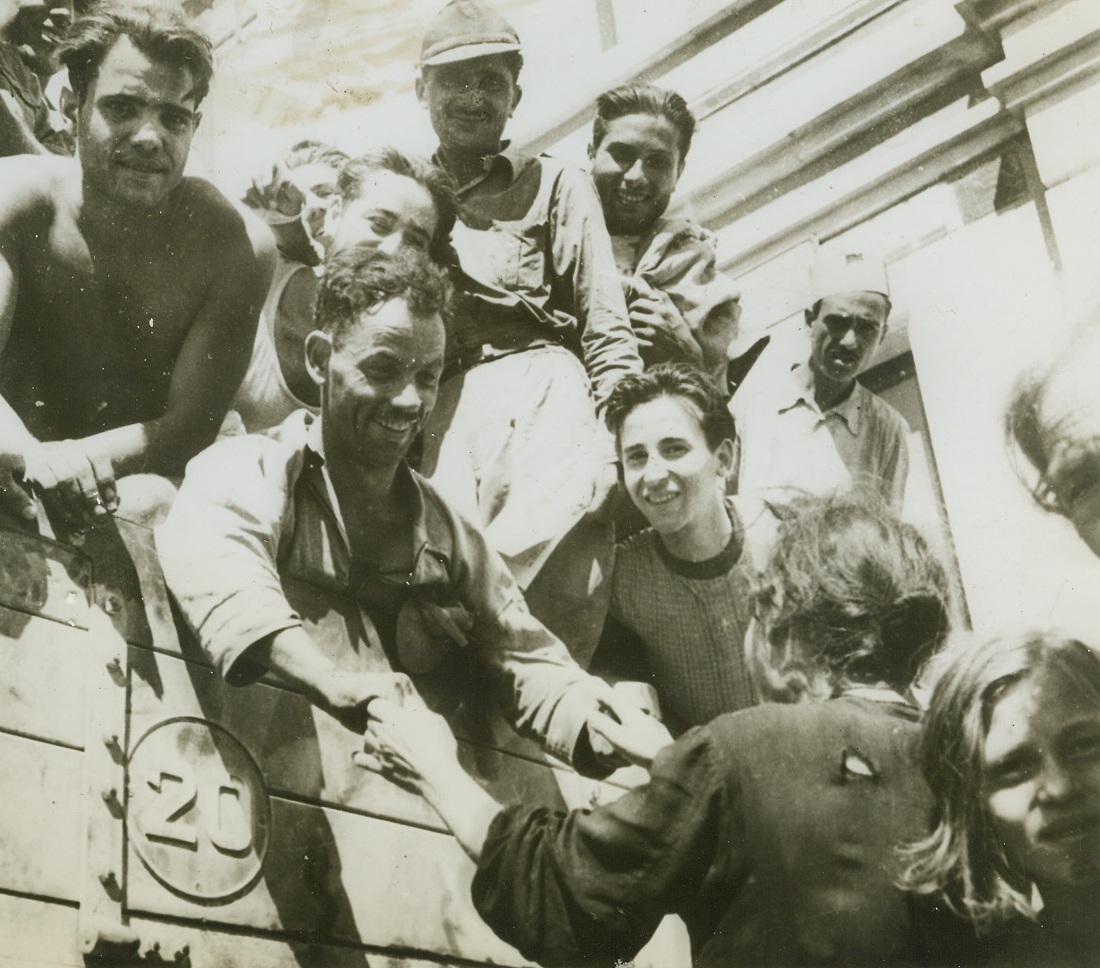
Homecoming, 11/17/1943. SICILY—Smiles wreath the faces of former Italian prisoners of war as they greet their wives, sisters, mothers and sweethearts on their return from Allied prison camps. With the war over for them, Sicilians are now returning to normal, picking up the threads of their old lives and rebuilding the shattered country. Credit: OFFICIAL OWI Photo from ACME.;

Yank Meets His (Foreign) Country Cousins, 11/17/1943. PALERMO, SICILY—It isn’t every Yank who can go overseas and find three pretty relatives to make him feel at home in a foreign country. Lucky Sgt. Vincent J. Crivello of Milwaukee, Wisc., was mighty pleased when he discovered his comely cousins in Palermo. He was the envy of his buddies when he took the girls out to a sidewalk café for some good ole American sundaes. Credit: OFFICIAL OWI PHOTO FROM ACME.;
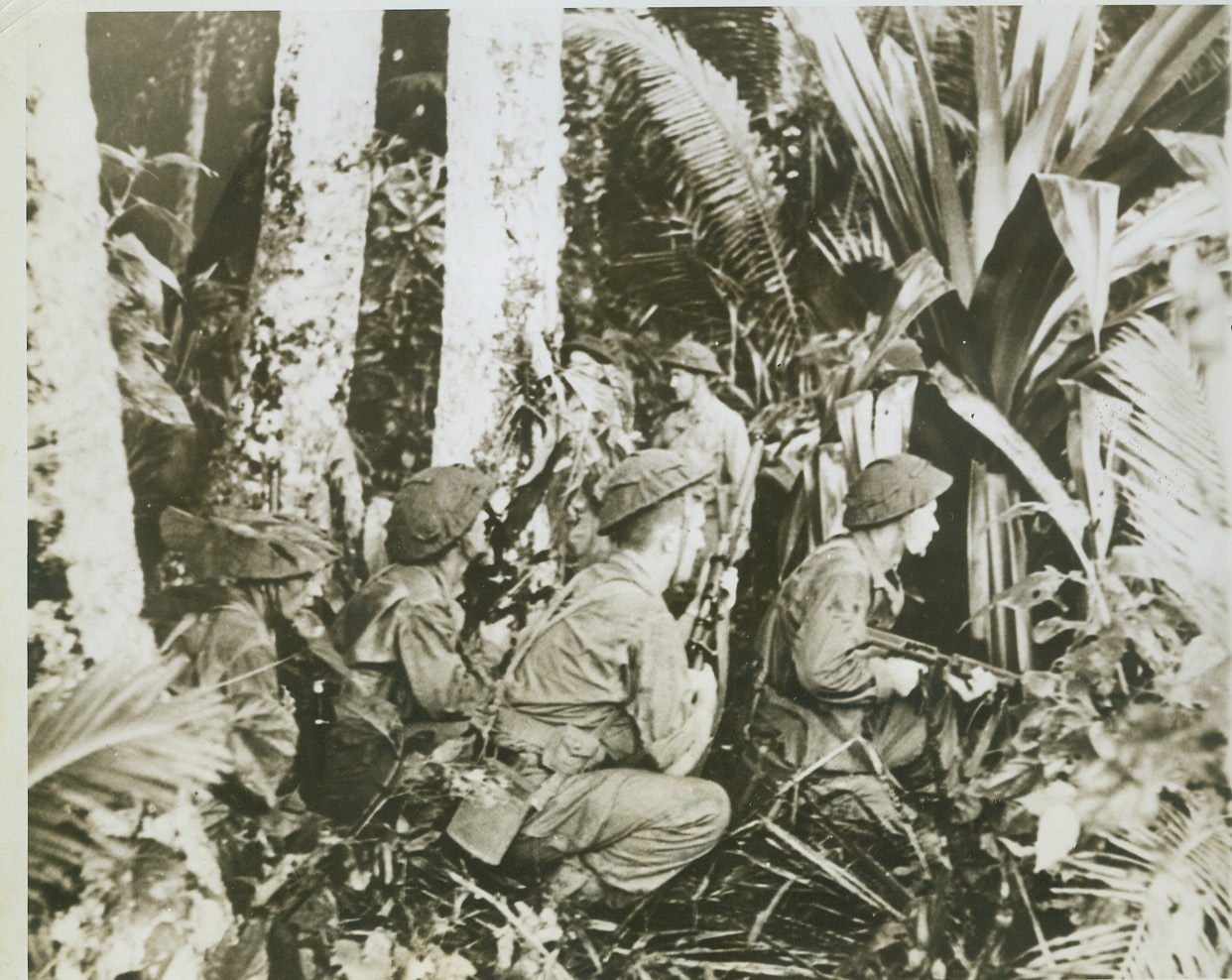
Now You Know Why Jungle Fighting is Tough, 11/10/1943. TREASURY ISLAND - It's difficult to distinguish these New Zealand soldiers in this jungle foliage so you can imagine how tough it is to see the enemy, too. These troops are deployed in the jungle after their recent invasion of Jap-help Treasury Island. Credit:--WP--(ACME);

Take Me, 11/5/1943. Not only did this Nazi paratrooper (left) beg to be captured, he jumped on the motorcycle of MP Private Bjorlin, of Duluth, Minn. To make certain he wouldn’t be left behind. The Germans in Italy have good reason to be tired of war, for their defense lines crumble almost as fast as they fashion them. Credit: ACME PHOTO VIA ARMY SIGNAL CORPS.;

Fighting Pals of the Forts, 11/10/1943. ENGLAND -- Winging through the wild blue yonder with our giant Flying Forts, little P-47 Thunderbolt fighters fill a vital and dangerous though glamorless job. Accompanying the big planes on a mission over Hitler's Europe, the little fighters are entrusted with the job of keeping enemy fighters far away from the Forts. It is not their job to seek dog fights. This series gives keen insight into the work of these men at a Thunderbolt station somewhere in England. New York Bureau Winging through clusters of puffy clouds, a formation of fighters sets out on a mission. The Thunderbolts sail through the skies at a speed of 250 miles per hour and better. Credit:--WP--(ACME);
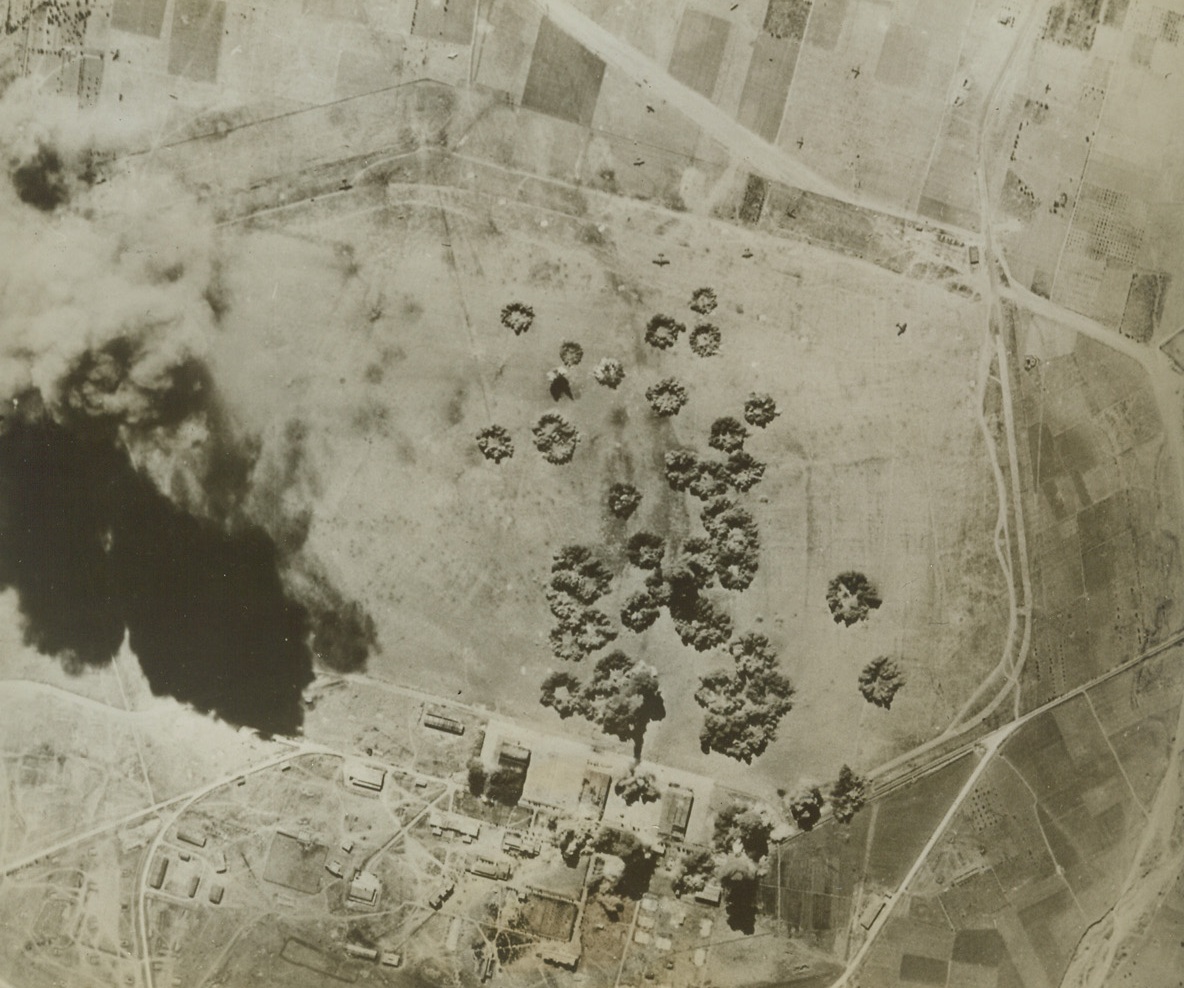
YANKS BOMB NAZI AIRFIELD IN GREECE, 11/11/1943. Bombs from Flying fortresses of the Northwest African Air Forces explode neatly within the target area on the Nazi-held airfield at Sedes, Greece, near Salonika, during a recent raid. Note extremely wide dispersal of aircraft, (in area from top to bottom, left in photo). Despite the fact that Greece has not been in the headlines, Allied air forces have bombed enemy-held installations on a number of occasions.Credit: U.S. Army Air Forces photo from Acme; Bombs from Flying fortresses of the Northwest African Air Forces explode neatly within the target area on the Nazi-held airfield at Sedes, Greece, near Salonika, during a recent raid. Note extremely wide dispersal of aircraft, (in area from top to bottom, left in photo). Despite the fact that Greece has not been in the headlines, Allied air forces have bombed enemy-held installations on a number of occasions.Credit: U.S. Army Air Forces photo from Acme;
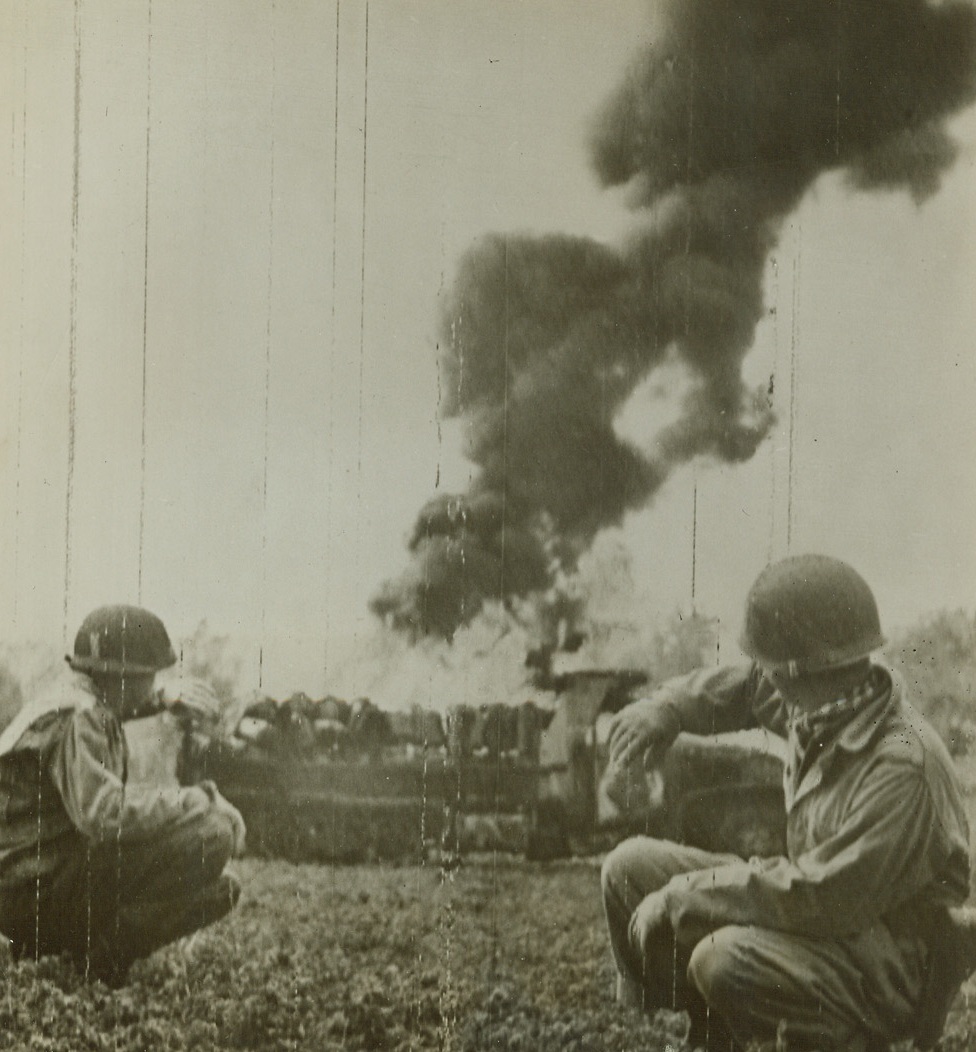
GERMAN BULLS-EYE ON GASOLINE CARRIER, 11/11/1943. Gasoline carrier truck of the U. S. Fifth Army blazes after being hit dead-center by German strafing planes, in the central sector front in Italy. American officers in the foreground shield their faces from the intense heat of the flames as they watch the progress of the blaze.Credit: Acme photo by Bert Brandt for the War Picture Pool via Signal Corps Radiotelephoto;
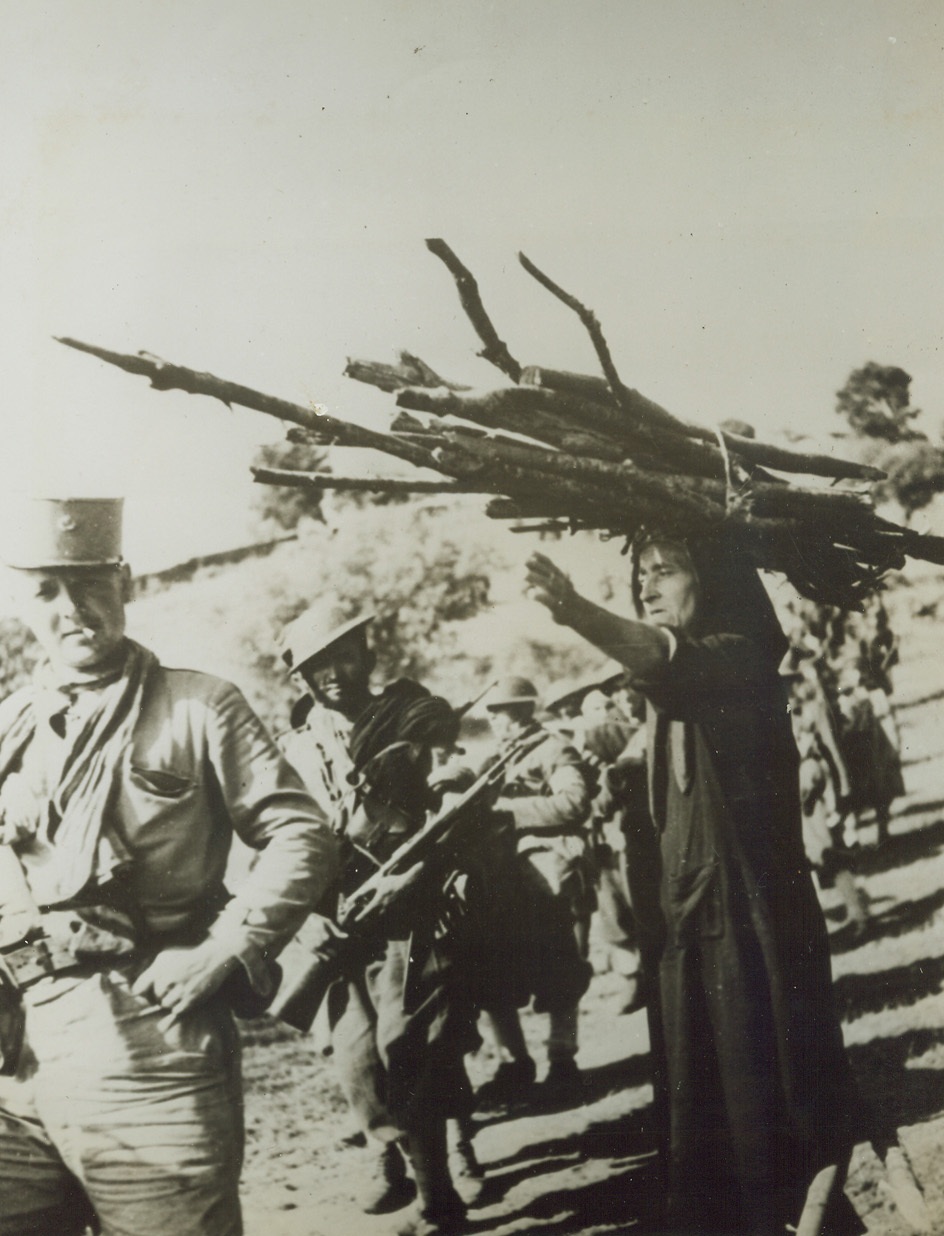
POINTING THE WAY, 11/12/1943. CORSICA—Pausing as she collects firewood and balancing a huge pile of the fuel on her head, an aged Corsican woman gives directions to French soldiers. Natives cooperated wholeheartedly with the warriors, who soon drove the Nazis out.Credit: French official photo thru OWI from Acme;
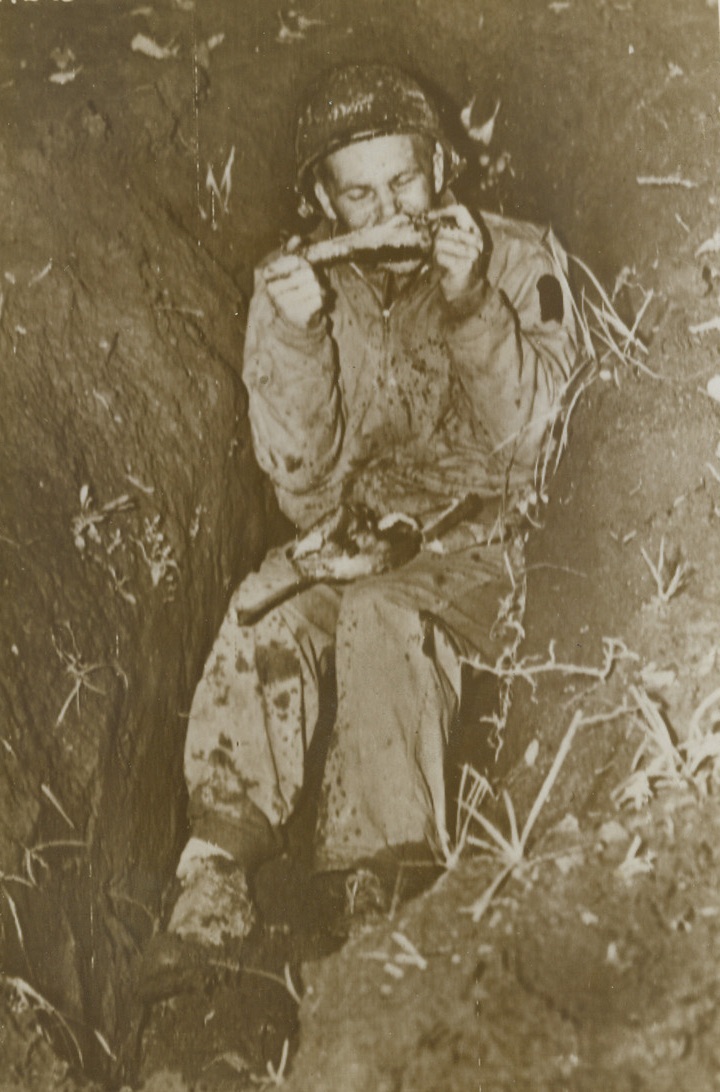
THANKSGIVING DINNER IN A FOXHOLE, 11/27/1943. SOMEWHERE IN ITALY—In a foxhole, near the fighting lines in Italy, Pvt. Don Finholm of Ludington, Mich., digs into a turkey drumstick on Thanksgiving Day, while a full mess kit rests in his lap. Hot dinners were rushed to every man at the front, via truck, mule pack, and even personal courier, so that every Yank might enjoy the traditional Thanksgiving feast.Credit: Photo by Acme photographer for War Picture Pool, Bert Brandt, transmitted by Signal Corps Radiotelephoto;

BAILING OUT, 11/26/1943. ITALY—Forming a helmet brigade, members of an anti-aircraft crew bail out more than 18 inches of water that gathered in their gun emplacement as torrents of rain descended upon them in Italy. Left to right: Pfc. Woodrow Porter, of Dover, Tenn.; Pfc. Edward J. Zvonek of Detroit, Mich.; and Pvt. George Cooper (in pit) of New Bedford, Mass.Credit: U.S. Marine Corps photo from Acme;
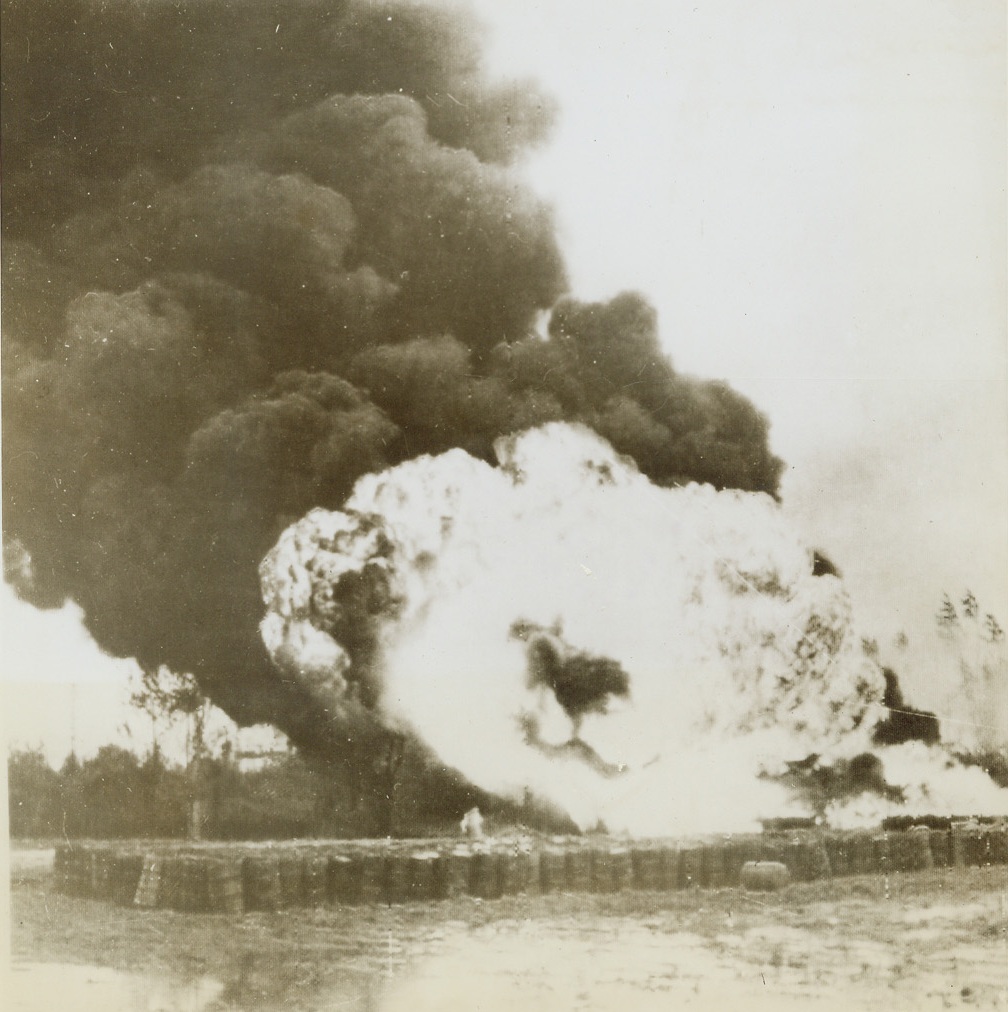
NAZIS SCORE HIT ON ALLIED FUEL DUMP, 11/26/1943. ITALY—Black-edged fire billows from a Fifth Army fuel dump in Italy, after an enemy raid near Aversa. As yet unexploded barrels of gasoline await destruction by the roaring blaze.Credit: OWI Radiophoto from Acme;

ONE FOR THE NAZIS, 11/26/1943. ITALY—American Fifth Army troops work frantically to save barrels of gas and oil from flaming destruction, after the Germans scored a hit on al Allied fuel dump near Aversa, Italy. Flames in the background are a source of danger to both the workers and the precious fuel they roll to safety. Credit: Acme Radiophoto;
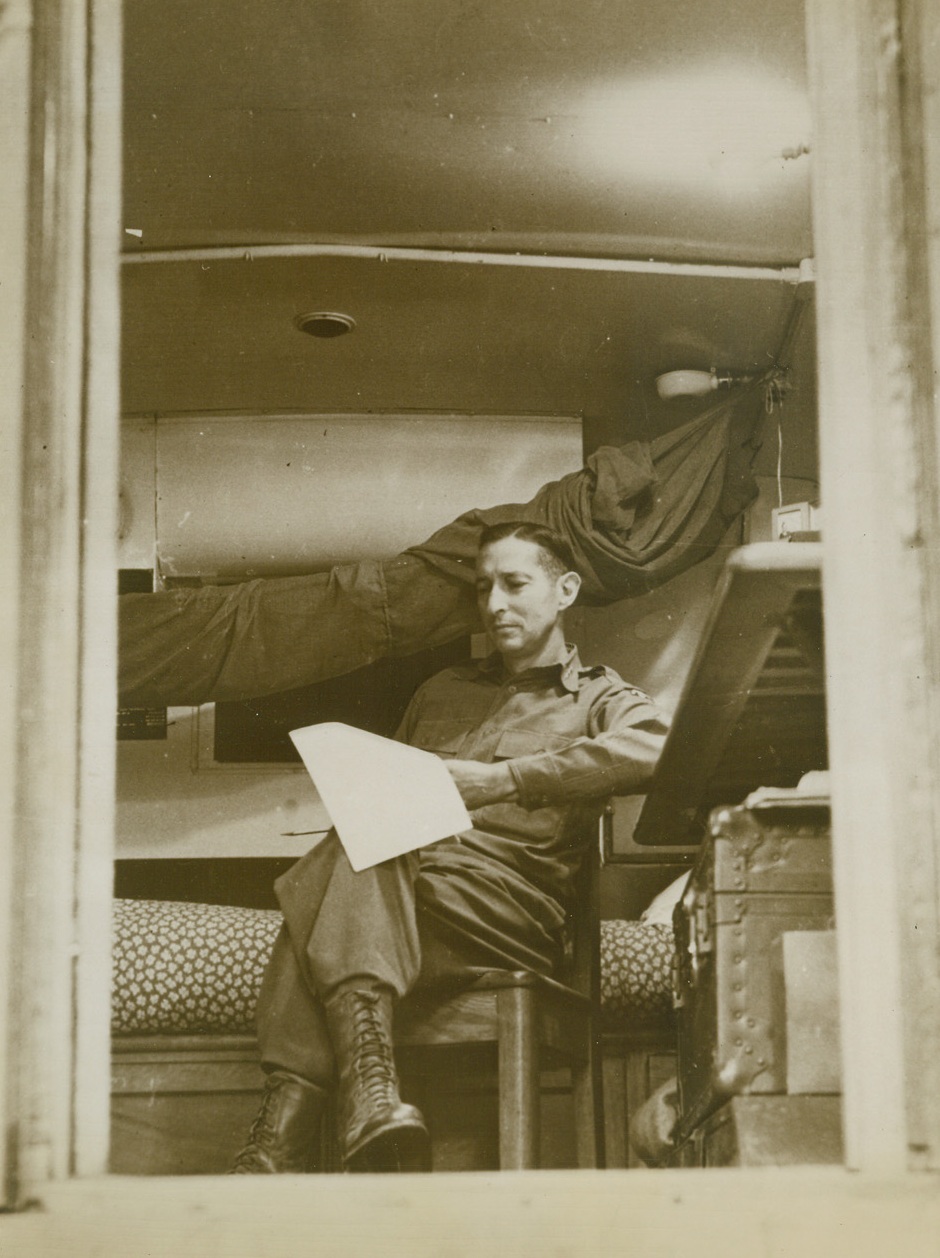
THE GENERAL, AT EASE, 11/10/1943. ITALY—Seen through the open door of his trailer, in which he lives throughout the campaign, Lt. General Mark W. Clark relaxes alongside his cot as he reads an official report. Credit: Acme;
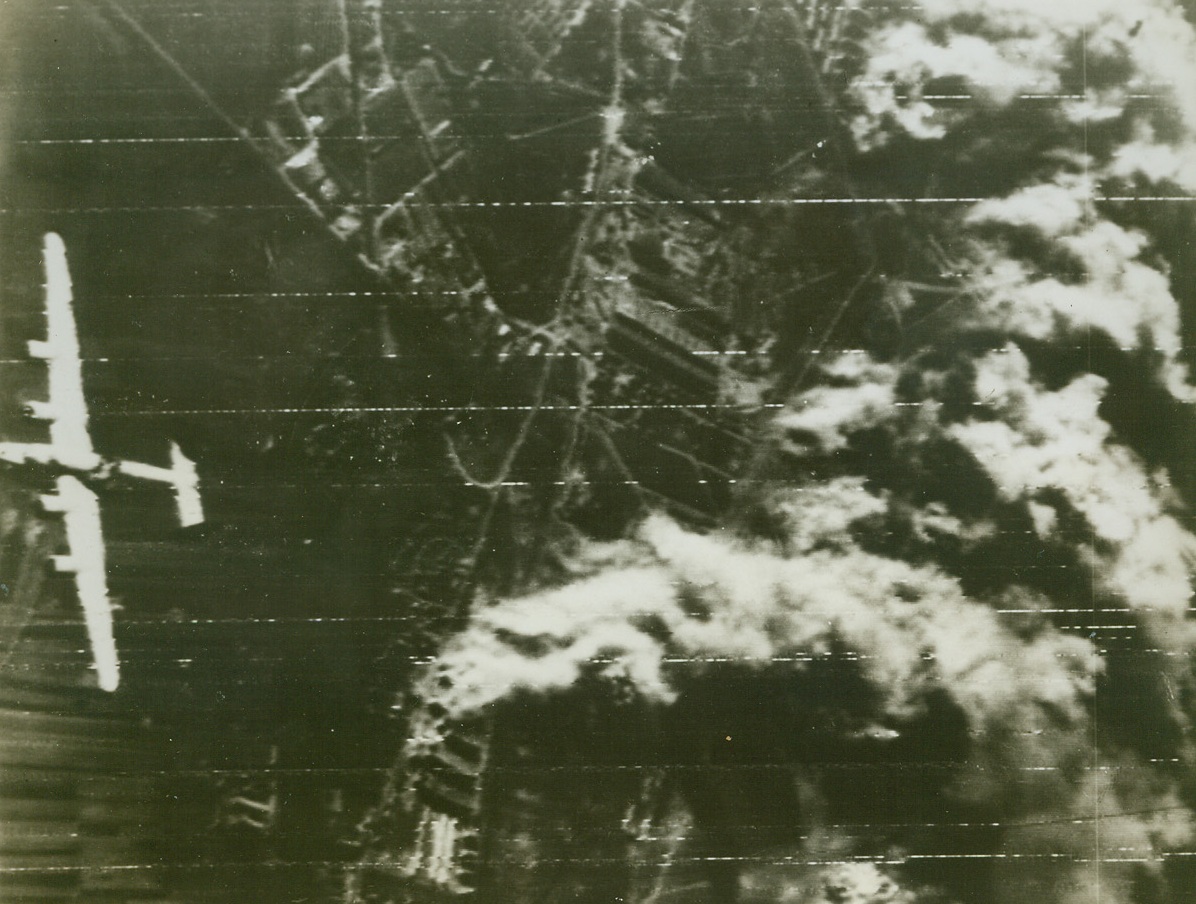
DOOMED U.S. BOMBER, 11/8/1943. A consolidated B-24 Liberator of the U.S. 15th Air Force, a huge hole smashed in its fuselage just abaft the wing, leaves the smoking target, the Weiner Neustadt aircraft plant near Vienna, during the raid last Nov. 2. Just after this photo, which was flashed to the U.S. by Radiotelephoto today, was taken, the ship went into its death dive. Heavy flack blasted the hole and doomed the Liberator. Credit: U.S. Army Air Forces photo via U.S. Signal Corps Radiotelephoto from Acme;
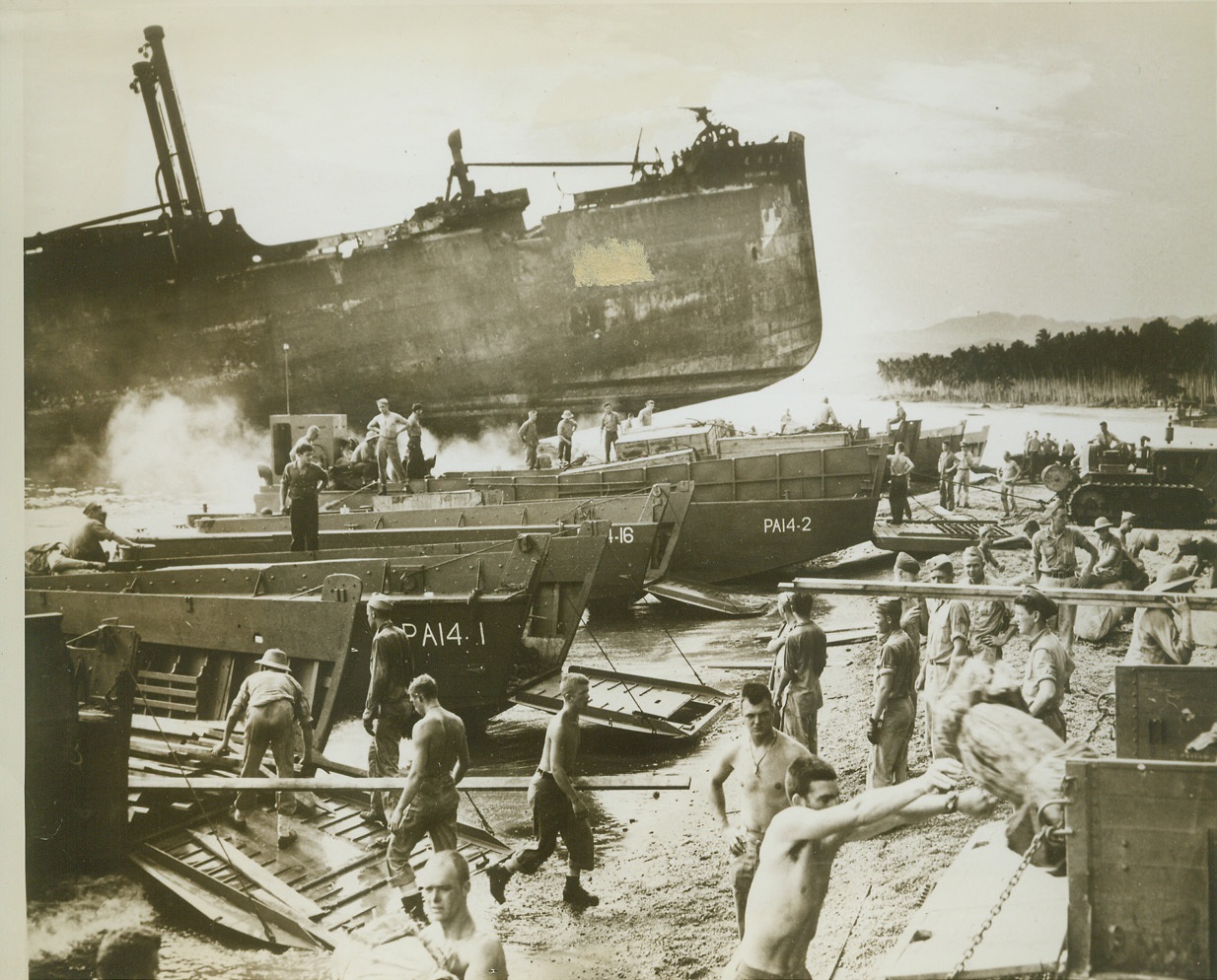
Japs Contribute "Breakwater" for Harbor, 11/10/1943. SOLOMONS -- When U.S. Forces blasted the Nip ship the Kinugawa Maru, it was conveniently beached on this Solomon Island forming a breakwater and sheltering landings by Allied Forces. Here, in the shadow of the Jap vessel's burned out hulk, U.S. Coast Guardsmen unload lumber and other supplies, brought ashore from a transport by landing craft. Credit: (U.S. Coast Guard Photo from ACME);
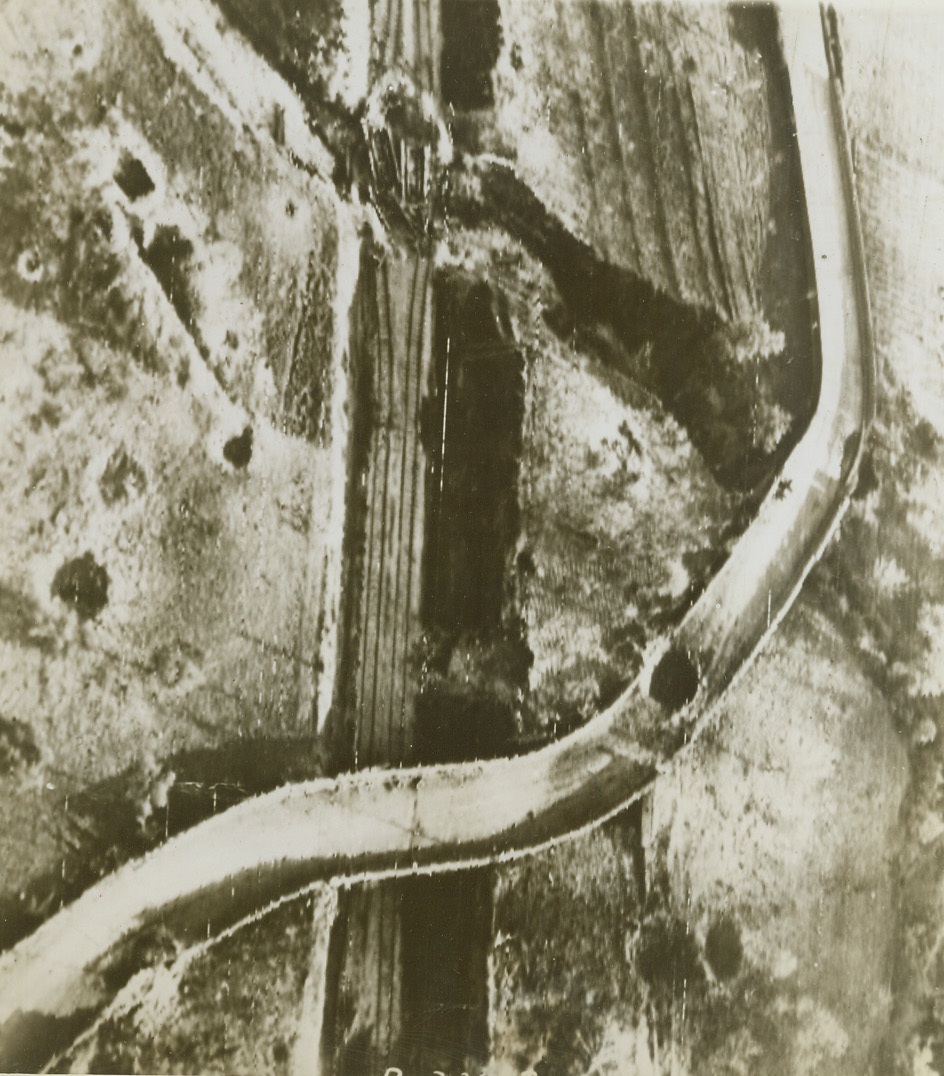
PRECISION BOMBING, 11/17/1943. The score card of precision bombing is clearly marked in this aerial photo of a bombed railway line and road at Staz-de-Toro-Presenzano, Italy. Direct hits on a railroad trestle and on the road can be seen, while near hits pock-mark the area around the objective. Credit: Photo by Charles Seawood, Acme photographer for War Pool, via U.S. Signal Corps Radiotelephoto;
![HER AMPITHEATRE [sic] HOME, 11/17/1943. SICILY—This huge Roman ampitheatre [sic] was “home” to many Sicilian families during the first few days after the Germans were driven from Sicily. With their houses broken and bomb-wrecked, natives had to take cover in makeshift homes like this until their former homes could be rebuilt. Credit: [illegible] from Acme;](/media/12801/77091815.jpg)
HER AMPITHEATRE [sic] HOME, 11/17/1943. SICILY—This huge Roman ampitheatre [sic] was “home” to many Sicilian families during the first few days after the Germans were driven from Sicily. With their houses broken and bomb-wrecked, natives had to take cover in makeshift homes like this until their former homes could be rebuilt. Credit: [illegible] from Acme;
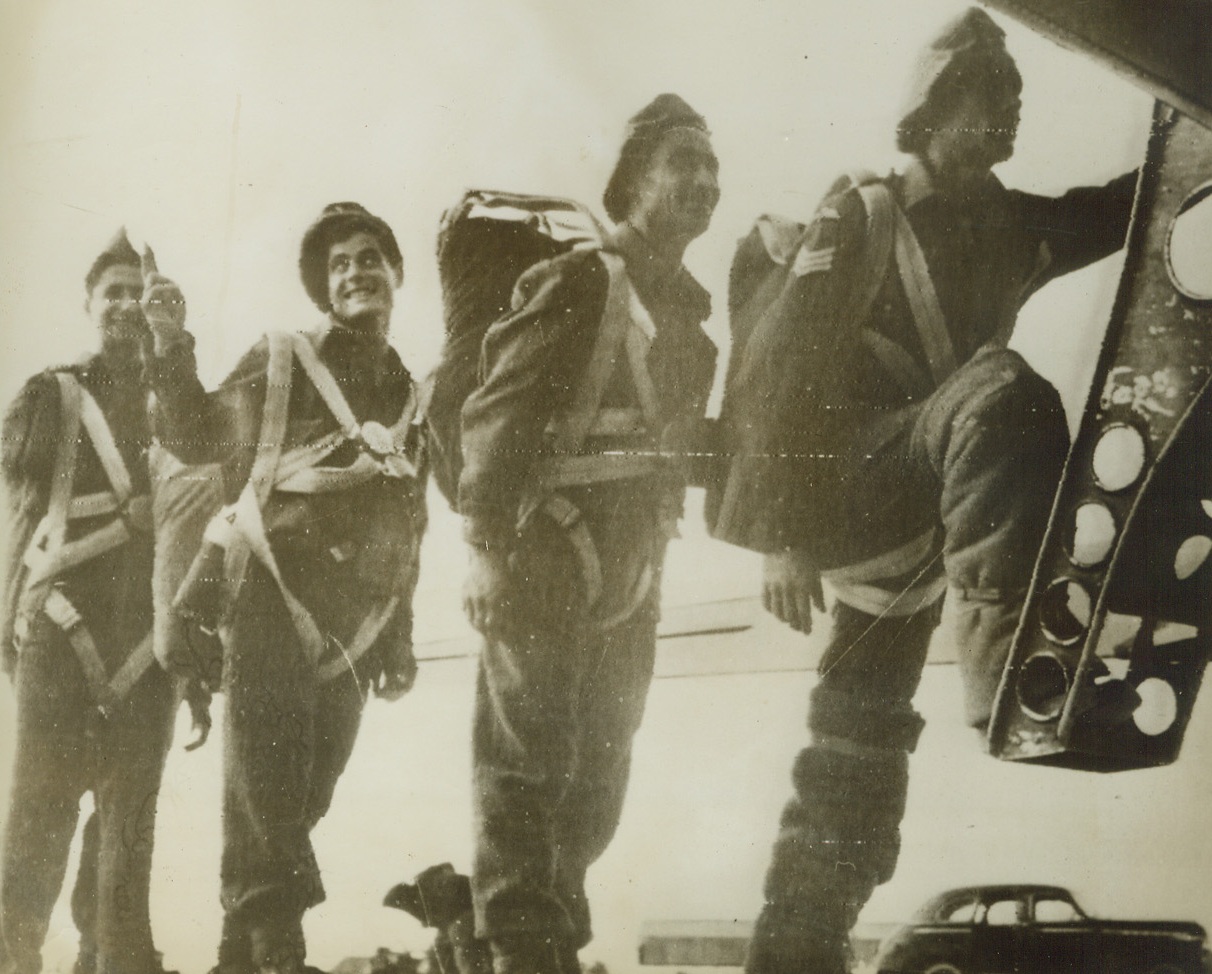
GREEK CHUTISTS OFF TO SAMOS, 11/15/1943. MIDDLE EAST—“Do Or Die” Greek parachutists climb aboard a transport which will fly them to Samos Island, where they are now reinforcing the Allies who are battling Nazi invaders. The Greek Sacred Brigade has traditions dating back 2,000 years when its slogan was “come back victorious or dead.” Credit: Acme Radiophoto;
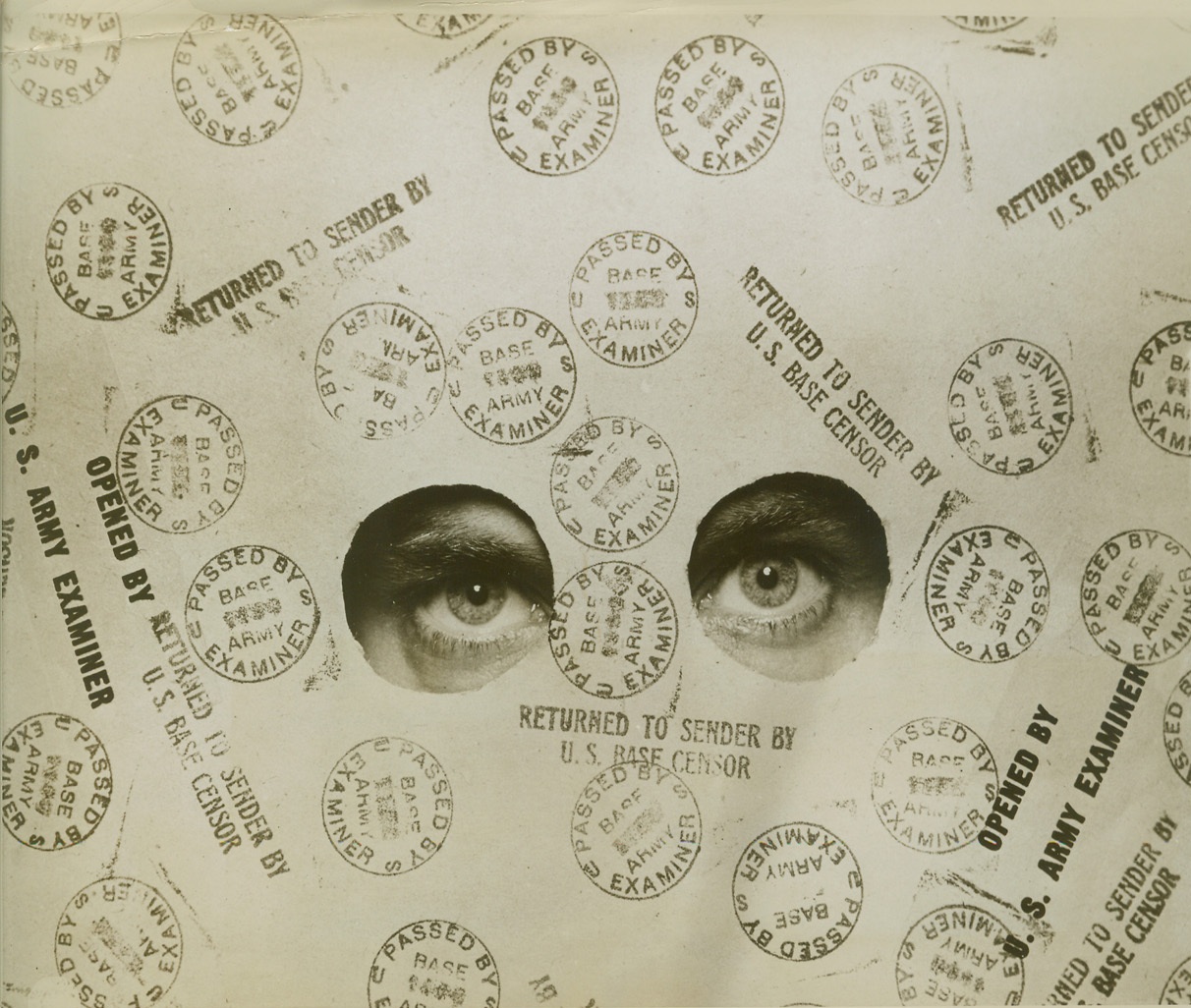
The Censor is Watching You!, 11/11/1943. Just in case you want to try and slip something over on the censor -- don't do it, for he's got his eyes wide open. To make it emphatic, an Army photographer with a sense of humor, took this photo. The paper bears the counter-stamps of base censors and U.S. censors. Credit: (U.S. Army Official Photo from ACME);
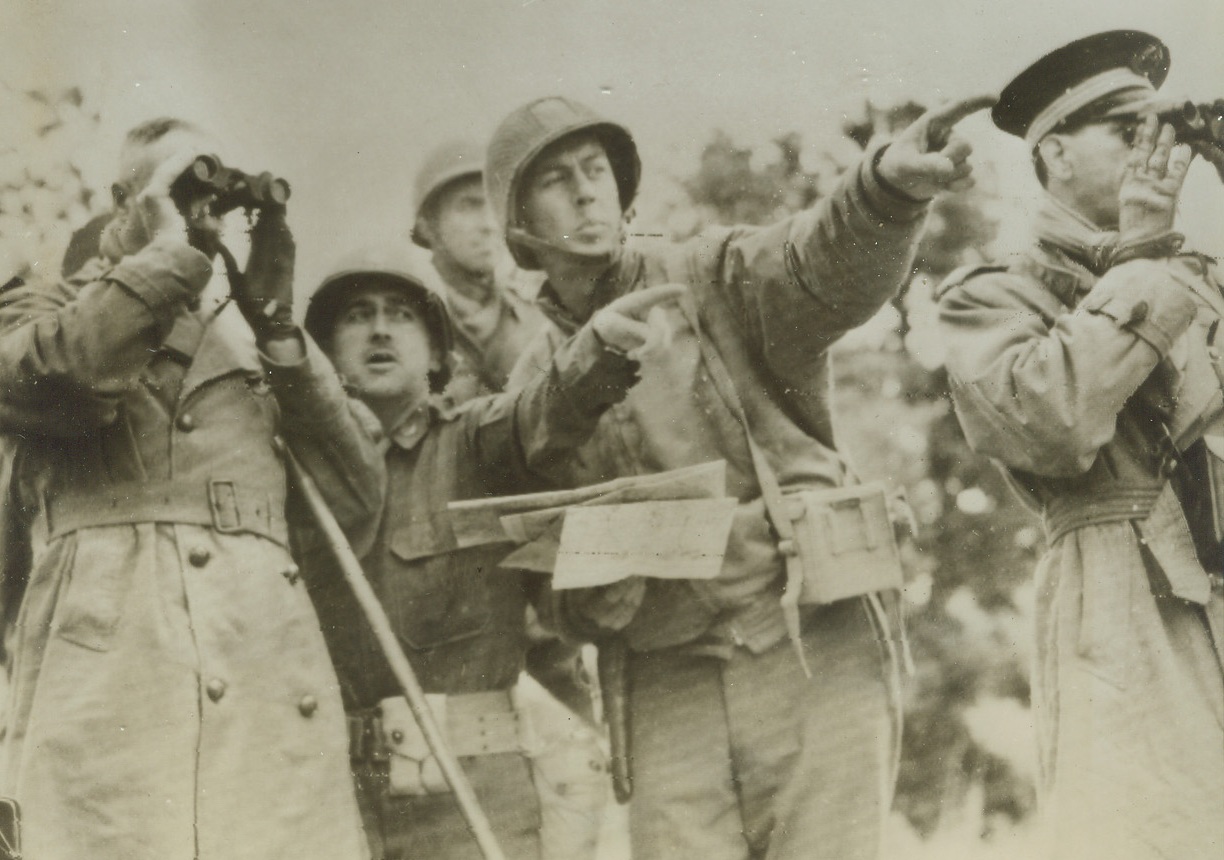
French Leader at Front, 11/3/1943. ITALY – Gen. Henri Giraud, military leader of the fighting French (left), looks through glasses at positions pointed out by Allied officers near the front line. Credit (U.S. Signal Corps Radiotelephoto from ACME);
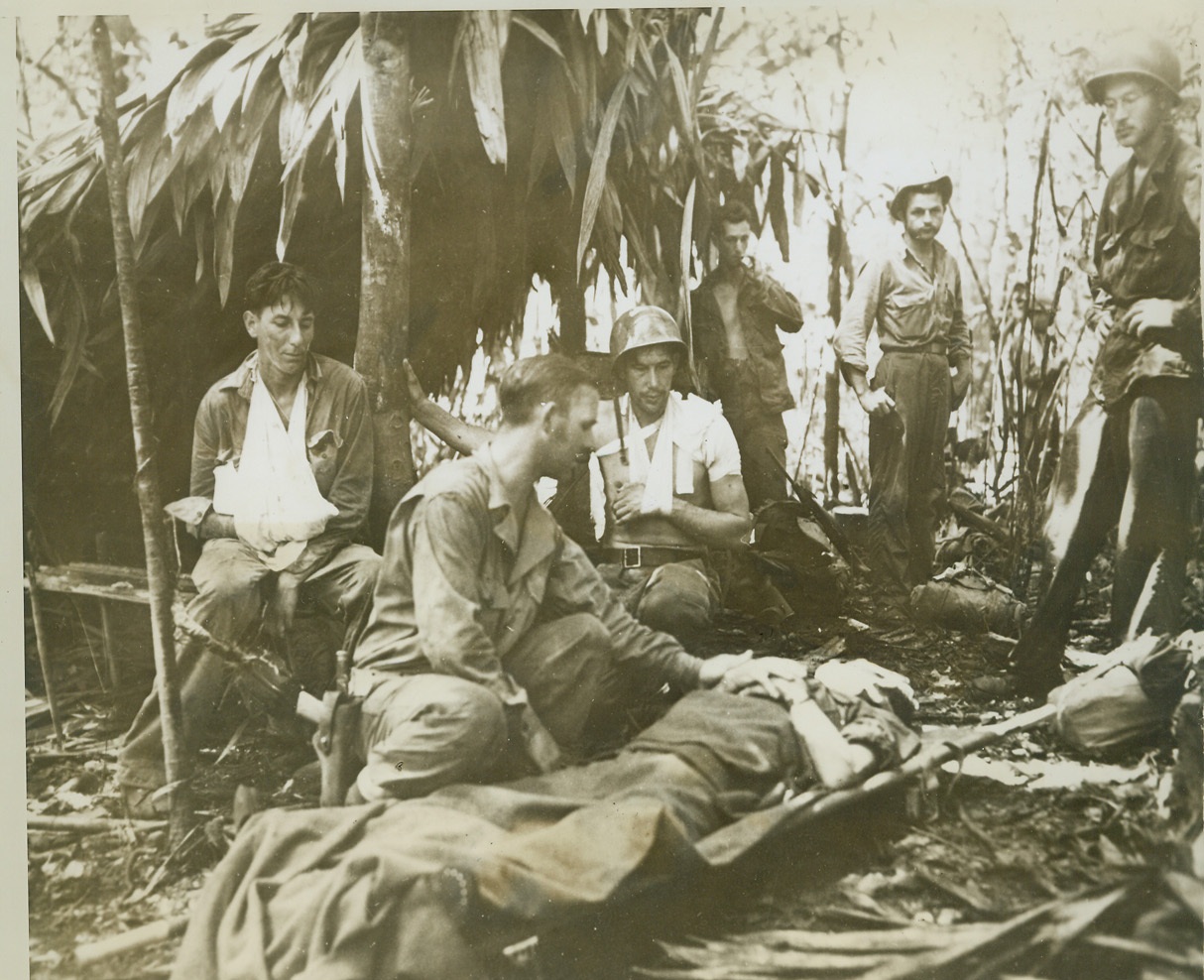
Wounded on New Georgia, 11/24/1943. NEW GEORGIA ISLAND -- Exhausted, the lines in their faces revealing the strain under which they've been fighting, these Yanks stop to rest in a deserted Jap bivouac, from which the boys chased the enemy. Those who escaped injury watch a Medical Corps officer treat an unidentified wounded man. Watching, too, are Sgt. Morris Hain (extreme left), whose arm is in a sling, and Cpl. Hollis Templeton, whose left shoulder is bandaged. Credit: (Signal Corps Photo from ACME);
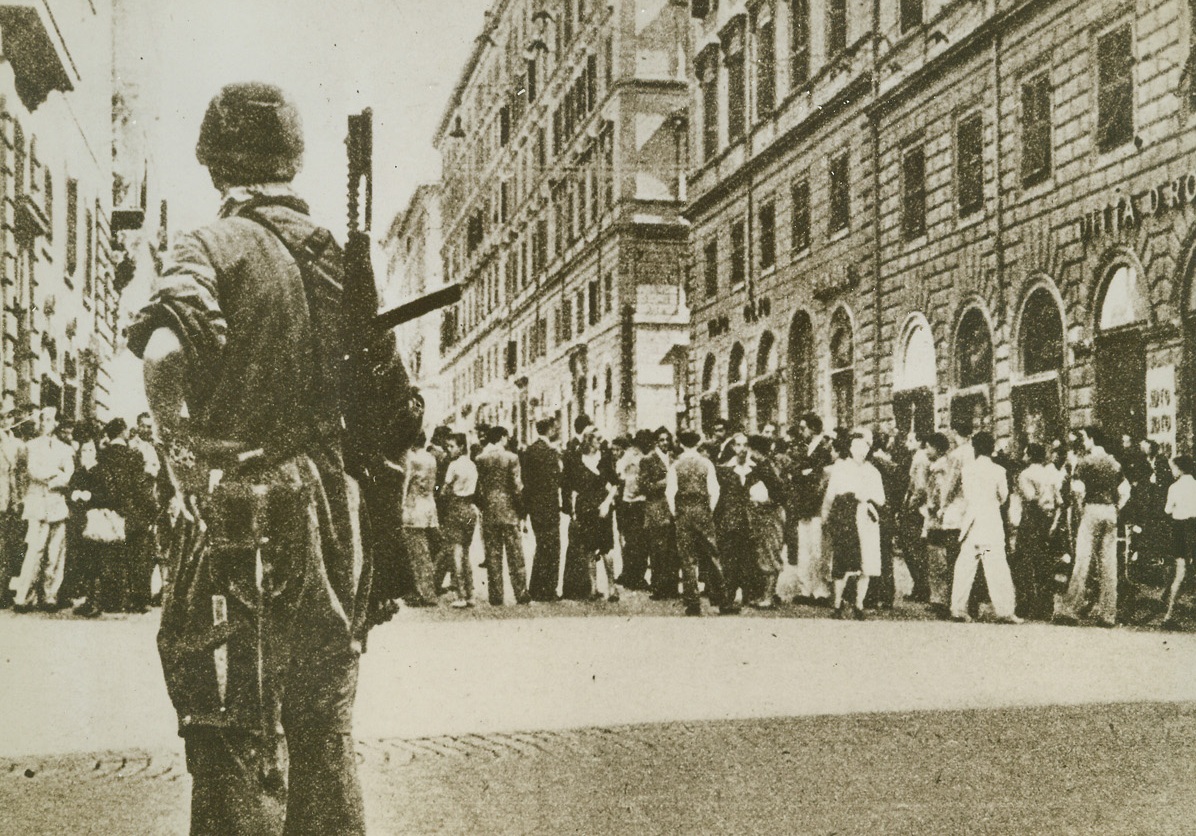
They Remember Naples, 11/8/1943. Rome, Italy – Natives, (background), in this street in Rome, remember the rape and pillage of the once-beautiful city of Naples by the Germans, and avoid this heavily-armed Nazi paratrooper, (left foreground) as if he had a deadly plague. Since the Germans turned on the Italians after the armistice shooting many down like dogs, Italian hate of Nazis has steadily grown. This photo, released in New York today, is from a neutral source. (Passed by censors). Credit Line (ACME);
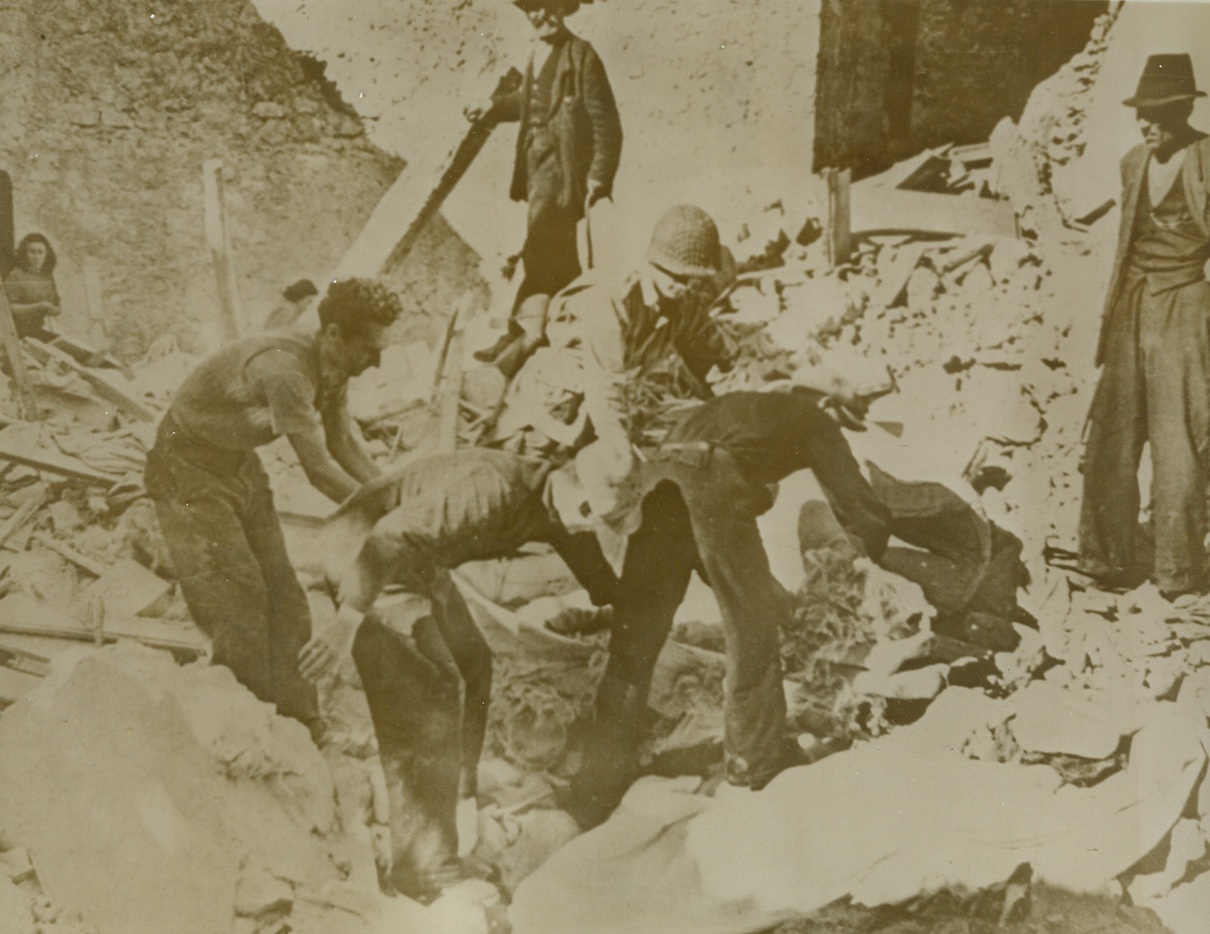
Grim Job, 11/24/1943. PRATA, ITALY – To those who lived after the fleeing Germans blew up a road block in Prata, fell the grim job of removing the bodies of those killed in the explosion from the wreckage. Pvt. Dick Heusle of Mexia, Texas, helps Italian civilians remove the body of a young woman from the ruins. Credit Line (ACME);
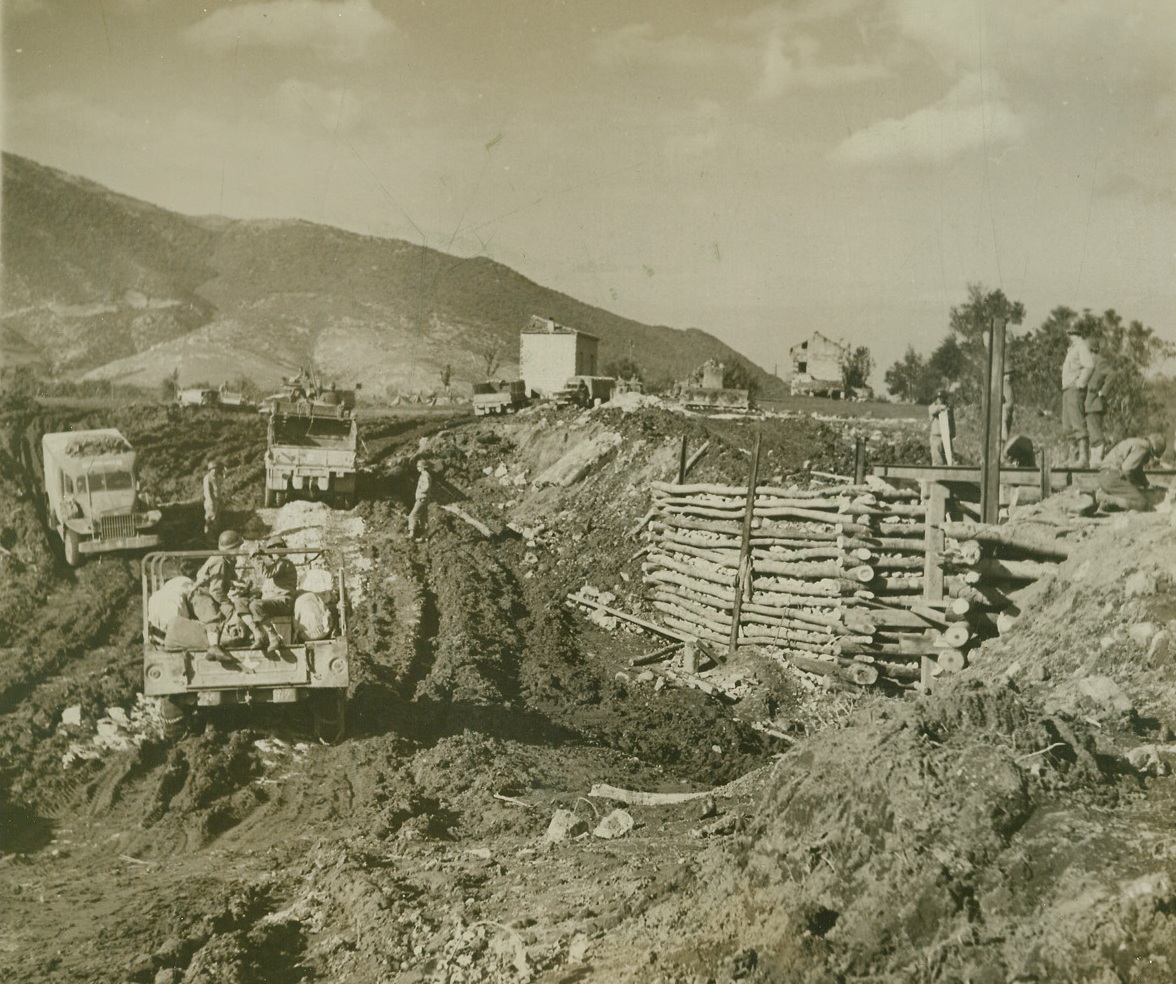
Battlefront Boulevard, 11/23/1943. WITH THE FIFTH ARMY IN ITALY -- Jeeps and trucks of the U.S. Army, plow through hub-deep mud crossing this dry stream bed on a temporary road, along a section of the Italian Front. In center, background, engineers work to complete a bridge to replace one blown up by the Germans as they retreated to Cassino. Credit Line (ACME Photo by Bert Brandt for the War Picture Pool);
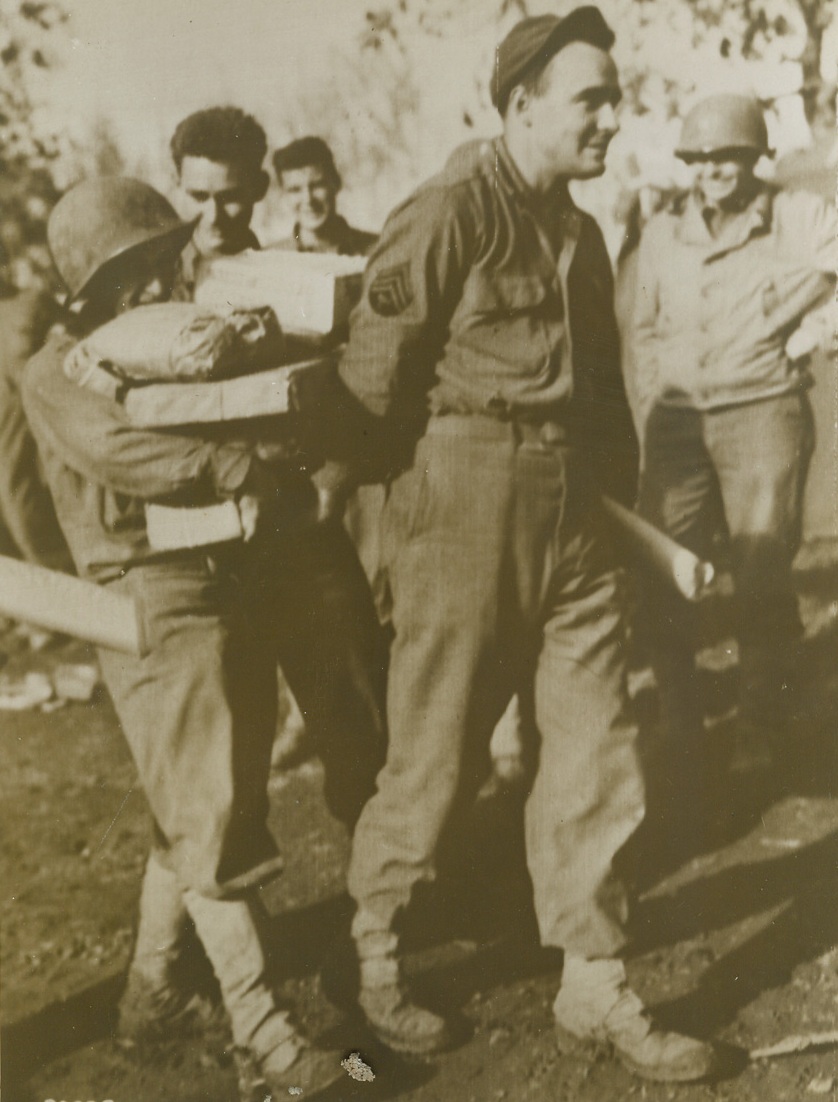
Santa Was Good to Him, 11/27/1943. SOMEWHERE IN ITALY -- Lucky Pvt. Charles "Snuffy" Schmitz, of New York City, hit the jackpot, so far as Christmas gifts from home were concerned. The doughboy collected so many packages from home that he needed help to get them to his tent. T/4 John W. Griffin of Western Springs, Ill., thinking of the chocolate cake and toll house cookies that might be hidden beneath those paper wrappings decided to lend a helping hand. Credit (Signal Corps Radiotelephoto from ACME);
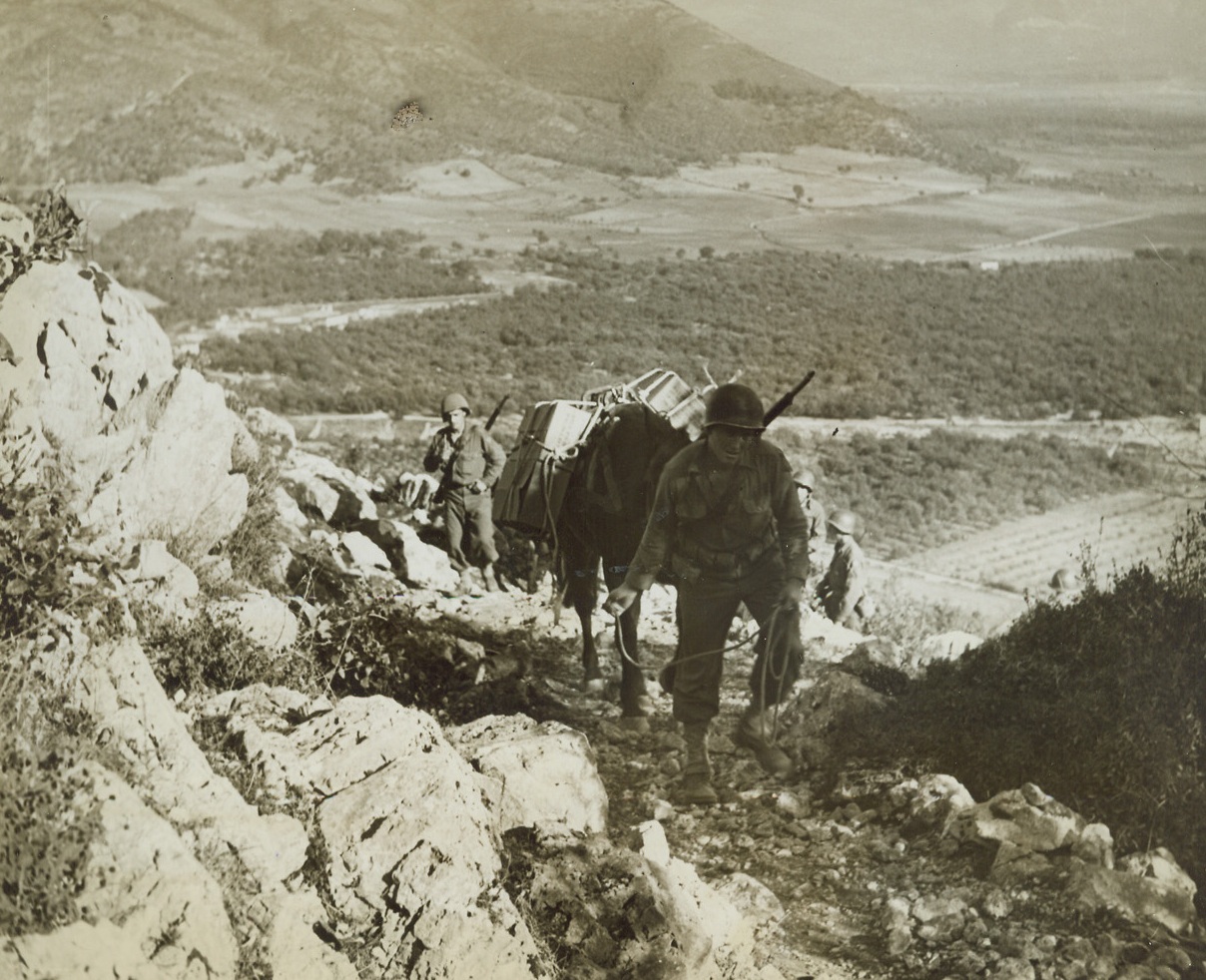
Ration Train, 11/28/1943. SOMEWHERE IN ITALY -- Carrying rations for our fighting men, a mule pack trail picks its way across the rocky slopes of Italy. Supplies and ammunition must be hauled over this rugged, mountainous terrain before they can reach our Fifth Army men as the front. Credit Line - WP-(Photo by Bert Brandt, ACME Correspondent for War Picture Pool);
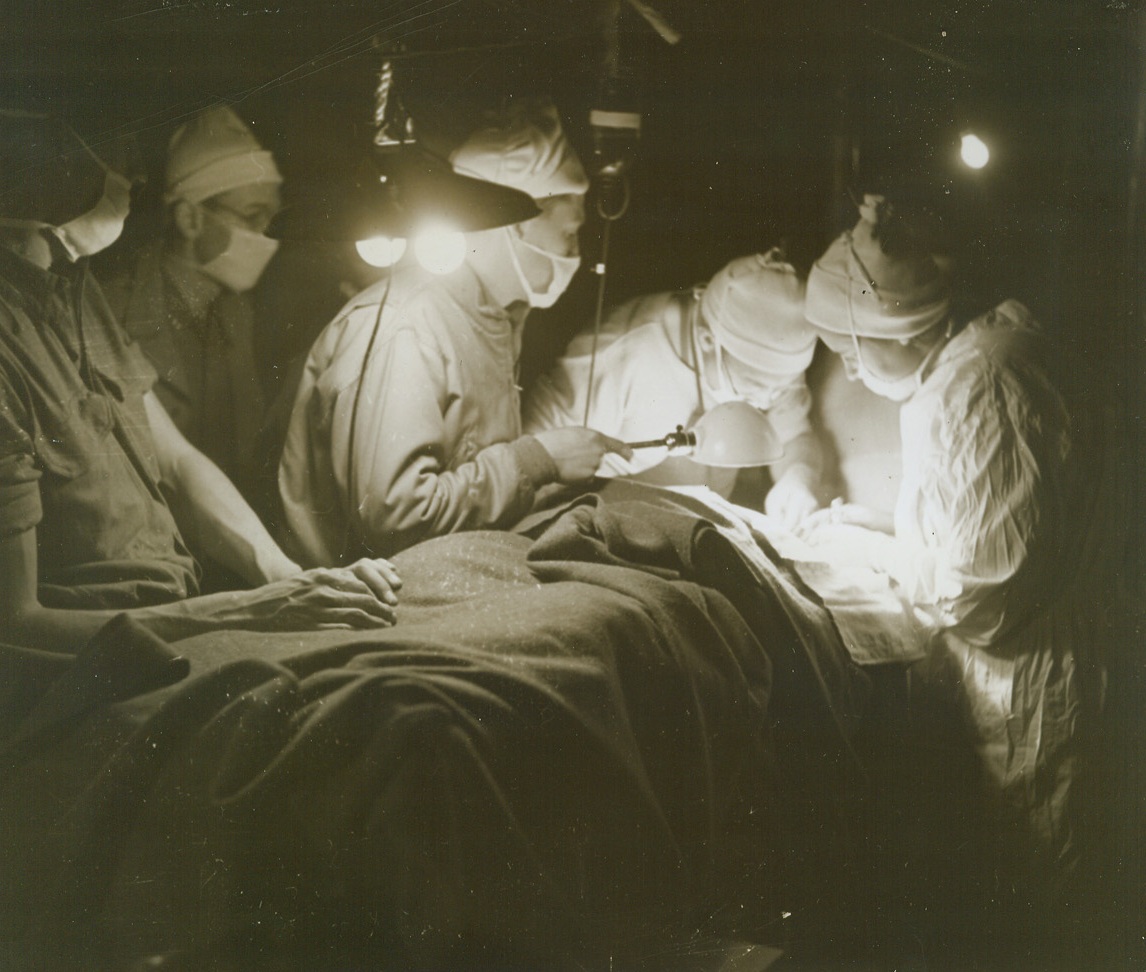
Men in White - At the Front, 11/28/1943. SOMEWHERE IN ITALY -- Makeshift lighting casts an eerie glow about this "operating room" as white-clad Army surgeons perform a difficult operation in a field hospital behind the front lines. The strain of their work increased by inadequate facilities, these heroic doctors render immediate surgical treatment to men picked off the field, who are too far gone to withstand a trip to an evacuation hospital before the operation. Credit Line - WP - (Photo by Bert Brandt, ACME Correspondent for War Picture Pool);

Frolic at the Front, 11/28/1943. SOMEWHERE IN ITALY -- It's a festive occasion at the Italian front as the guys and gals drag out a portable phonograph and cut a figurative rug on foreign soil. At left, dancing with Lois Berney of Fallon, N.C., is Pfc Clyde Burgess of Tolcoa, Ga. Dancing at right are Mary Ross Mohen of Unawa, Iowa and Pvt. William Maderra of Rayland, Ohio. The girls are Red Cross workers whose job is to boost the morale of Fifth Army men. Credit Line - WP - (Photo by Bert Brandt, Acme Correspondent for War Picture Pool);
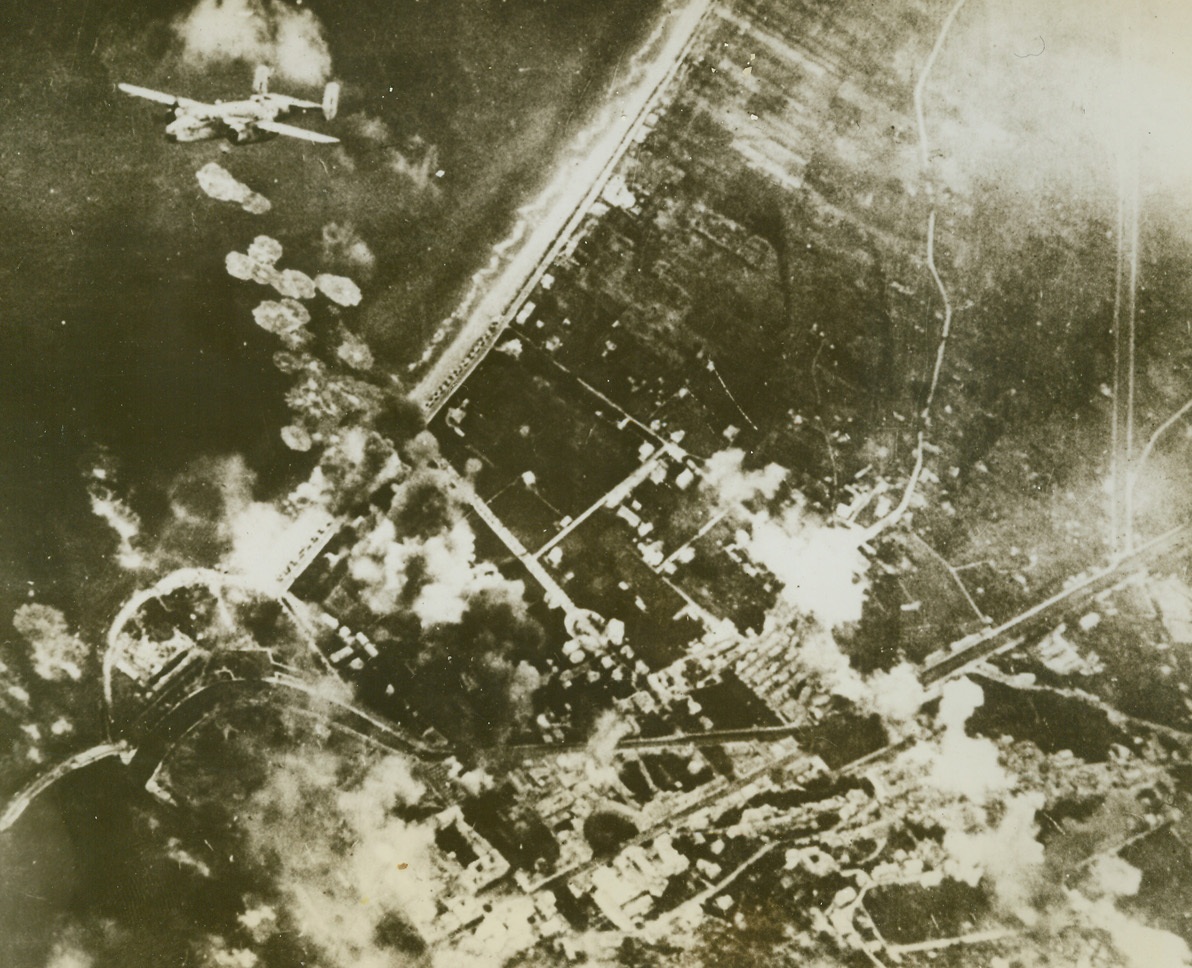
Bombs for Terraccina, 11/16/1943. TERRACCINA, ITALY -- Bombs from Mitchell B-25 bombers of the U.S. Tactical Air Force, explode on the West Coast Italian city of Terraccina, during a recent attack which blasted Nazi supply lines at this important center. Credit Line (ACME);
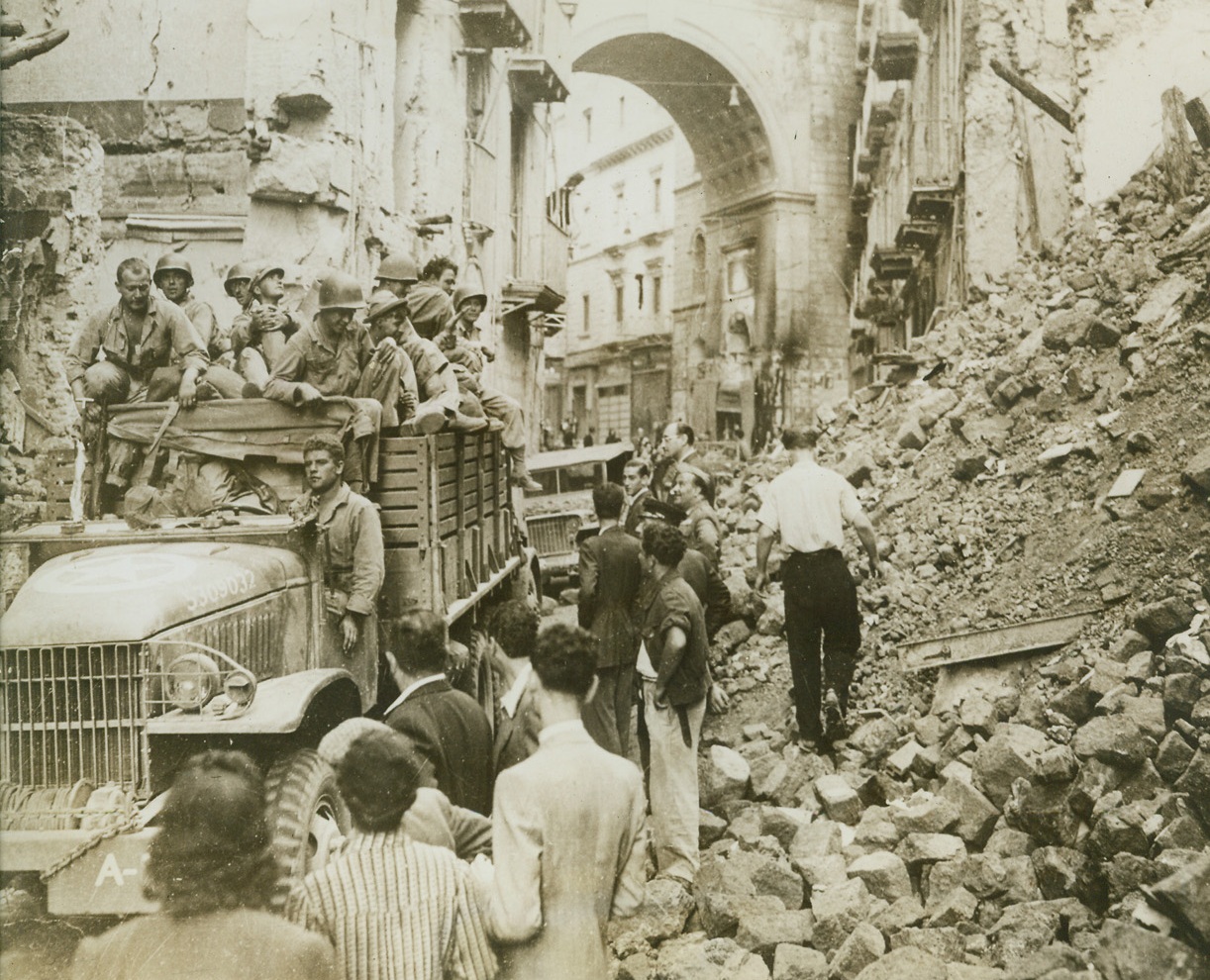
Returning Naples to Normalcy, 11/2/1943. NAPLES, ITALY – A group of 5th Army Unites States troops are held up in Naples as a labor group clears away debris of bomb wreckage from the streets of the city. Credit (PWB Photo from OWI via Acme);

Cleaning up Naples, 11/2/1943. NAPLES, ITALY – Working with crane and dump trucks, Allied engineers clear away debris from bombed buildings in Naples. The work of rehabilitating the city goes on while fighting Allied troops push on to the north. Credit (PWB Photo from OWI via Acme);
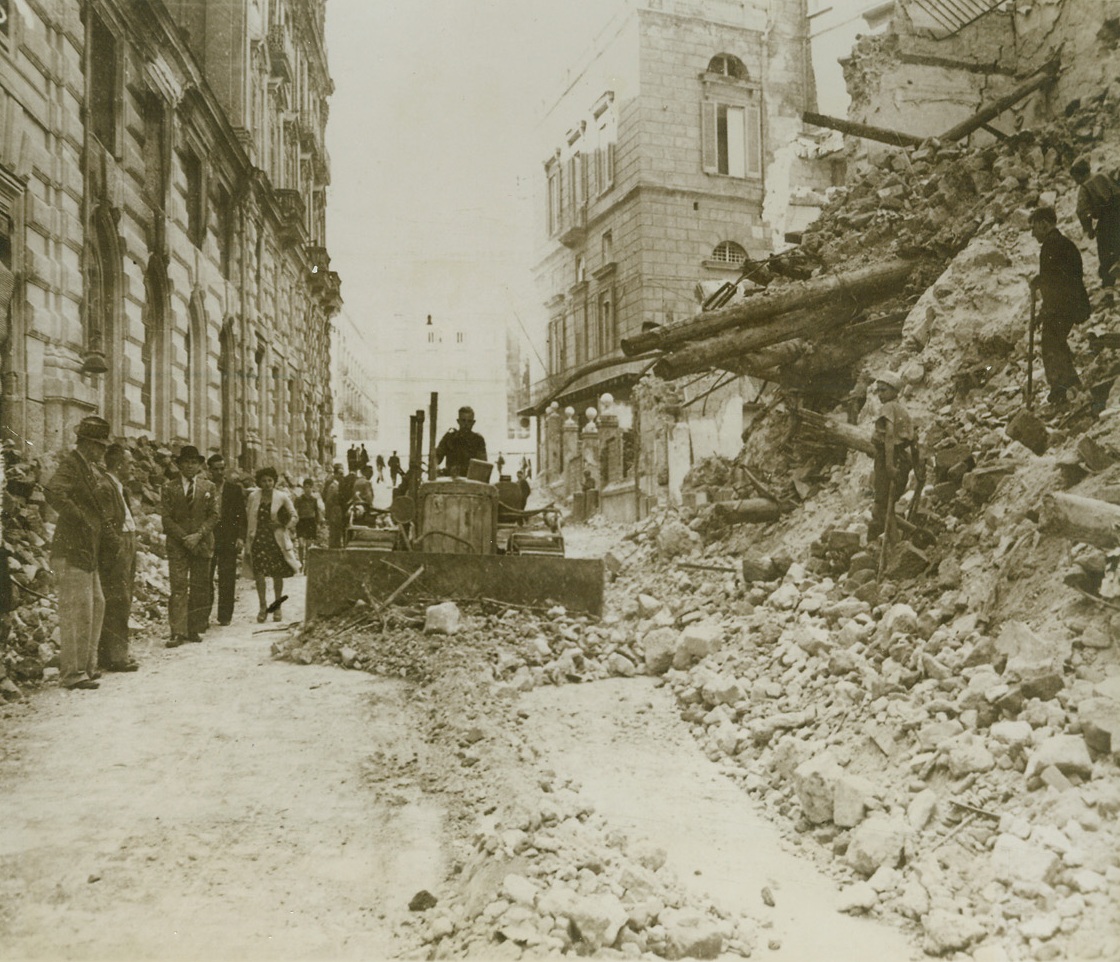
Returning Naples to Normalcy, 11/2/1943. NAPLES, ITALY – A bulldozer scrapes the debris from the streets of Naples as citizens looks on. The rubble silently testifies to the havoc wrought by war. Credit (PWB Photo from OWI via Acme);
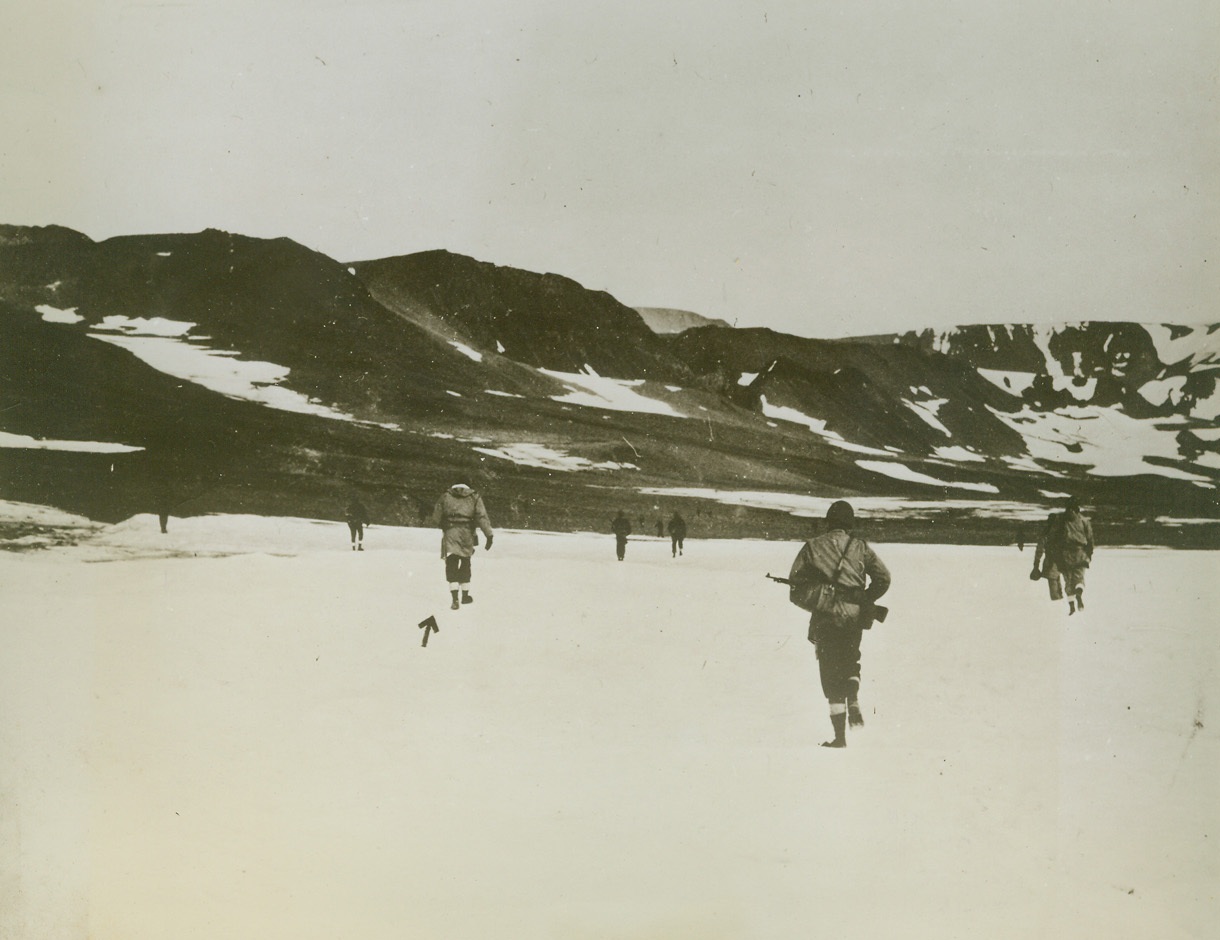
German Weather Base Destroyed, 11/9/1943. Secretary of the Navy Frank Knox today revealed that a powerful German radio and weather base on an island off the coast of Greenland, had been destroyed by U.S. Forces and two prisoners taken. This is the second time in recent months such a base has been taken. Here, U.S. Coast Guardsmen under Capt. Carl C. Von Paulsen (arrow, left), USCG, charge in skirmish formation toward the German Army’s radio station and base beyond the hills.Credit: (U.S. Coast Guard Photo from ACME);
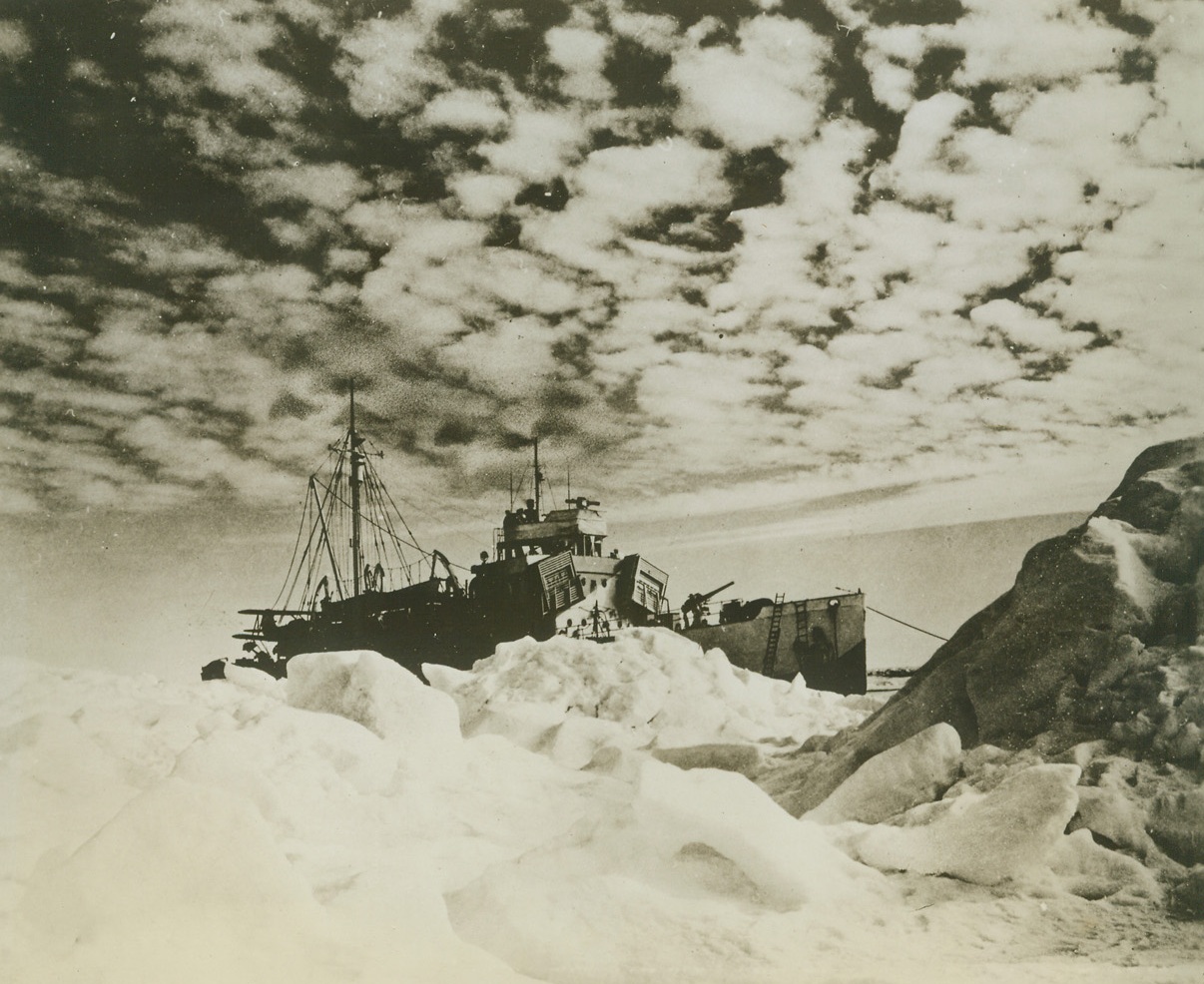
German Weather Base Destroyed, 11/9/1943. Secretary of the Navy Frank Knox today revealed that a powerful German radio and weather base on an island off the coast of Greenland, had been destroyed by U.S. Forces and two prisoners taken. This is the second time in recent months such a base has been taken. Here, a Coast Guard Cutter waits offshore as its landing force of Coast Guardsmen and soldiers advance on the base. A second cutter taking part in the combined operations became jammed in the ice and was trapped for a month.Credit: (U.S. Coast Guard Photo from ACME);

German Weather Base Destroyed, 11/9/1943. Secretary of the Navy Frank Knox today revealed that a powerful German radio and weather base on an island off the coast of Greenland, had been taken and destroyed by U.S. Forces and two prisoners taken. This is the second time in recent months such a base has been captured in Greenland waters. Here, one of the prisoners, identified only as “Dr. Sennse,” takes a last look at the site from the deck of a U.S. Coast Guard cutter. The man had been building a grave over the body of a boy, a member of the Danish scouting party that discovered the base, and returned to the base to find the Americans had captured it.Credit: (U.S. Coast Guard Photo from ACME);
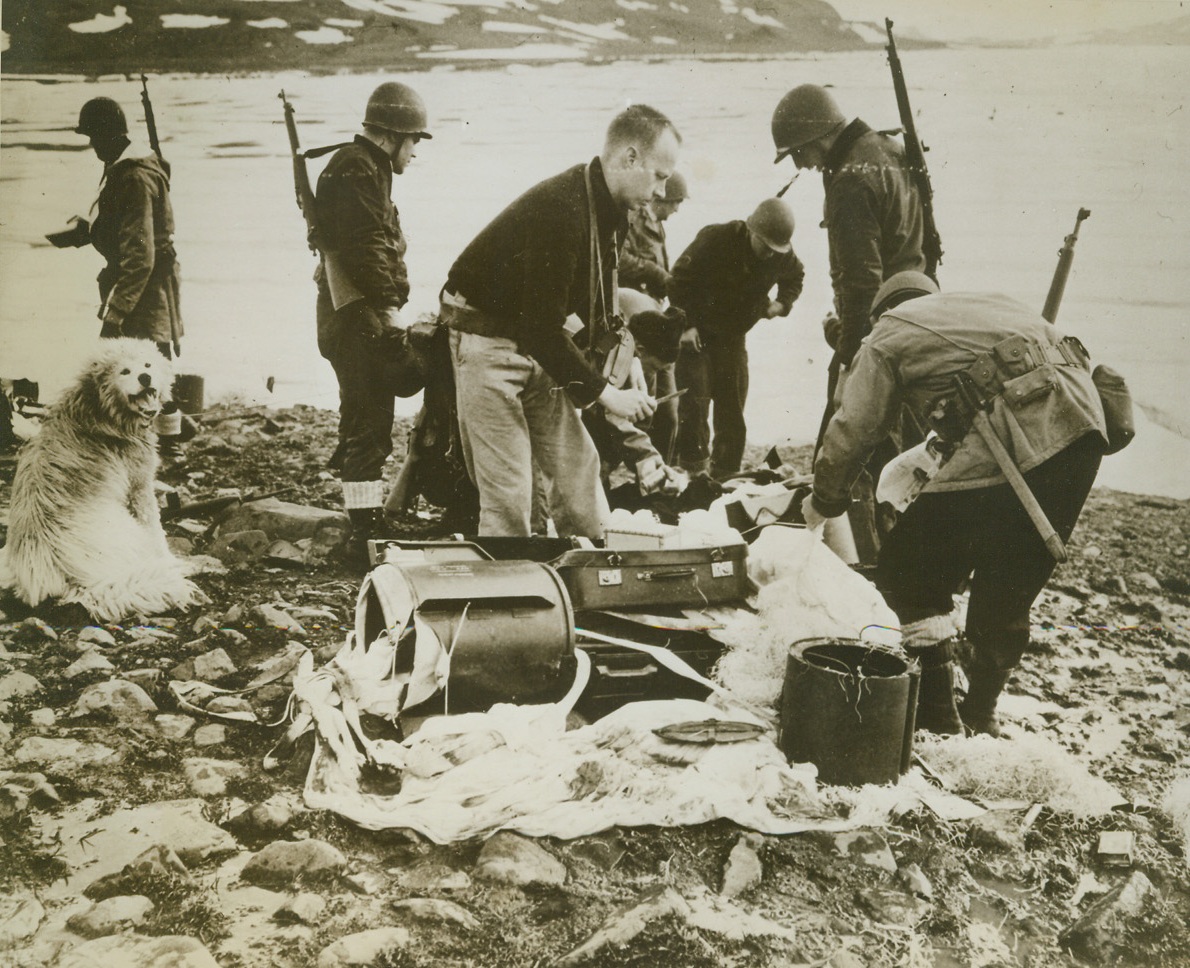
German Weather Base Destroyed, 11/9/1943. Secretary of the Navy Frank Knox today revealed that a powerful German radio and weather base on an island off Greenland, had been taken and destroyed by U.S. Forces and two prisoners taken. This is the second time in recent months that such a base has been captured in Greenland waters. Here, U.S. Coast Guardsmen and soldiers, members of the combined force that destroyed the base, examine an abandoned Nazi parachute kit found on the site. Food, hand grenades, and other material were left behind by the Nazis, who presumably escaped by plane.Credit: (U.S. Coast Guard Photo from ACME);

ON THE ATLANTIC, 11/16/1943. With heads bowed, …survived the epic battles between the old four-stacker destroyer USS Borie and two Nazi U-boats attend memorial rites for the 27 officers and men lost in the double victory. The services were held aboard the escort carrier USS Card, whose torpedo planes gave the “coup de grace” to the Borie when she was found to be beyond salvage. Here, on the Card’s bridge, during the services are: Chaplain S.W. Bell, (background), reading the service through the ship’s loud speaker system; Capt. Arnold J. Isbell, (center), commanding officer of the Card; and Lt. Comdr. (then Lt.) Charles H. Hutchins, commanding officer of the Borie.Credit Line (U.S. Navy Photo from ACME);

He Fell by the Wayside, 11/18/1943. SOMEWHERE IN ITALY -- Killed while attempting to machine gun pack trains making their way over rocky Italian terrain, a German soldier lies where he fell, just below the path over which the pack trains travel. His helmet and his gun mark his rocky grave. Credit: - WP - (Photo by Bert Brandt, ACME Correspondent for War Picture Pool);
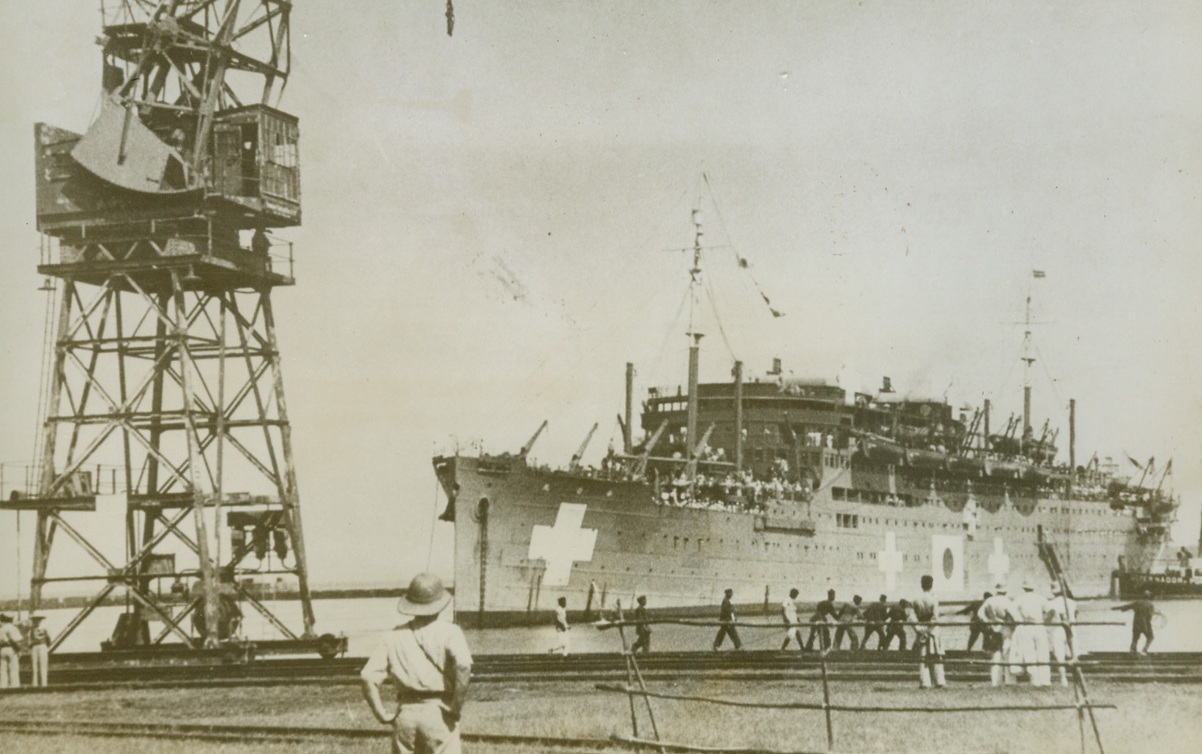
1,500 ALLIES ON THE WAY HOME, 11/1/1943. MORMUGOA, PORTUGUESE INDIA—The Japanese exchange ship, Teta Maru, docks at the port of Mormugoa, Portuguese India, with 1,500 Allied internees, including 1,100 American nationals on board. The former prisoners line the rails for a glimpse of the land which represents the beginning of freedom. Credit: Acme;

NEAPOLITAN PRODUCE MARKET SCENE, 11/2/1943. Shortly after Allied forces entered Naples, AMG encouraged natives to bring all kinds of vegetables and fruits from nearby villages. All available transportation, from hand-pushed carts to old, broken-down trucks hauled produce and helped relieve immediate food shortage, while bread was still not available. A maximum price was established on everything to avoid black market. Carts traveled most populated streets and were sold out immediately, necessitating two or three trips a day. Credit: Acme;

VICTIMS OF NAZI “SPORT”, 11/4/1943. NAPLES, ITALY—These two Italian lads, Guido Brandi, 13, and his brother Thomaso, 16, (left), were working in a field near the city during the German occupation of Naples. Two German soldiers appeared in the window of a nearby window and beckoned to the boys, who drew near hoping for a bit of food, or a present. They got the present, all right—a grenade was tossed at them by one of the Nazis. The lads tries to catch it. One lost both legs, the other one leg. They are shown, here, recovering in a Naples hospital. Credit: Acme;
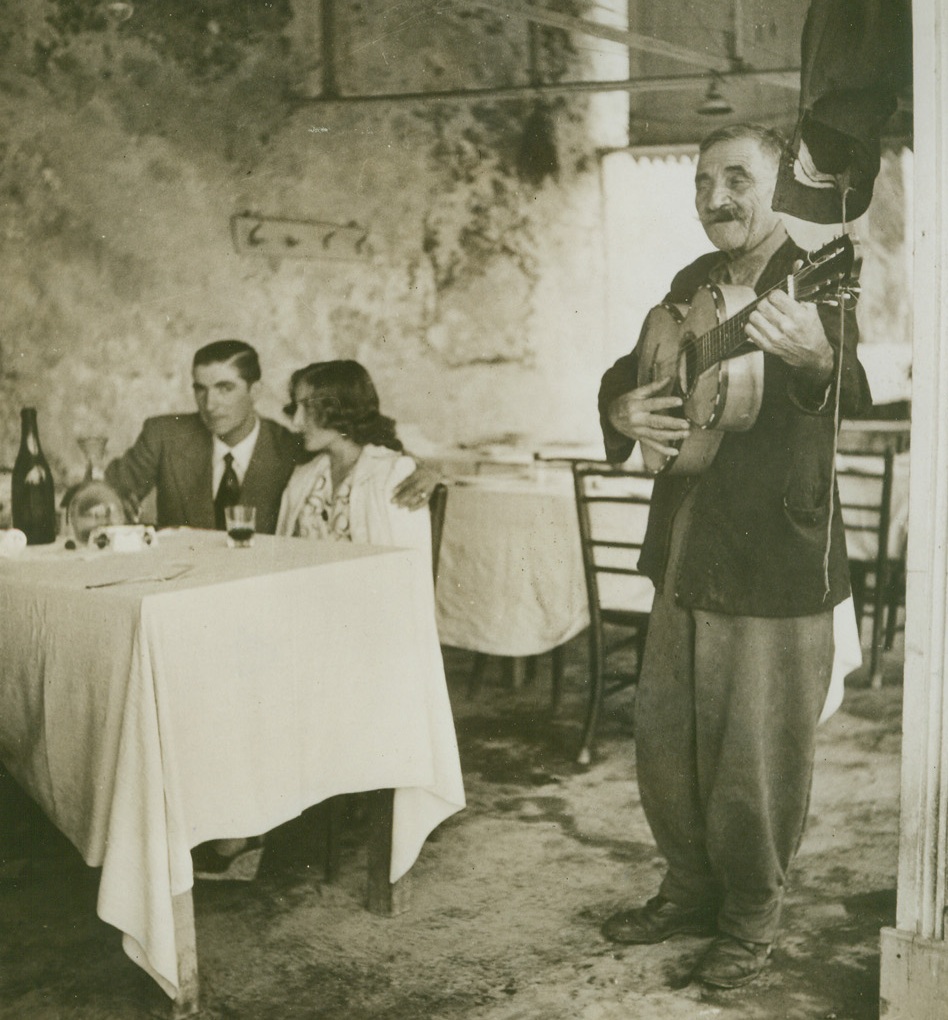
TROUBADOR REVIVES SPIRIT OF NAPLES, 11/2/1943. Recently released photo shows the resurgent spirit of Neapolitans, who, despite shortage of restaurants there, maintain the old romantic spirit. Shown here is an old ballad singer, a reminder of the former gay old tourism times, entertaining sweethearts as they wait for their meal of black spaghetti; a little fish and good, coarse red wine. Credit: Acme;
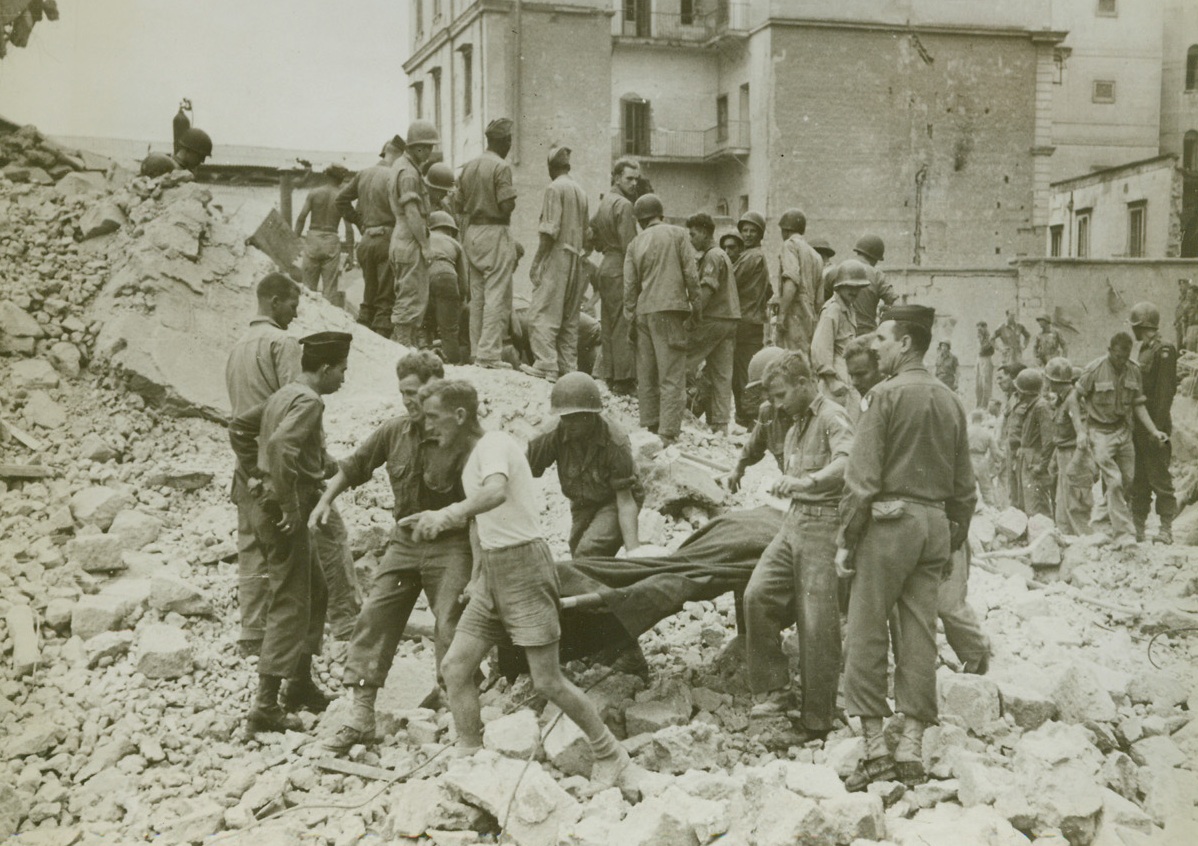
PHOTOS ON SECOND NAPLES BLAST, 11/2/1943. This photo, just released in the United States, was taken three days after a German time bomb demolished a corner of the post office in Naples, when another Nazi-planted land mine exploded under a wing of an artillery barracks in Naples, where hundreds of American paratroopers were quartered. Some 1,000 pounds of dynamite cached deep underground blew up killing more than 40 soldiers. Here, amid the ruins, soldiers and civilians work feverishly to rescue any living buried beneath the collapsed three floors of the barracks. Credit: Acme;
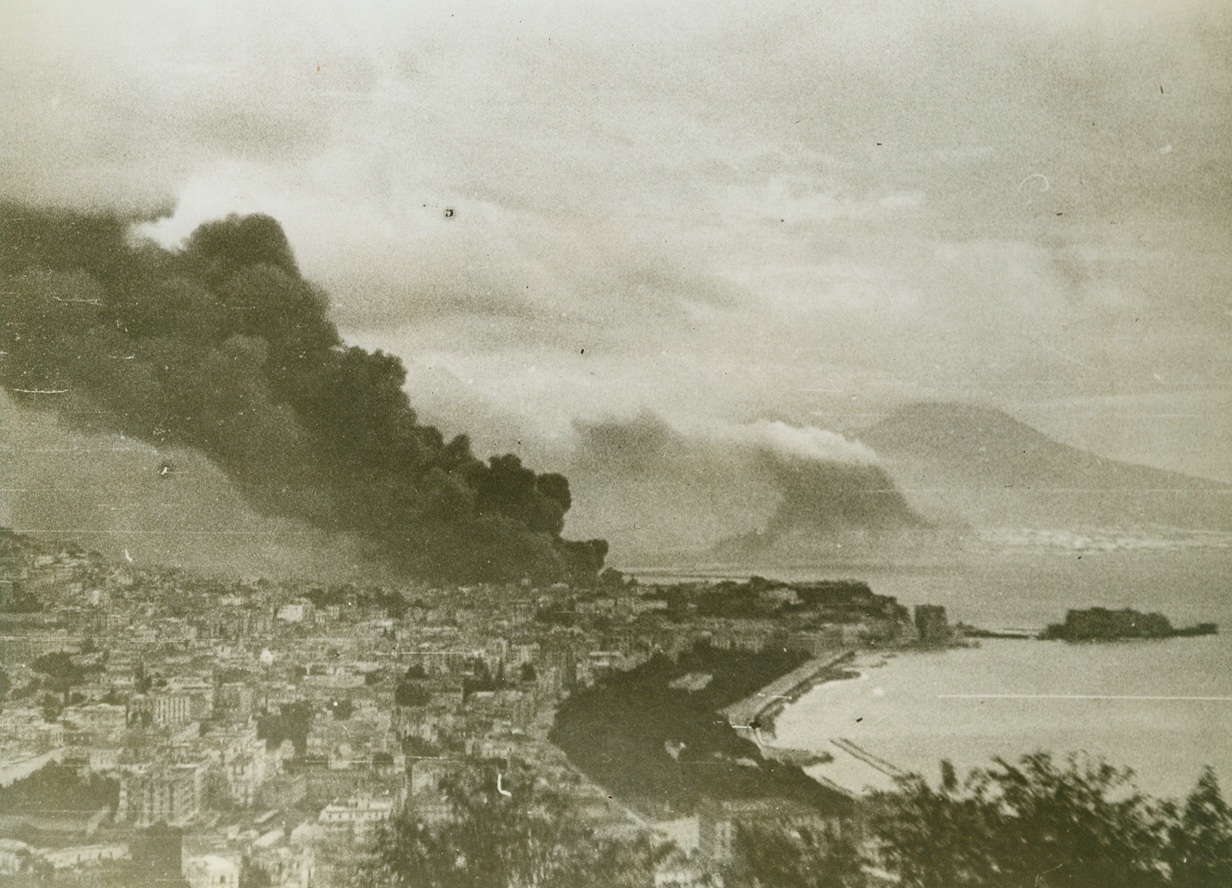
NAPLES FIGHTS NAZI TERRORISM, 11/2/1943. This series of photos, just released in the United States, tells the graphic story of the German rape and pillage of Naples, how they killed Neapolitans just because they were Italians, and how Nazi demolition squads razed buildings and beautiful landmarks of no military value—but to create another blackened and twisted monument to German terrorism and vengeance. But Naples fought back and many young Italians—some only 14 years old—brought out firearms that they had kept hidden and, for three days before the Allies captured the city, kept up guerilla battles against the Germans. These young lads, who were members of an anti-Fascist organization led by one Antonio Tarsia, killed as many as 30 Germans each day by ambushing them and sniping from rooftops. The fighting, however, was one-sided in the face of the superior numbers of the Germans. About 2,000 citizens of Naples were shot down in the streets or in their homes just because they happened to be Italians. NEW YORK BUREAU Smoke begins to cover Naples as the Nazis worked with terrible fervor to destroy buildings and installations in the face of the advancing Allied 5th Army. Credit: Acm;
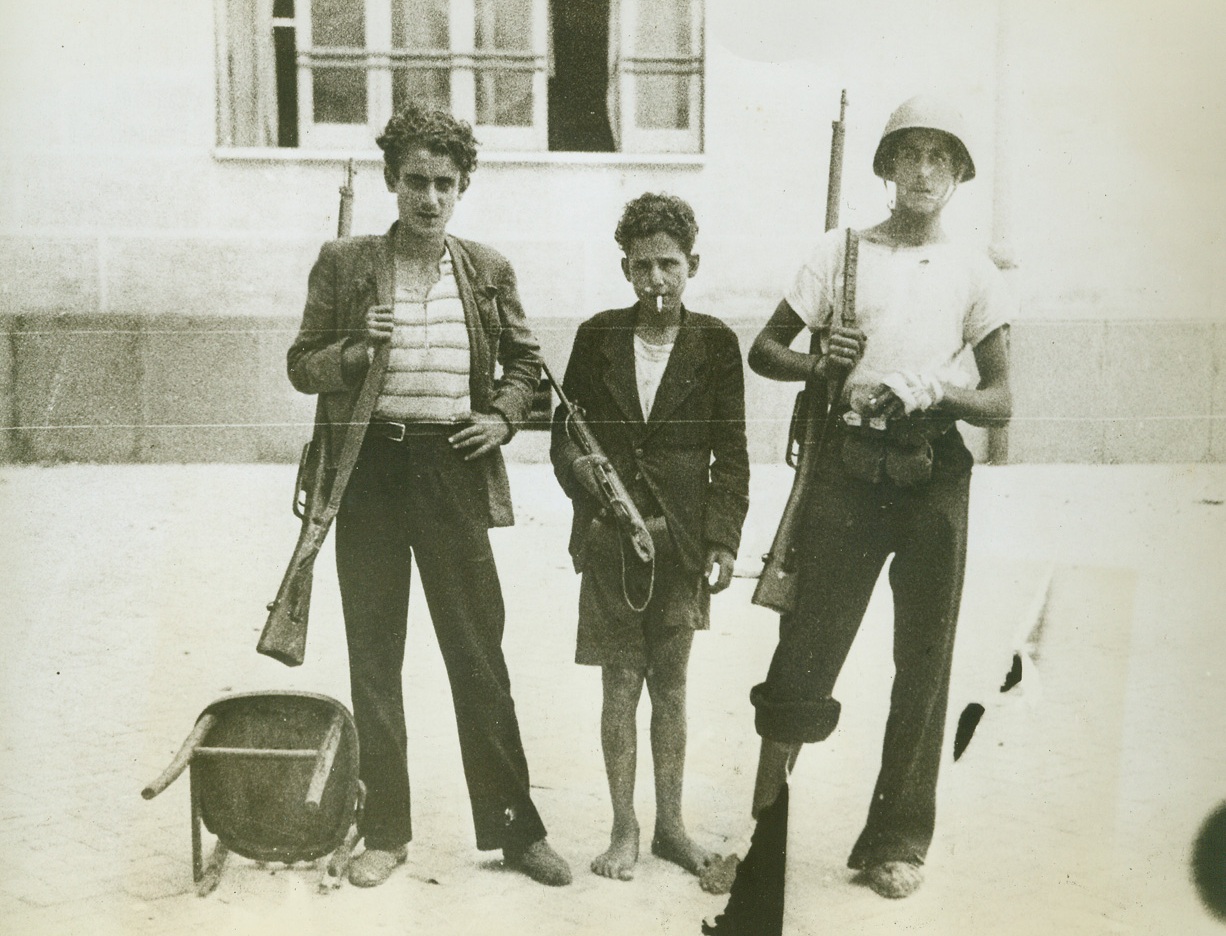
NAPLES FIGHTS NAZI TERRORISM, 11/2/1943. This series of photos, just released in the United States, tells the graphic story of the German rape and pillage of Naples, how they killed Neapolitans just because they were Italians, and how Nazi demolition squads razed buildings and beautiful landmarks of no military value—but to create another blackened and twisted monument to German terrorism and vengeance. But Naples fought back and many young Italians—some only 14 years old—brought out firearms that they had kept hidden and, for three days before the Allies captured the city, kept up guerilla battles against the Germans. These young lads, who were members of an anti-Fascist organization led by one Antonio Tarsia, killed as many as 30 Germans each day by ambushing them and sniping from rooftops. The fighting, however, was one-sided in the face of the superior numbers of the Germans. About 2,000 citizens of Naples were shot down in the streets or in their homes just because they happened to be Italians. NEW YORK BUREAU Three youthful snipers, who carry their weapons in an easy and experienced manner, are ready to set out on a Nazi-slaying hunt. The lad at right, wear a combat helmet and has a bandaged left hand. Credit: Acm;
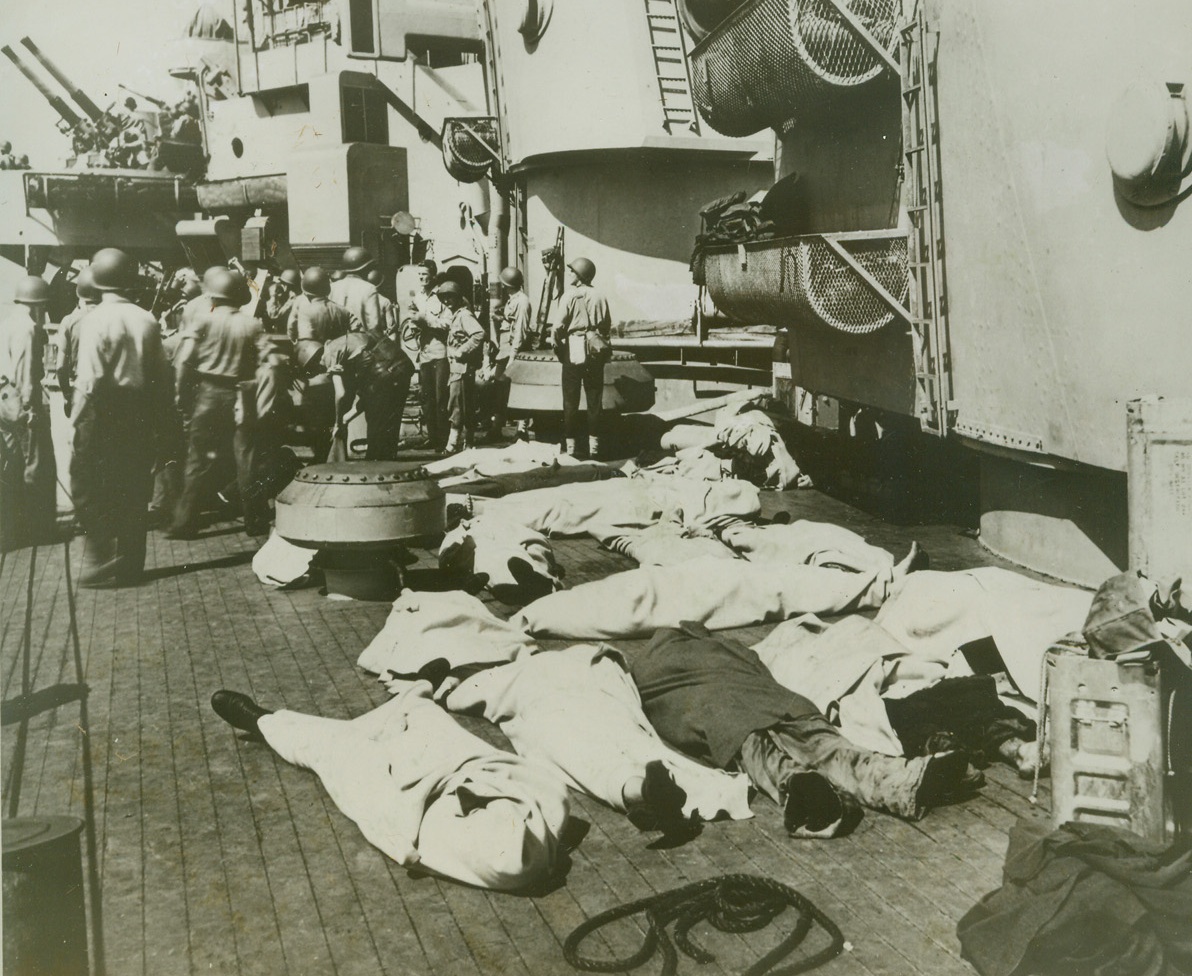
KILLED ON SAVANNAH, 11/2/1943. SALERNO, ITALY—Clean blankets cover the bodies of crew members who died when a Nazi bomb blasted a gun turret on the Savannah during the invasion at Salerno, September 11. Other American fighters continue to carry out the covering of the landings of American forces, as the fire resulting from the explosion is brought under control within 20 minutes. Credit: Official U.S. Navy photo from Acme;
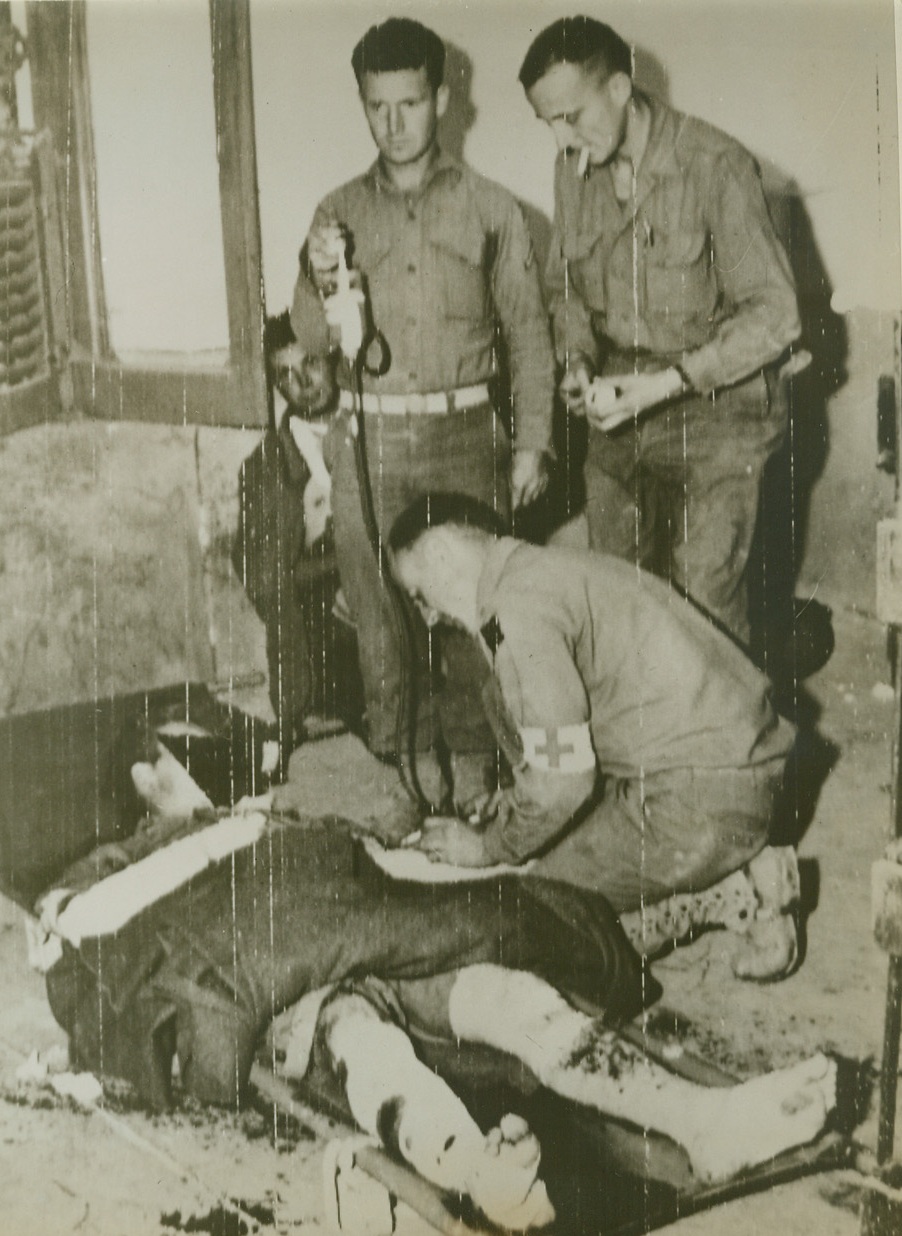
PLASMA FOR AMERICAN SOLDIER, 11/3/1943. A blood plasma injection is given to an American infantryman by medical Captain Hal Ferguson at a front line station hospital in Italy, in this photo flashed to the U.S. by radiotelephoto. Assisting the doctor are, (left to right): Pfc. Everett Rainey, of Mountain Grove, Mo.; and Sgt. Marion Freed of Belleville, Kansas. Credit: U.S. Army radiotelephoto from Acme;
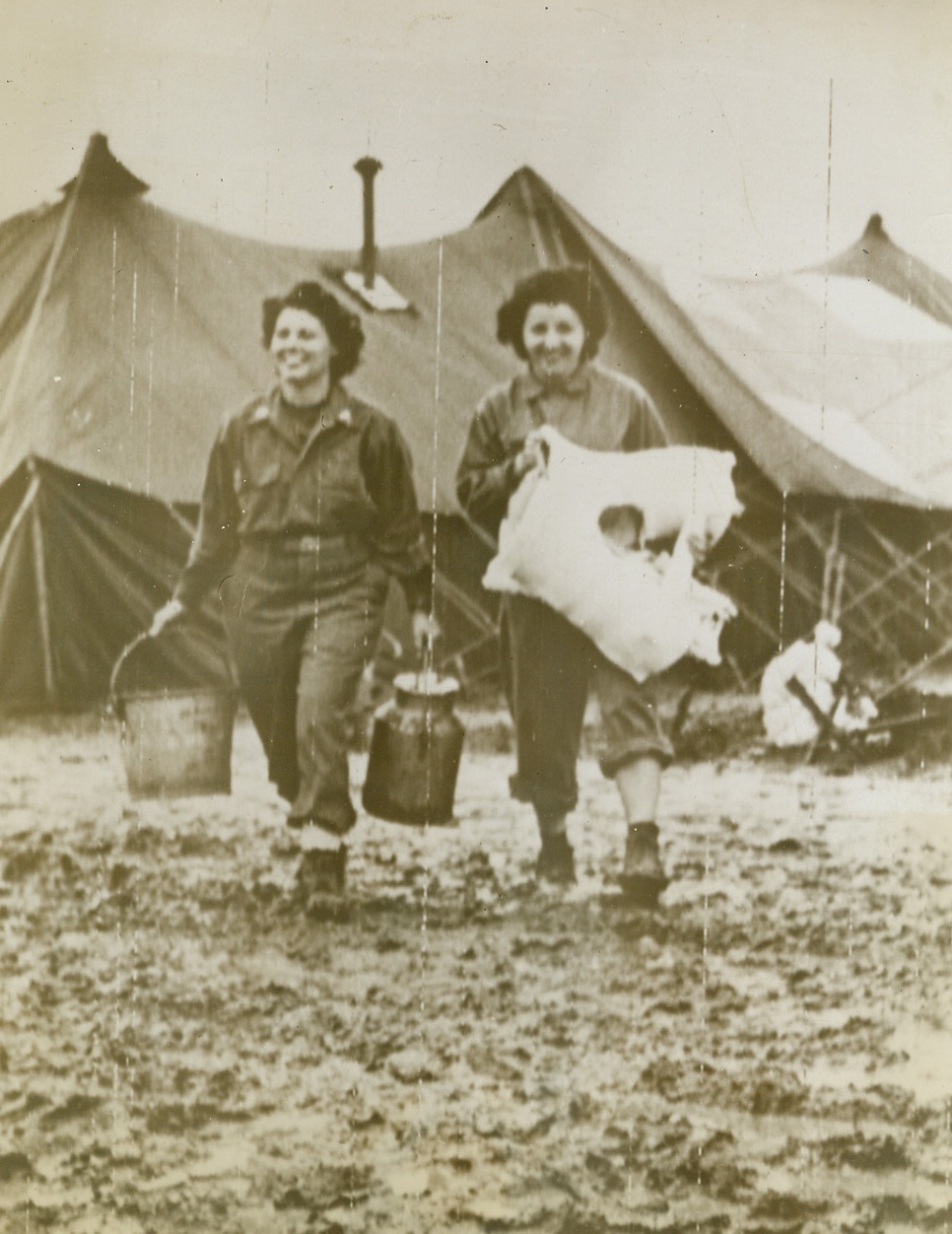
ONCE CALLED “WOMEN IN WHITE”, 11/22/1943. ITALY—A pair of Army nurses slog cheerfully through a sea of mud in Italy, where continuous rains have bogged down both Allied and Nazi ground attack. They are (left to right) Lt. Sylvia Hamper, Joliet, Ill., who carries pails used for mixing plaster, and Lt. Anna Lange, of Ashley, Ill., who holds a section of a prefabricated plaster cast. Credit: Acme photo by Bert Brandt, for the War Picture Pool via Army radiotelephoto;

RUB-A-DUB-DUB, 11/22/1943. ITALY—British Eighth Army men heeded the advice of the old nursery rhyme about men in a tub when they found that heavy rains on the Termoli front made field living conditions even more difficult. Ever ingenious, the Tommies converted gigantic wine barrels into more or less comfortable billet by raising them atop stones. Credit: Acme;
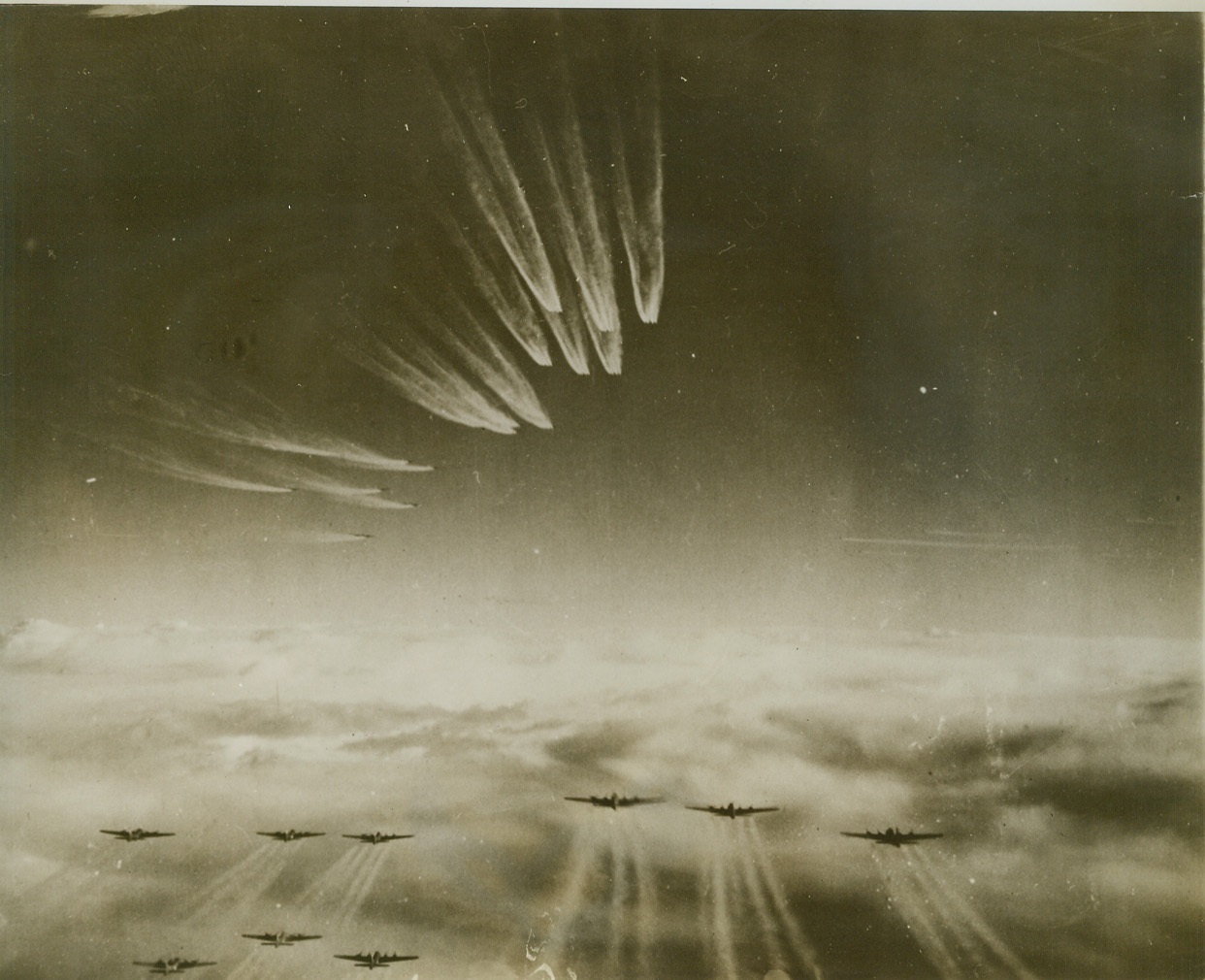
Sky Trail Markers, 11/30/1943. Ghostly vapor trails from their motors, mark the flight of these heavyweights of the U.S. Army 8th Air Force as they head for another of the "Level Germany" air attacks with which the Allies hope to bring the Nazis to their knees. This raid, which took place last Nov. 13, was directed against the submarine yards and docks at Bremen. In lower part of the photo, are Flying Fortresses, while other Forts and Liberators are in the formation above them, (top, center in photo). Credit: (U.S. Army Air Forces Photo from ACME);
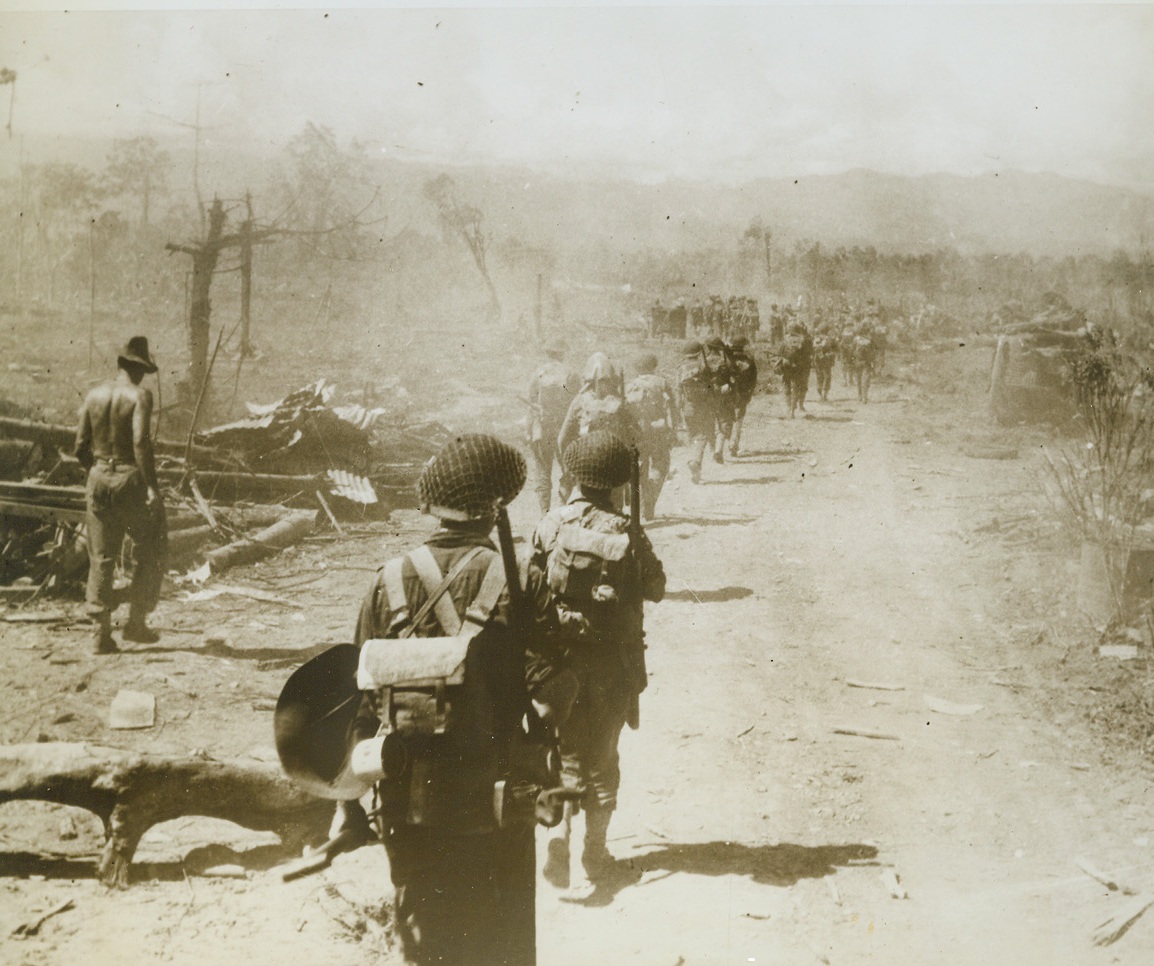
ANOTHER MILESTONE ON THE ROAD TO TOKYO, 11/3/1943. Devastation marks the road on either side of Allied troops as they marched into Lae, on Sept. 18th, 1943, shortly after the New Guinea outpost of the Nipponese was captured. “Hell on Earth” is the description of the attack on the Japs, before they gave up. Credit: Official U.S. Navy photo from Acme;
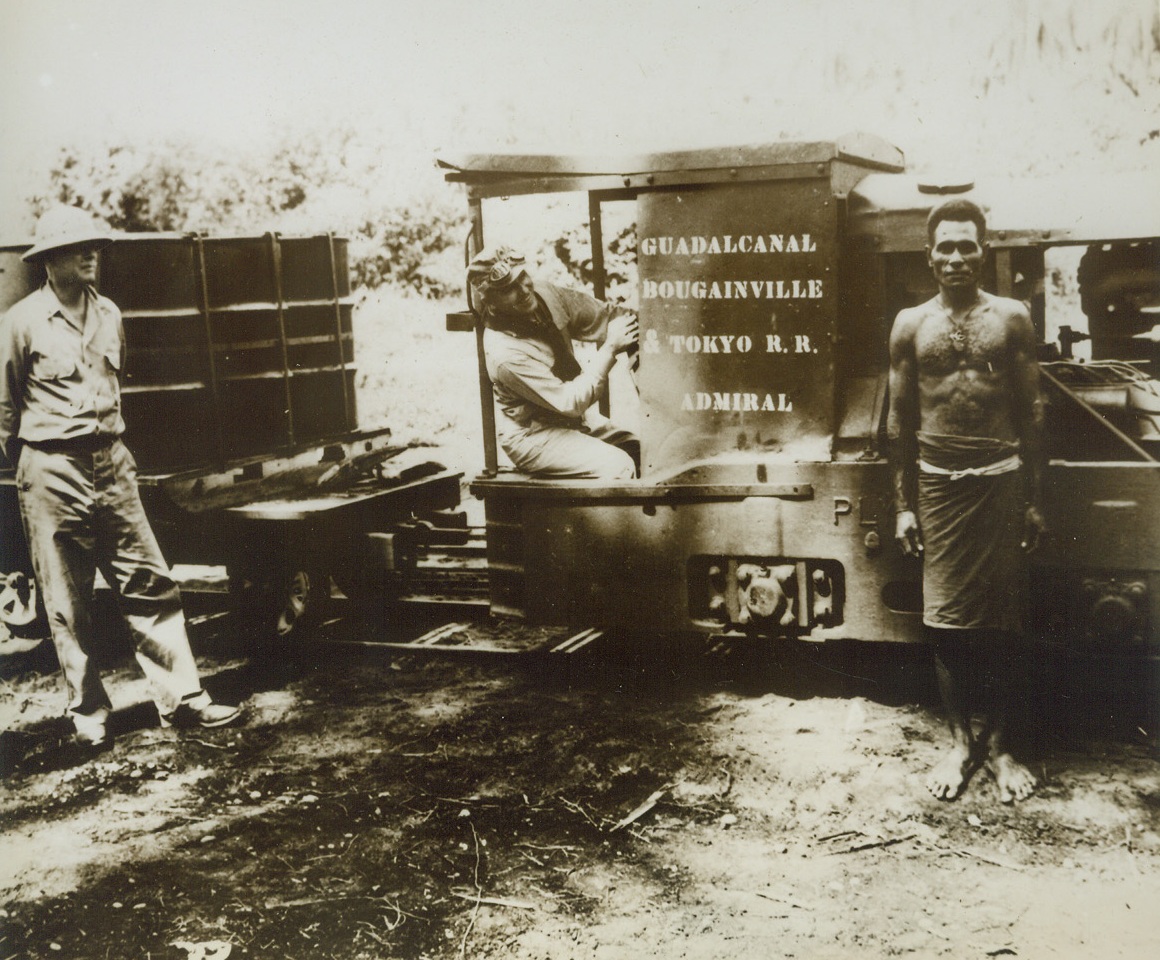
MODERN “OLD 97”, 11/3/1943. SOUTH PACIFIC—Although it has only one engine, the G.B.&T. railroad does just about as much work for its size as some of its larger brothers. The Guadalcanal, Bougainville & Tokyo R.R. is a narrow gauge line at an Allied South Pacific base which hauls supplies from the harbor to a supply base. Here, (photo above) the engineer of the “Admiral”, the line’s lone locomotive, “opens her up” for a long pull—not to Tokyo yet, but it won’t be long! Credit: U.S. Navy photo from Acme;
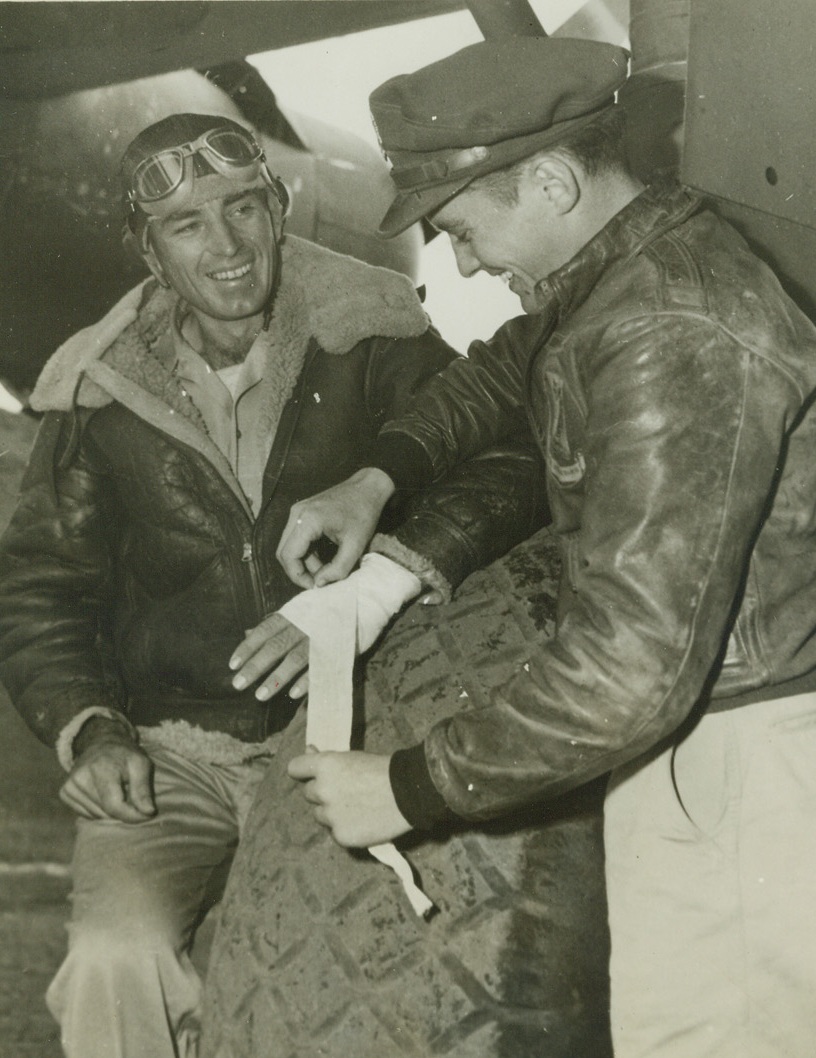
TOP BOMBER GUNNER GETS 7 JAPS IN ONE SCRAP, 11/1/1943. CHINA—T/Sgt. Arthur Benko, Bisbee Arizona, has cause to grin, even though he has a slight hand wound being bandaged by Capt. James Maher, adjutant of the heavy bomber group in China. Benko, member of the group, shot down seven Jap Zeros in one fight, bringing his score to 16 confirmed Zeros downed. This makes him leading bomber gunner of the China, India, Burma Theatre—and perhaps in the world. Credit: Acme;
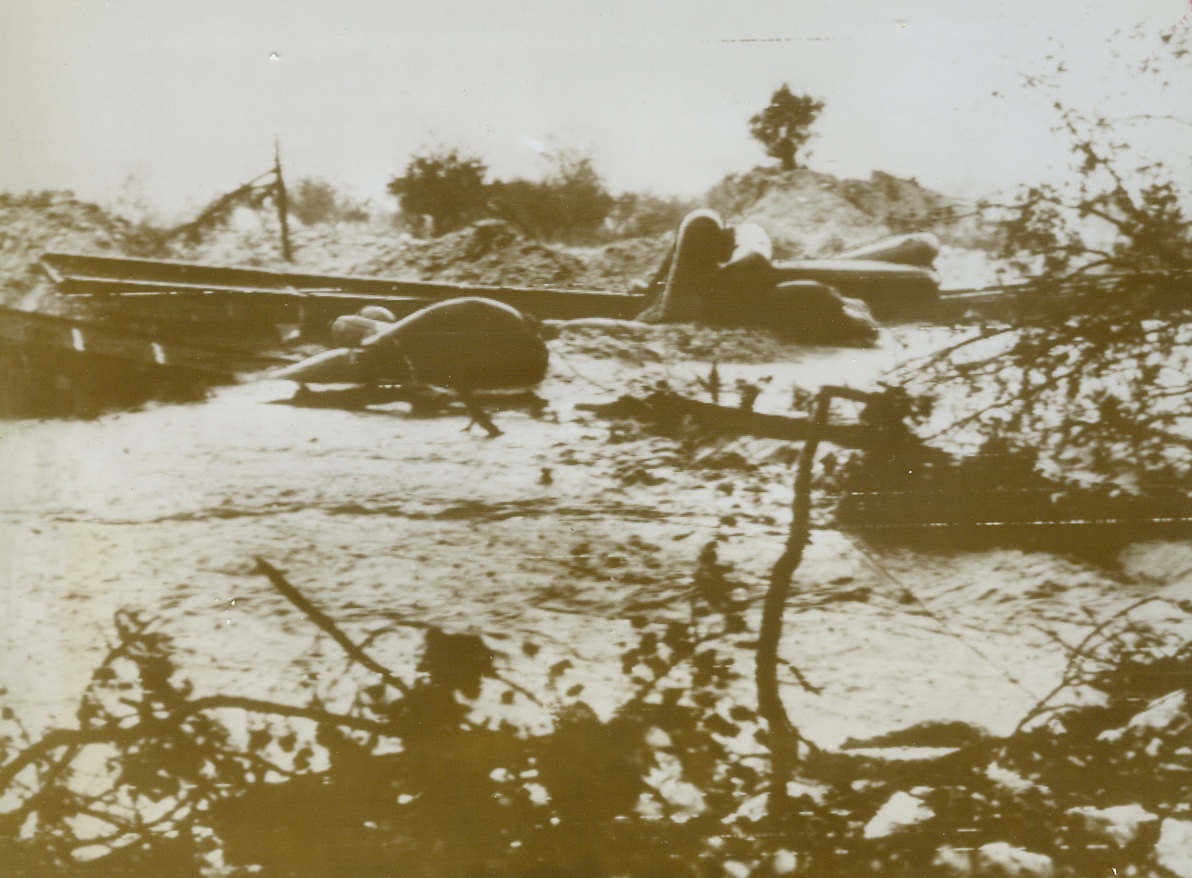
FLOODWATERS WRECK PONTOON BRIDGE, 11/21/1943. ITALY—Heavy winds and rain played havoc with this pontoon bridge over the Volturno River just north of Venafri, Italy. The pontoons washed out by flood waters, can be seen floating at random in the river. In spite of quagmires, Gen. Clark’s Fifth Army has advanced five miles on the road to Rome in the direction of Alfedena, an Allied Headquarters dispatch said today. Credit (Signal Corps Radiotelephoto from ACME);
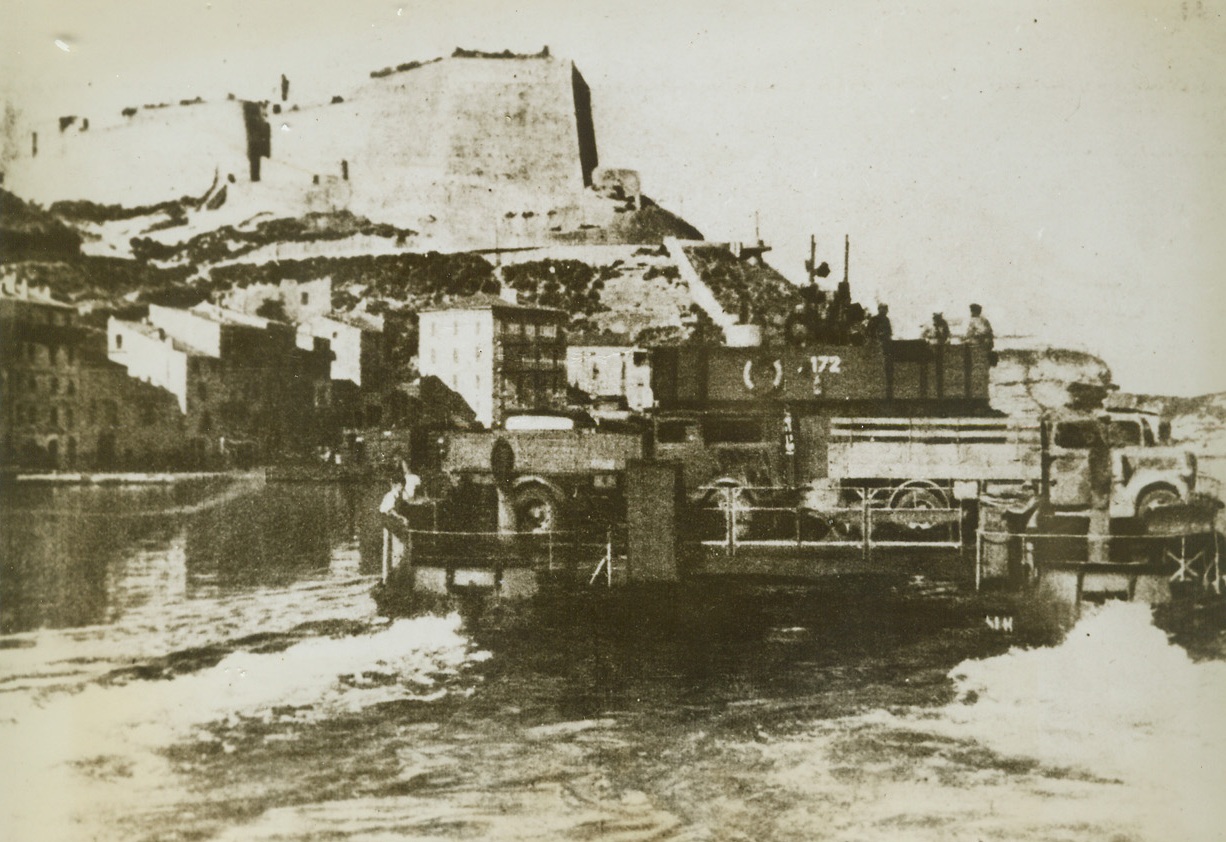
EVACUATING CORSICA, 11/21/1943. CORSICA—Ferry evacuating the island of Corsica and bound for mainland of Italy is crammed with trucks and men, according caption accompanying this German photo taken from the Munich Illustrierte Presse and received through a neutral source. Credit Line (ACME);
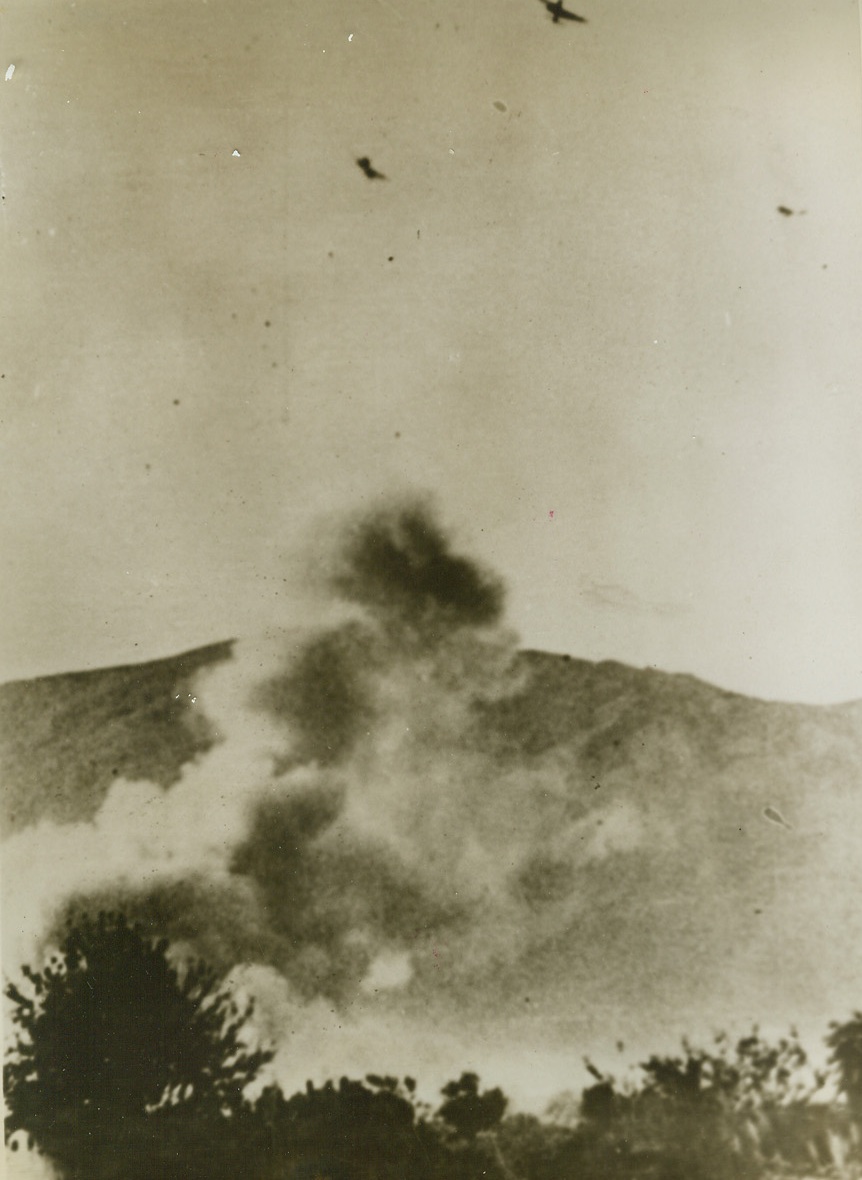
ACTION AT COS, 11/22/1943. Received in New York from Lisbon today, this picture, according to the caption accompanying it, purports to show German bombers of the JU-87 type in action over the Island of Cos, one of the Dodecanese group. This was shortly before the occupation of the island by German troops in a fierce assault. Smoke rises from a hit as the bombers peel around to continue their attack. Credit (ACME);
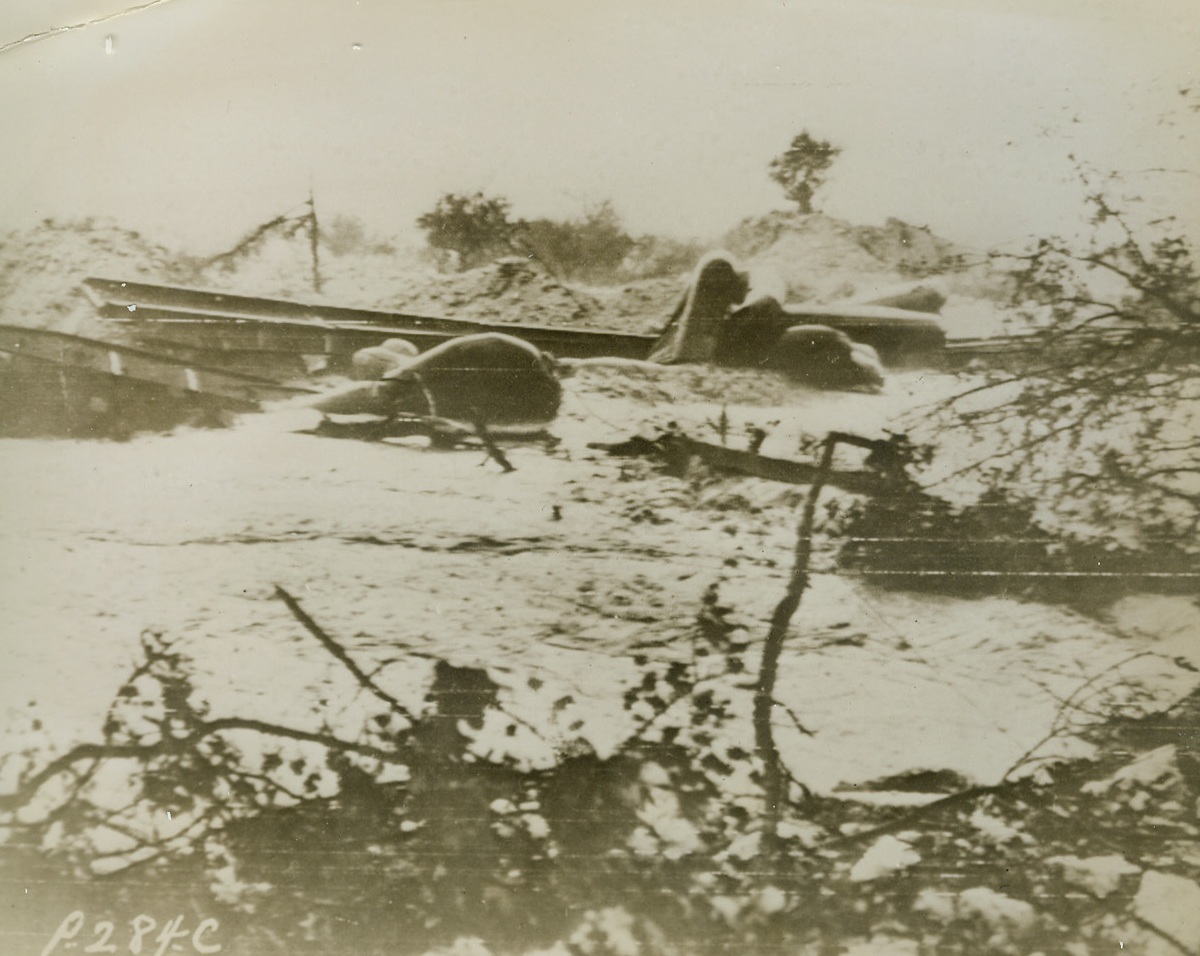
PONTOON BRIDGE WRECKED BY FLOODWATERS, 11/20/1943. ITALY—One of the reasons why the American advance in Italy has been slowed up is evidenced by the scene here showing how Volturno River floodwaters, brought about by heavy winds and rain, played havoc with a pontoon bridge thrown across the river just north of Venafri. Washed out by the flood waters, pontoons bounced about in the swirling stream. Credit Line (US Army Signal Corps Radiotelephoto from ACME);
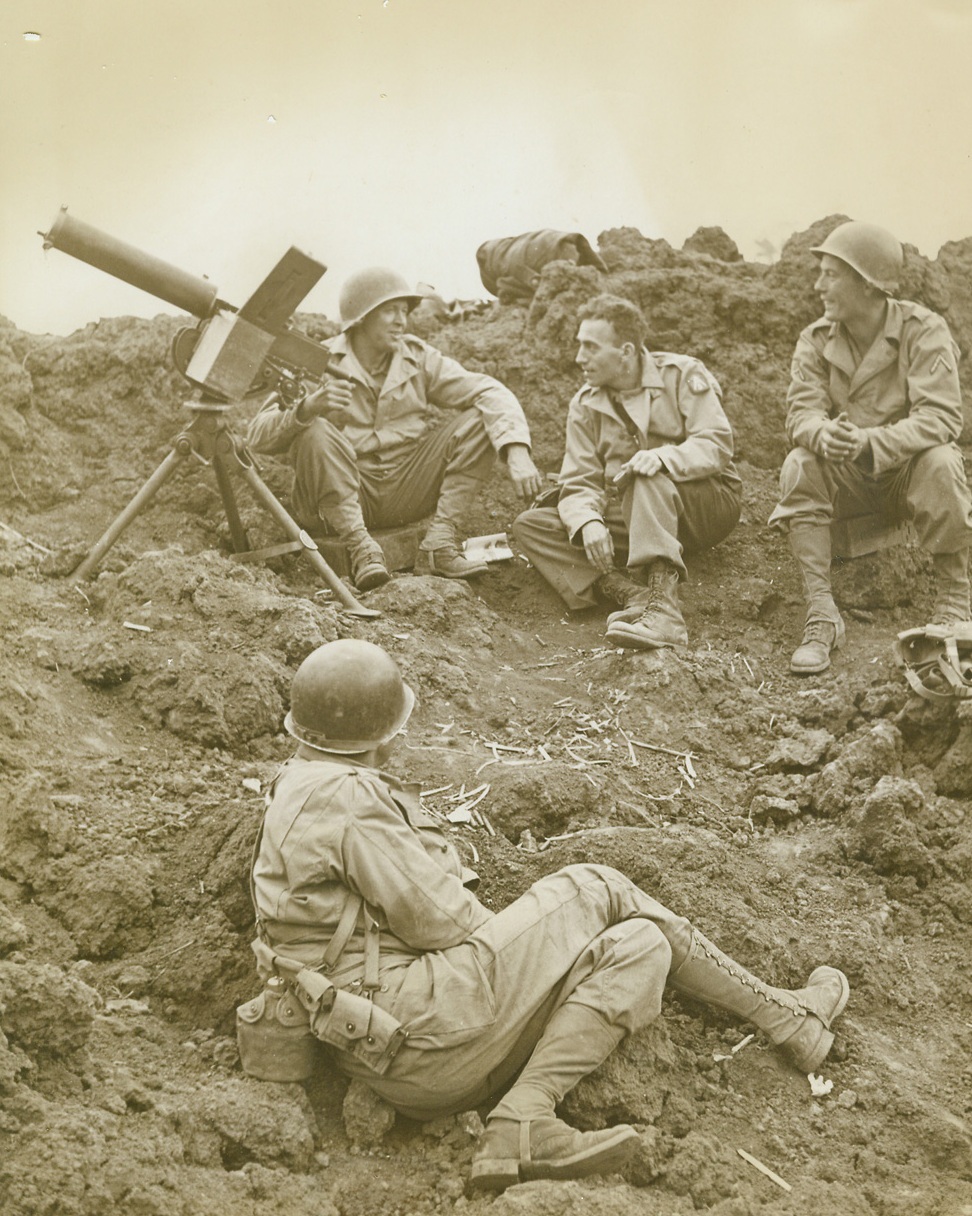
FRONTLINE INTERVIEW, 11/23/1943. WITH THE 5TH ARMY in ITALY—Cy Korman, (center, background), Chicago Tribune war correspondent, interviews members of a frontline machine gun post, located in a ten-foot-deep shell crater along the Italian Front. In foreground, is Pvt. Dallas Jones, of Jacksboro, Texas. With Korman are, Pvt. Frederick Stewart, of Hictonville, Ind. (left); and Pfc. Raymond Kubilek, of Vernon, Texas, (right). Credit Line (ACME Photo by Bert Brandt for the War Picture Pool;

BLITZ BOTTLENECK, 11/23/1943. WITH THE 5TH ARMY IN ITALY—This quagmire along the front in Italy, passes for a temporary road for vehicles bypassing a bridge blasted by the Germans in their retreat to Cassino. In the background, an American Jeep and truck seem to be hopelessly mired in the sticky, mud. Credit Line (ACME Photo by Bert Brandt for the War Picture Pool);
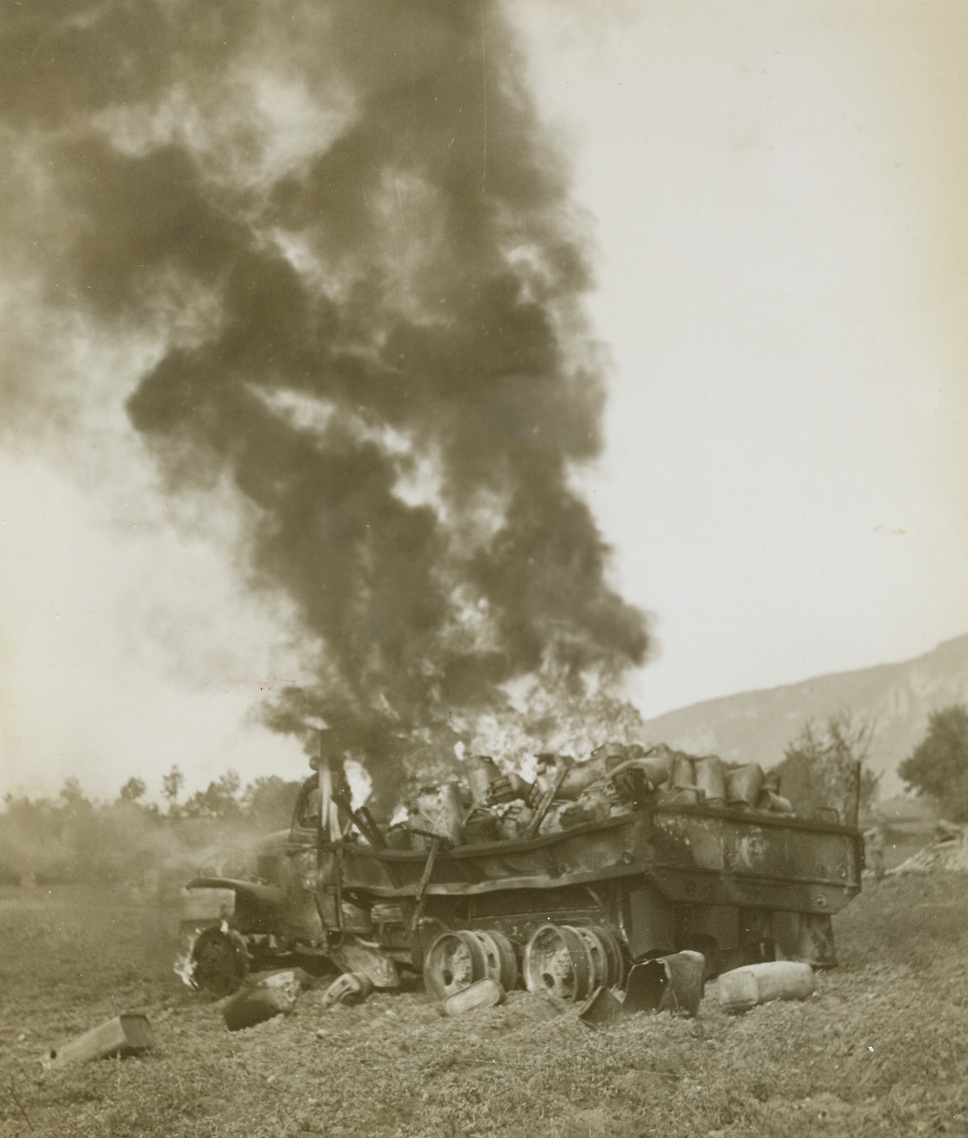
ALLIED GAS TRUCK HIT BY NAZIS, 11/23/1943. WITH THE 5TH ARMY IN ITALY—An Allied truck loaded with cans of gasoline burns fiercely after being strafed by German planes “somewhere on the Italian Front.” Enemy air attacks in this sector were extremely heavy when this photo was taken. Credit Line (ACME Photo by Bert Brandt for the War Picture Pool);

THE WAR PASSED, HERE, 11/23/1943. WITH THE 5TH ARMY IN ITALY—All the grass was seared from this hillside, and only gaunt, shattered stubs remain of the trees that once shaded the spot, after bitter warfare had passed over and beyond this sector of the Italian Front. A soldier gathers firewood among the shattered stumps. Credit Line (ACME Photo by Bert Brandt for the War Picture Pool);
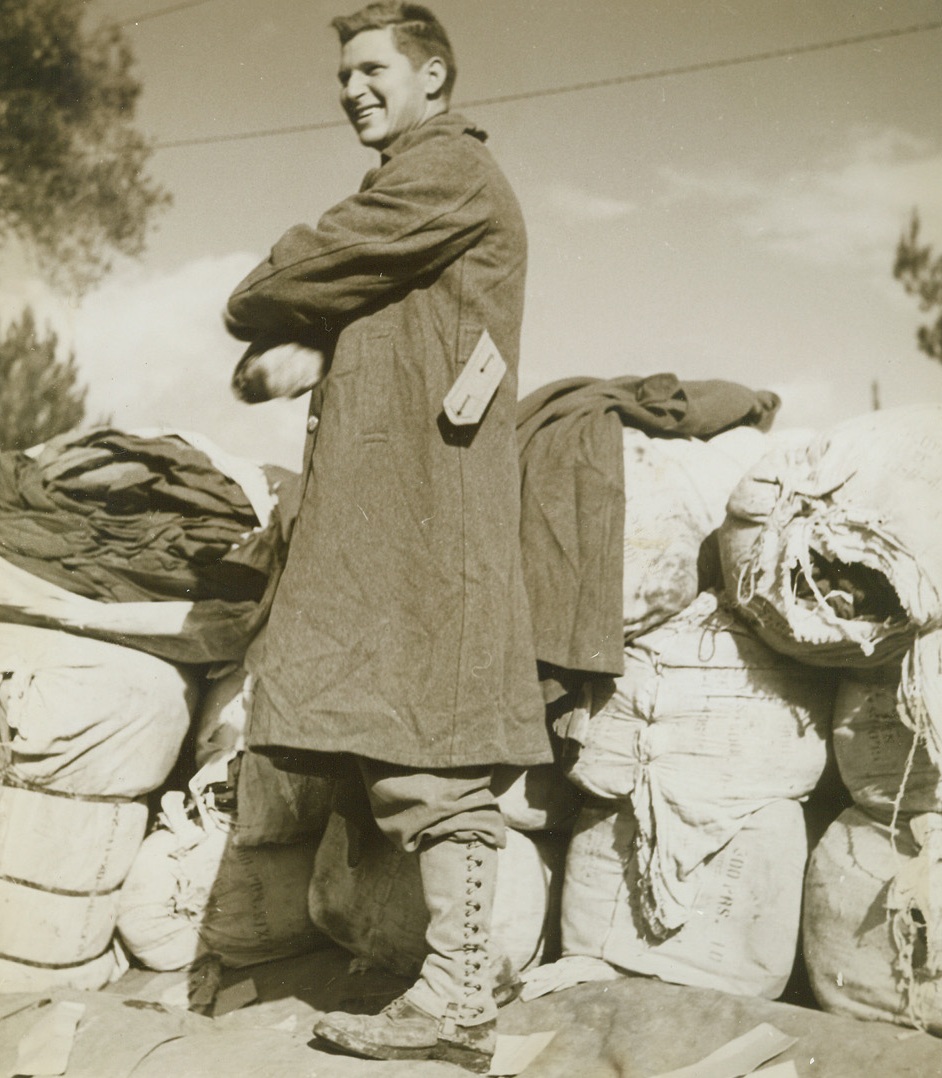
G.I. FASHION PLATE, 11/23/1943. WITH THE 5TH ARMY IN ITALY—Pfc. Thomas Patrick, of Hilton, Okla., tries on a warm G.I. winter overcoat, which will become an indispensable part of his equipment during the cold Italian winter ahead. Behind him (in photo) are bales of coats, warm gloves, winter underwear, etc., being passed out to Americans on the 5th Army front in Italy. Credit Line (ACME Photo by Bert Brandt for the War Picture Pool);
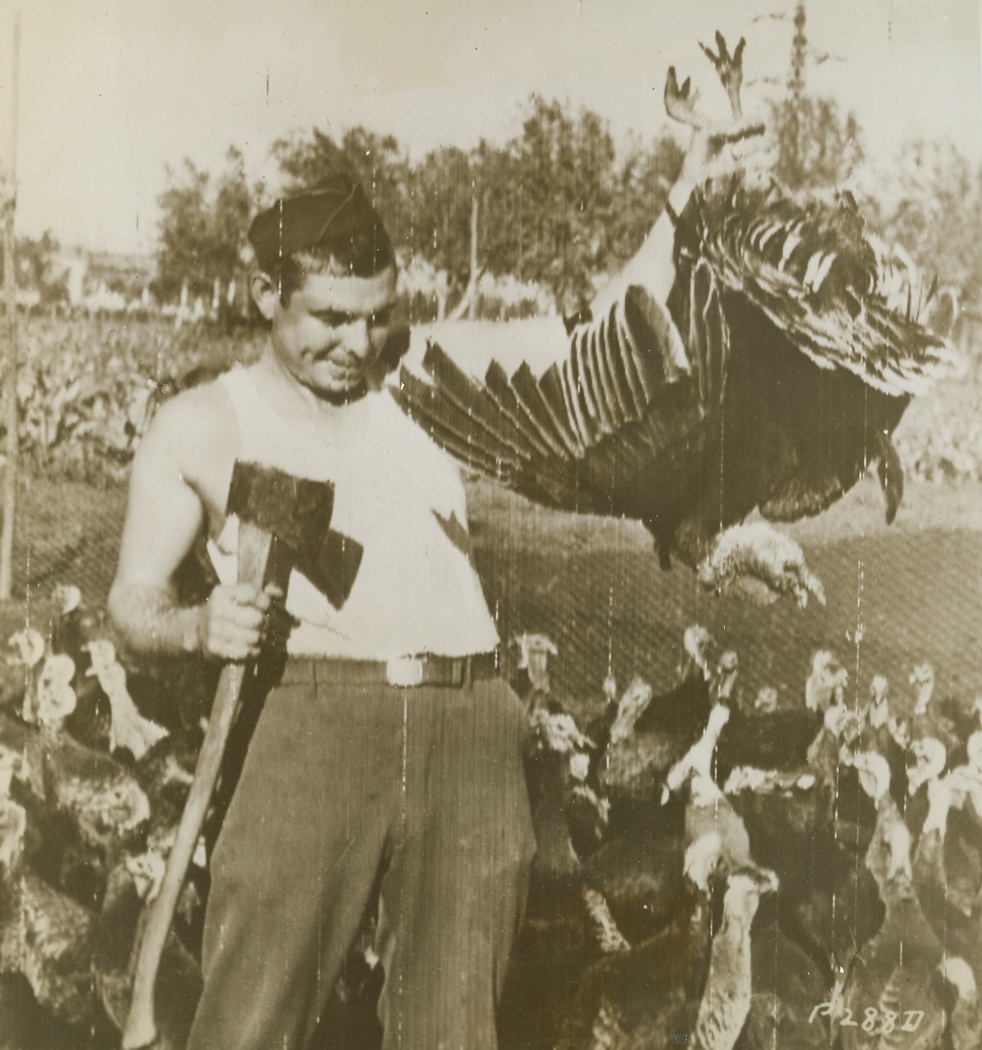
“WATTLE I DO?”, 11/23/1943. ITALY—Master Sgt. Harold F. Koehn, of Cedar Rapids, Iowa, has the axe ready to give the blow fatale to the turkey held high in his left hand….Post mortem decision of an Air Force group, which had bought the bird near Naples, will be that a cheerful Thanksgiving dinner was had by all. Credit Line (ACME Photo by Charles Seawood for the War Picture Pool via Army Radiotelephoto);
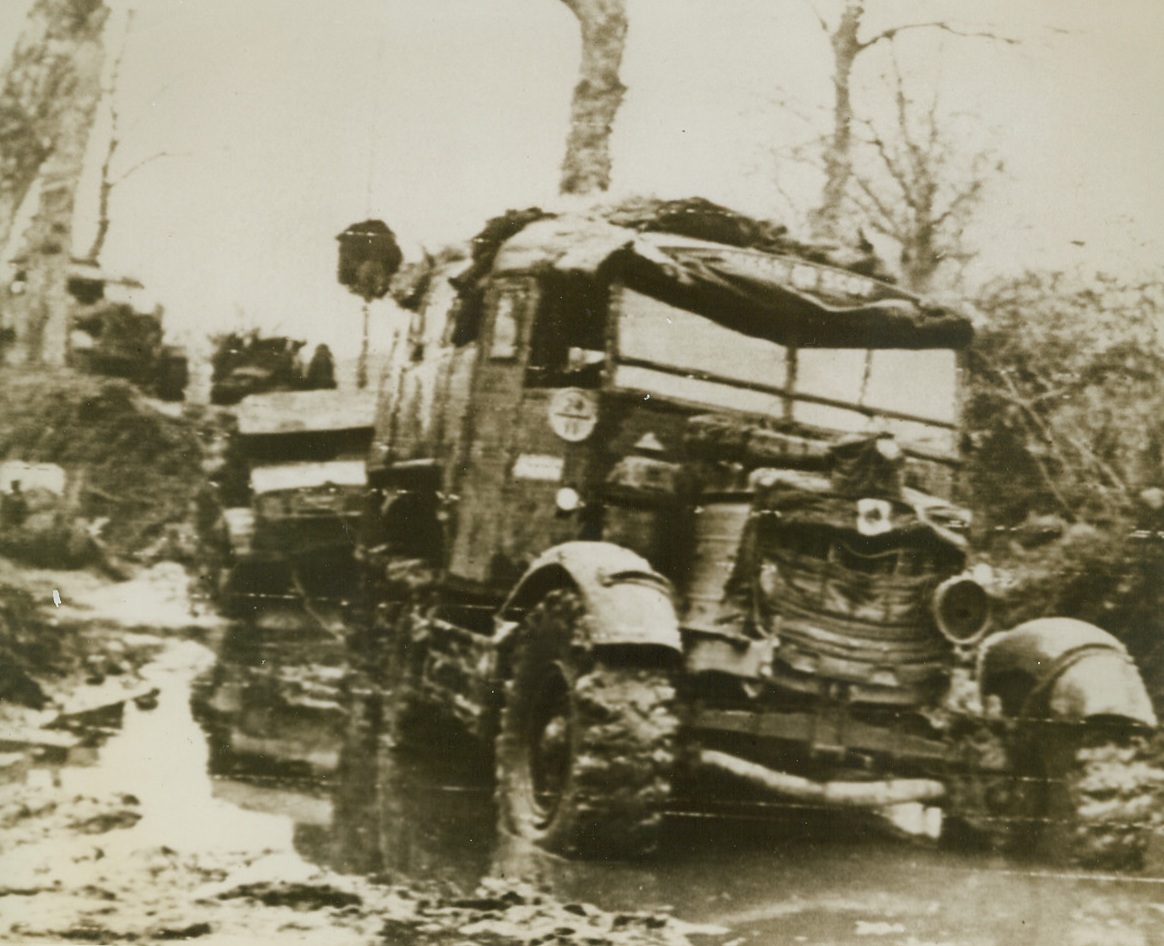
MUD SLOWS UP ADVANCE IN ITALY, 11/23/1943. ITALY—A big British vehicle tows a lighter car through deep mud holes in a sector on the Italian front. Steady rain has slowed up military operations. Credit (ACME Photo by Bert Brandt for the War Picture Pool via Army Radiotelephoto);
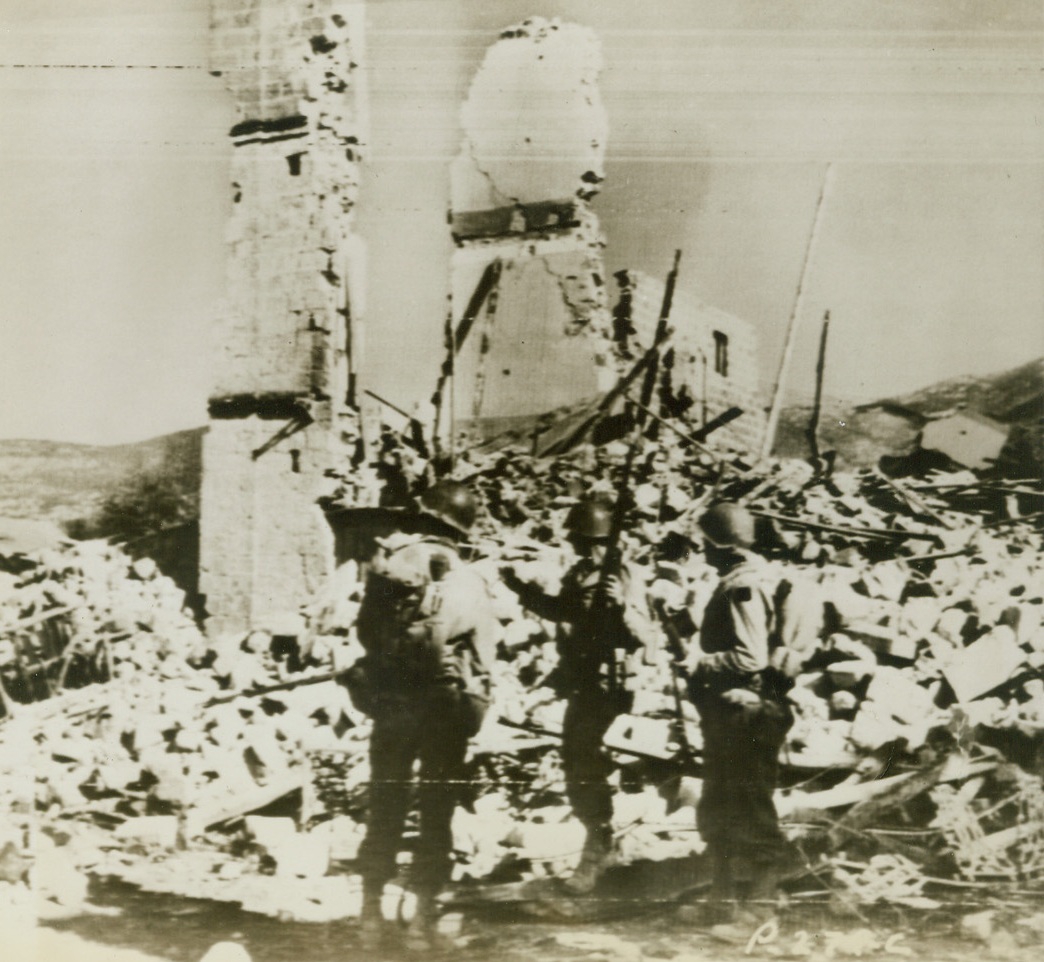
AMERICANS ON PATROL IN ITALY, 11/16/1943. MIGNANO, ITALY—Three United States soldiers patrol the outskirts of Mignano, leveled by American and German artillery fire. The populace of the town fled when the withering barrages began, and hid in caves in nearby hills. Credit Line (U.S. Army Radiotelephoto from ACME);

Death Marks the Spot, 11/16/1943. Italy – The bodies of two American soldiers (left background), who had been riding along this road in Italy in a half-track, lie beside the road after a German air attack had blasted the motor vehicle to wreckage and killed them. The bomb crater can be seen at right just behind the battered trailer. Bits of wreckage, mess gear, and helmets litter the ground and a burning bit of wreckage, (left) marks the scene of death. Credit: U.S. Army official photo from ACME;
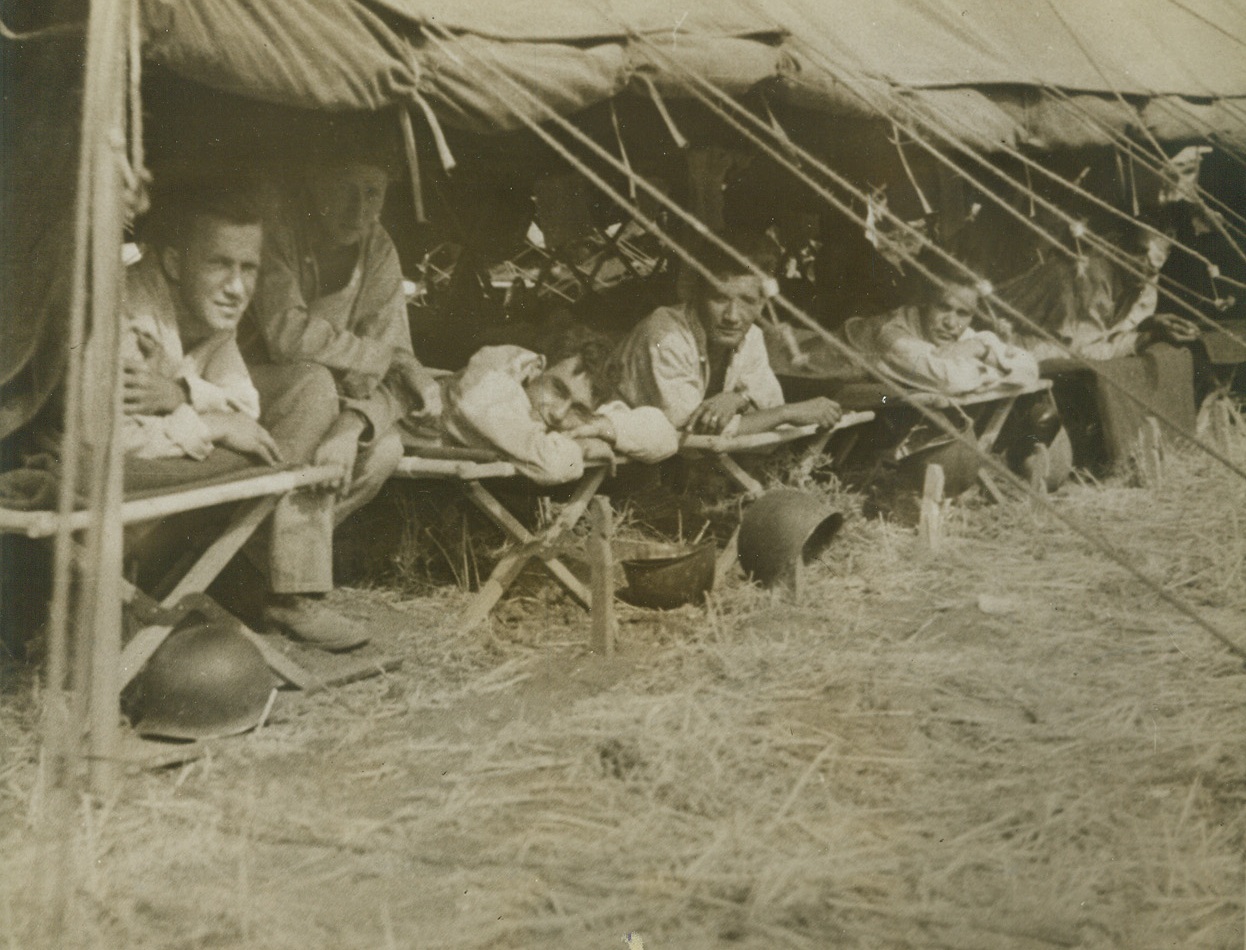
Recovering in Italy, 11/18/1943. Italy – These patients ill or slightly wounded, at an evacuation hospital in Italy, who are anxious to get back to their fighting units, are, (left to right): Pvt. John Banasiak, of Brooklyn, N.Y. (177-23rd St.); Pvt. Eugene Phillips, Bronx, N.Y.; Cpl. Stanley Woodward, Glasgow, KY.; S/Sgt. Manuel Reza, El Paso, Tex. (3016 Frudas St.); Cpl. Irving R. Nuttall, Philadelphia, PA. (6103 Torresdale, Ave.); Pvt. Dick Acker, Medford, Mass.; and Cpl. John Ausewein, Secaucus, N.J. Credit: U.S. Signal Corps photo from ACME;
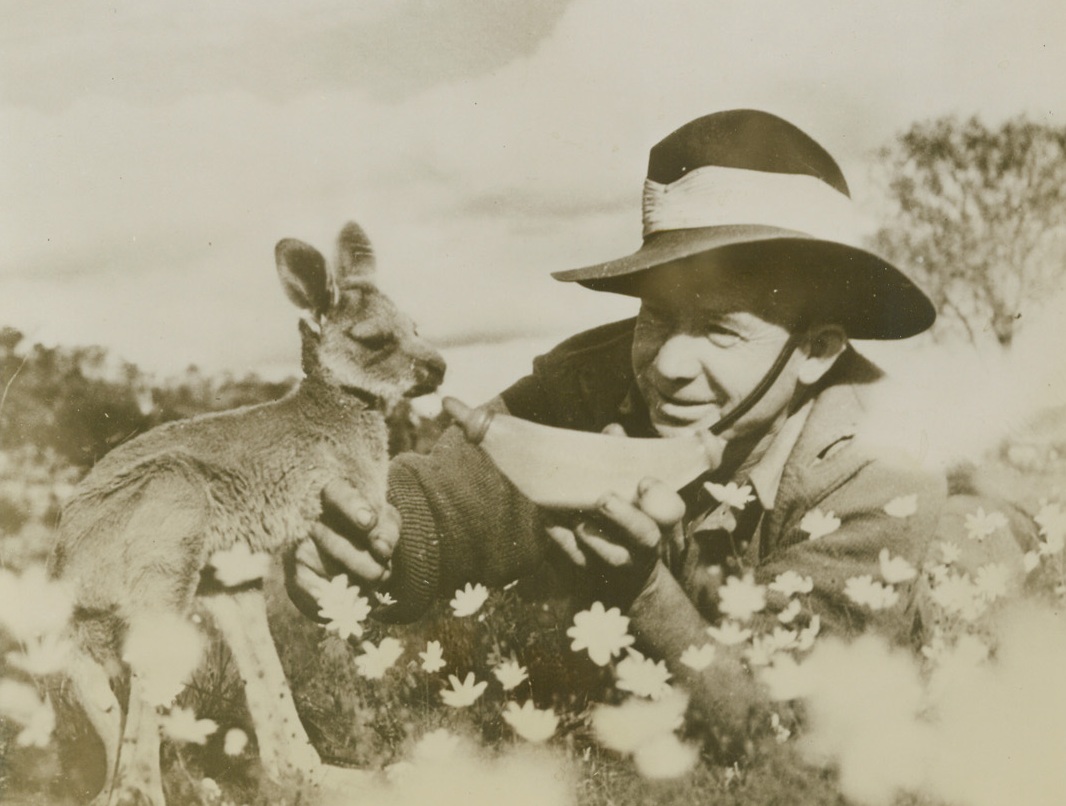
Bottle Baby, 11/4/1943. Australia – Expression on the face of “George” seems to repudiate any juncture with the bottle of milk held in the hand of Australian sapper A. P. Roberts. Nonetheless, the orphaned three-months-old baby kangaroo is thriving on the diet furnished by his artificial mother. Credit: ACME;
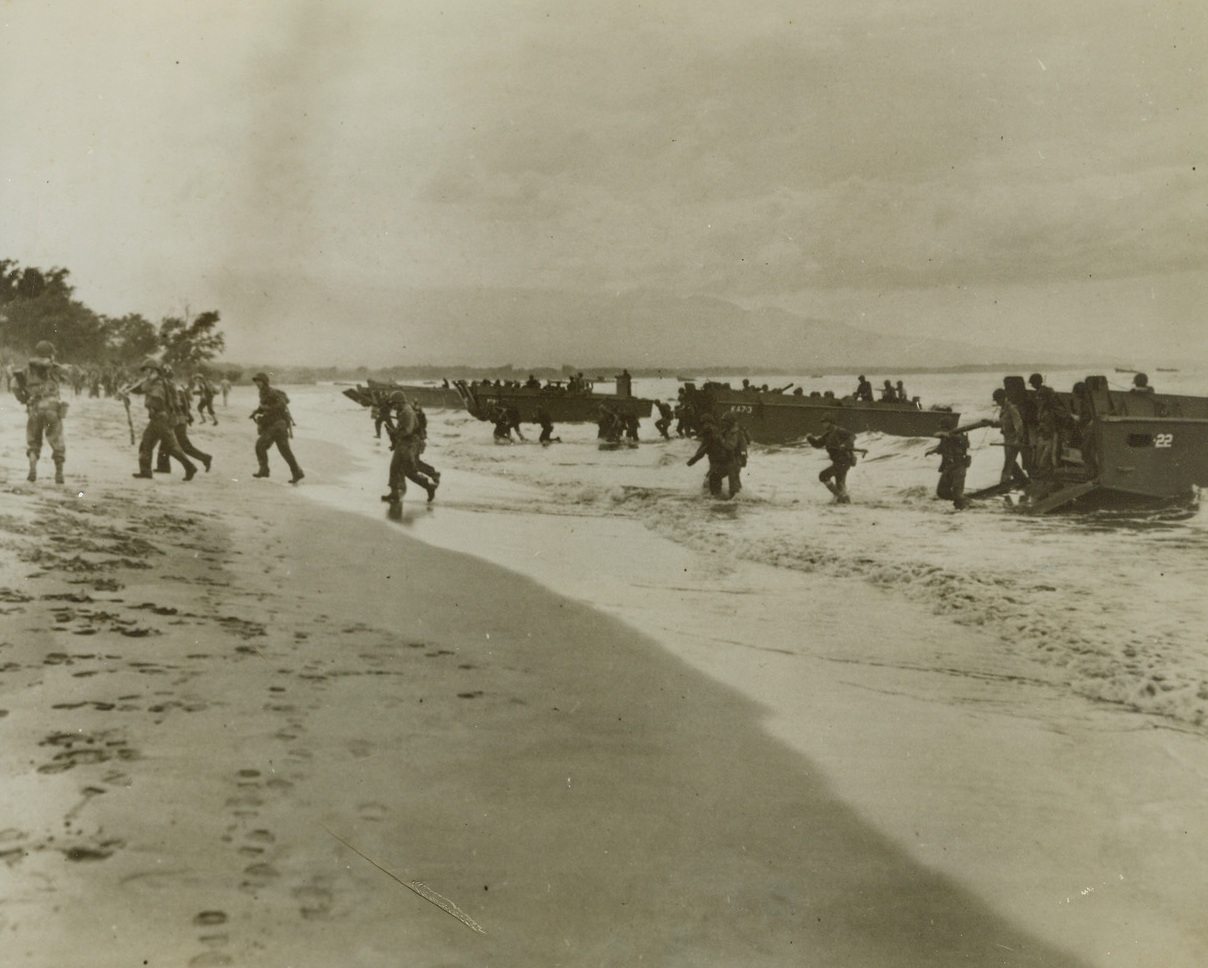
Dress Rehearsal, 11/26/1943. Somewhere in the Central Pacific – Splashing through the water and up the beach as their landing craft nose up to the shore, American troops practice amphibious landings somewhere in the Central Pacific. This was a prelude to the invasion of the Gilbert Islands. Credit: ACME;
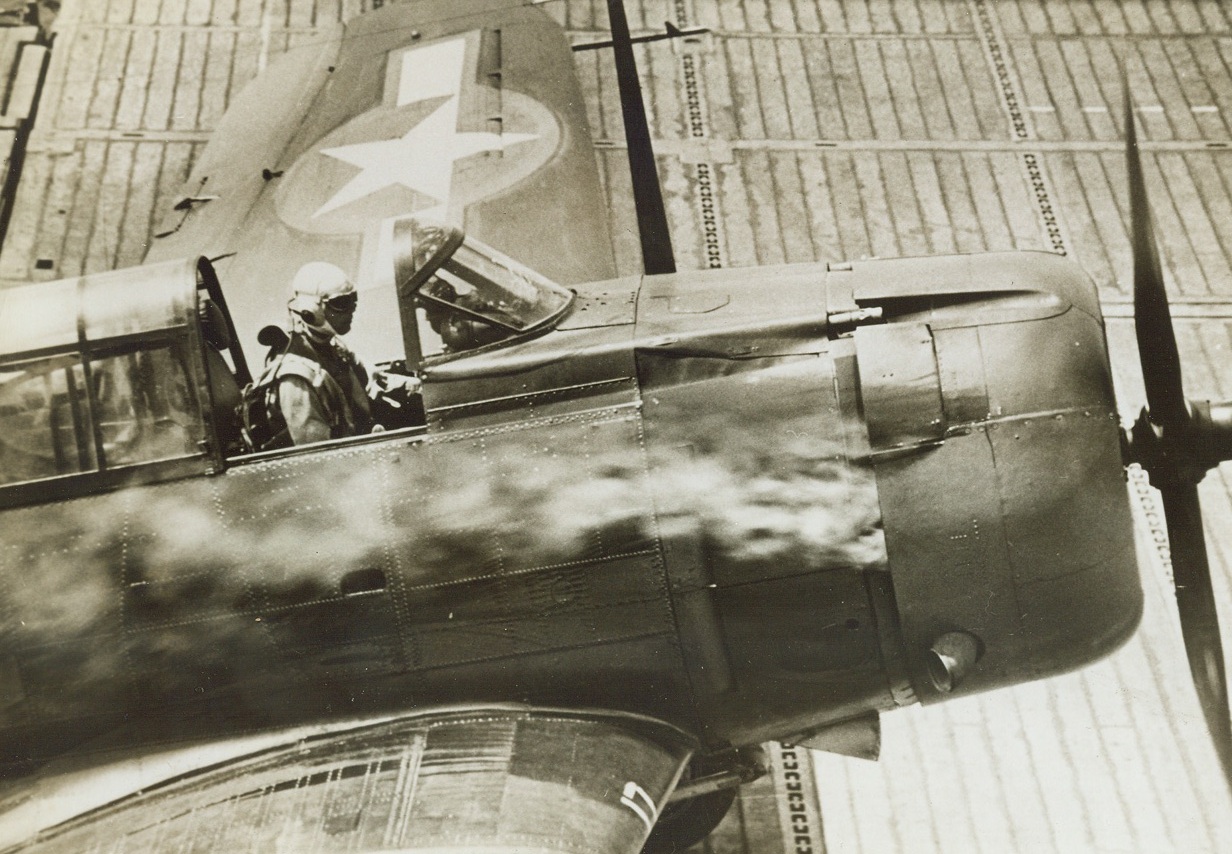
Nick of Time, 11/26/1943. South Pacific – His engine blazing from a lucky Jap hit, an American pilot brings down his Dive Bomber on the deck of a U.S. Aircraft Carrier during the raid on Rabaul when we knocked 70 Nipponese planes out of a flaming sky and sank 13 destroyers. Rather than bail out, this pilot outwitted the pursuing enemy and managed to bring down his plane. Credit: ACME;
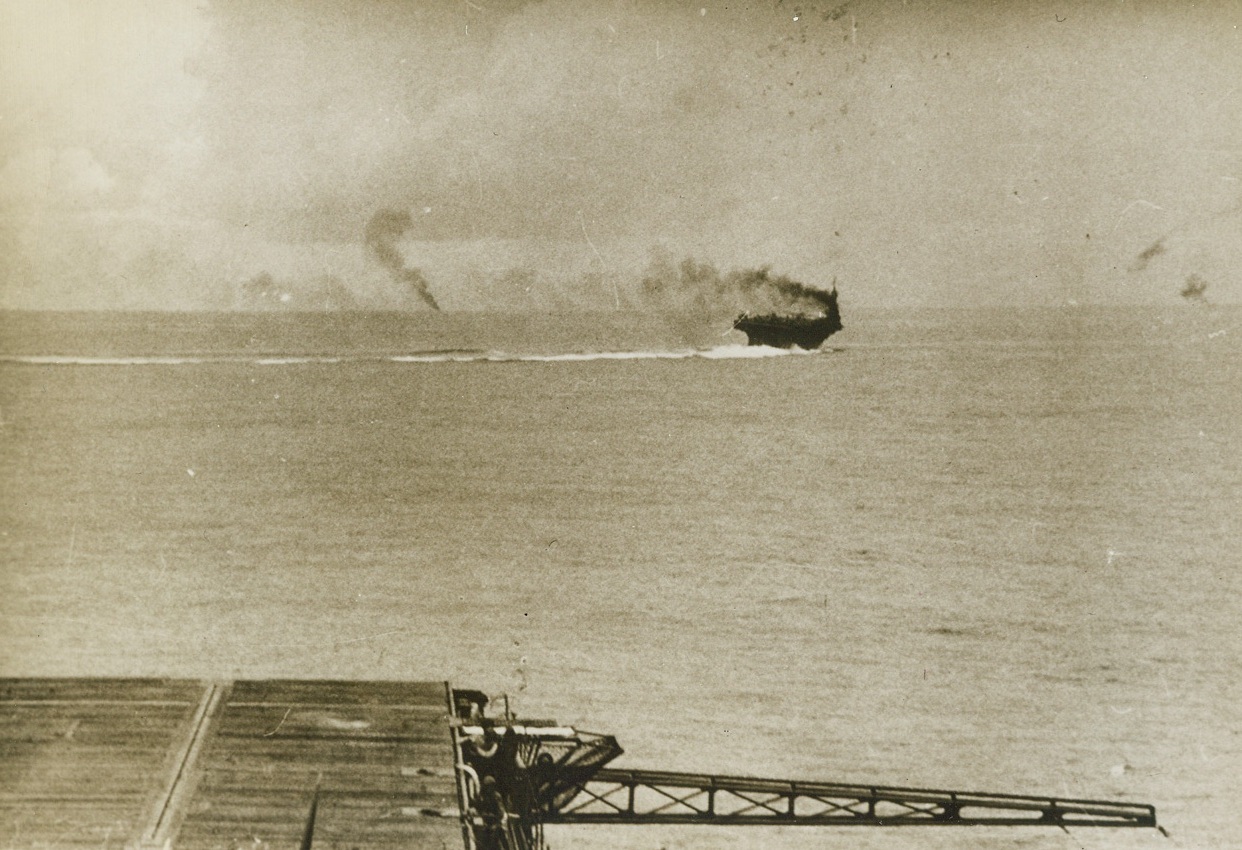
Yank Flat-Top Outwits Japs, 11/26/1943. South Pacific – With the deck of one U.S. Aircraft Carrier in the foreground, another of our Flat-Tops maneuvers wildly to escape Jap bombs while (left background) a Jap plane falls into the sea in flames, during the spectacular U.S. attack on Rabaul when our carrier-based planes shot down 70 Nip aircraft and sank and damaged two Jap Cruisers and 13 Destroyers. With the sky raining bombs and blazing Japanese planes, none of our ships were hit. Credit: ACME;
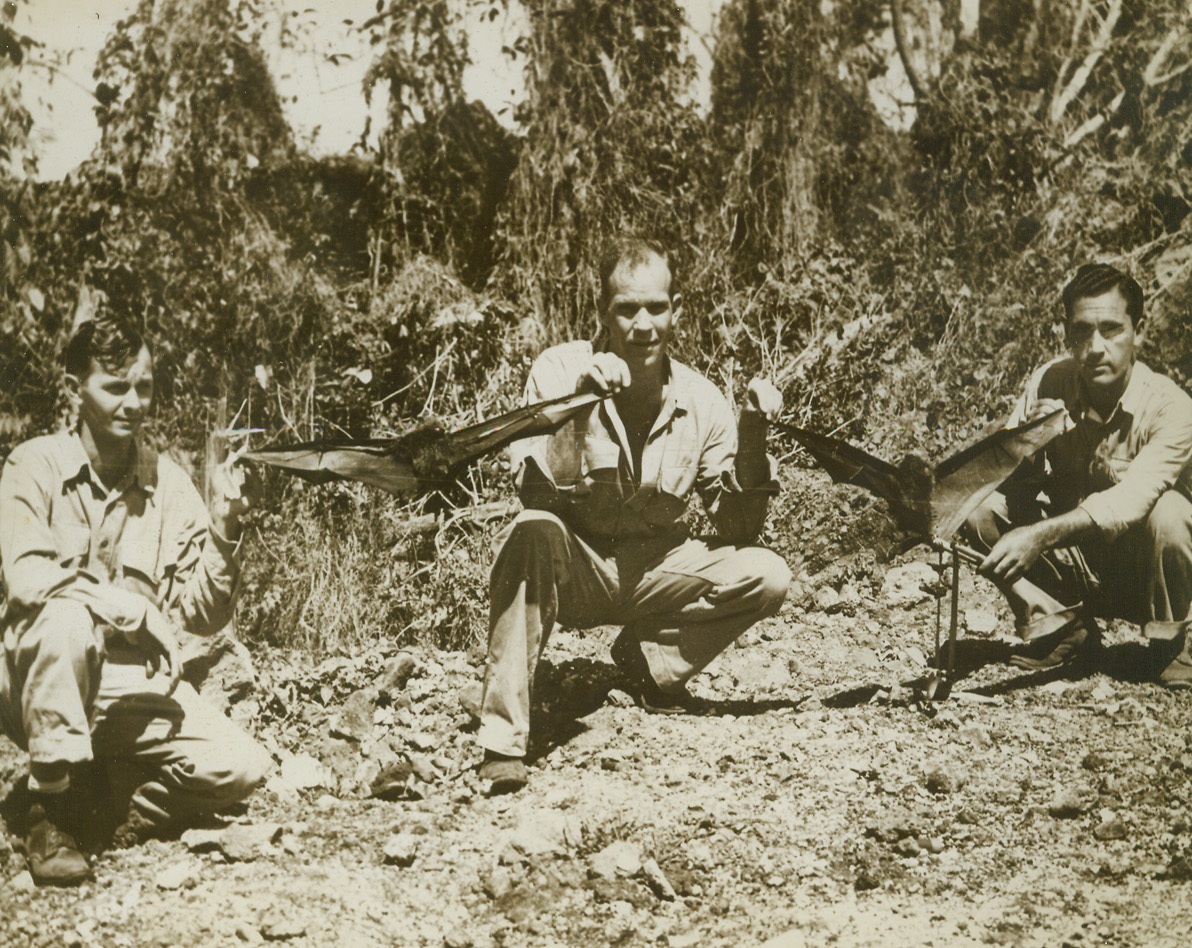
They Bag All Kinds of Rodents, 11/12/1943. Somewhere in the South Pacific – Known fro their ability to bag Japs, our Marines are adept at capturing any kind of rodent. Bagging bats with slingshots is a new sport that is fast gaining popularity among the Leathernecks. Here, posing with their catch are: (left to right): Cpl. John Robuda, South Haven, Mich.; Pfc. Willie (cq) L. Adams, Columbus, GA.; and Sgt. John R. Varese of Chicago, Ill. Credit: U.S. Marine Corps photo from ACME;

Lost in South Pacific, 11/10/1943. The United States Destroyer Henley which was sunk during October, 1943, as a result of a torpedo explosion. Sinking took place during evening. Credit: Official U.S. Navy photo from ACME;
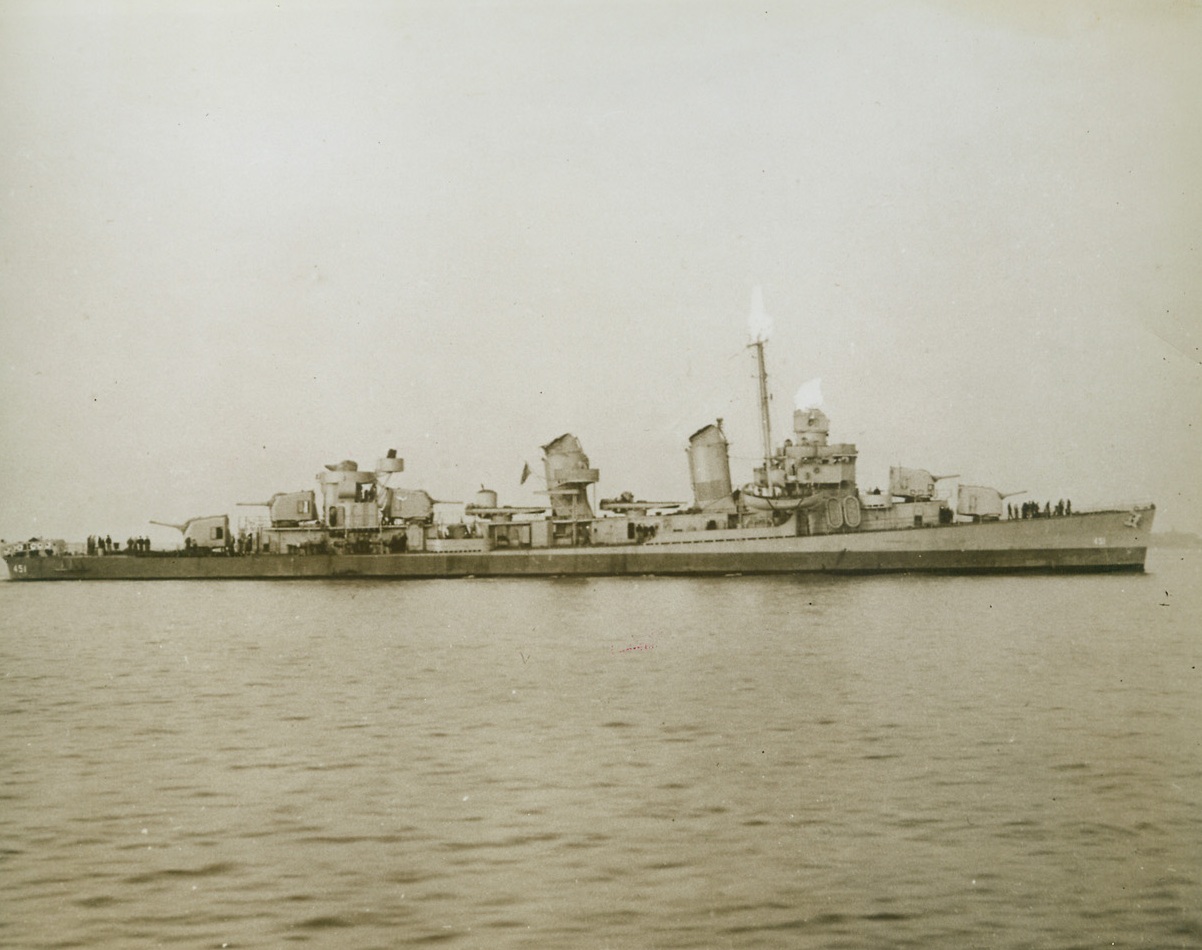
Sunk in South Pacific Action, 11/10/1943. The United States Destroyer “Chevalier” which was lost in a South Pacific action during a night engagement on October 6th, 1943. The Chevalier was severely damaged by the enemy and collided with another Destroyer in the formation. She subsequently broke in two and sank. Credit: U.S. Navy Official Photo from ACME;
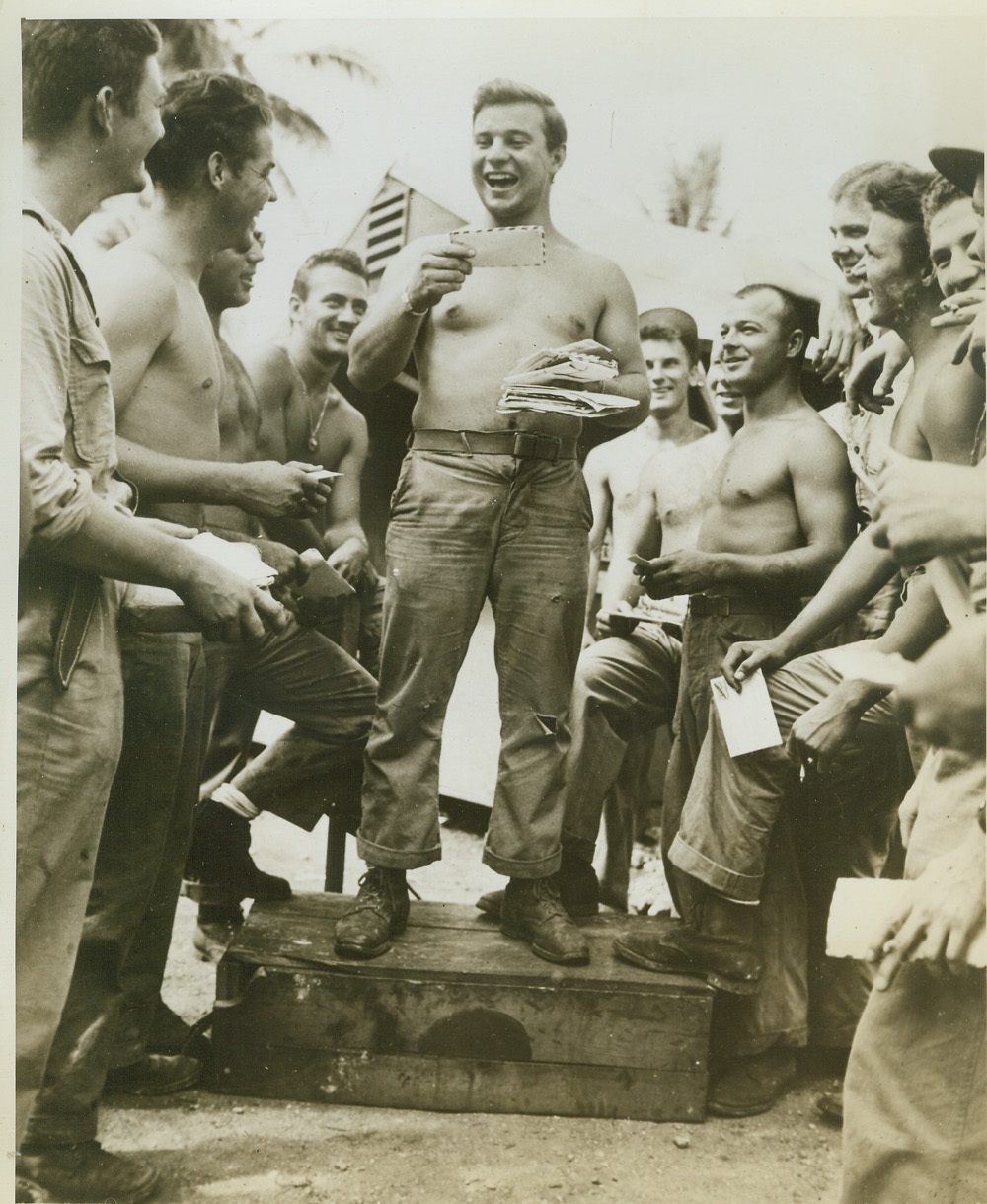
Mail Ho!, 11/16/1943. SOUTH PACIFIC -- There's nothing to give a fighting man a new lease on life, the way the "mail call" does. The smiles on the faces of these Marine fliers on Espiritu Santo, reflect the holiday spirit which prevails when a buddy sings out names of the addresses on the letter. (Let's have that "sugar report" bub!) Credit: (U.S. Navy Official Photo from ACME);

Japanese Jitters, 11/30/1943. Rabaul, N.B.: Panic, confusion and destruction was the order of the day at the big Japanese base at Rabaul on Nov. 5 when U.S. Pacific Fleet carrier aircraft struck hard and fast against enemy fleet units. Twenty-five Jap ships can be seen here desperately trying to get from under the downpour of American bombs which are striking on and around them. Credit: Official U.S. Navy Photo from ACME;
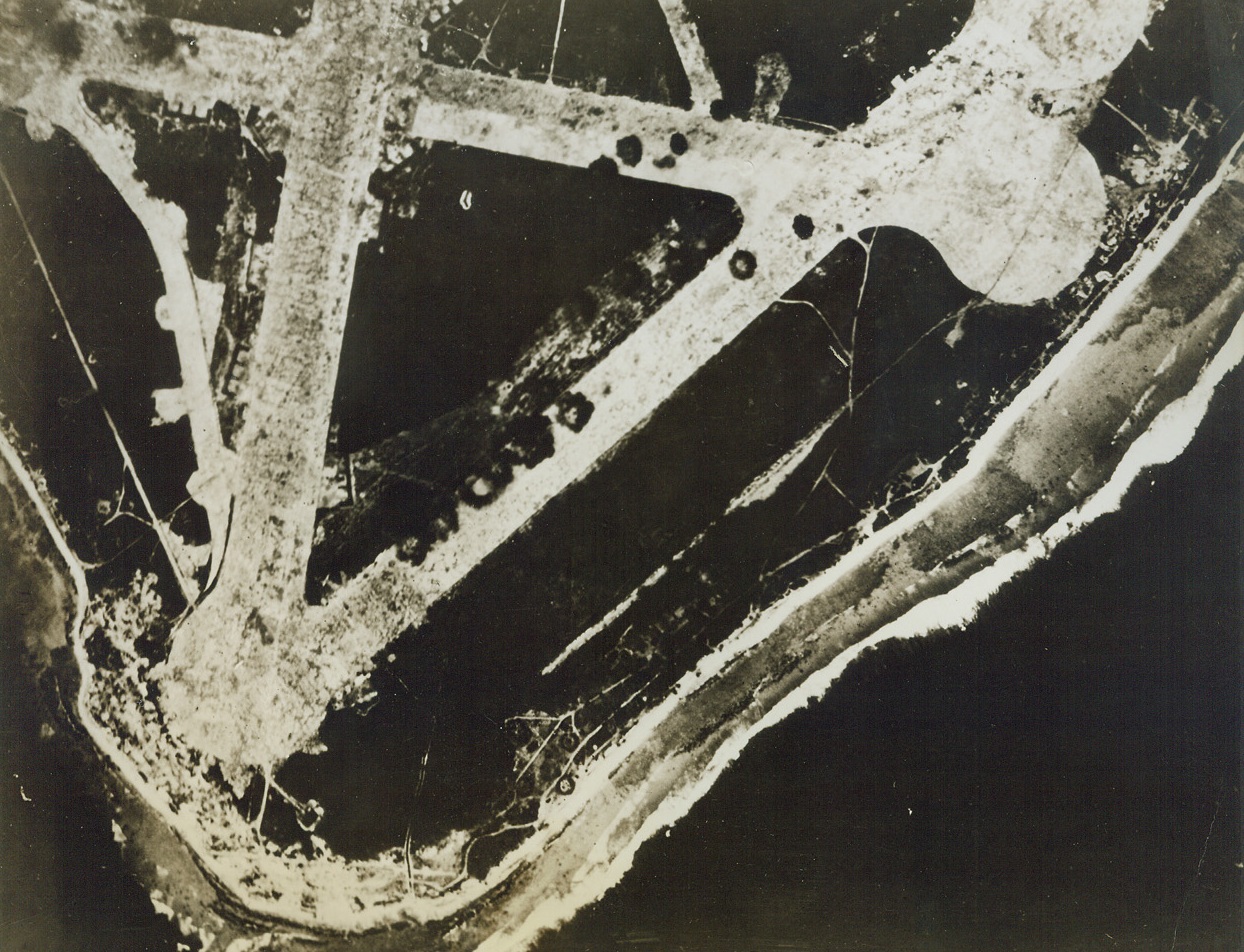
Would Atoll Call be Coming?, 11/30/1943. Mille, M.I.: Shown here is Mille Atoll, in the Marshall Islands, which may be the enemy base next on the American invasion schedule in the Central Pacific. Bomb hits can be seen, registered by American Liberators, on the Jap’s triangular runways. Attack here by the Seventh Air Force preceded the Pacific Fleet’s assault on the Gilbert group. Credit: Official U.S. Army Air Force photo from ACME;
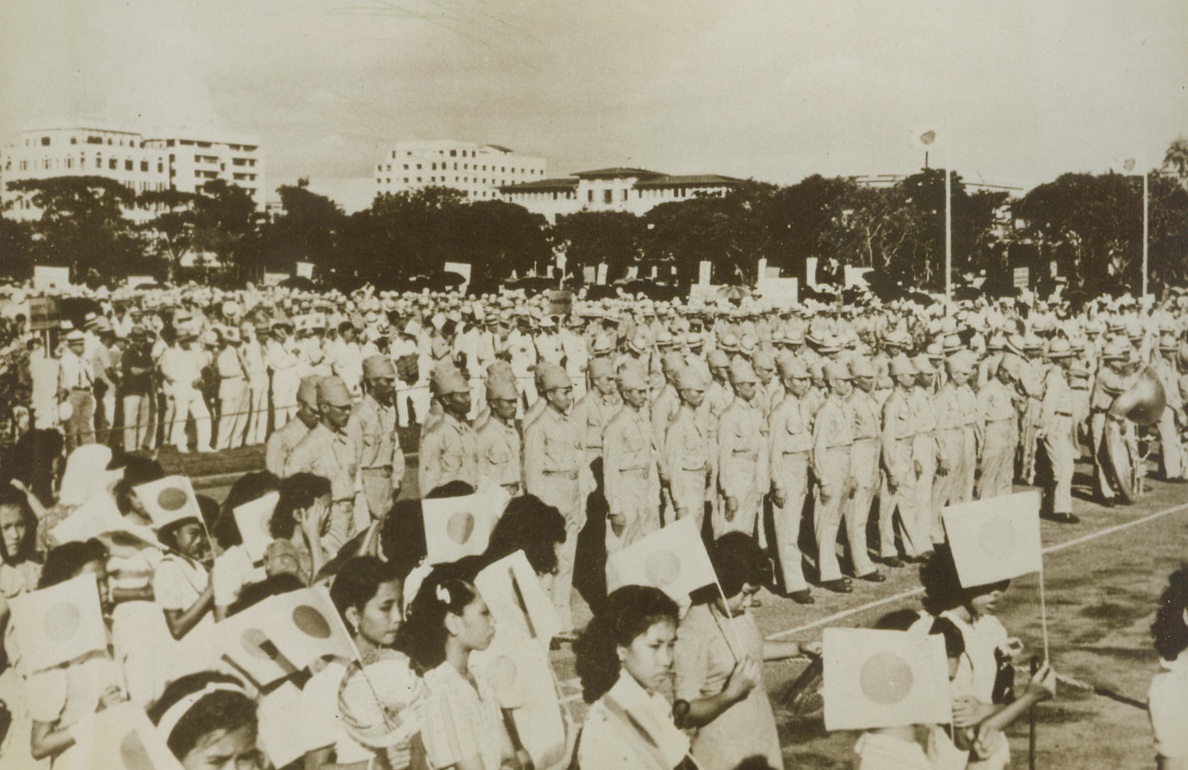
Filipino Youths All for Japan – Japan Says, 11/18/1943. Manila – This Jap-made picture smuggled to the United States supposedly shows Filipino youths (center, uniforms) preparing to sail from Manila for Japan to take up studies fitting them as future leaders in their homeland. In the foreground, Filipino girls wave Jap flags. According to the Japanese caption, the youths represent some of the leading families of the Philippines. The photo was brought out of Japanese-occupied territory by Raymond P. Cronin, an American Newspaperman who was interned at Manila and is now enroute to the U.S. aboard the exchange ship Gripsholm. Credit: ACME;

Liberty Ship Bombed by Japs, 11/30/1943. South Pacific – A Liberty ship which had carried a valuable cargo of oil to allied forces in the South Pacific, reaching its destination after a two-month journey, burns fiercely after being hit by bombs from a Jap plane. Most of the ship’s cargo was unloaded safely.Credit Line (U.S. Army Air Forces photo from ACME);
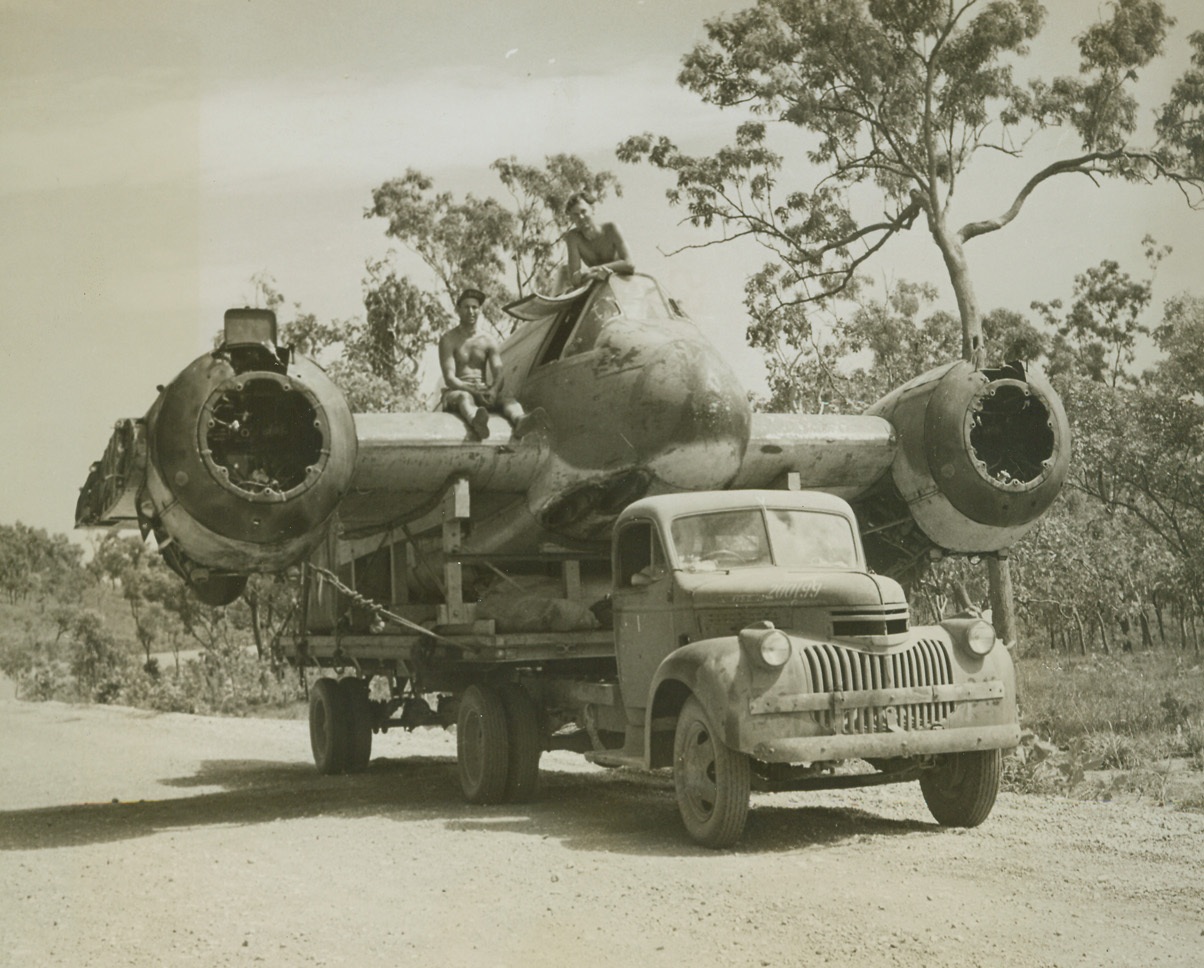
Aircraft Carrier, 11/25/1943. Somewhere In Northwest Australia – Returning to its base in Northwestern Australia on one motor, and making a belly landing, this royal Australian Air Force Beaufighter completed a successful mission in Timor. Now, riding atop an aircraft-carrier-on-wheels, the warbird is heading for a repair shop for reconditioning. It will soon fight from the skies again, with the Beaufighter Squadron that has rung up a total of 60 destroyed enemy aircraft, 4 probables, and 61 damaged, in the first ten months of 1943.Credit Line – WP—(Photo by Thomas L. Shafer, ACME Correspondent for War Picture Pool);
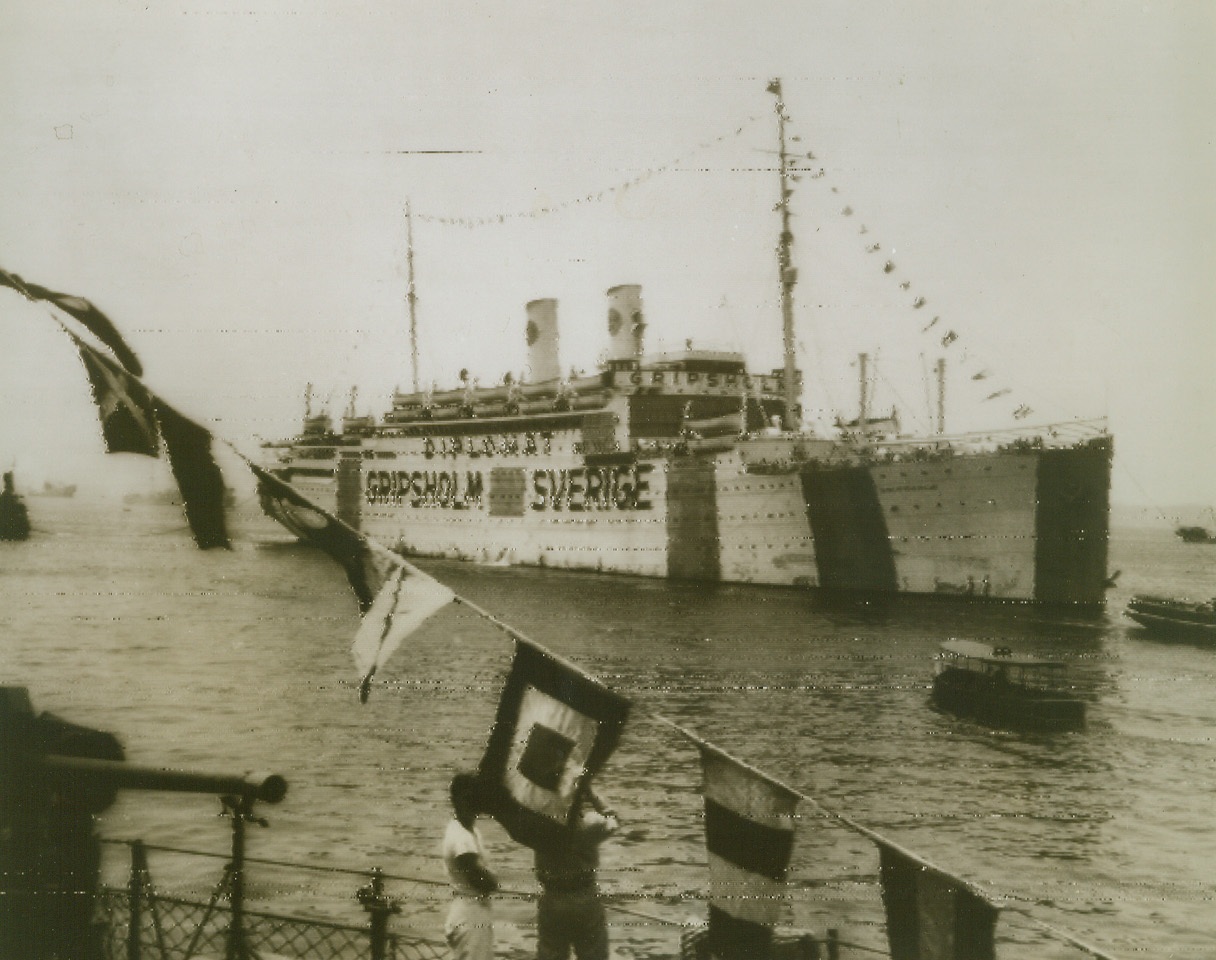
1,500 Americans Arrive “Home” from Japan, 11/15/1943. Rio De Janeiro – The nightmare of Japanese internment camps is over for 1,500 citizens of North and South America who arrive at Rio De Janeiro aboard the Swedish repatriation ship the Gripsholm. The mercy vessel is enroute to New York from Mormugao, Portugese India.Credit (CIAA radio photo from ACME);
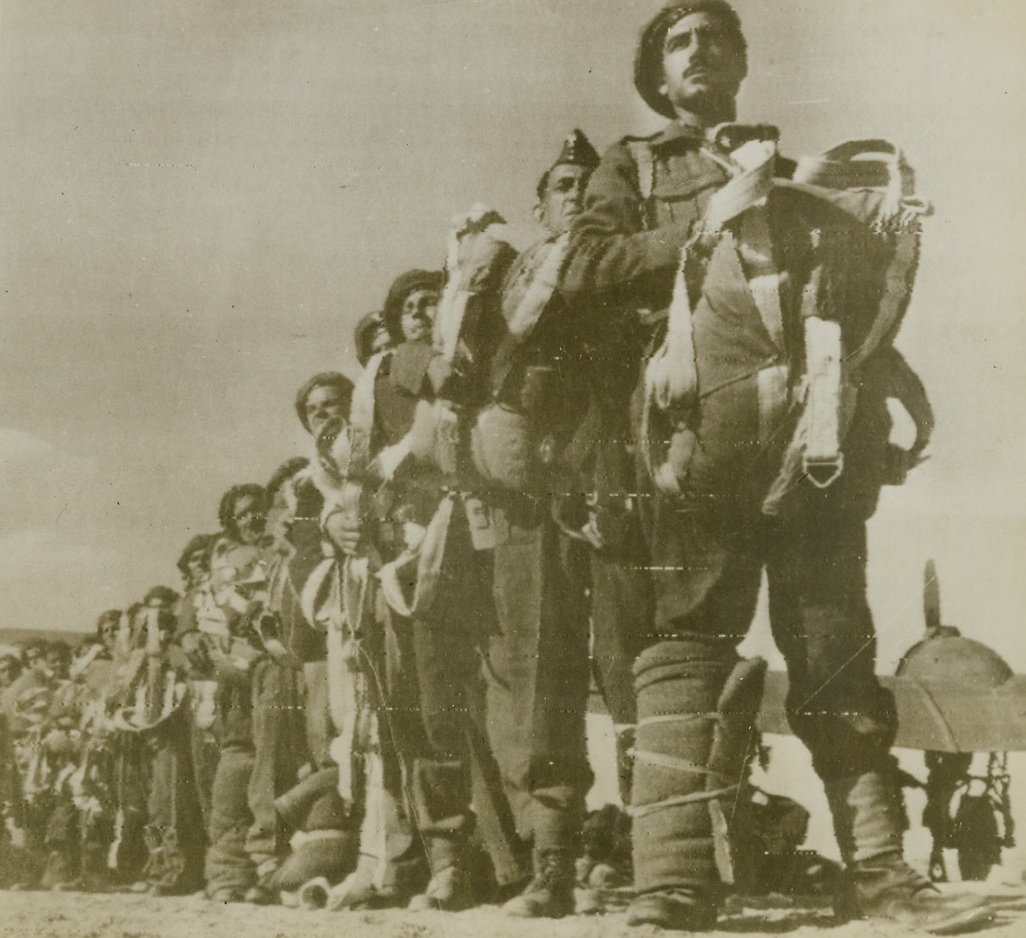
On Samos They’ll “Do or Die”, 11/15/1943. Middle East – Greek parachutists of the famous Sacred Brigade prepare to put their 2,000-year-old slogan, “Come Back Victorious or Dead”, into effect on Samos Island, as they board the R.A.F. transport which dropped them over the Dodecanese Island. The Greeks were trained as paratroopers following the Tunisian campaign.Credit (ACME radio photo);
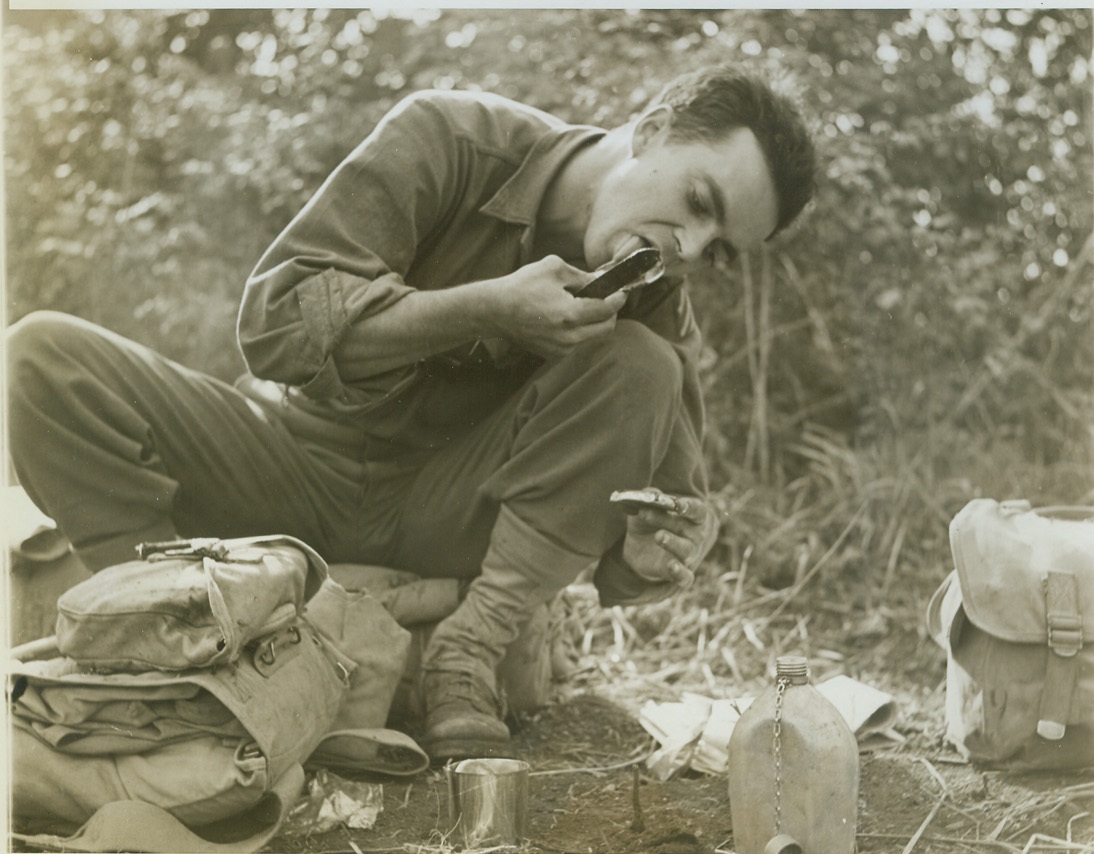
No Use Wasting Any, 11/8/1943. ITALY -- Pvt. Bill Duncan, Mason City, Ia., licks the top of a chocolate syrup can after pouring some of it over his crackers for a field-made dessert. He is a member of a U.S. Infantry regiment which made a half-hour stop for lunch near Pietravairano, Italy. The men prepare their meals from field rations as best they can. On many days the soldiers are not lucky enough to get peace and quiet for their noon-time meals. Credit: -- WP-- (ACME Photo by Bert Brandt, War Pool Photographer);

Jap Loses To Liberator, 11/8/1943. Somewhere in the Pacific – Trailing black smoke and flame from her starboard outboard engine, a Jap four-motored “Mavis” flying boat starts its final glide downward after losing in a dogfight with a U.S. Navy consolidated Liberator PB4Y patrol bomber, “somewhere in the Pacific.” This photo, released by the Navy Department today, was taken during the fight last August by a photographer aboard the victorious Liberator.Credit Line (Official U.S. Navy photo from ACME);
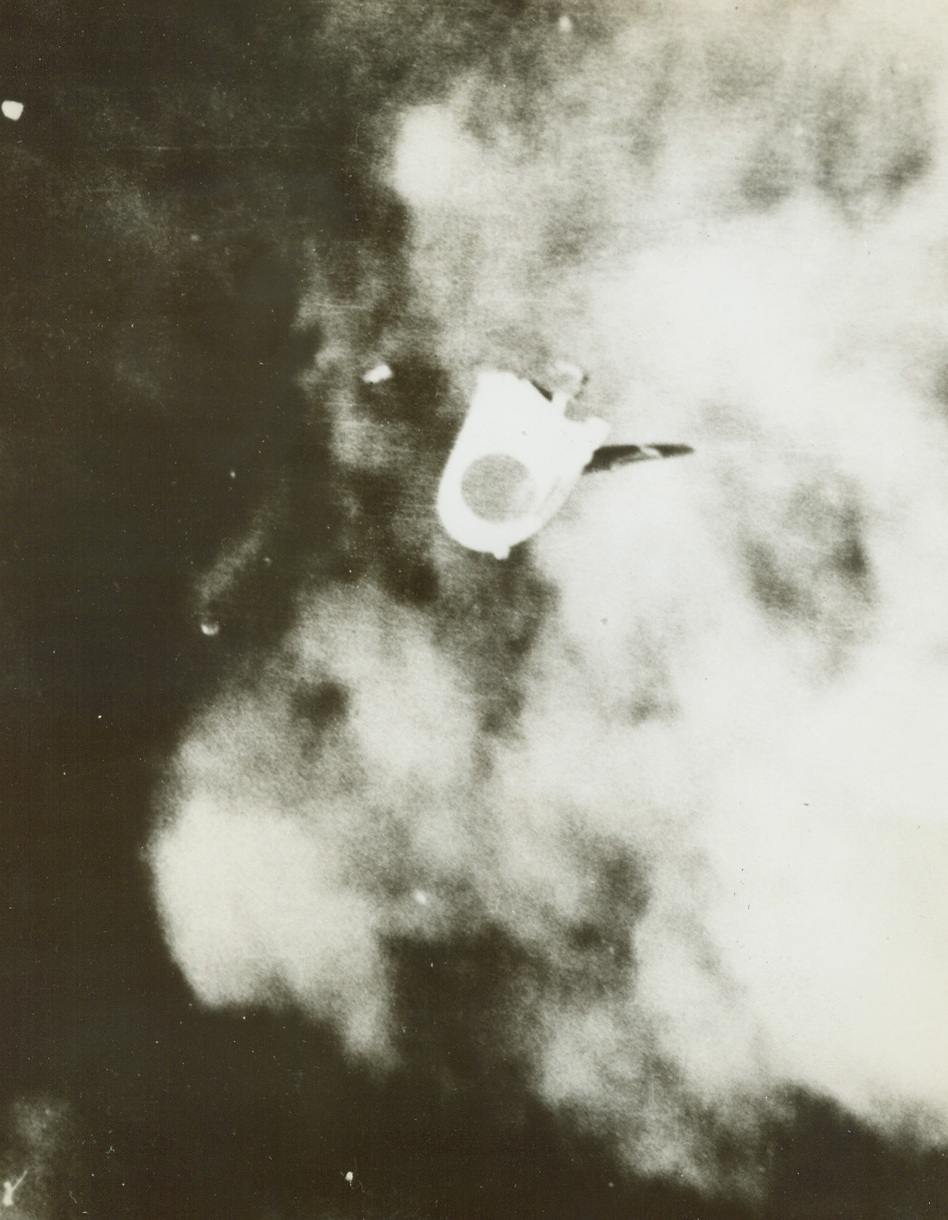
Japs Loses to Liberator, 11/8/1943. Somewhere in the Pacific – Trailing black smoke and flame from her starboard outboard engine, a Jap four-motored “Mavis” flying boat starts its final glide downward after losing in a dogfight with a U.S. Navy consolidated Liberator PB4Y patrol bomber, “somewhere in the Pacific.” This photo, released by the Navy Department today, was taken during the fight last August by a photographer aboard the victorious Liberator.Credit Line (Official U.S. Navy photo from ACME);
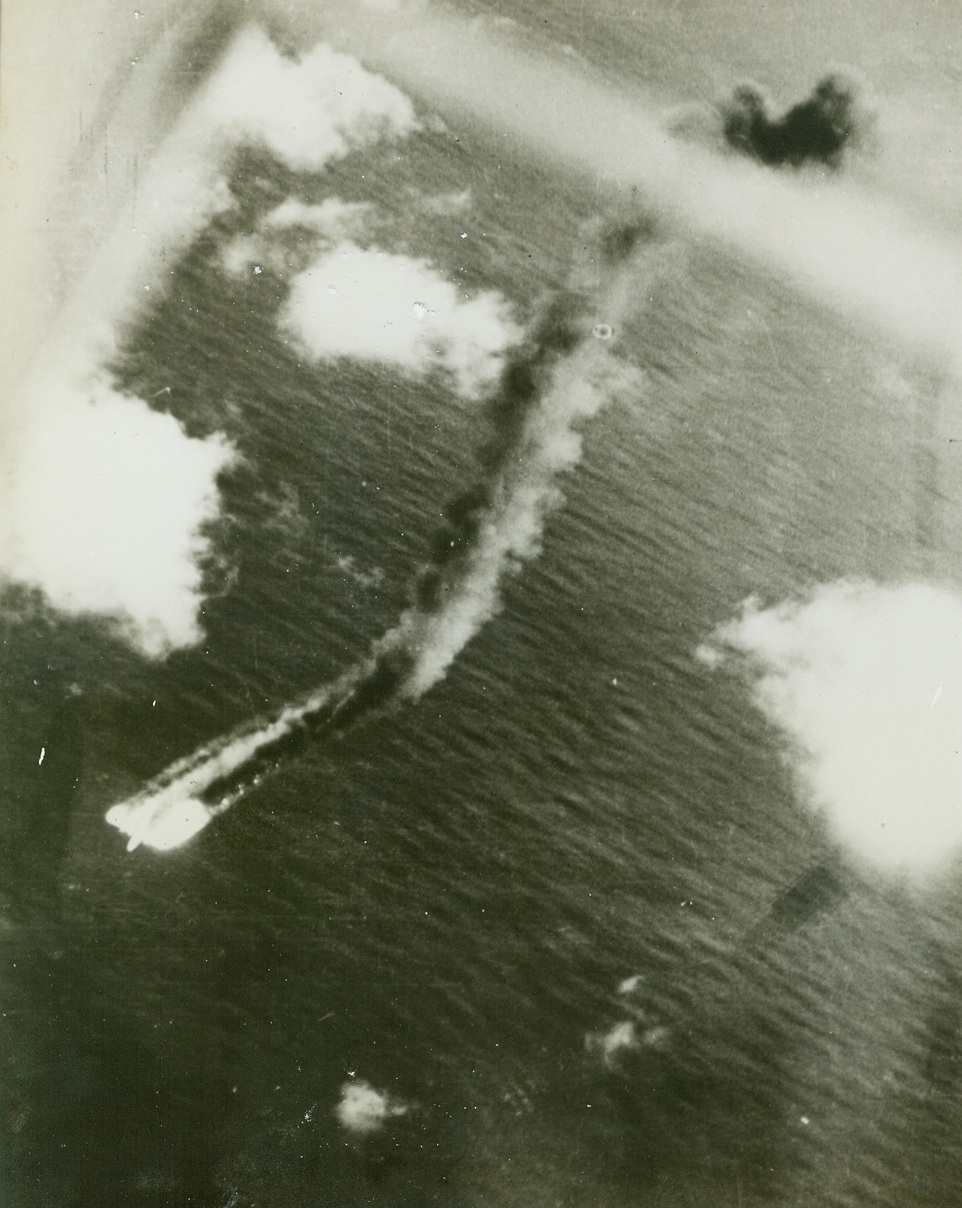
Jap Loses to Liberator, 11/8/1943. Somewhere in the Pacific – Wrapped in flames, which trail out behind twice the length of the fuselage, a huge Jap “Mavis” four-engined flying boat nears the surface of the sea after an unsuccessful dogfight with a U.S. Navy PB4Y consolidated Liberator patrol bomber, “somewhere in the Pacific.” This photo, released by the Navy Department today, was taken from the victorious Liberator during the battle last August. The American plane followed the doomed nip down to get photos of its death dive.Credit Line (Official U.S. Navy photo from ACME);
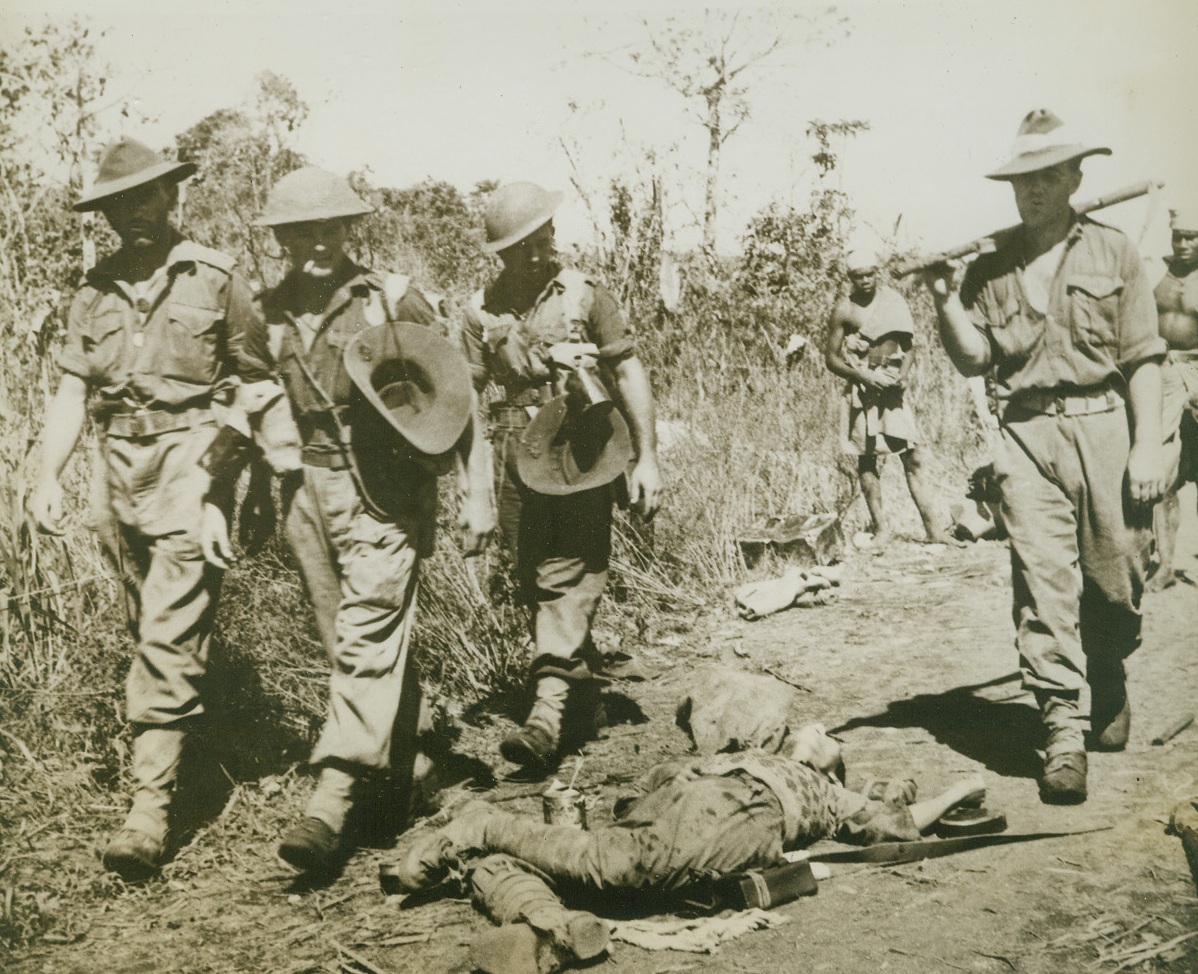
Dead Jap at Lae, 11/9/1943. Lae, New Guinea – Australian soldiers moving up to the front near Lae, step around this dead Jap – one of Lae’s defenders killed in the fighting that resulted in the Allies’ capture.Credit Line (ACME);
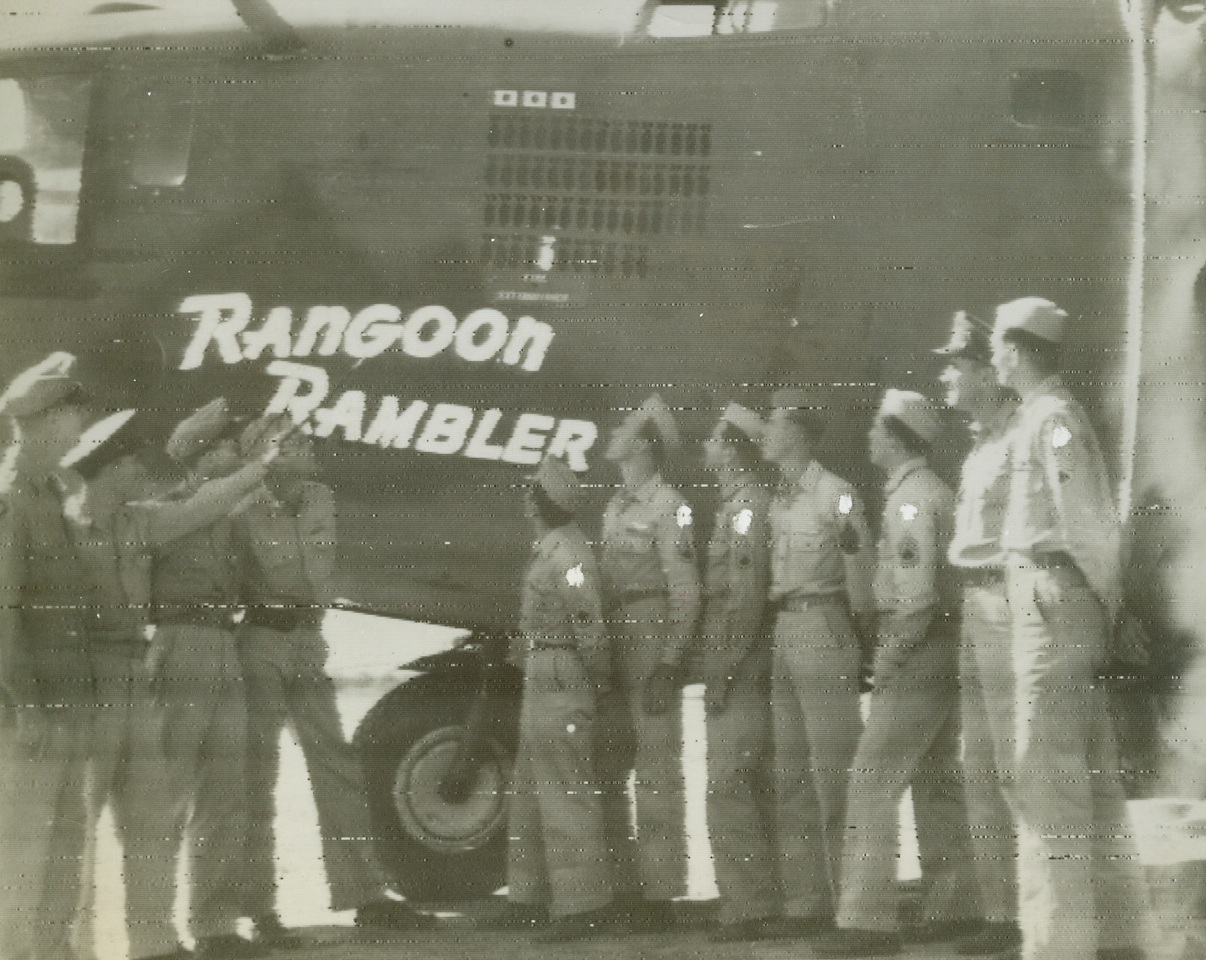
“Rangoon Rambler” Heads for Home, 11/9/1943. This photo, flashed to New York by radio today from “somewhere in Southeast Asia”, shows Maj. Gen. George E. Stratemeyer, U.S. Air Commander in Southeast Asia, bidding bon voyage to the crew of the consolidated B-24 Liberator bomber “Rangoon Rambler”, which is on its way back to the United States on tour. The members of the crew, each having been awarded the Air medal and the Distinguished Flying Cross, average 400 combat hours apiece. Left to right, are: Gen. Stratemeyer; Capt. Raymond C. Pato, Phoenix, Ariz., pilot; Lt. Guy Spotts, Williamsport, PA.; Lt. Robert P. Currie, Big Springs, Tex., Sgt. Adolph Scolourino, Providence, R.I.; Sgt. Edward M. Salley, Houston, Tex.; Sgt. John E. Craigie, West Haven, Conn.; Sgt. Joseph E. Willis, Augusta, Ark.; Sgt. Ferdinand Knechtel, Ellwood City, Pa.; Capt. Gordon H. Wilson, Covington, KY.; and Sgt. Carl L. Parks, of Antigo, Wis.Credit Line (10th Air Force photo via OWI from ACME);
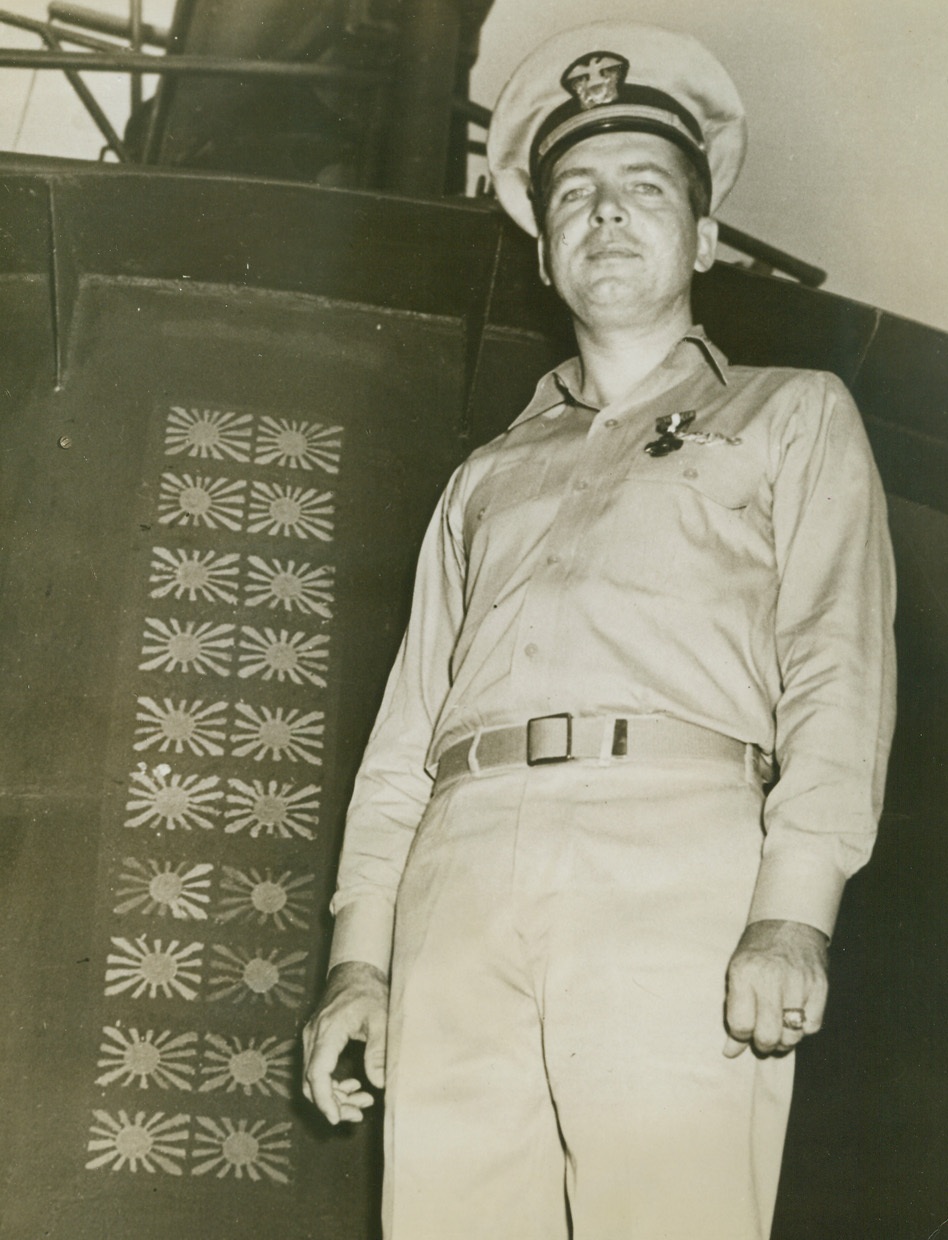
His Specialty is Knocking Out Jap Ships, 11/10/1943. At a Pacific base – Lt. Comdr. Roy M. Davenport (above) of Los Angeles, Calif., wears the Navy cross recently presented to him for sinking “many thousands of tons” of enemy shipping. Davenport, a submarine commander, stands beside his vessel’s conning tower, on which are painted Jap flags indicating the enemy victims.Credit Line (Official US Navy photo from ACME);
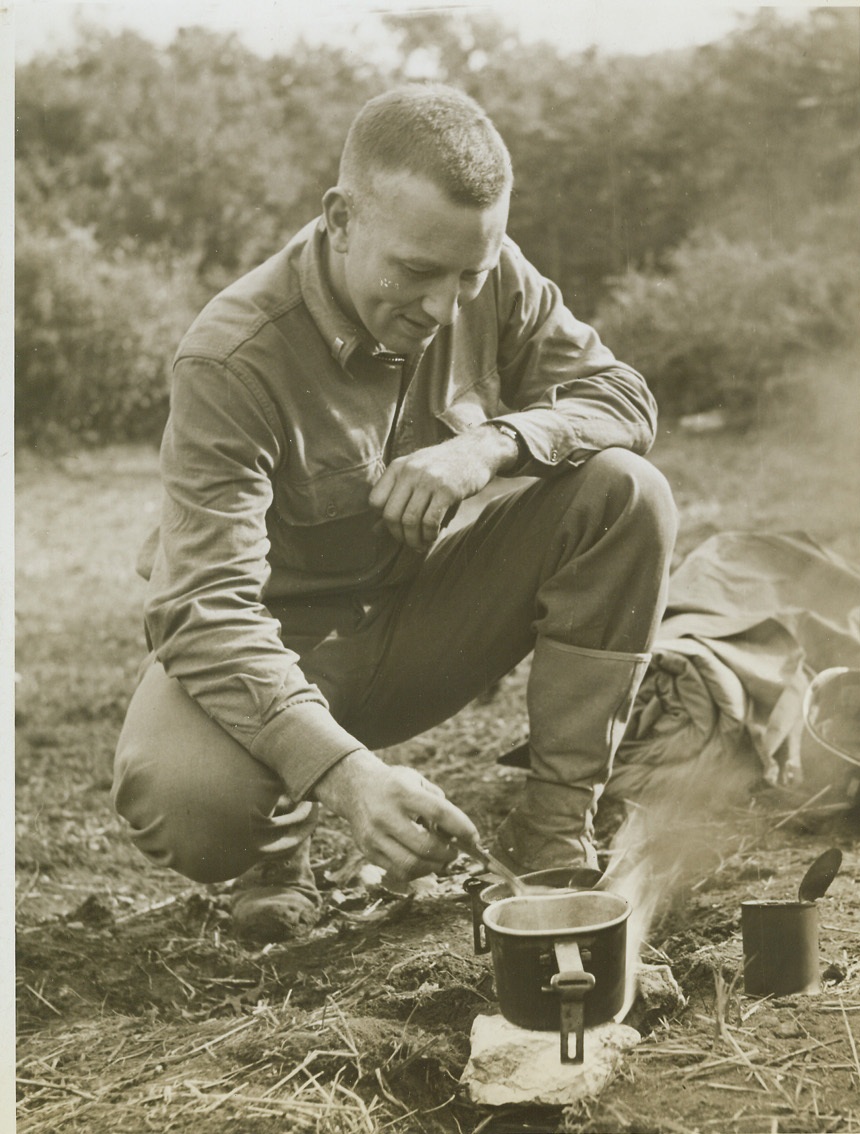
But It's No Picnic, 11/8/1943. ITALY - This may remind you of the days you've been out picnicking in the nice peaceful countryside, but to Lt. Rupert Prohme, Burlingame, Calif., member of a U.S. Infantry regiment, it's a lot different. Taking advantage of a brief half-hour lull in fighting near Pietravairano, Italy, he heats C rations and hot chocolate over an open fire as he prepares his lunch. Credit: -- WP--(ACME Photo by Bert Brandt War Pool Photographer);
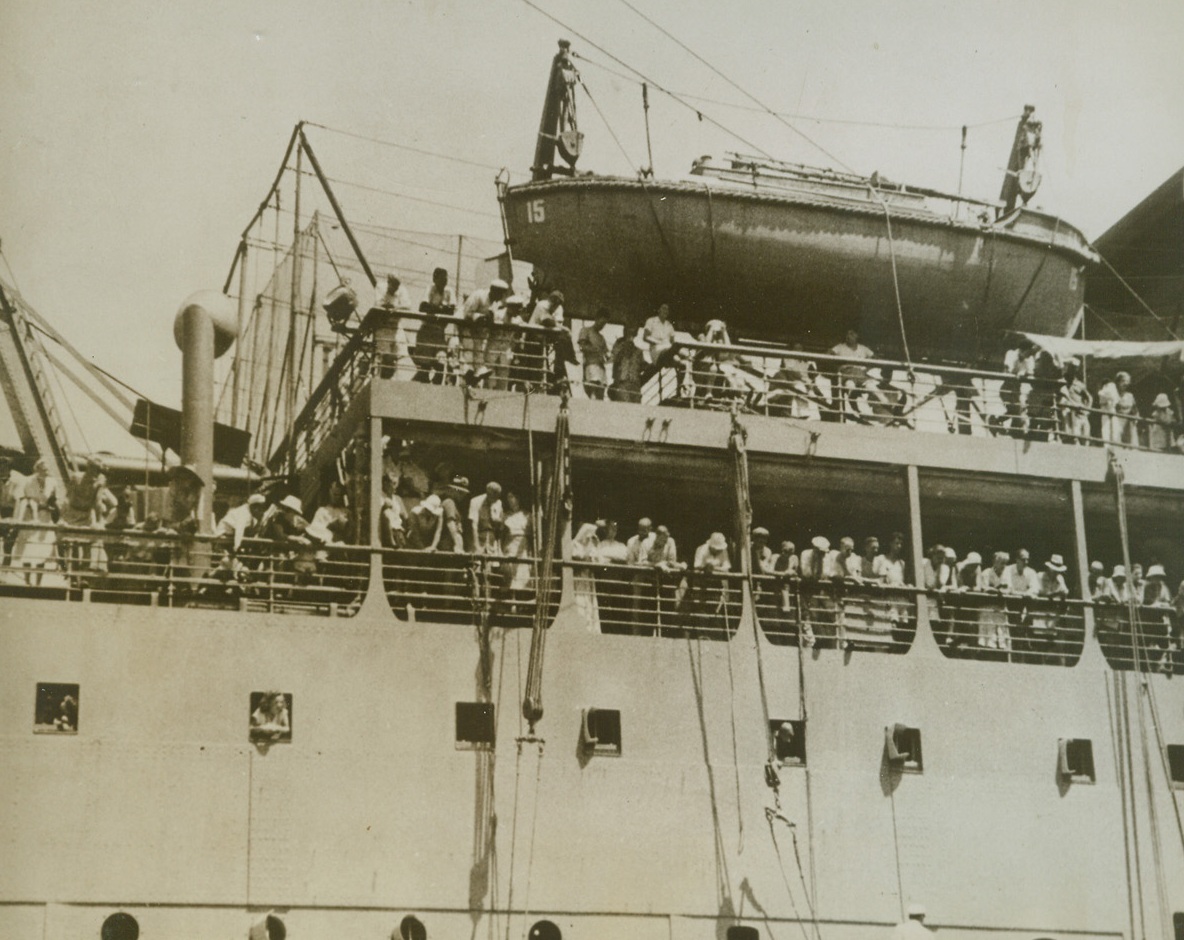
On Their Way to Freedom, 11/1/1943. Portuguese, India – The sight of Mormugoa, Portuguese India, represents the end of nightmarish confinement in Japan to these 1,500 allied internees arriving on the Jap exchange ship Teia Maru. Among the exchange prisoners crowding the rails are 1,100 American Nationals.Credit Line (ACME);

Smoking the Japs Out, 11/24/1943. New Georgia Island – Firmly entrenched in the jungles of New Georgia, the Japs, had to be literally smoked and burned out of their positions. Here, flame from a U.S. infantryman’s flame thrower sprays a Jap pillbox during mopping-up operations.Credit Line (U.S. Signal Corps photo from ACME);
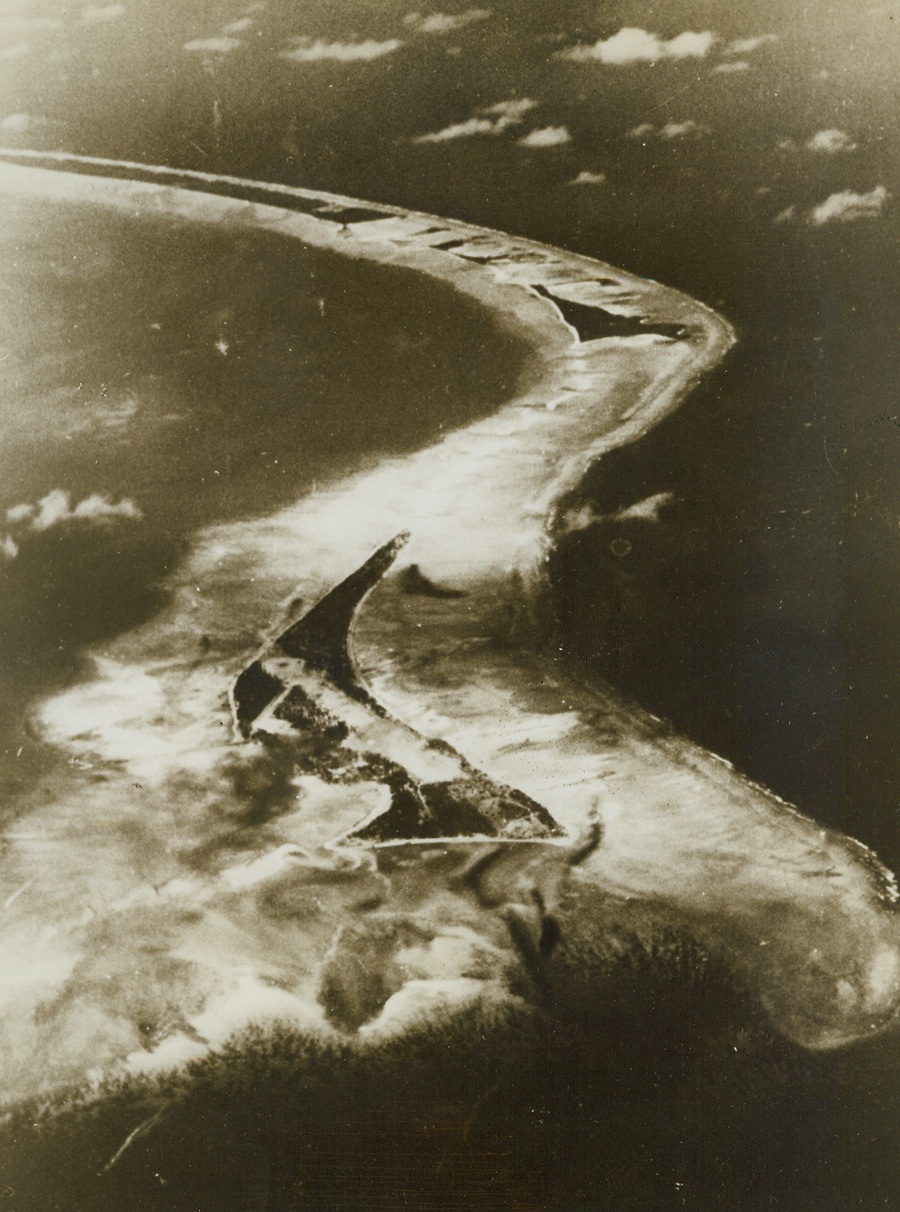
New Central Pacific Objective, 11/23/1943. Central Pacific – Marines and Army soldiers are putting up a terrific battle for this tiny speck of an island in the Central Pacific, named Tarawa. One of the Gilbert group, Tarawa is 25 miles South of Makin, where another bloody battle is in progress.Credit (U.S. Navy of official photo from ACME);
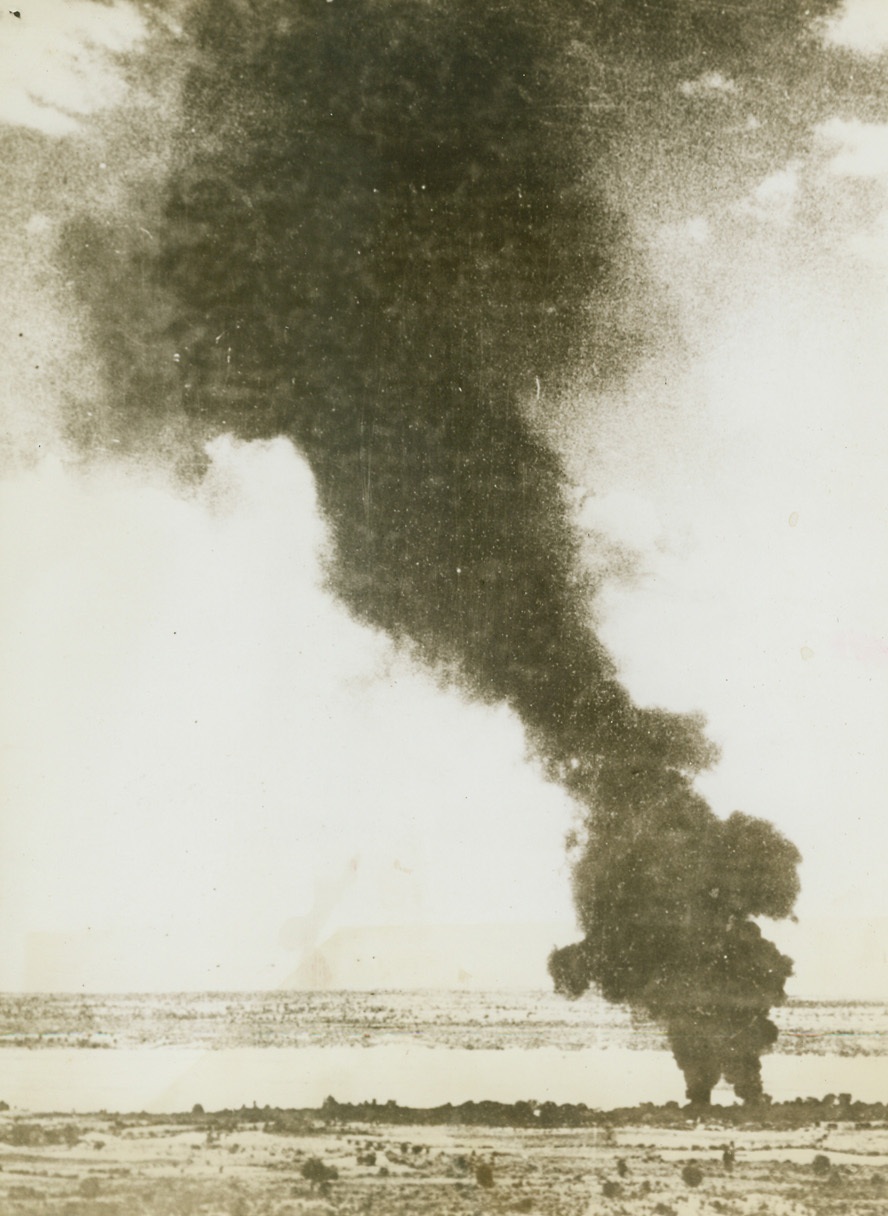
Jap Oil Makes Beautiful Blaze, 11/22/1943. Magwe, Burma – Two oil tanks of the Yethaya refinery near Magwe, full of Japanese oil, make a pretty fire as they blaze merrily away after an attack by Beaufighter aeroplanes. Fury of fighting in the Burma area is increasing daily.Credit (ACME);
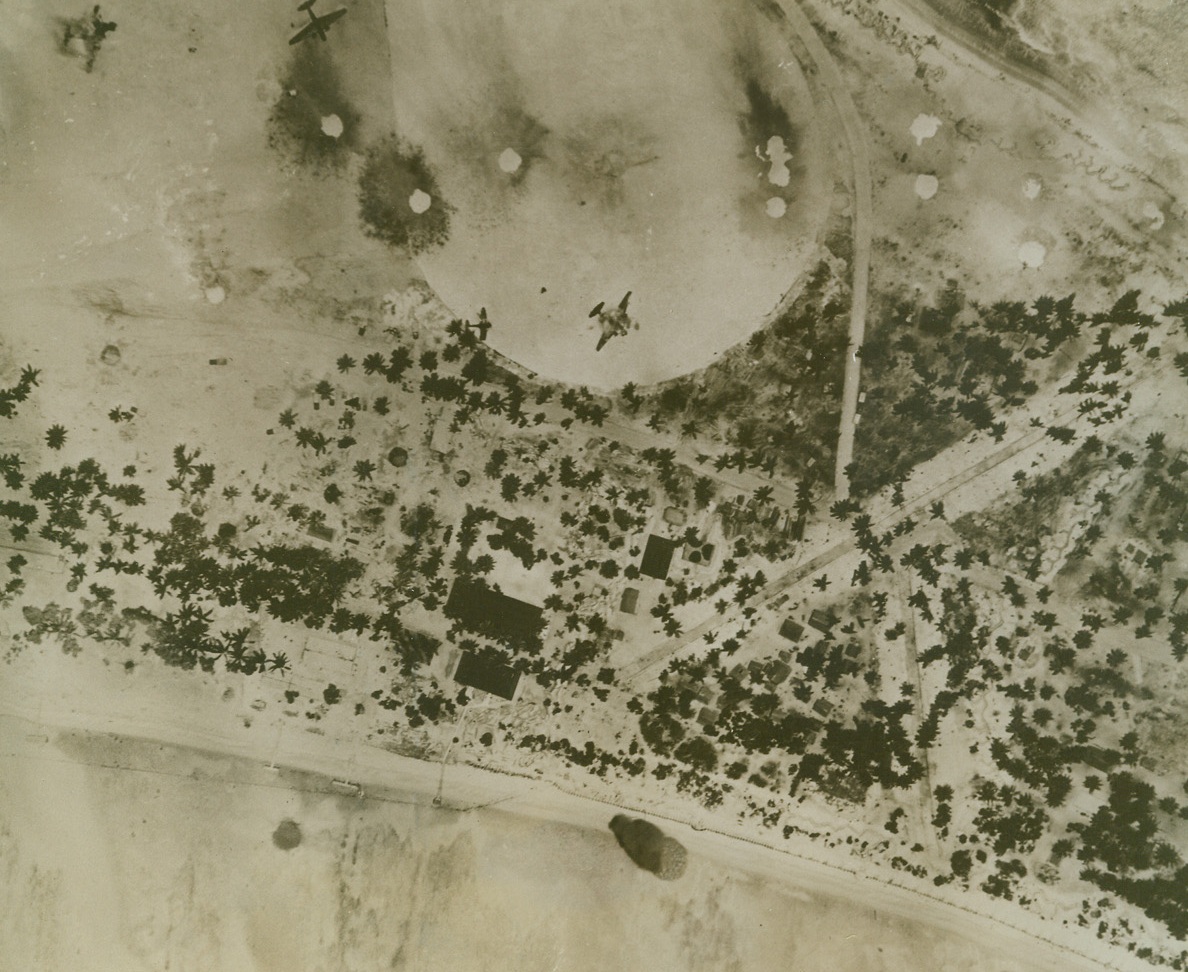
U.S. Troops Land on Tarawa, 11/21/1943. New York – Marines and Army troops, covered by forces of all types, established beachheads against moderate resistance at Makin island and strong resistance at Tarawa Island, according to a radio broadcast from Honolulu today. Above photo shows Army bombers blasting the Jap airfield at Tarawa, which is not very far from the large Jap naval base at Truk. Landings on the two Gilbert islands started Friday afternoon;
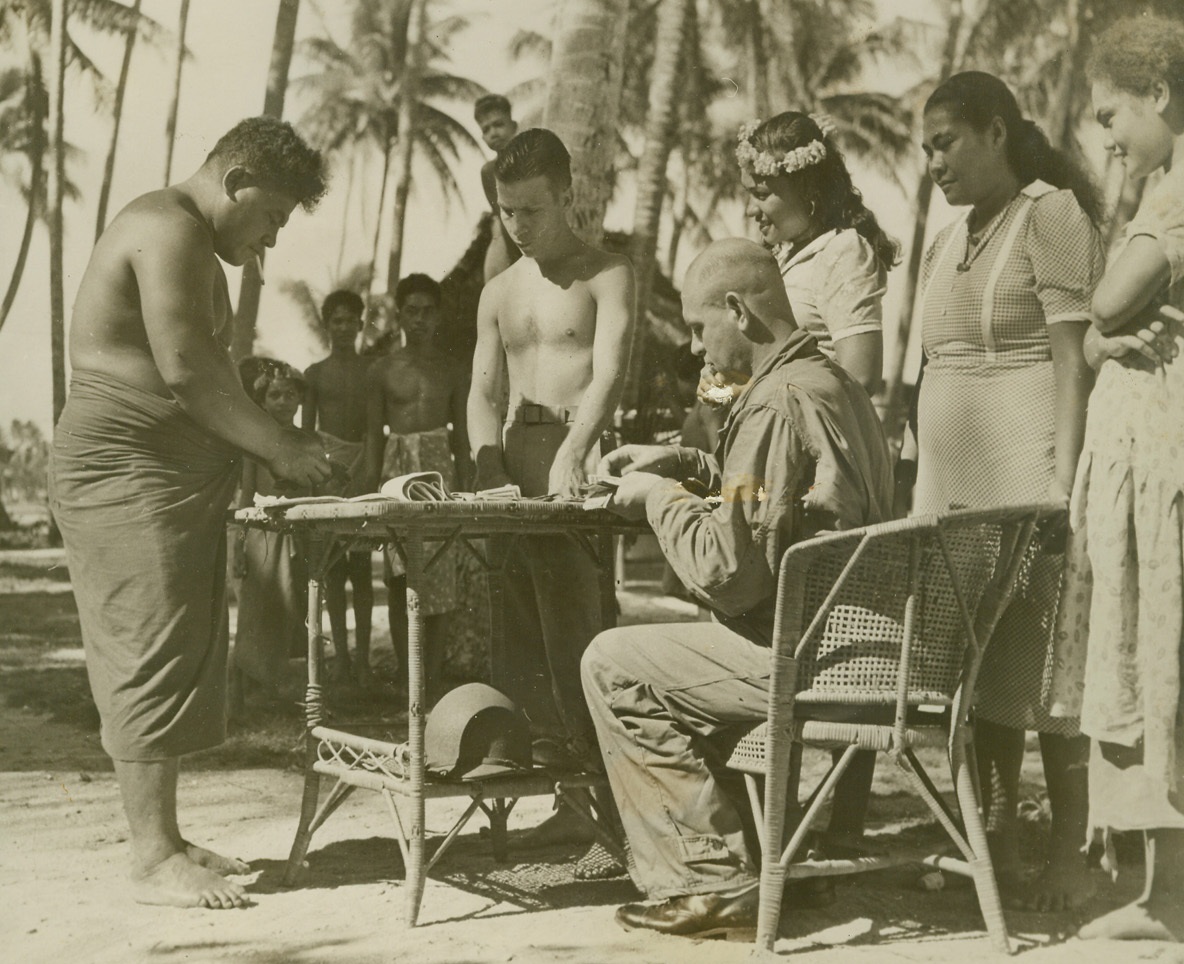
Pay-off Day, 11/26/1943. At a South Pacific Base – Lucky Marines at this South Pacific base don’t have any wash-day blues. Women of the island take care of the laundry problem for a mere $2.50 per month, per Marine. And here’s the payoff, Marine Gunner O.A. Powell settles his bill with 230 pound Noa (left) acting as an interpreter and Platoon Sgt. James G. Hayes (seated) of Donalsville, GA., supervising. Credit (U.S. Marine Corps photo from ACME);
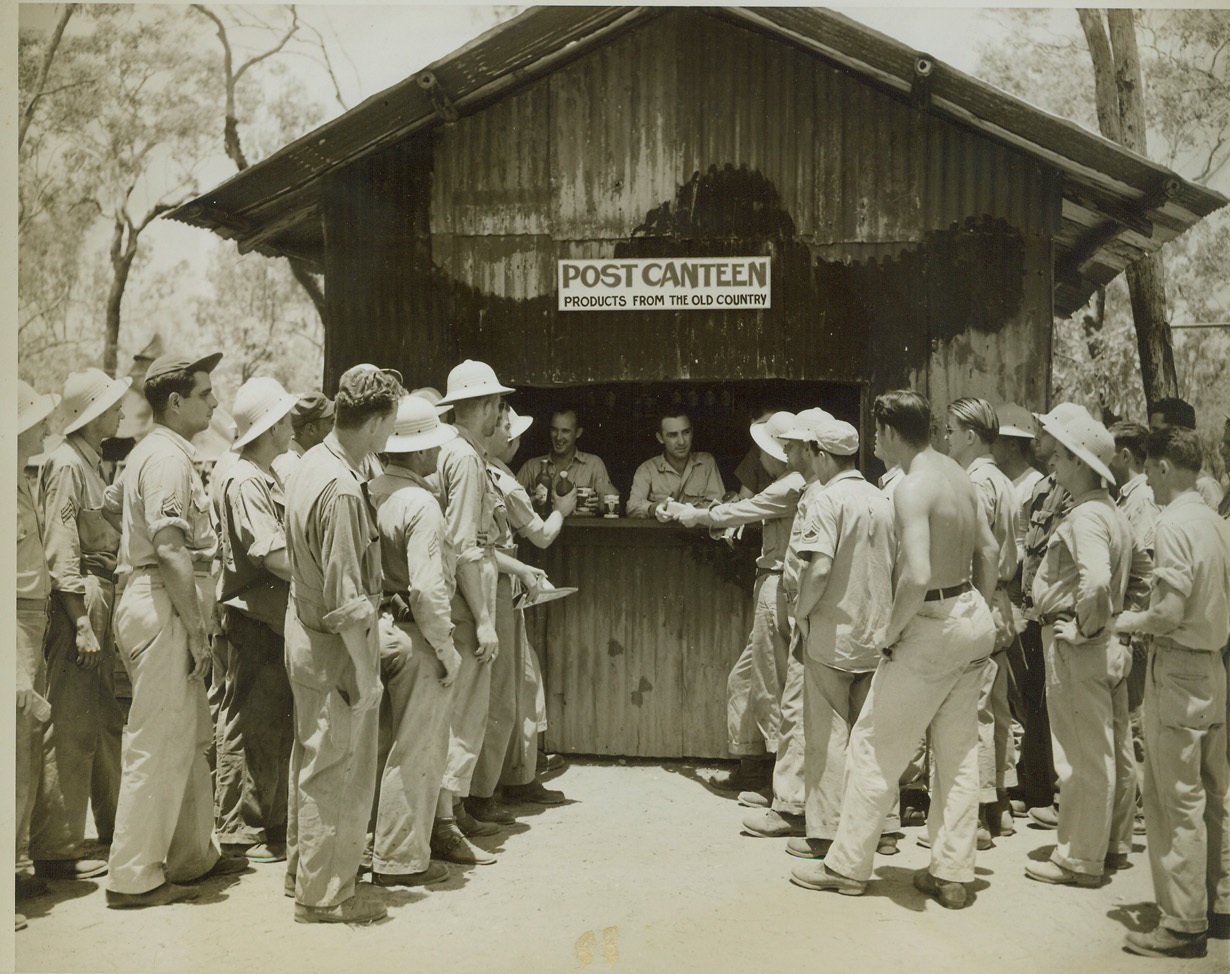
Afternoon Tea in Australia, 11/22/1943. AUSTRALIA -- This B24 Liberator Service Squadron's Post Office and Canteen is always one of the most popular places in Fenton, Australia. At the canteen counter are Sgt. Carroll Smith, of Fort Worth, Texas, canteen steward, and 2nd Lt. Melvin Freeman, of Chickasha, Okla., who is canteen officer. Credit: (ACME Photo by Thomas L. Shafer, War Pool Correspondent);
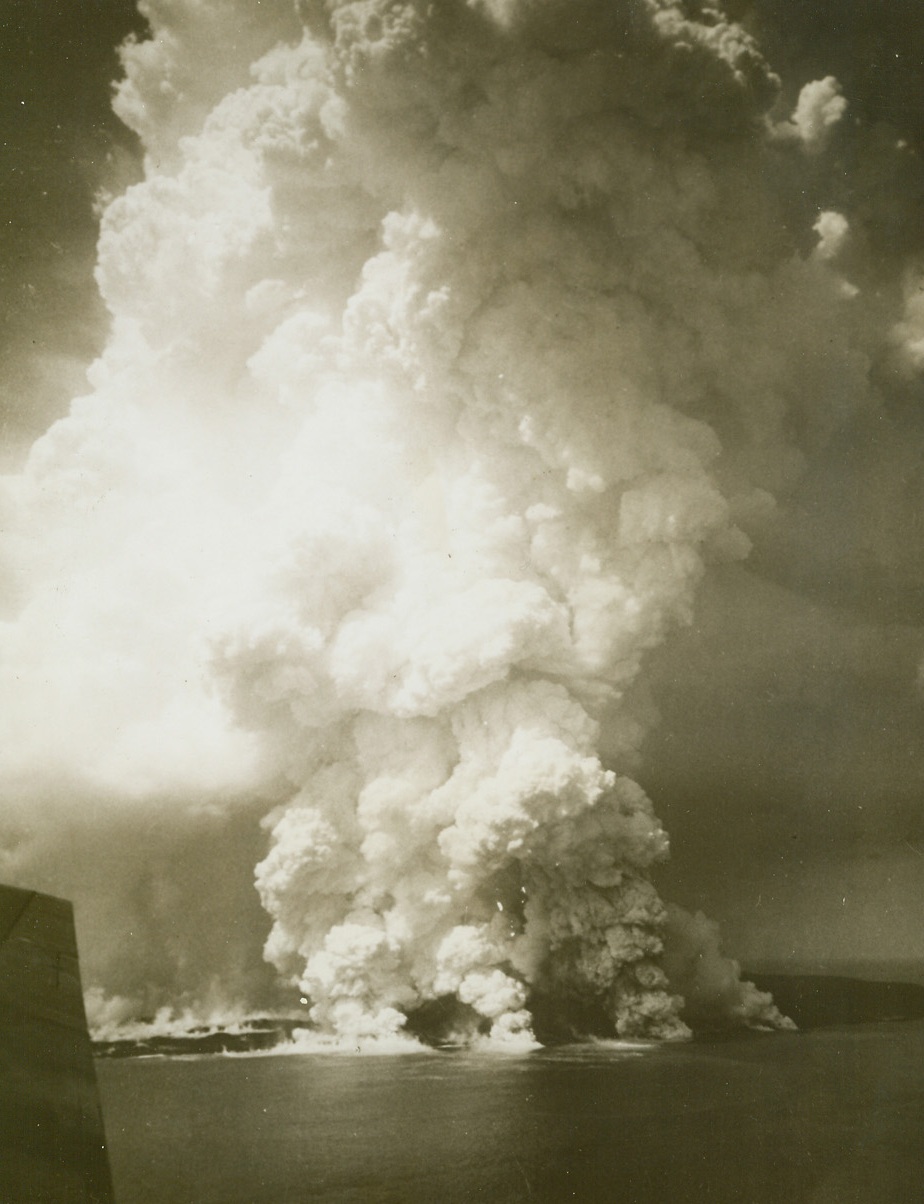
‘Tin Can’ Island Explodes, 11/30/1943. The volcanic island of Ninafou – known as ‘Tin Can’ – seems to surge upward in its entirety as a giant eruption convulses the tiny isley. This picture was made just as the towering pillar of smoke and lava rose up over the glassy Pacific by a Navy photographer.Credit Line is illegible;
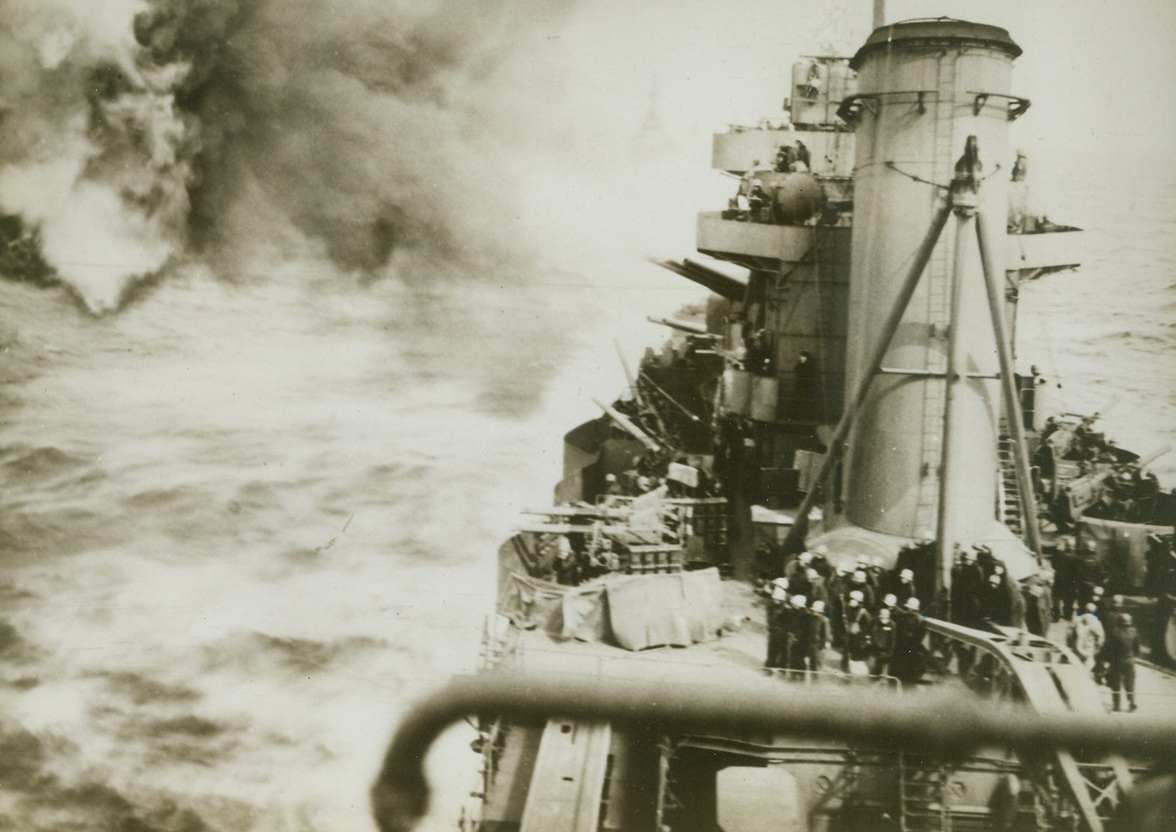
Voice of Authority, 11/16/1943. On the Pacific – The mighty guns of a U.S. cruiser roar with a tremendous voice of power and destruction as they blast enemy installations ashore, “somewhere in the Pacific”, as a prelude to landing operations.Credit Line (U.S. Navy photo from ACME);
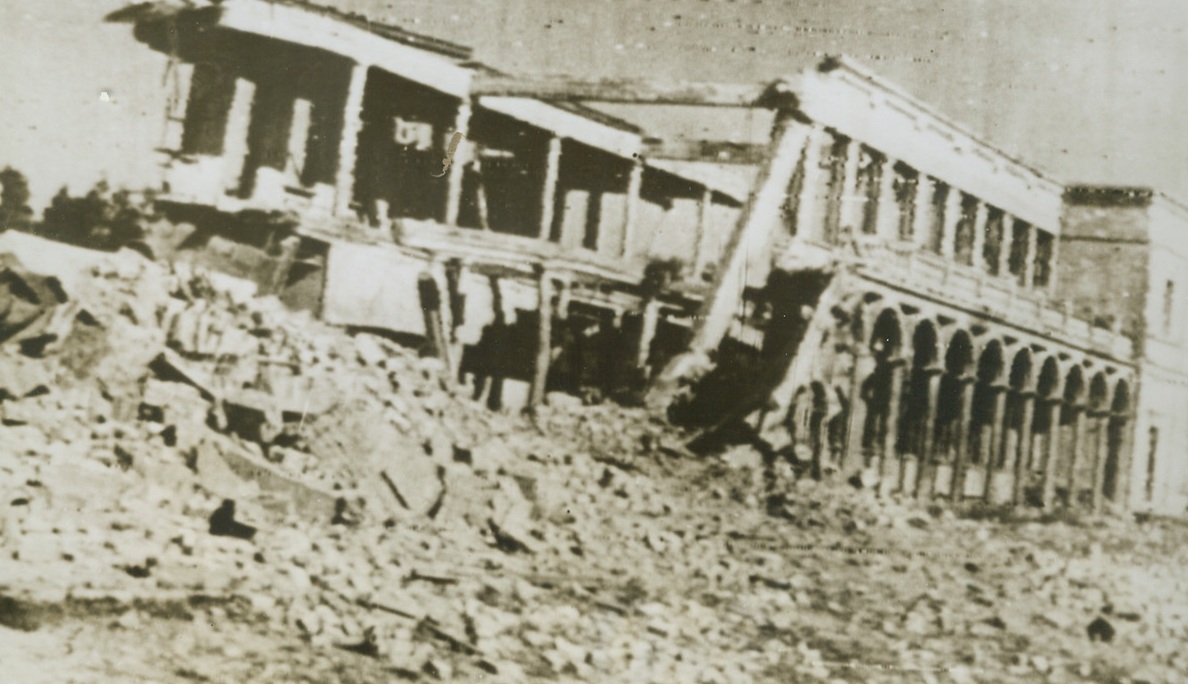
Nazis “Scorch Earth” in Ukraine, 11/5/1943. Russia – Retreating Germans destroyed this silk manufacturing center at Darnitsa, in the Kiev sector, to deprive the Soviets from a source of supply for parachutes. The Reds have now captured the last town barring a Northern attack on the Ukrainian capital of Kiev, and are closing in on the city in a wide arc from the North and West.Credit: ACME;
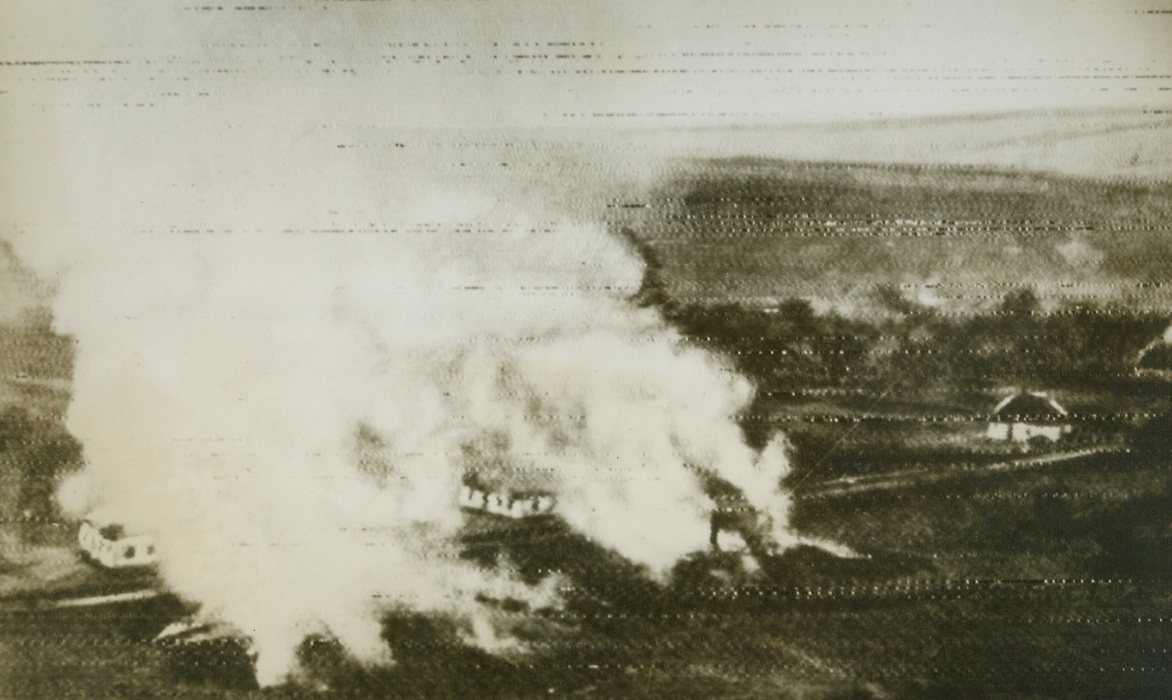
Nazis Still Using Scorched Earth Policy, 11/6/1943. RUSSIA—Before reorganizing their lines, the Nazis set this village ablaze in the Krivoi Rog district, in the Dnieper Bend. The Germans are believed to have withdrawn great numbers of troops from fallen Kiev to bolster their lines at Krivoi Rog, the still embattled city in southwest Russia.Credit: ACME;

Dimpled Partisan, 11/16/1943. Dimpled Dusya Pogrebna is a signaler for a detachment of Ukranian partisans, who waged relentless ambush warfare against the Nazis, fighting against great odds until the Red Army reached the Ukraine. A rifle slung across her shoulders, she’s ready to join her countrymen in another phase of their battle for freedom at a moment’s notice.Credit: ACME;
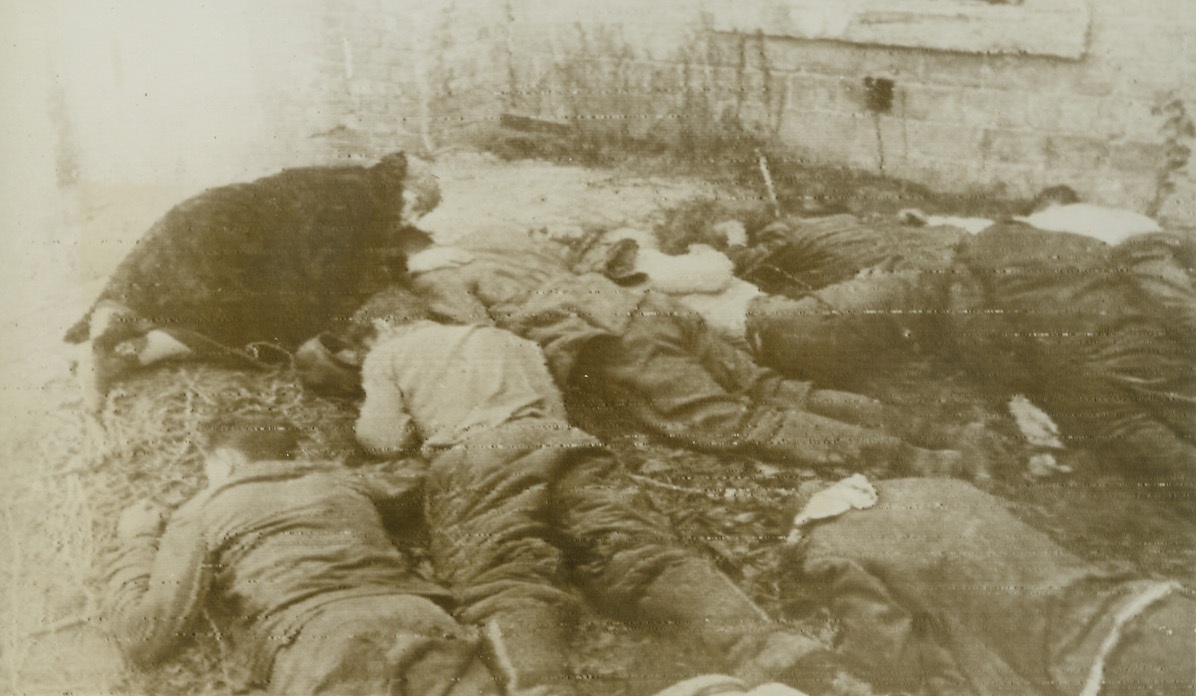
A Mother Mourns, 11/12/1943. Kiev, U.S.S.R. – Kneeling on the frozen ground and clasping the body of her dead son to her, a mother of Kiev mourns the death of her child, who was not alone in death. The youths shown here, lying with their faces to the ground, were among civilians shot by cold-blooded Nazis before the invaders were driven from Kiev.Credit: ACME Radiophoto;
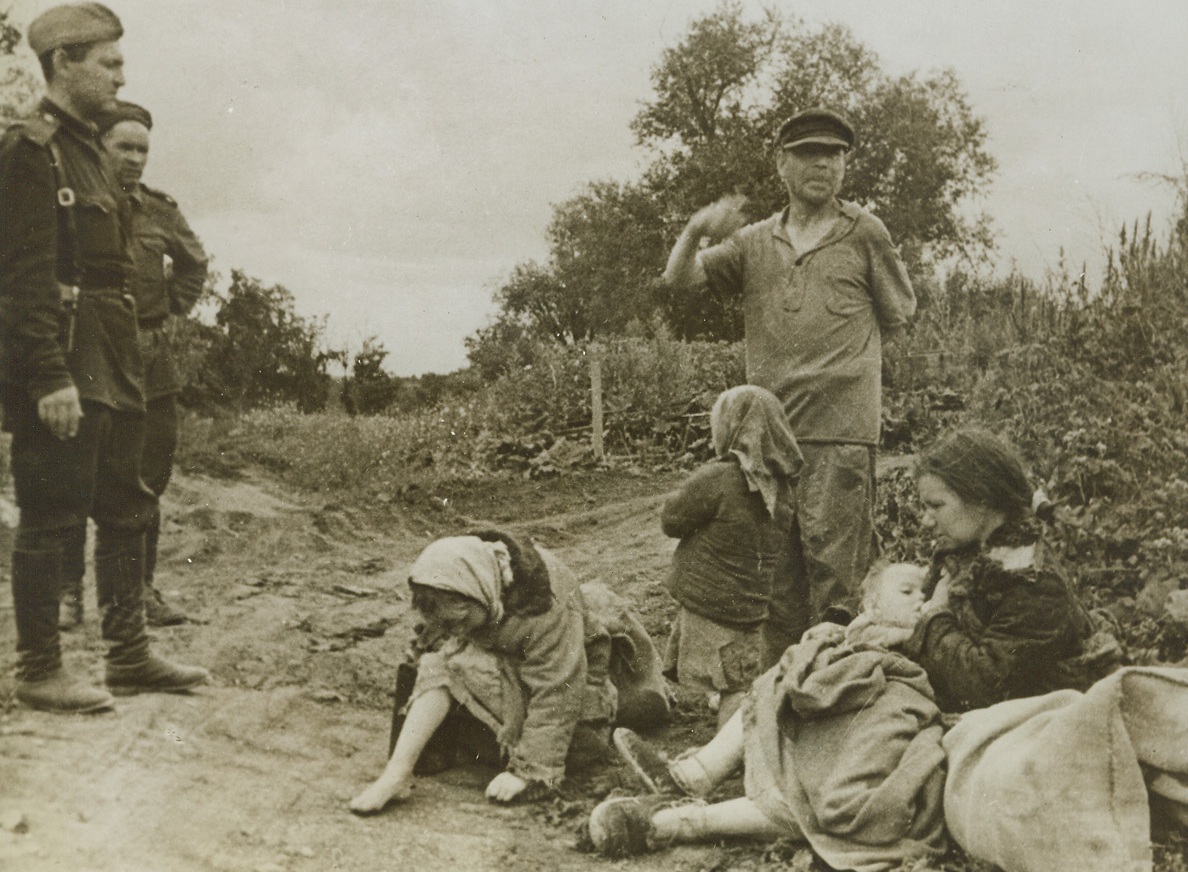
After Germans Despoiled Their Farm, Orel, Russia – Two Red soldiers, listen sympathetically as Ivan Merkulov, (standing at right), a worker on the Volkovo State Farm in the Orel Region, tells how the farm was plundered, and how his family, (at his feet), were harried by the Germans before they were forced into retreat in the region by Soviet forces. Her face mirroring sadness as she listens to the story, the farmer’s wife, (right), nurses her baby. (Passed by Censors).Credit: ACME;
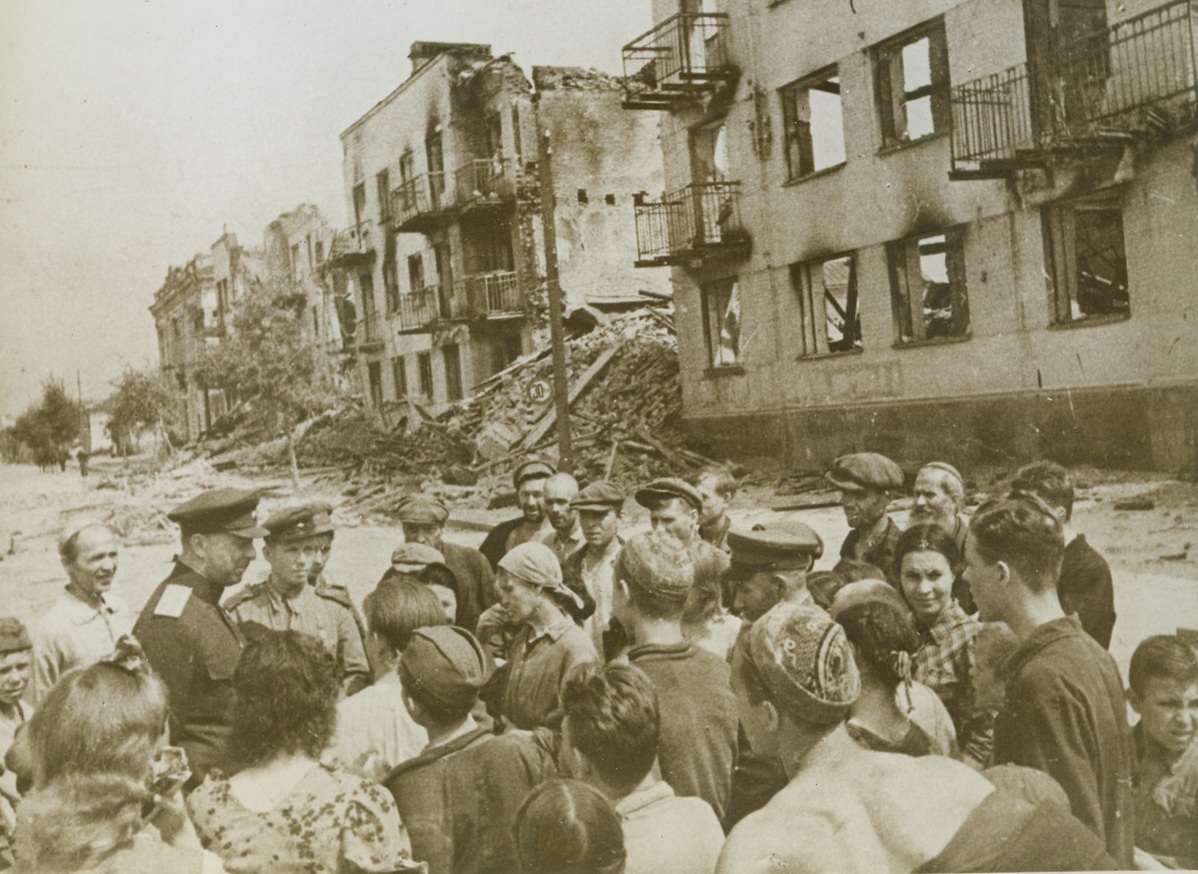
After Nazi “Locusts” Passed, 11/10/1943. OREL, RUSSIA—A Soviet General talks with residents of Orel, who had returned to the gaunt, fire-blackened skeletons of what had been their homes after the retreating Germans had abandoned the city. Passed by censors. Credit: ACME;
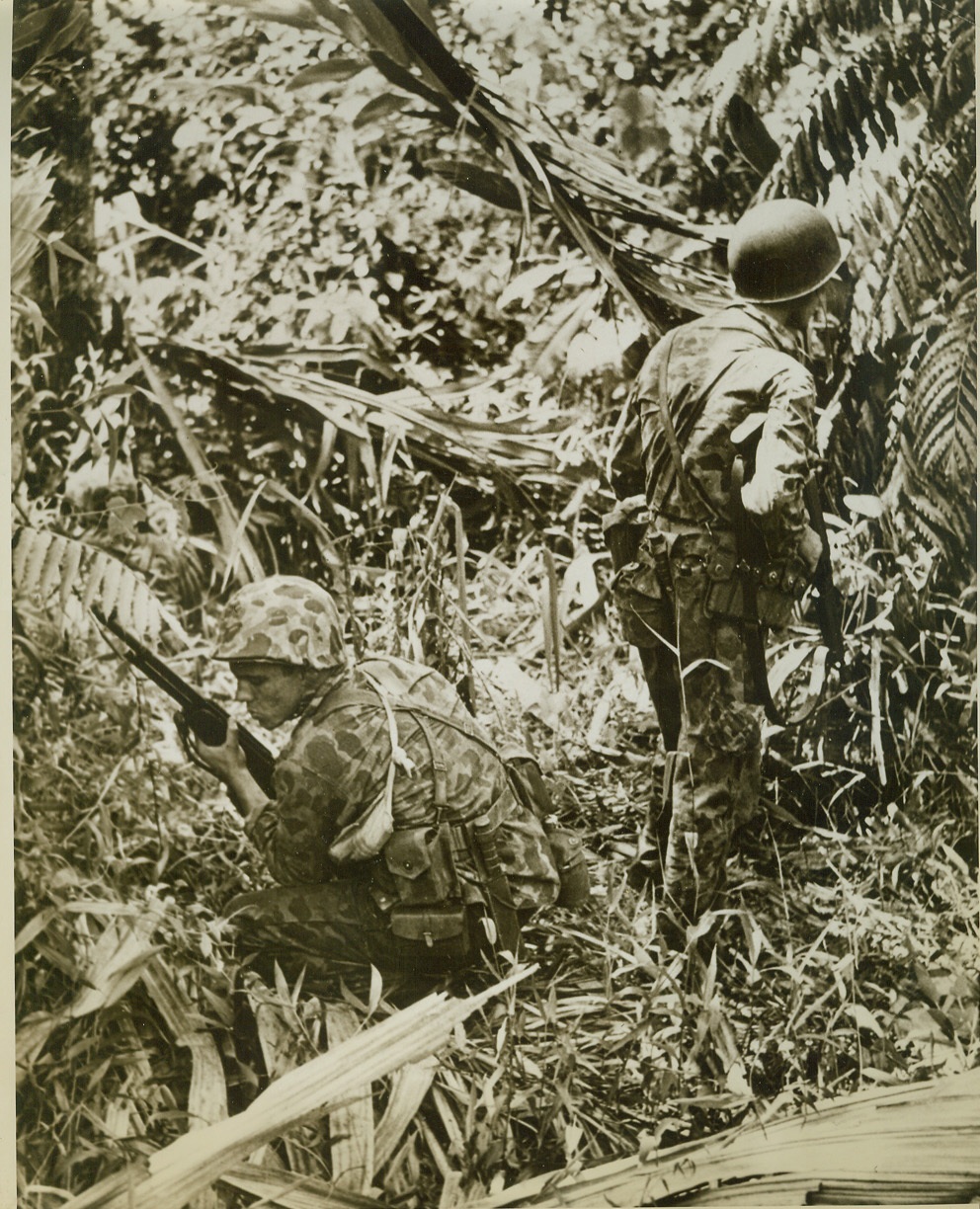
Part of the Jungle, 11/22/1943. SOUTH PACIFIC -- A pair of Marines fervently hope that they are indistinguishable from jungle foliage as one looks one way, and the other searches in the opposite direction, for a Jap sniper on Bougainville who apparently is a well-hidden as they are. With rifles "on the ready", they crouch at the side of a jungle trail. Credit: (ACME);
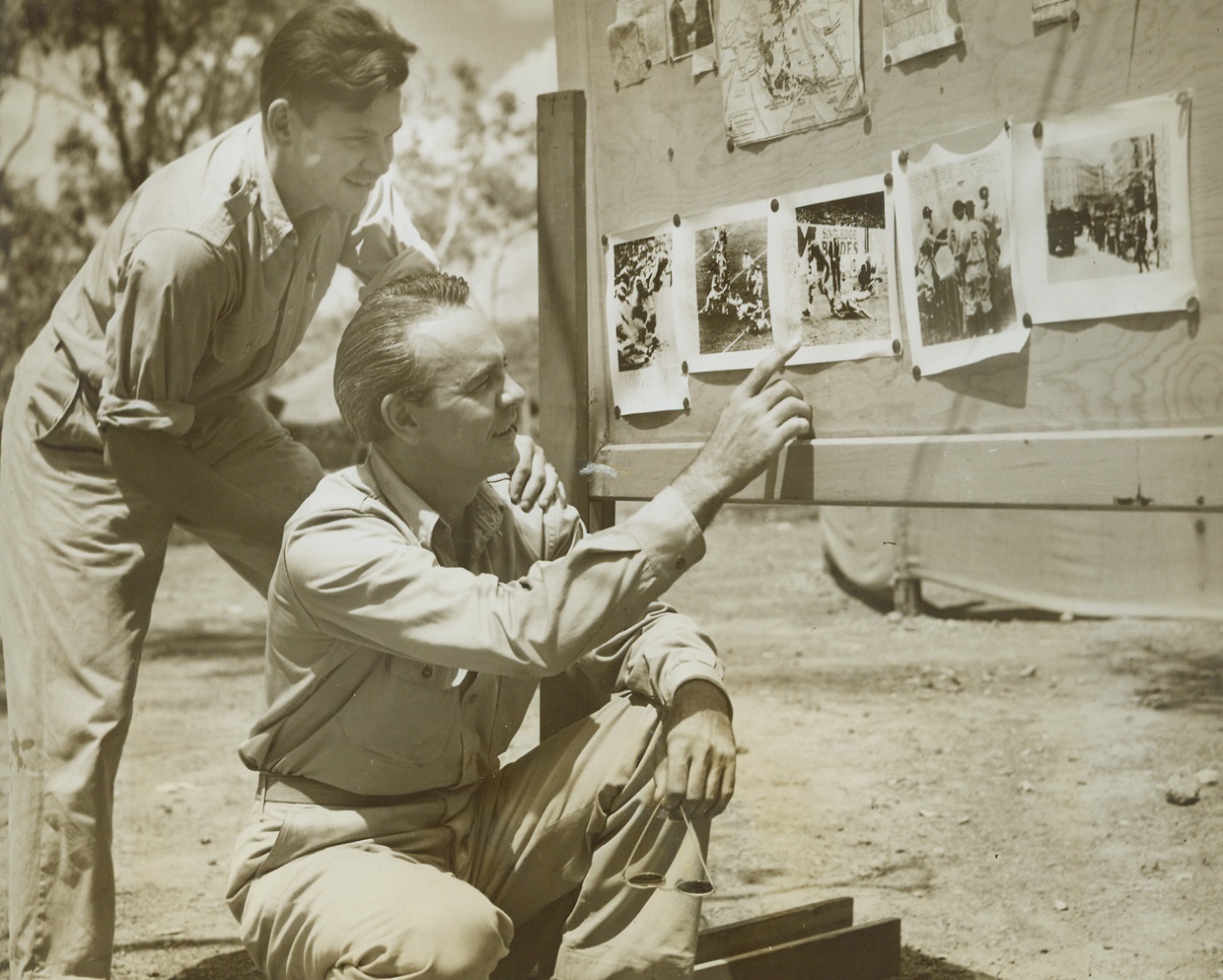
When Reconnaissance is a Pleasure, 11/22/1943. Australia – First Lieut. James J. Goetz, of Chicago, Ill., group photo interpreting officer (right), really puts in some expert opinions as he “interprets” world series and football telephoto pictures for Major Howard K. Williams, of Salt Lake City, Ground Executive Officer of an American B24 bombing group. The pictures were received over the ACME telephoto machine, used by the Signal Corps in Australia. Credit line (ACME photo by Thomas L. Shafer, War Picture Pool correspondent);
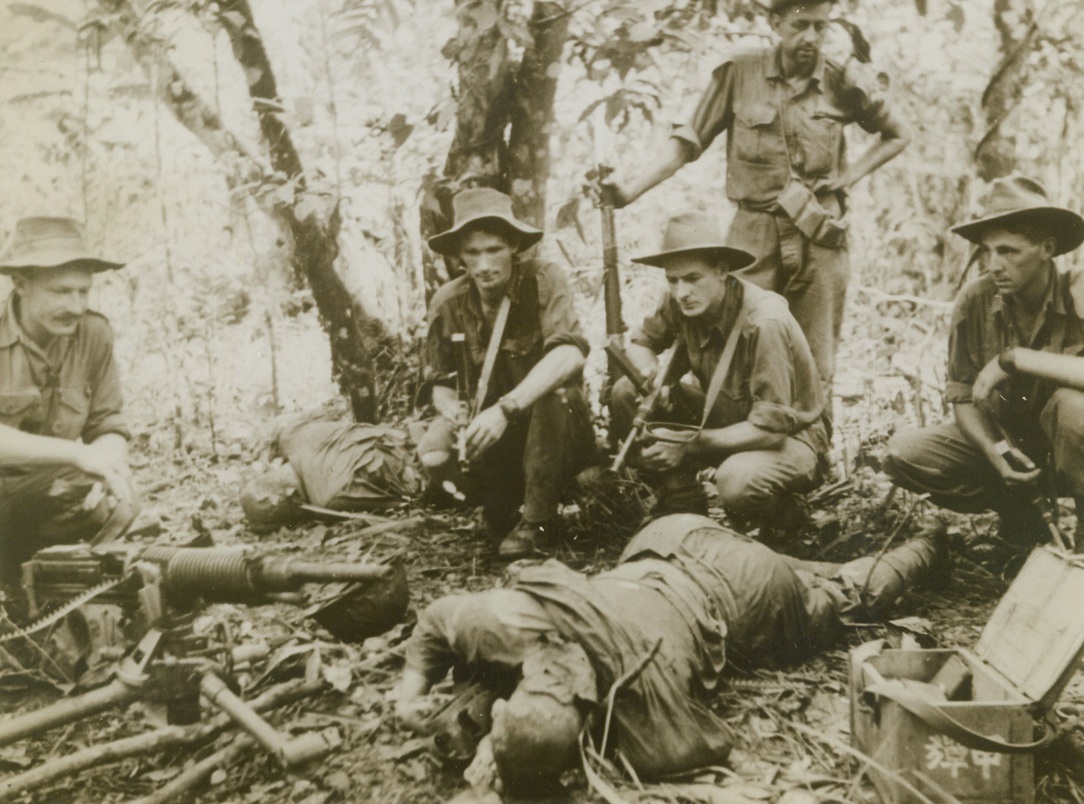
Jap Gun Nest Blitzed, 11/22/1943. New Guinea – An Australian patrol wiped out this Jap forward machine gun post during the advance along the Upper Ramu Valley. Here members of the patrol examine the erstwhile enemy gun nest. Note Jap letters on case at right. Credit line (ACME);

“A Phony Hero”, 11/23/1943. Newark, N.J. – No longer can Abe Levey, 28, of San Antonio, Texas, boast about how he killed 62 Japs at Kiska and was personally decorated by President Roosevelt, for the self-styled hero has been jailed by the FBI as impersonating an officer. “A Phony Hero”, says the FBI, speaking of Levey who was given a medical discharged from the Army last Summer in Denver, Colo., where he so impressed a medical officer that the reason for his release was listed as due to wounds from the Kiska fighting. Actually, the “bayonet” soars were received in childhood. Credit line (ACME);

Tiny But Brave, 11/22/1943. Africa – Pvt. Margaret H. Maloney, of Rochester, N.Y., who is so tiny her nickname is “Pee Wee,” receives the soldier’s medal from Major Gen. R.S. Hughes, Deputy Theater Commander, for saving the life of Pvt. Kenneth M. Jacobs, of York, Pa., whose clothes caught fire from spilled gasoline. Pvt. Maloney beat out the flames with her bare hands, and was hospitalized for six weeks. She is the first WAC to receive the soldier’s medal and as a result, the General kissed her.Credit (U.S. Army Signal Corps radio telephoto);

Wood and Canvas Barges to Carry 200 tons, 11/1/1943. Alexandria, Egypt – With materials sent from America, local labor at Alexandria fashions a new type of naval lighter, constructed entirely of wood and canvas. The flat-bottomed barge will carry 200 tons of cargo. Credit line (ACME);
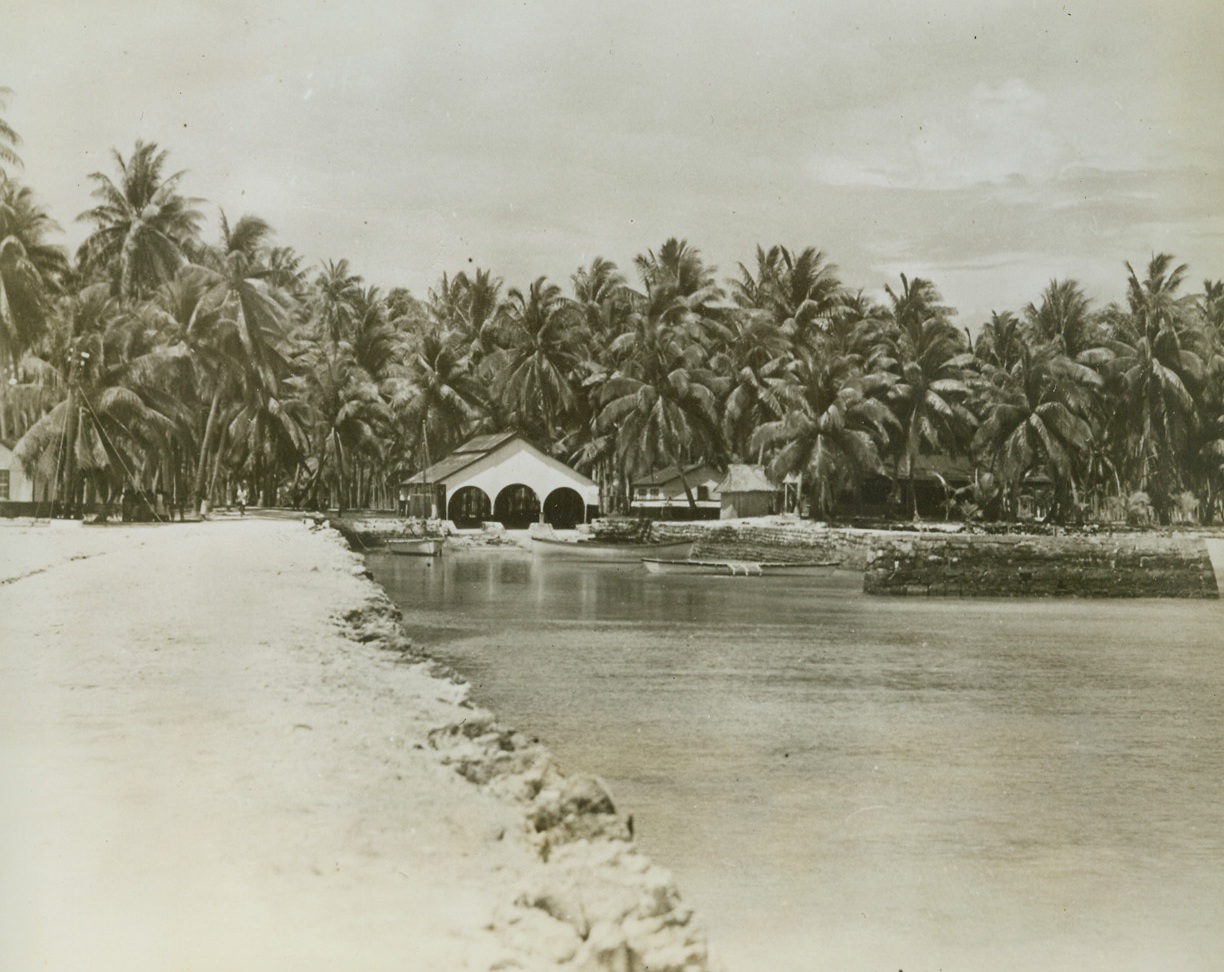
Tarawa’s Capture Assured, 11/23/1943. Washington, D.C. - - This photo, released by the Navy department today, shows the harbor at Tarawa in the Gilbert islands where, it was announced today, U.S. Marines have consolidated their position and their capture of the Atoll is “assured”. Also, it was stated that U.S. Army troops of the 27th division had captured Makin, in the same group. Credit line (U.S. Navy official photo from ACME);
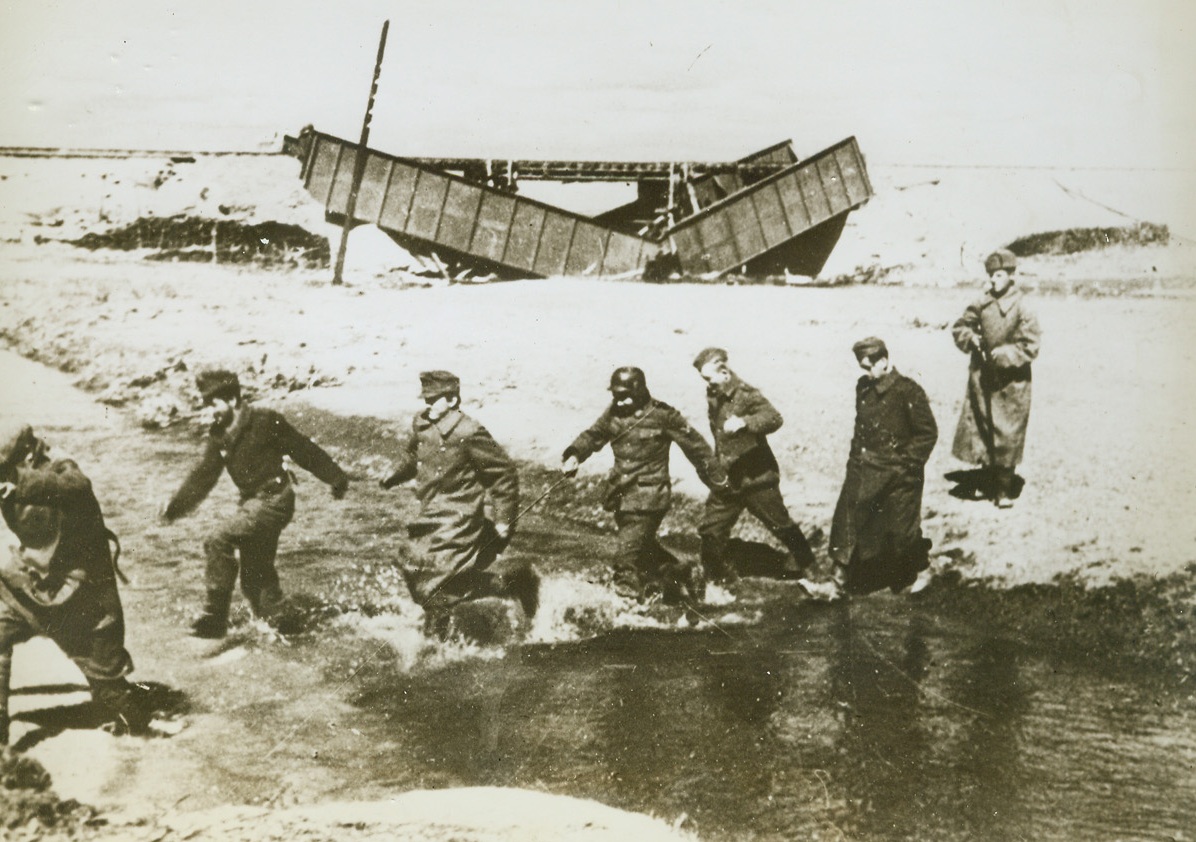
On the Double, 11/21/1943. Somewhere in Russia—A single Red Army man is all that’s needed to keep these captured Nazis hopping. Captured on the Russian front, the Germans dash past a damaged railway bridge and through a stream to join their comrades at a nearby prison camp. Their lines cracking and their spirit failing in the face of the Soviet offensive, thousands of Nazis are abandoning their arms, tanks and guns and going into captivity. Credit: ACME.;
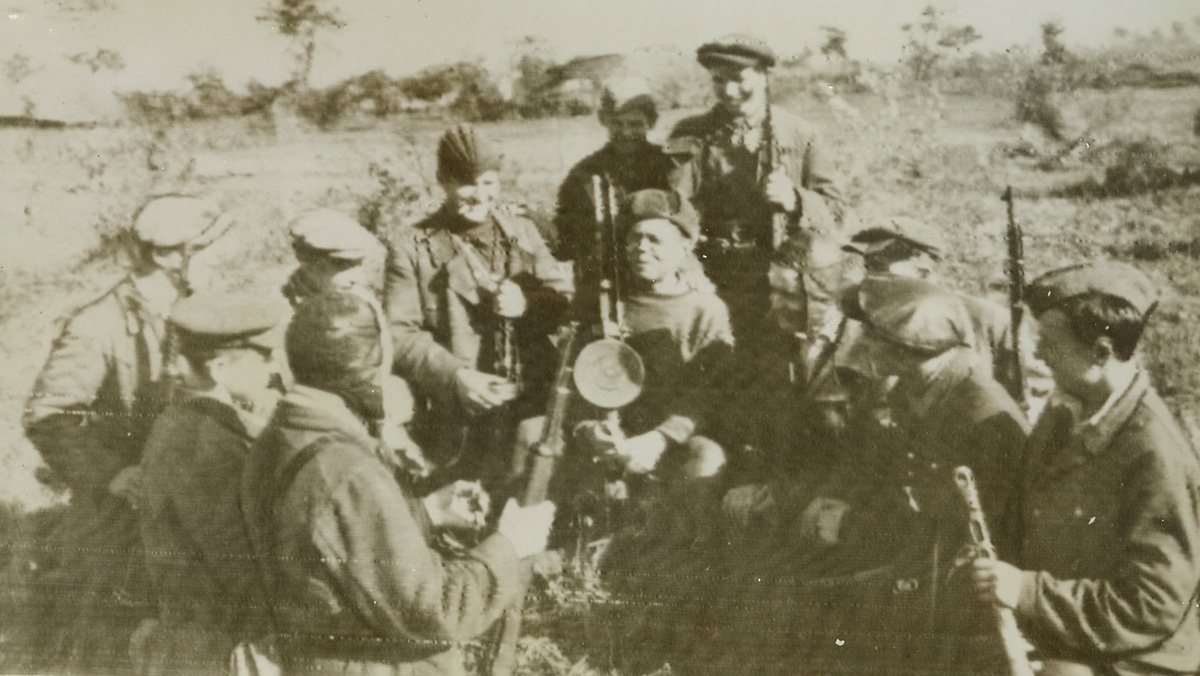
Nazi Haters, 11/16/1943. A group of Nazi-hating Ukranian partisans, who made life miserable for Hitler’s men before the Red Army entered the Ukraine to finish the job, halt in a field for a well-earned rest. Holding their weapons, they sit in a circle and chat before taking up the battle with the foe again. Credit: ACME radiophoto.;
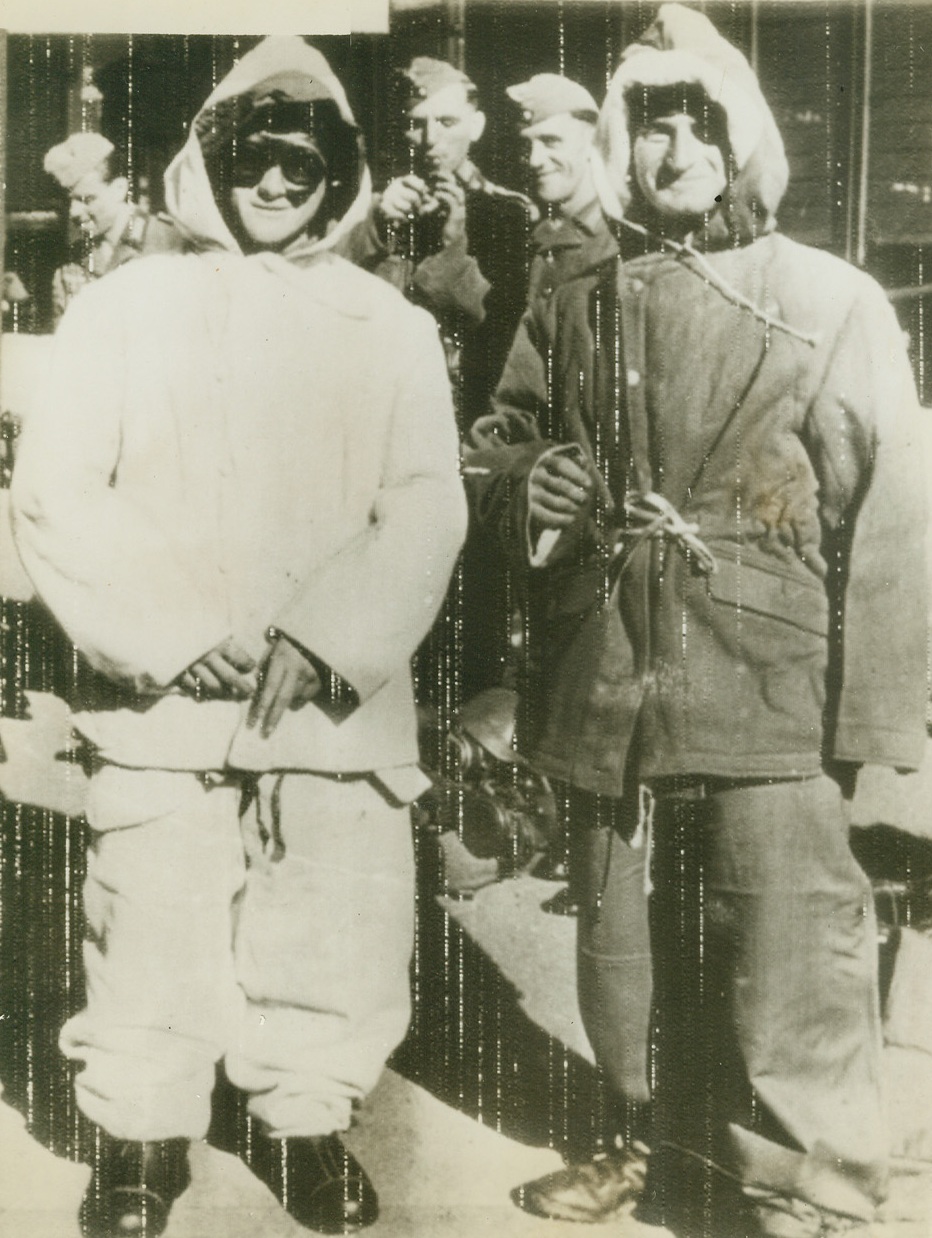
All-Purpose Nazi Uniform, 11/1/1943. Russia—Photo radioed this morning from Stockholm shows two Nazi soldiers posing in new winter uniform which German caption said was designed from experience of past two winters in Russia. It is reversible—one side white for snowy territory and the other brown for muddy ground—which is claimed good camouflage. Bulky uniform, besides being warm, might also have been designed to stop Nazi army from running away so fast. Credit: ACME radiophoto.;
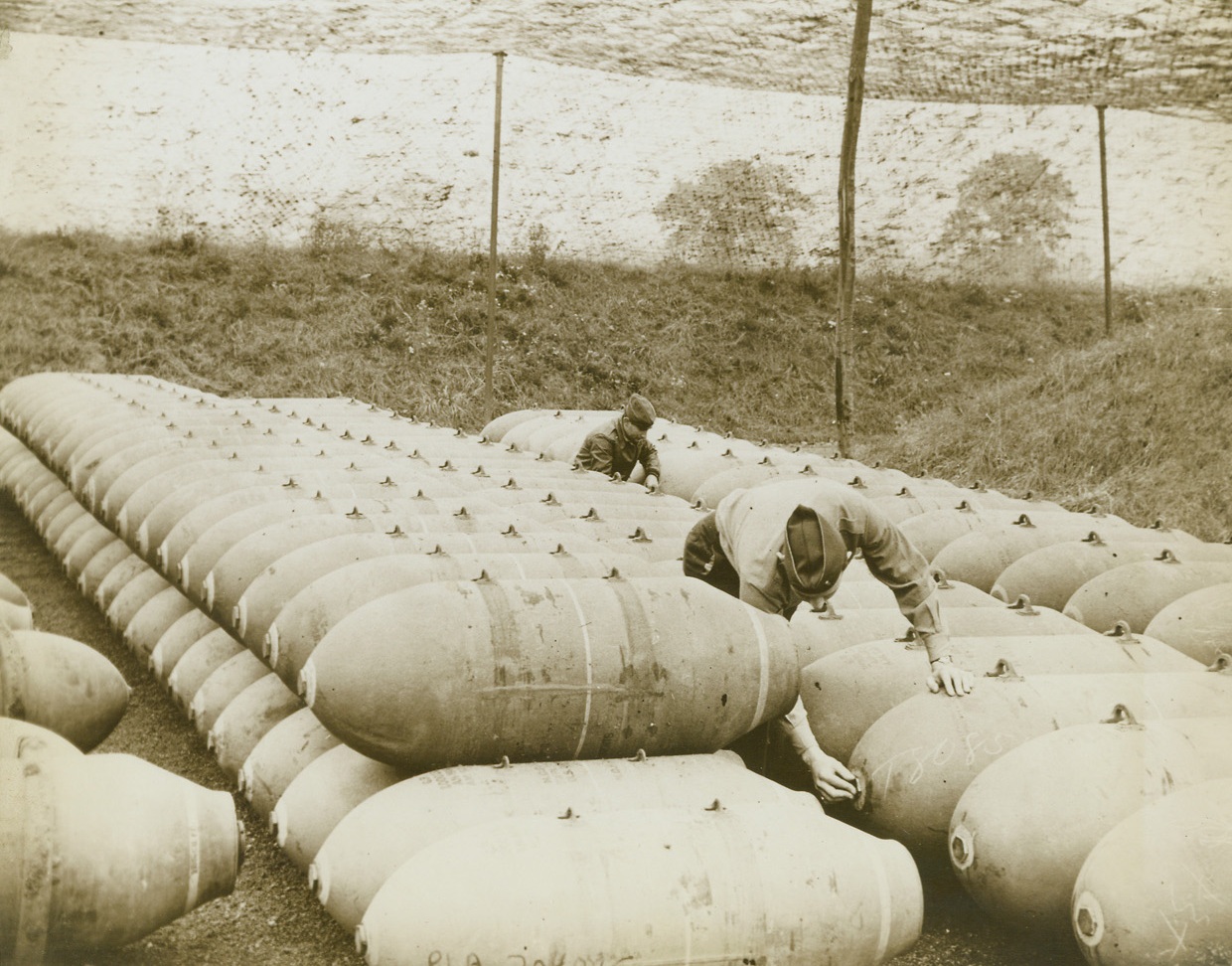
Ready for Delivery, 11/21/1943. Somewhere in England—These big babies, 1000 and 2000 pound bombs stacked in a supply dump somewhere in England, are destined for delivery over targets in France, Germany and Belgium. Combining their efforts to flatten Hitler’s Europe, bombers of the RAF and the US Army Air Forces have sent millions of tons of destruction down upon the continent. As many as 6000 tons have been dropped within a 48 hour period. Credit: ACME.;
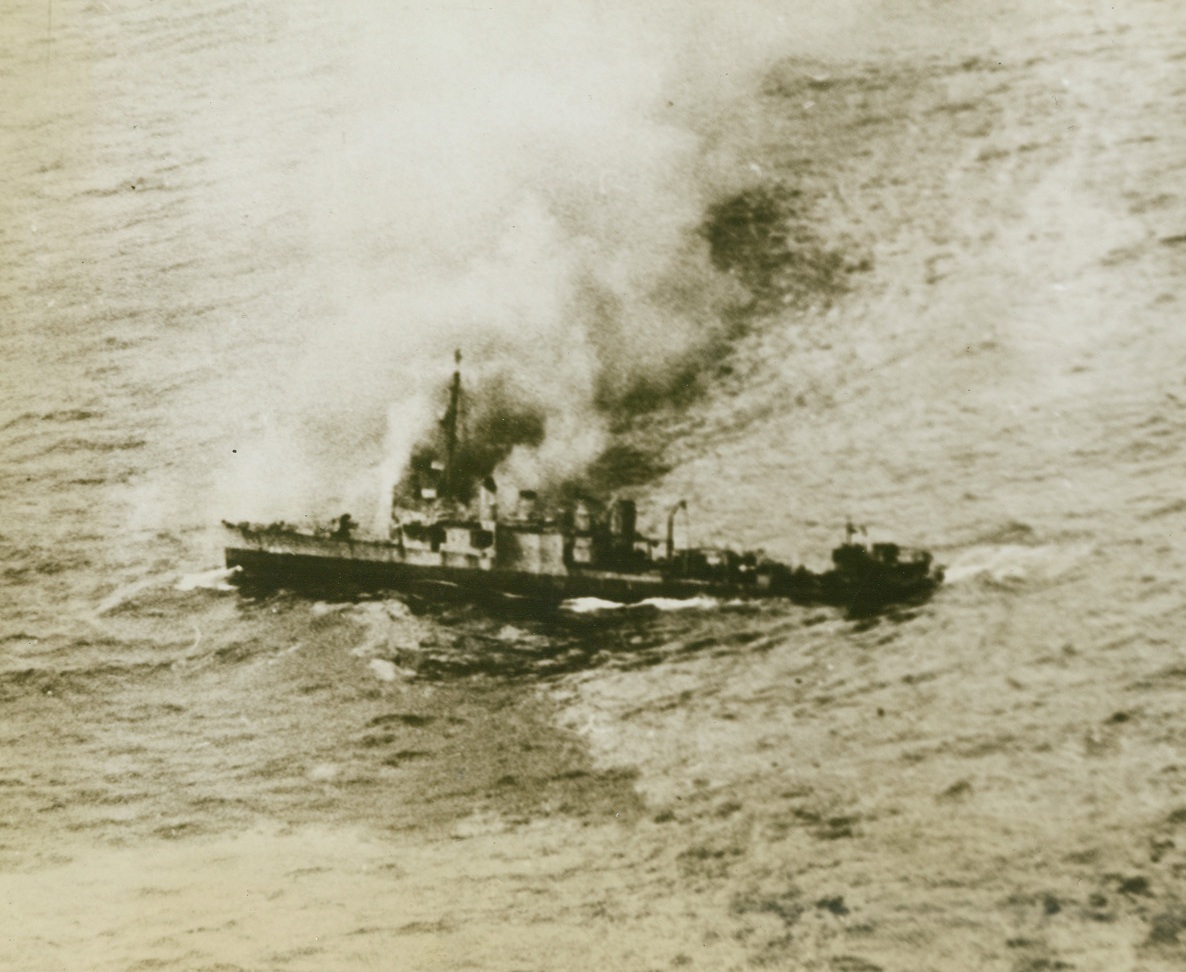
A Gallant Fighter Goes Down, 11/16/1943. On the Atlantic—Smoking badly from internal fires, listing badly and down by the stern, the gallant old four-stacker destroyer, USS Borie, is shown just before she was sunk by torpedo bombers from the escort aircraft carrier USS Card. The Borie, the day before had blasted one Nazi sub to the bottom, while acting as an escort to the Card, and then rammed a second enemy U-Boat. The collision opened her seams and, the next day, her skipper, Lt. (now Lt. Comdr.) C.H. Hutchins gave the order to abandon ship. Credit: U.S. Navy official photo from ACME.;
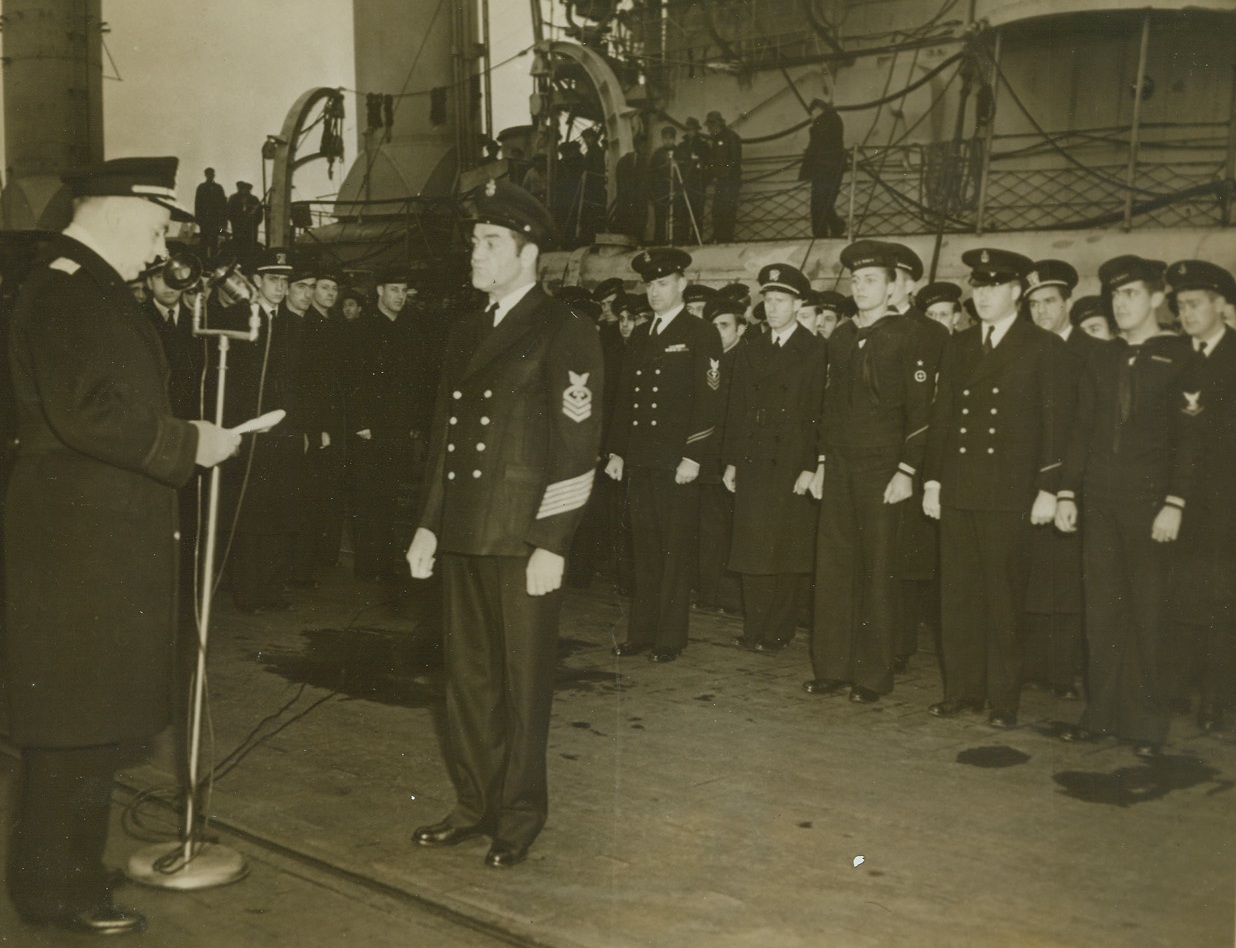
Honored for “Extraordinary Heroism”, 11/22/1943. Chief Water Tender James William Daughtery of Abilene, Texas, stands at attention as the citation awarded him the Navy Cross is read. Daughtery’s ship, a destroyer (seen in background) was struck by an aerial bomb at Palermo last August, and badly damaged. “With complete disregard for his own safety (he) cut away a blackout curtain and entered a fire room and assisted the trapped men there to safety.” Read Admiral Monroe Kelly, USN, presented the medal.Credit: Official US Navy photo from ACME.;
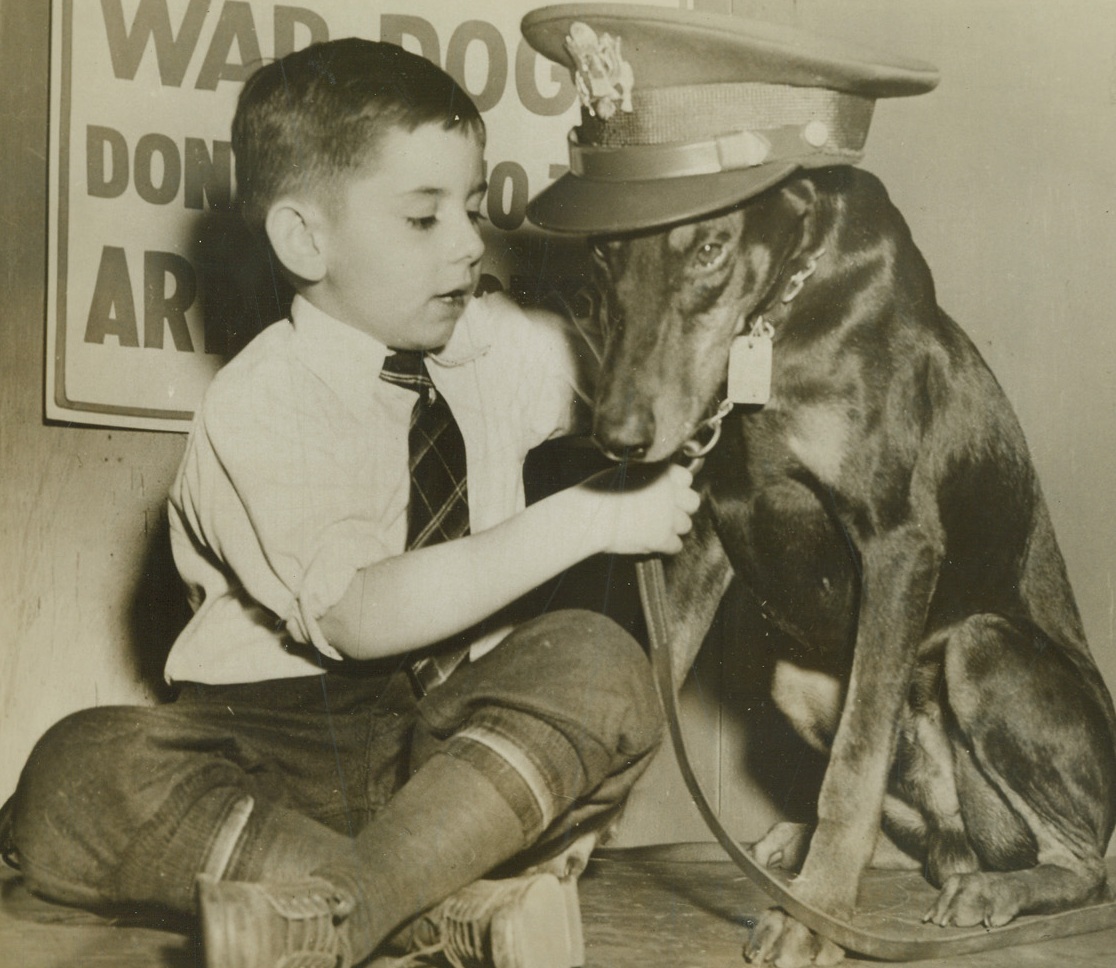
So Long Soldier, and Good Luck . . . 11/22/1943. Philadelphia, Pa.—6-year-old Robert Murray finds it hard to say goodbye to his 18-months-old Doberman Pinscher “Baron,” but “Baron” must go as he has joined the canine branch of warfare by becoming a member of “Dogs for Defense.” Robert bravely says his “so long and good luck” and hopes for a speedy end to hostilities, so that “Baron” can come marching home again.Credit: ACME.;
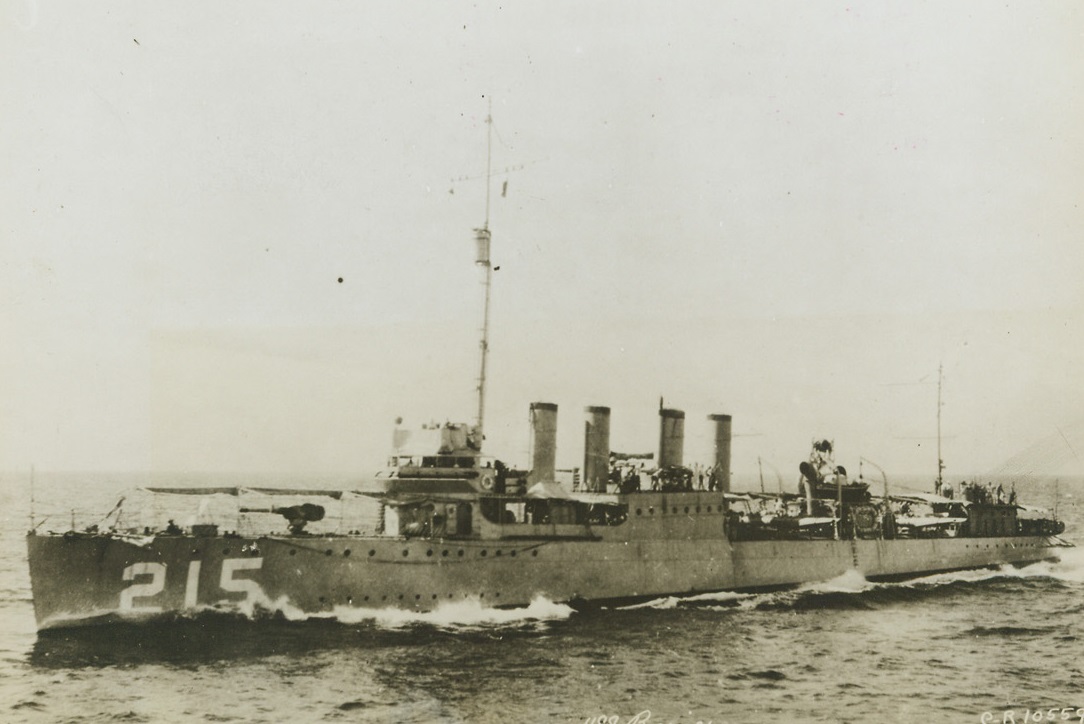
Destroyer “Borie” Sinks in the Atlantic, 11/10/1943. Washington, D.C.—The Navy Department today (Nov. 10th) announced the loss of three destroyers, among them the 190-ton Borie, an old World War I four-stacker. The vessel received mortal wounds as the result of ramming and sinking a German submarine in the Atlantic, and finally had to be sunk by an American carrier bombing planes. Credit: ACME.;
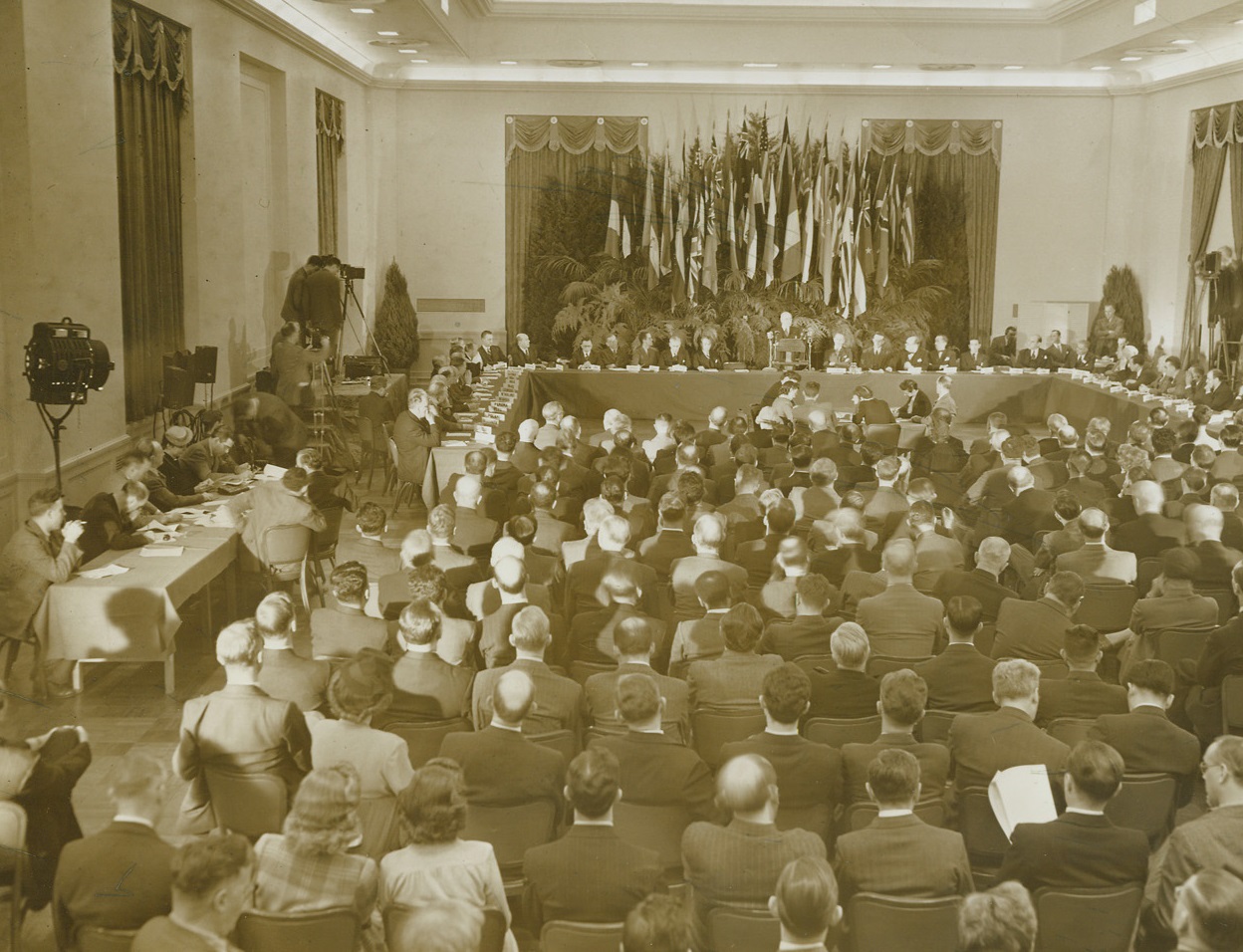
Unanimously Elected, 11/12/1943. ATLANTIC CITY, N.J. - The United Nations Relief and Rehabilitation Conference unanimously elected former Governor Herbert H. Lehman of New York as Director General of the Conference. Here is a general view at the Hotel Claridge in Atlantic City as Lehman spoke to delegates. In a speech today he promised people of Axis-occupied countries a diet of 2,000 calories a day as soon as Allied armies took over.;

SUNK IN MEDITERRANEAN, 11/13/1943. WASHINGTON, D.C.—As a result of enemy aircraft action, the American Destroyer, U.S.S. Beatty (shown above) was sunk in the Mediterranean on November 6th. The vessel was commanded by Lt. Comdr. William Outerson, who was reported among the survivors. Credit Line (Official U.S. Navy Photo from ACME);
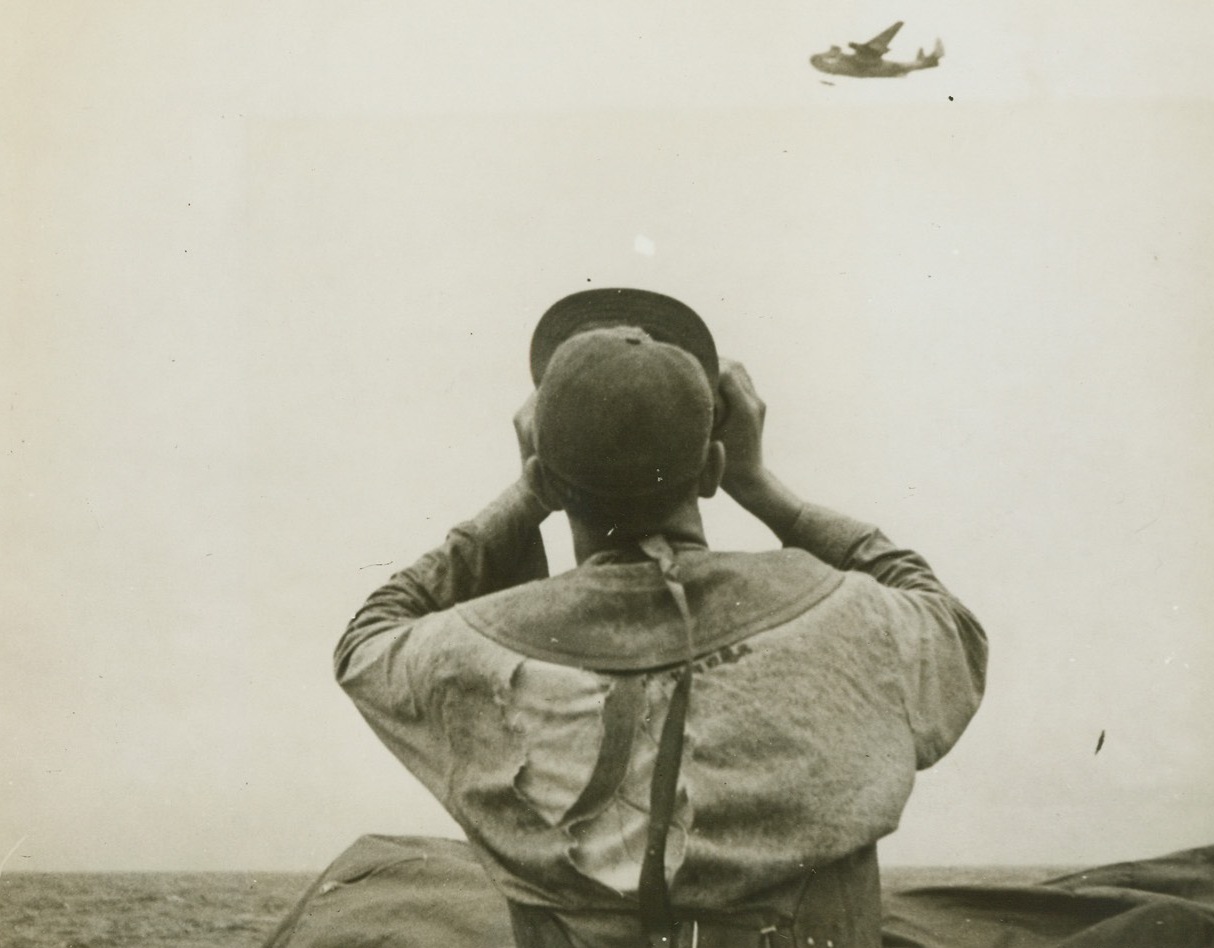
Story of a Rescue, 11/25/1943. At Sea - This is the story of a rescue at sea - the story of a U.S. Navy Catalina Patrol Bomber crew, forced down by mechanical trouble on a flight out of a Panama base, who spent two days adrift before help came. The photos were made by a member of the crew, Lt. (jg) F. J. Whiteside, USNR, who recorded the experience with his camera, never knowing whether or not he’d live to see the pictures. Help comes at last! AOM Third Class O. H. Wells, his eyes glued to his glasses, catches the wave of the pilot of a sister Patrol Plane as it circles above the drifting survivors and swoops low to message “Help Coming”. Soon a Tanker picked up the men and sank their ill-fated plane. Credit: Official U.S. Navy photo from ACME;
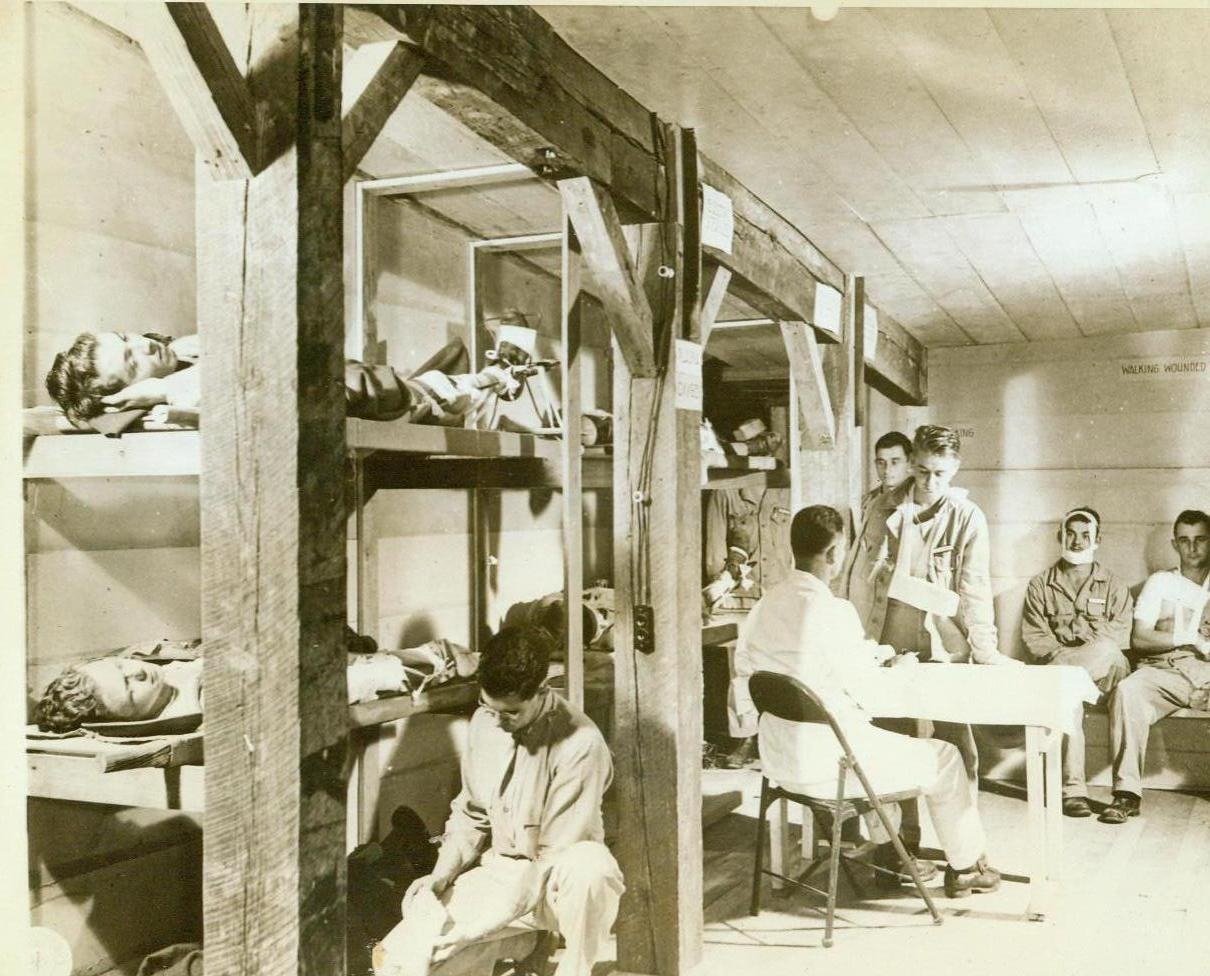
Underground ward, 11/19/1943. CAMP ROBINSON, ARK. – Here is a view of one of the wards of a 3-ward underground hospital that has been carved out of sandstone and solid rock at Camp Robinson. Complete with X-ray equipment and operating facilities, the hospital can be built in the field, under combat conditions, in 24 hours. Simulated casualties are shown undergoing treatment in the hospital. CREDIT LINE (Official U.S. Army photo from ACME) 11-19-43;

SAID THE LOOIE TO THE COLONEL, 11/4/1943. SOMEWHERE IN ENGLAND – Their hands expressing the story, Lt. Col. Jock Jenkins (in cockpit), listens to the story of Lt. Russell F. Guske, of Port Huron, Mich., holder of an air medal with three oak leaf clusters, and the DFC. The lieutenant was awarded the decorations for participating in 46 sorties, the destruction of one enemy aircraft, and probable destruction of seven others. Credit: Acme;
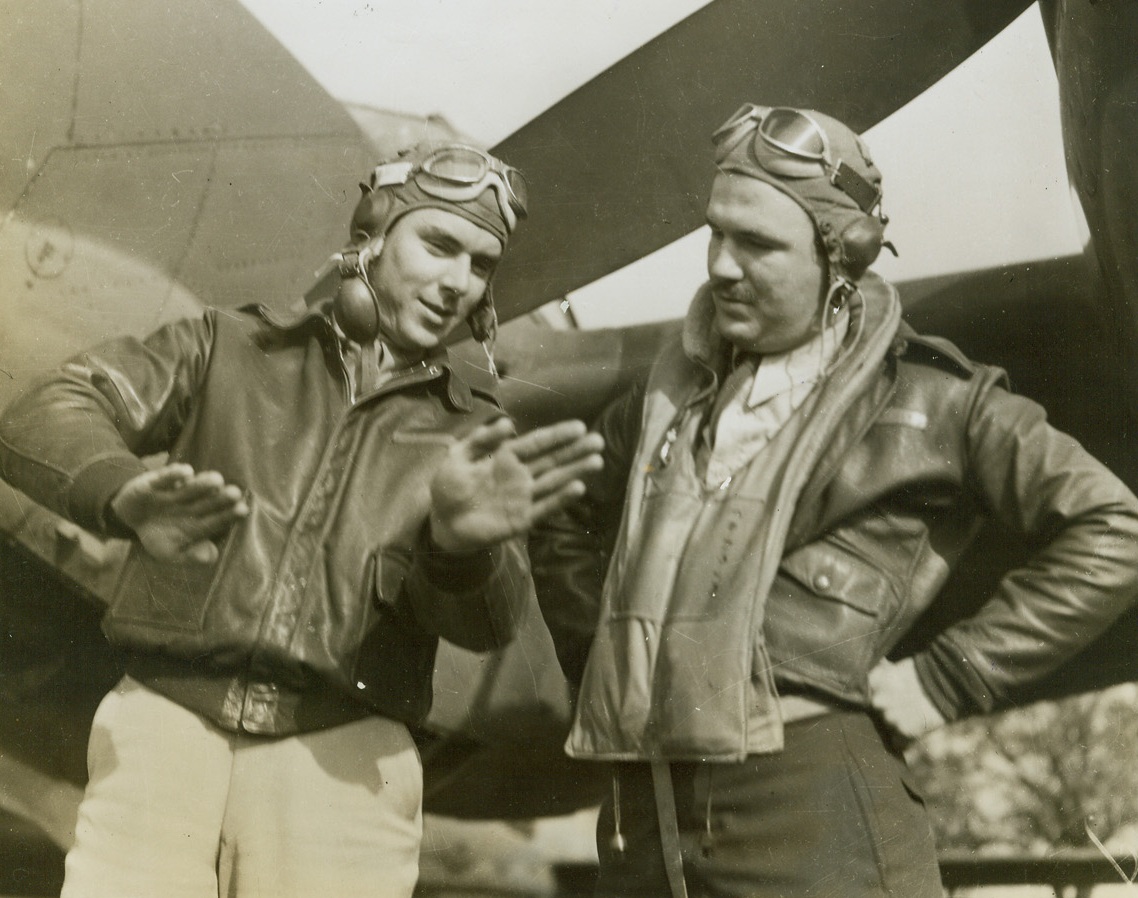
Here's How It Happened, 11/4/1943. England – At a U.S. P-38 Lockheed Lighting Fighter base “somewhere in England”, First Lt. Thomas F. Hetherington, (left), of San Antonio, Texas, shows First Lt. Richard T. Stovall, of Galena, Ill., how his P-38 and an enemy plane took part in a hot bit of action. Credit: Acme;
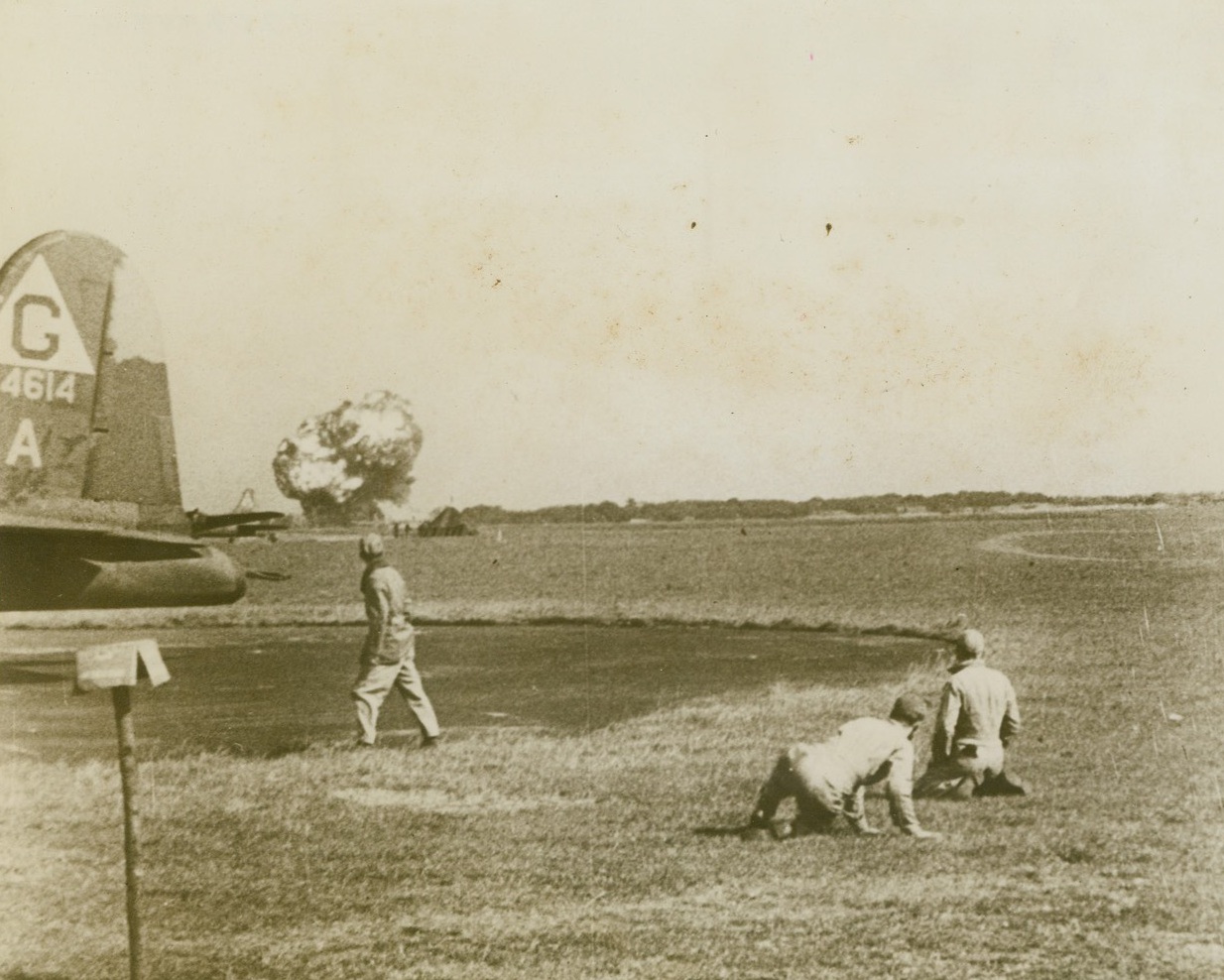
HOMECOMING OF A FLYING FORT, 11/5/1943. ENGLAND – After terrific Schweinifurt raid, which our airmen prefer to call an “invasion from the sky”, one of the big bombers came in for a landing, but flak and German fighter fire had crippled her. A great ball of fire, expanding with the speed of light, appeared the instant she hit ground. Anxious ground men watch in foreground. Price of raid to the U.S. 8th Air Force was 60 bombers – to the Germans, 144 planes and a smashing blow at her industry. Credit: US Army Air Forces by news of the day newsreel from Acme;

LONDONERS DEMAND MOSLEY BE JAILED AGAIN, 11/24/1943. LONDON – Carrying anti-Mosley banners, a crowd of workers demonstrate outside the parliament building in London, Nov. 23rd, in protest against the liberation from prison of Sir Oswald Mosley, British pre-war fascist leader. It is said that Mosley was released because of ill health.Credit: Acme;

HELPED BLITZ BERLIN, 11/24/1943. ENGLAND – After returning from pulverizing Berlin raid, the crew of the bomber, “R for Robert,” ride to mess on an airfield somewhere in England. The German capital city suffered hits third consecutive raid last night. Sweden reports that at least 10,000 have been killed and that thousands more are feeling the city.Credit: Acme;
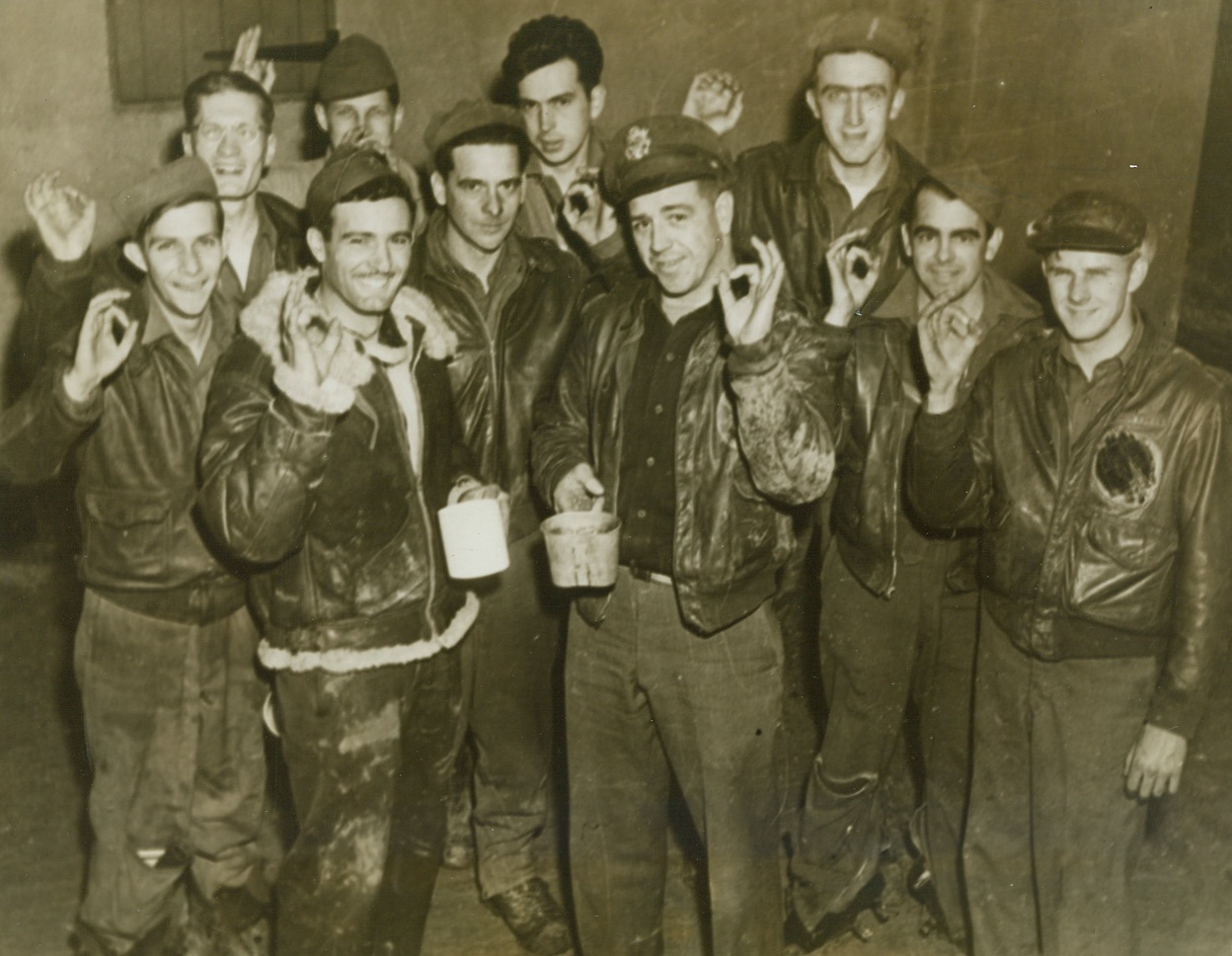
AFTER THEIR 25TH MISSION, 11/16/1943. ENGLAND – The Eight Air Force’s huge daylight raid on Wilhelmshaven marked their 25th raid over Europe for these ten flying Yanks, who are shown celebrating their safe return. In front (left to right) are two pilots: Captain Sam P. Satariano of Modesto, Calif.; and Lt. Lester L. Barnard of Donna, Texas. Grouped around the officers are (left to right): T/Sgt. Robert F. Bryson, Stockport, Iowa; Sgt. D.D. Perry, Aberdeen, S.D.; S/Sgt. H.A. Richmond, Fenimore, Wisc.: T/Sgt. George J. Gabriel, Auburn, NY; T/Sgt. H.E. Forrest, Athol, Mass.; S/Sgt. John H. Roth, Jr., Mt. Joy, Pa.; S/Sgt. Phern Stout, Lockwood, Mo.; and S/Sgt. Robert M. Dawson, Detroit, Mich.Credit: Acme;
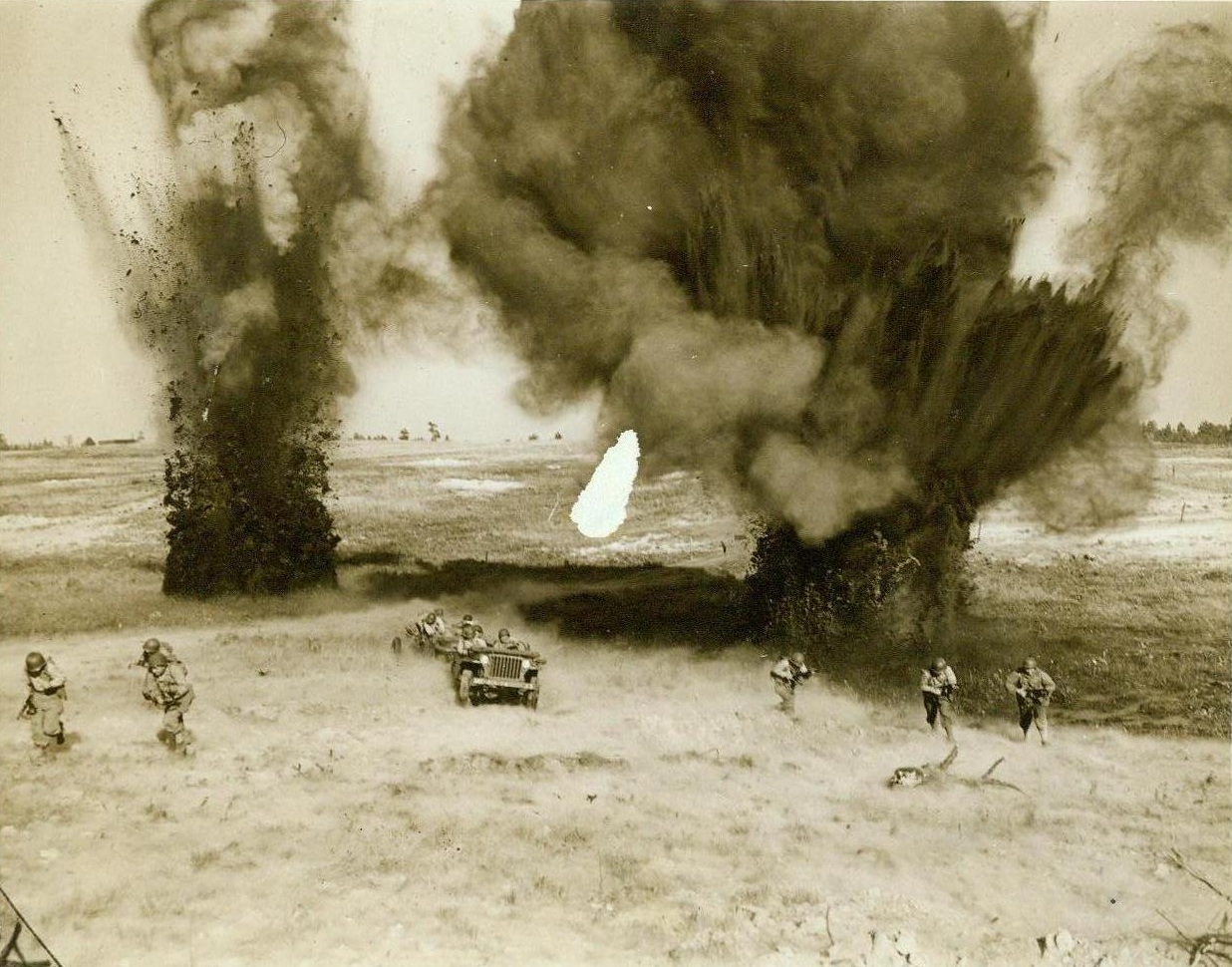
Uncomfortably realistic, 11/23/1943. CAMP MACKALL, N.C. – Men from the 465th Glider Field Artillery Battalion advance on either side of jeeps as simulated shell bursts help them to pick up their heels at Camp Mackall, N.C. They charge across a field which contains several pill-boxes and other “enemy” defenses, training for the kind of opposition which other American airborne troops have already met up with overseas. CREDIT LINE (ACME) 11/23/43;
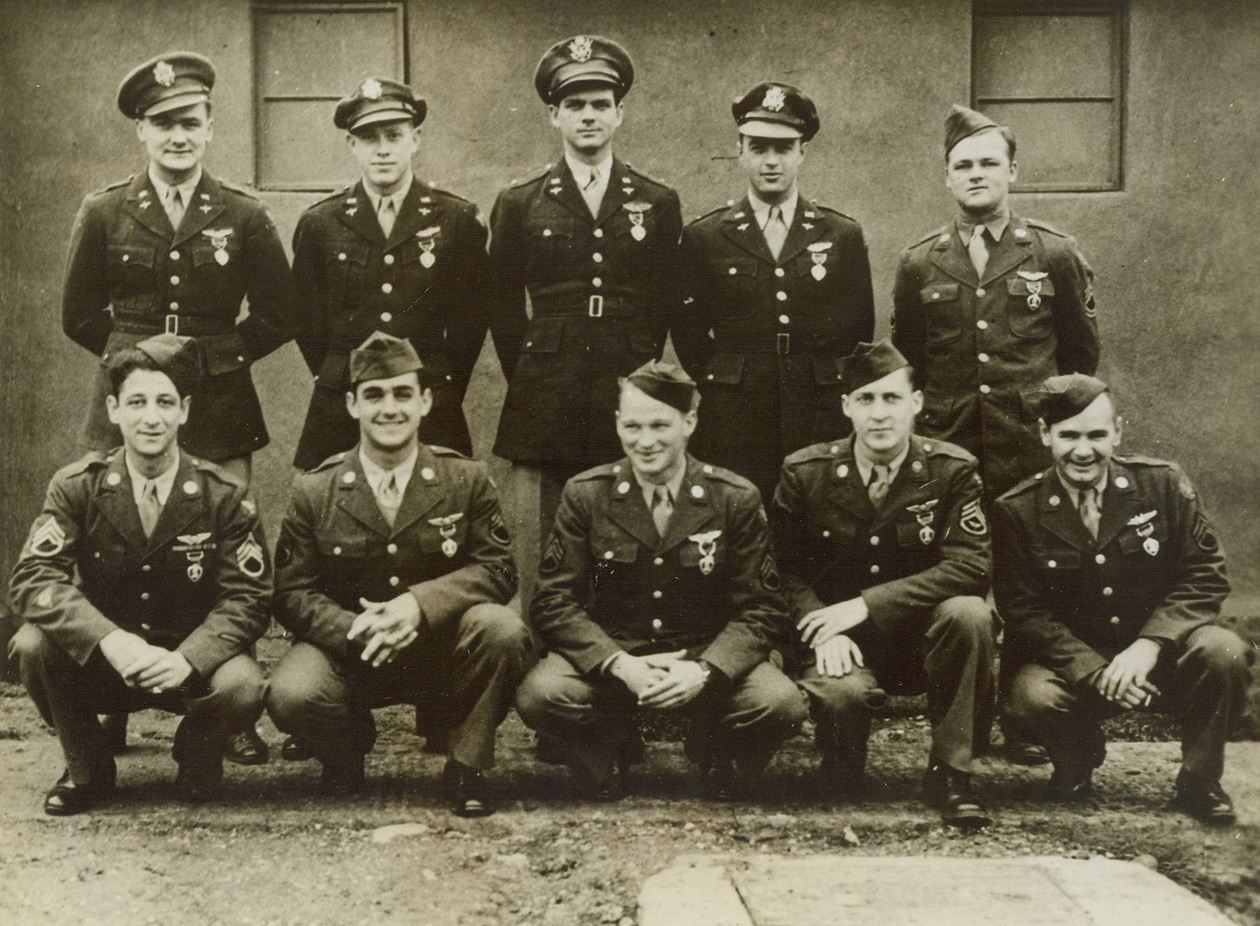
PURPLE HEART CREW, 11/28/1943. SOMEWHERE IN ENGLAND—Every member of the crew of the Flying Fortress “Stupefier” was awarded the Purple Heart Medal, as a result of wounds sustained during a recent raid over Hitler’s Europe. Left to right, the heroes are: (front row) S/Sgt. Jerry Gentile, Williamson, W/Va.; S/Sgt. M.J. Cheramie, New Orleans, La.; S/Sgt. K.H. Barnett, Springfield, Mass.; S/Sgt. Emery Davenport, Gloversville, NY; S/Sgt. E.N. Hobbs, Phila., Pa. (Back row) Flight Officer W.P. Maresh, Valley City, N.D.; Lt. F.L. Mailander, Monticello, Ill.; Lt. R.A. Romme, Chicago, Ill.; Lt. LeRoy Blair, Horton, Kas.; and T/Sgt. A.D. Patterson, Canfield, Ohio. Credit Line—WP—(ACME);
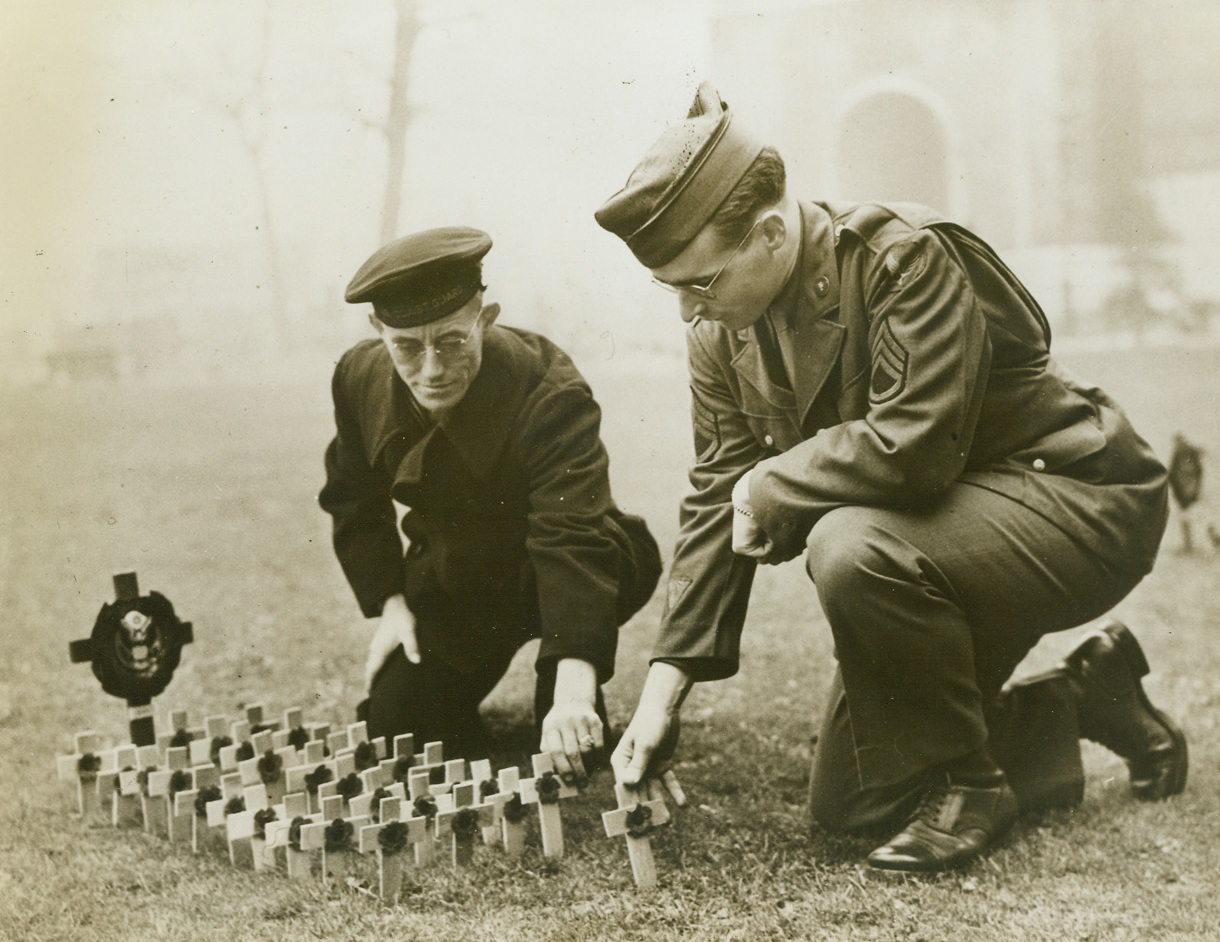
TRIBUTE TO THE FALLEN, 11/15/1943. LONDON, ENG.—Many American servicemen have placed crosses in the American section of the Field of Remembrance on the lawns outside Westminster Abbey, to pay tribute to the memory of their comrades who have been killed. Here, First Class Electrician Leo Barron, (left), USN, of Arkansas, Texas; and Sgt. W.H. Donnelly, of Flushing, N.Y., place miniature crosses in the Field of Remembrance. Credit Line (ACME);
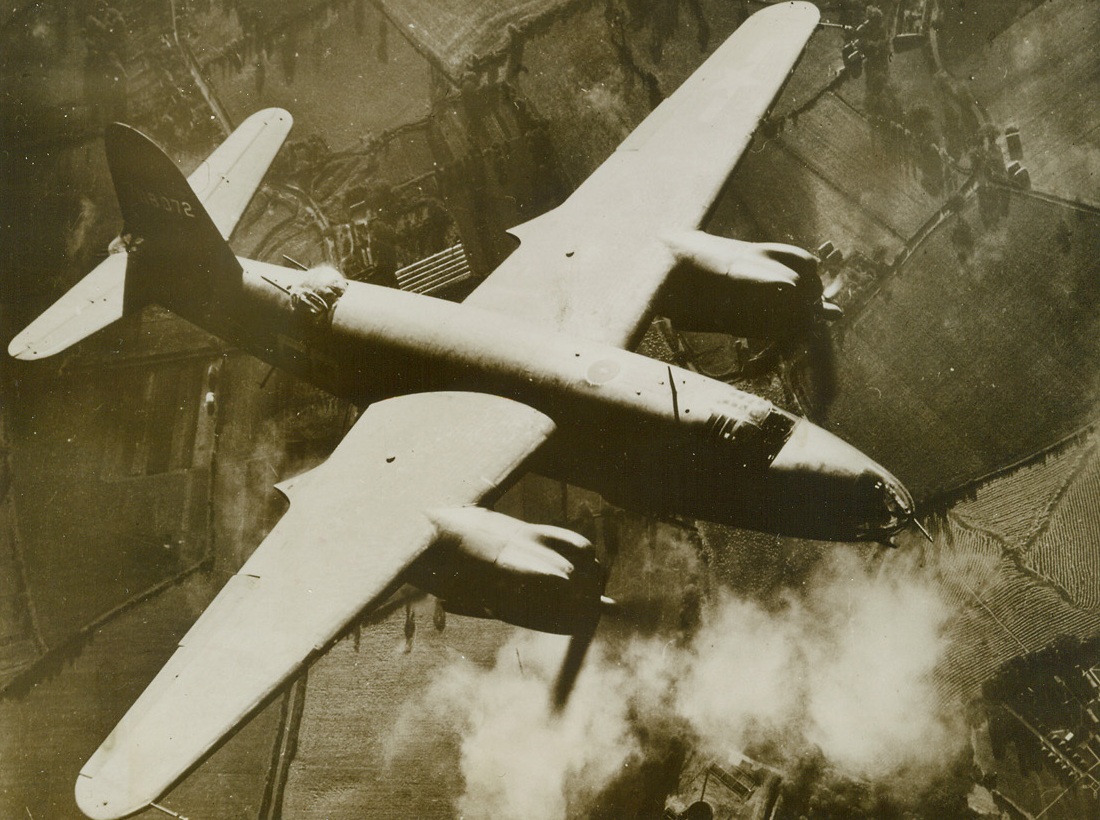
BOMBS HOME OF “YELLOW NOSES”, 11/26/1943. TRIQUEVILLE, FRANCE—Like a huge, angry bird of prey, a Martin B-26 Marauder soars over the Nazi fighter base at Triqueville, France, the home of some of Goerings’ famed “Yellow Nosed” fighter planes. Stick after stick of 300-pound bombs drop from the medium bomber and its fellow raiders, blasting hangars, buildings and dispersal areas of the airfield. Credit (U.S. Army Air Forces Photo from ACME);
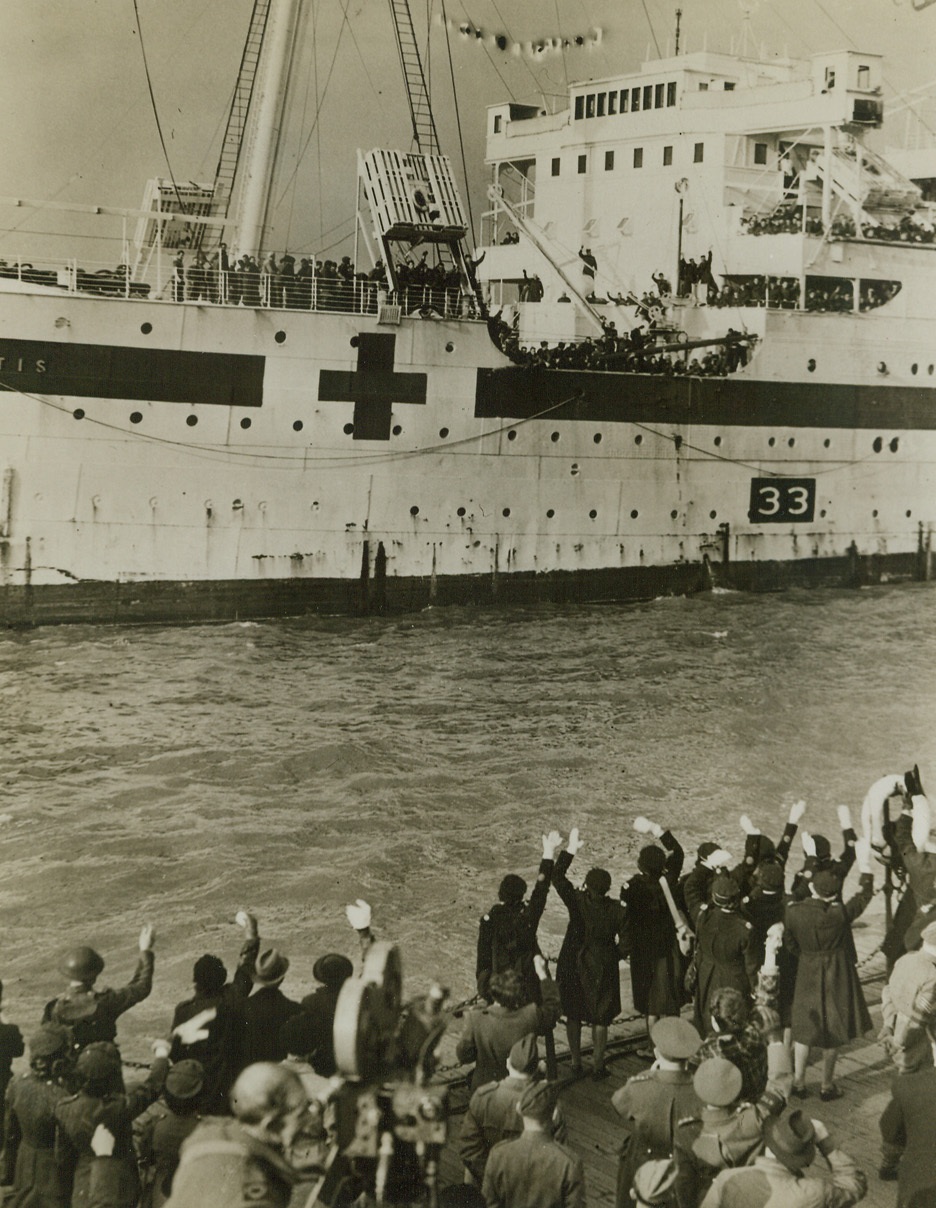
Freed from Nazi Prisons, 11/7/1943. Northwest England -- Even the blind crowd to the rails of the Atlantis, as the ship brings the third load of repatriated Allies from Germany to a northwest England port. The more seriously wounded men made the trip from Germany. Credit: ACME;
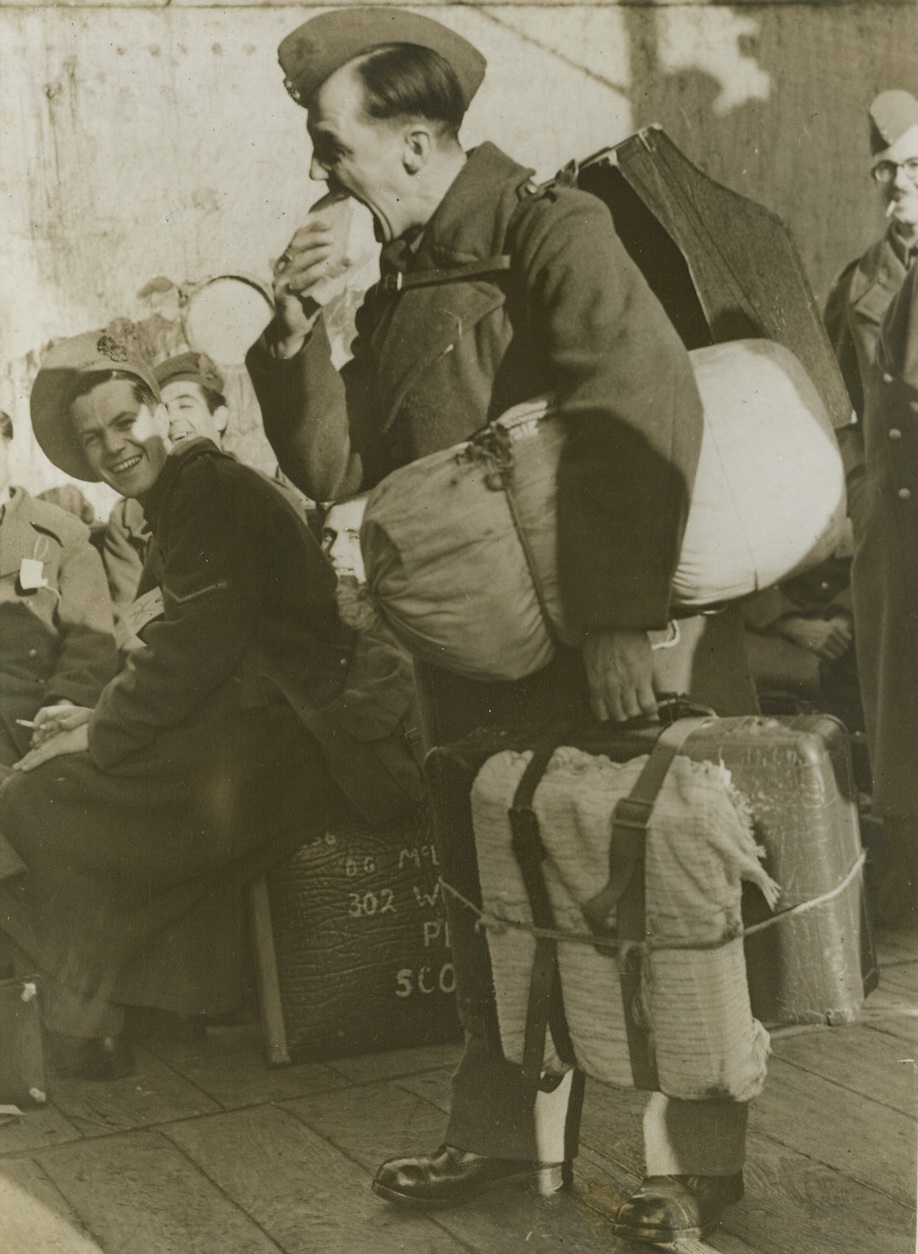
No More Nazi Menus, 11/7/1943. Leith, Scotland -- Before even putting down his luggage, a repatriated Allied prisoner grabs a thick sandwich at Leith, Scotland, where civilians and soldiers interned in Germany recently landed. The Nazi prison diet isn’t conducive to weight-gaining. This hungry soldier is L/Cpl. William Gibson, of Aberdeen, Scotland, who arrived with the first batch of 3,694 persons, including 104 civilians. Credit: ACME;

Work of French Patriots, 11/28/1943. Varenne-Le-Grand, France – Derailed and flaming, this Nazi gasoline train was sabotaged by French patriots, in the vicinity of Varenne-Le-Grand, on the night of August 31, 1943. This action cost the Germans 1,200,000 liters of high test aviation gas; ruined the train, which was specially built for fuel transportation in Germany; and halted traffic on the railroad line for five days. Photo radioed to New York today (November 28) from Algiers. Credit: French official photo via OWI Radio-ACME;
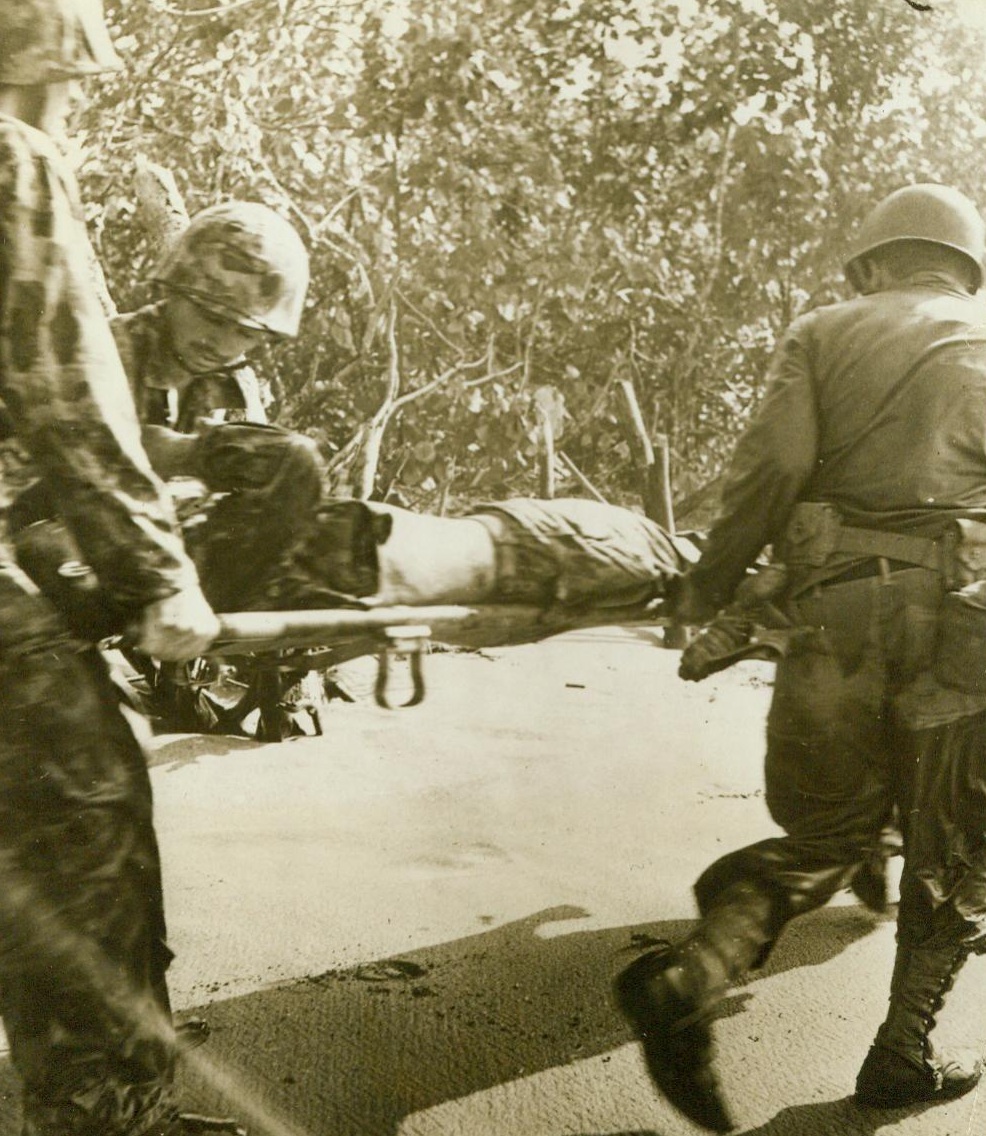
Casualty At Bougainville, 11/23/1943. Bougainville Island -- Buddies rush a wounded Marine to immediate first aid treatment, just off the beach at Bougainville. The Japs succeeded in strafing the small landing boats with machine guns and 20 mm. cannon fire, causing some casualties to the Leathernecks who were churning ashore at the South Pacific Island. 11/23/43;

Texan Giving Japs A Bad Time, 11/19/1943. Bougainville, S.I., -- Marine Lt. Col. Fred D. Beans (above), of Cleburn, Tex. keeps his eyes peeled for Japs as he stands at a field telephone directing an artillery barrage on Bougainville Island. 11/19/43 (ACME);
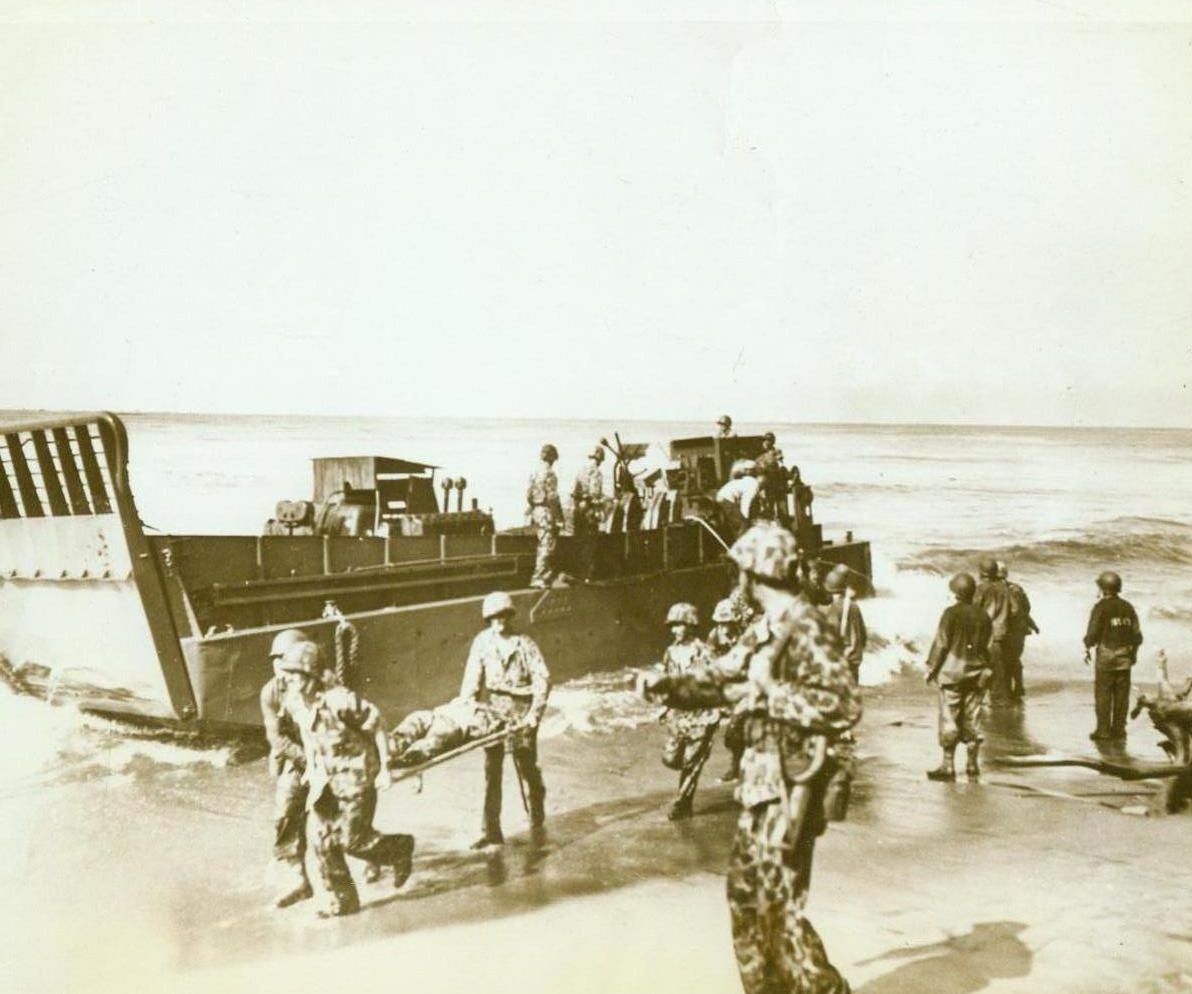
Some Return Quickly, 11/16/1943. Bougainville -- Some of our fighting men return quickly from battle. American Marines and Coast Guardsmen remove wounded assault troops from the beach at Empress Augusta Bay. The injured Yanks are being carried back to a Navy transport. 11/16/43;

The Morning After, 11/26/1943. Bougainville Island -- Wet and weary, after an all-night vigil in Bougainville foxholes, Marine Raiders tramp along the lane that runs from Cape Torokina to Piva Village as they return to their base. Members of the Piva Patrol, these fighting men were ordered to use only cold steel (their knives and bayonets) when the Japs attacked, in force, on the Piva road block. 11/26/43 (ACME);
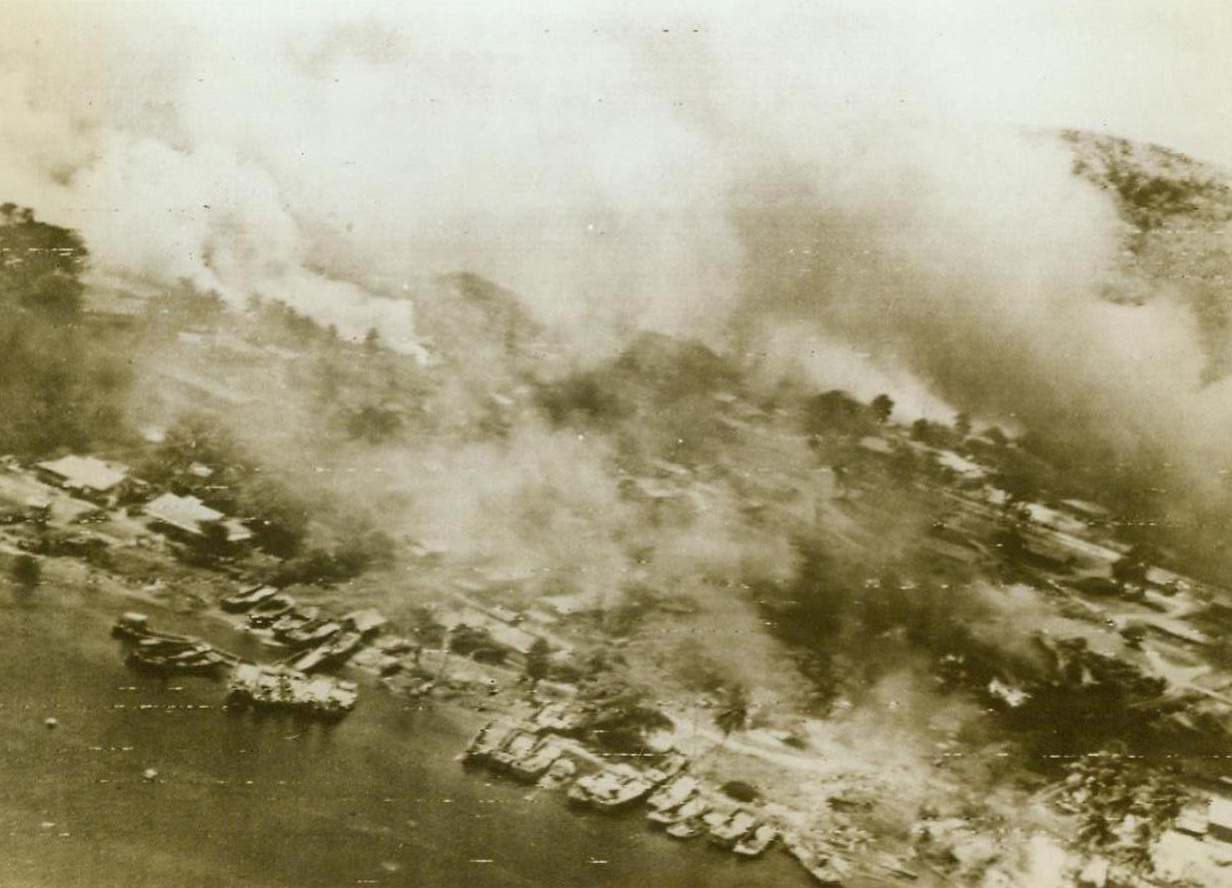
Yanks Blitz Rabaul Again, 11/8/1943. The waterfront section of Rabaul, powerful Jap base on New Britain, burns fiercely after a raid last Nov.2, by B-25 Mitchell Bombers under the command of Maj. Gen. George C. Kenney. Yank forces have hit again, and yet again at this base but the Nips are still able to concentrate large forces here. The larges group of Jap warships in many months, is now gathered at Rabaul, and a naval showdown with U.S. forces is shaping up rapidly. 11/8/43 (ACME);
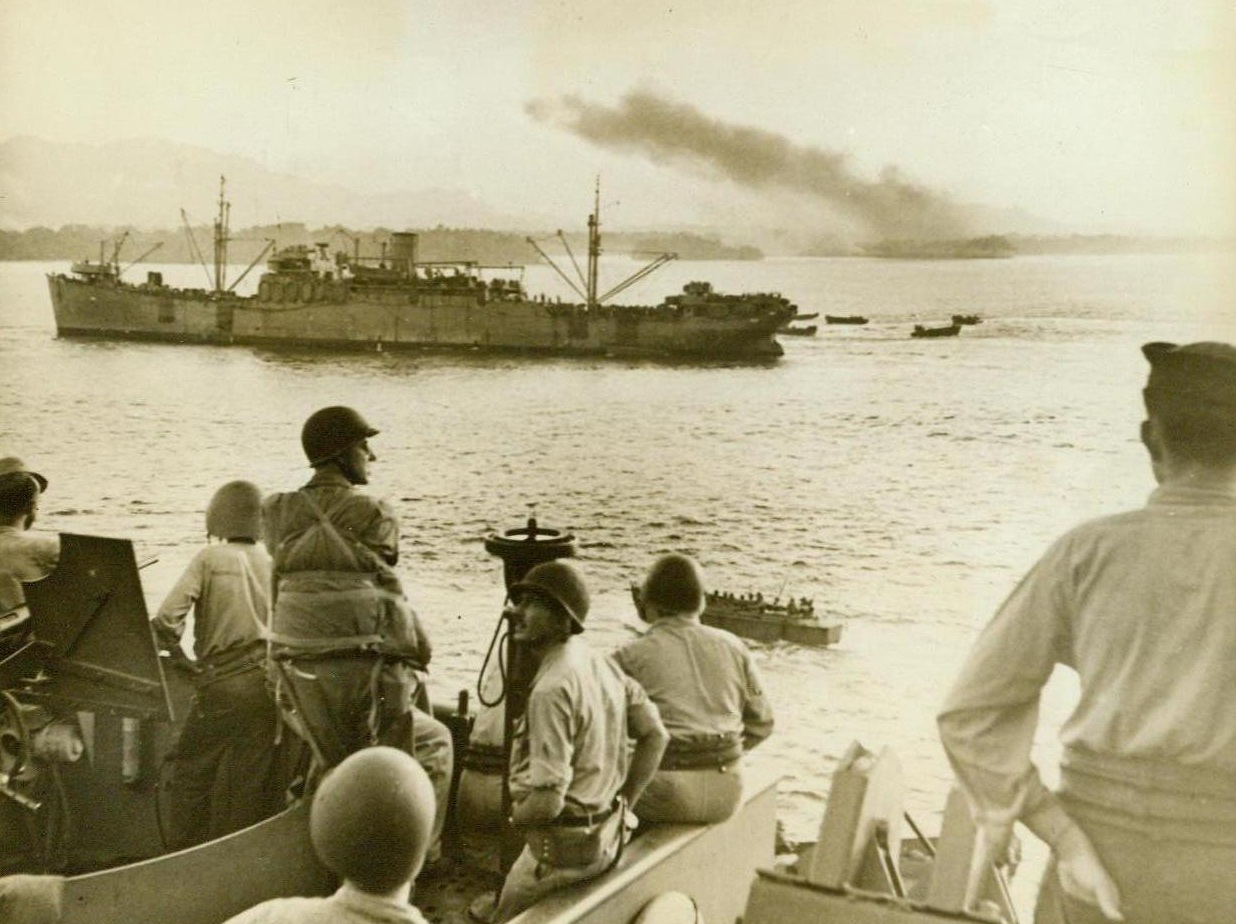
Headed For Bougainville, 11/15/1943. Bougainville -- Landing craft loaded with U.S. Marines, leave the sides of transports headed for the invasion of Bougainville. In the background (right), a smoke pall hangs over Torokina Beach, after our dive bombers had blasted Jap installations to shreds in preparation for the landing of Marines. This invasion has been called "the toughest of the whole Solomons Campaign." 11/15/43 (ACME);
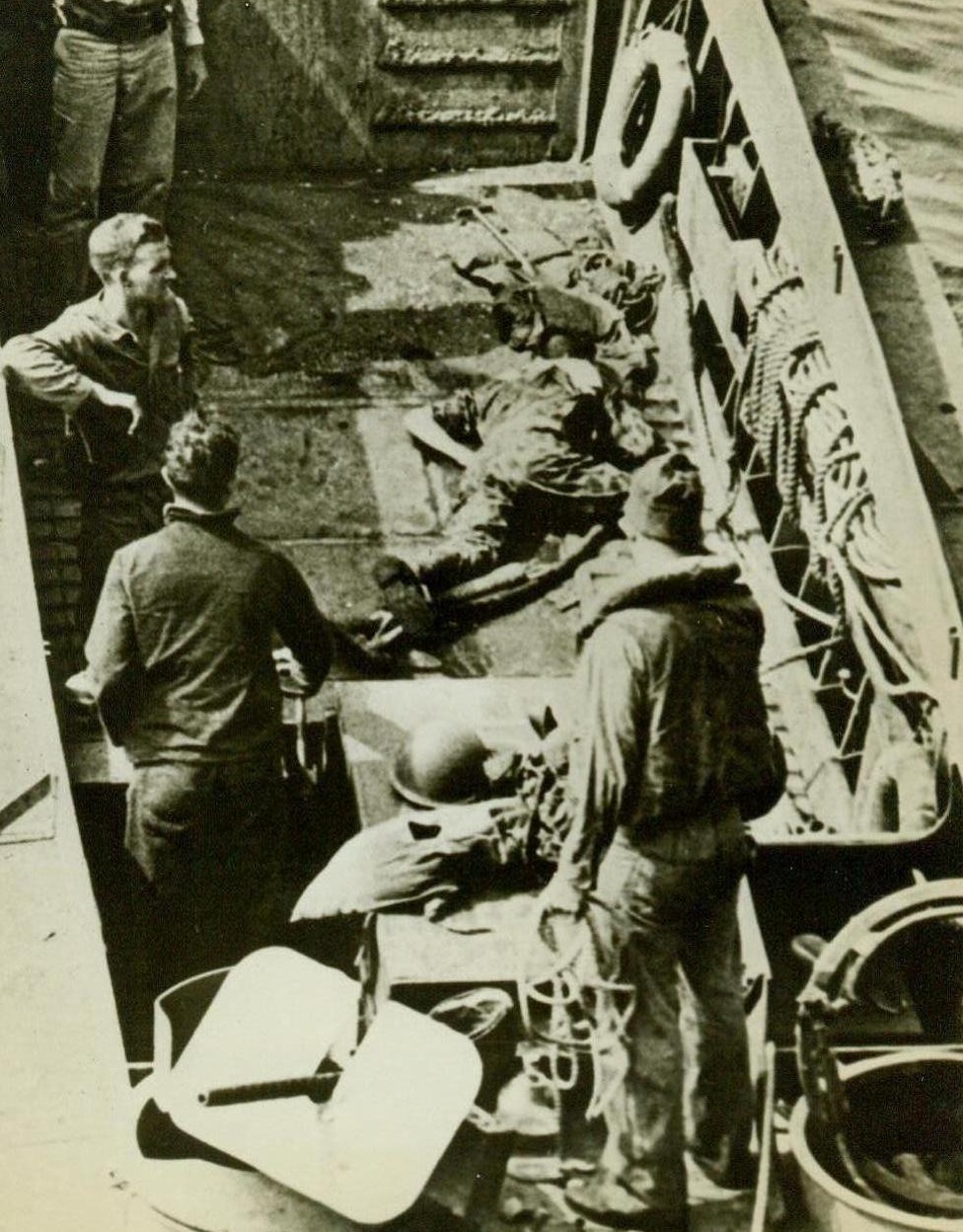
Landing Casualty, 11/15/1943. Bougainville -- A U.S. Marine lies crumpled in the bottom of a landing barge, which is on its way back to the transport after landing troops on Bougainville Island -- One of the toughest landings in the Solomons campaign. The wounded man was hit when the first Marines hit the beach. 11/15/43 (ACME);
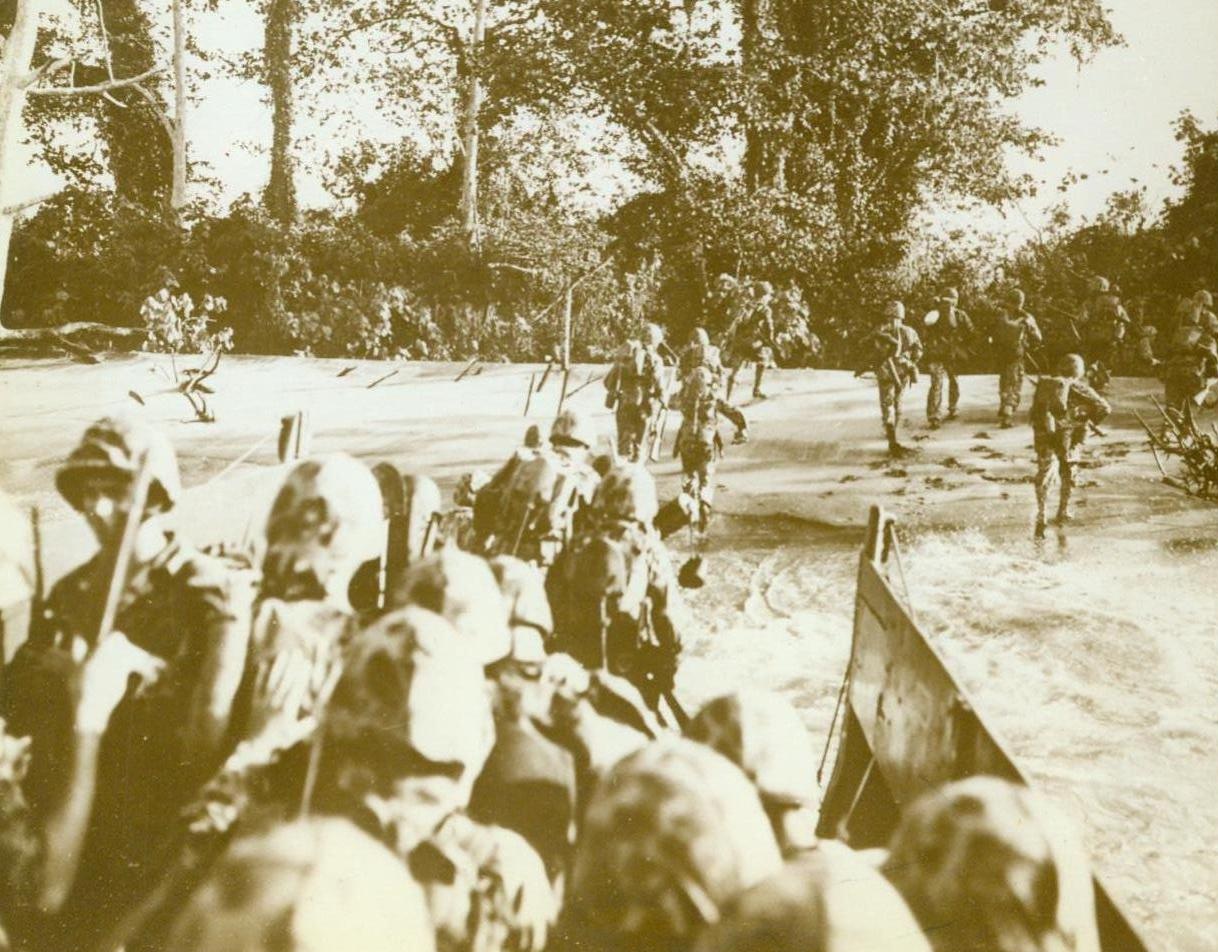
Dash For Cover, 11/16/1943. Bougainville -- Leaping from landing barges, U.S. Marines, clad in camouflaged clothing, rush for cover as they begin the American invasion of Empress Augusta Bay, on the west central coast of Bougainville in the Northern Solomons. The landing barges, piloted by Coast Guardsmen were supported by a U.S. Navy task force. 11/16/43 (ACME);
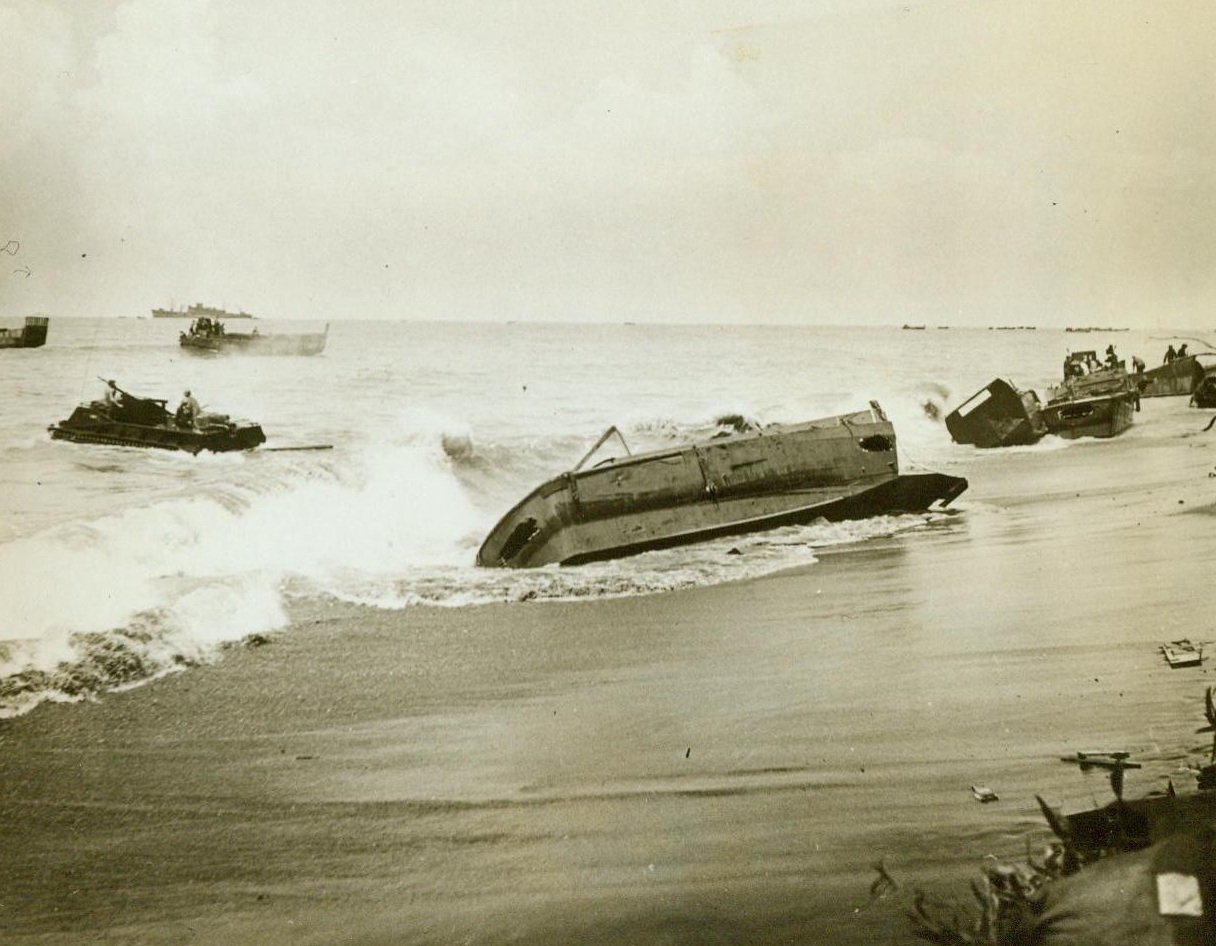
"High And Dry" At Bougainville, 11/23/1943. When the tide went out at Bougainville in The Solomon Islands, these landing craft which brought U.S. Marines ashore for the invasion of the Jap-held island, were left beached. 11/23/43 (ACME);
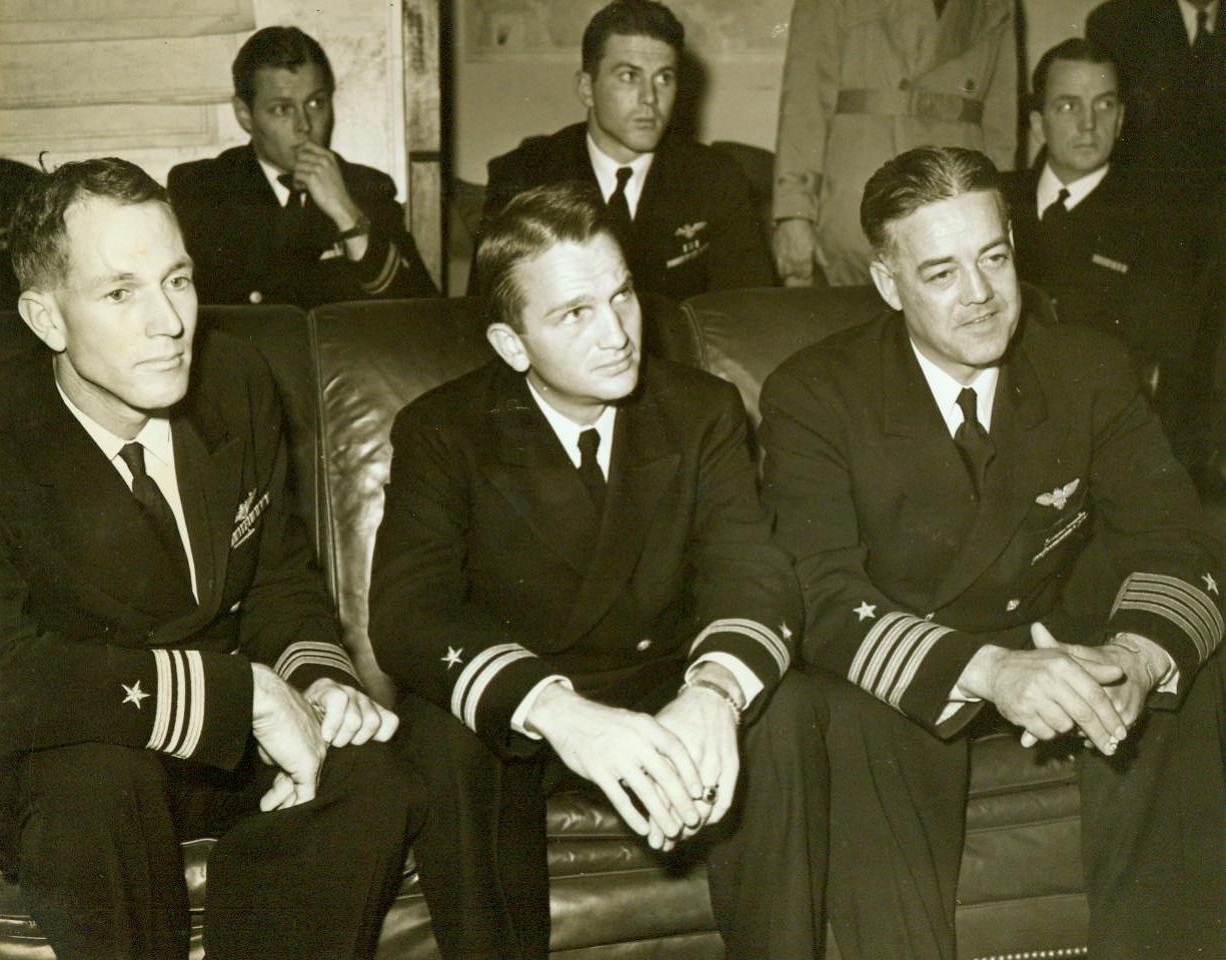
Tell Of Anti-Submarine Warfare, 11/10/1943. Washington, D.C. -- Lt. Comdr. Howard M. Avery (L) commander of a squadron based on the aircraft carrier Card: Lt. Charles H. Hutchins (C), of Terre Haute, IND., commander of the Destroyer Borie, which was sunk; and Captain Arnold L. Isbell of Chicago, ILL., commander of the Baby Flat-Top Card; Tell of their experiences in battling the submarine menace. For their work their units received a Presidential Citation. The anti-submarine group set a record in sinkings. 11/10/43 (ACME); Tell of their experiences in battling the submarine menace. For their work their units received a Presidential Citation. The anti-submarine group set a record in sinkings. 11/10/43 (ACME);
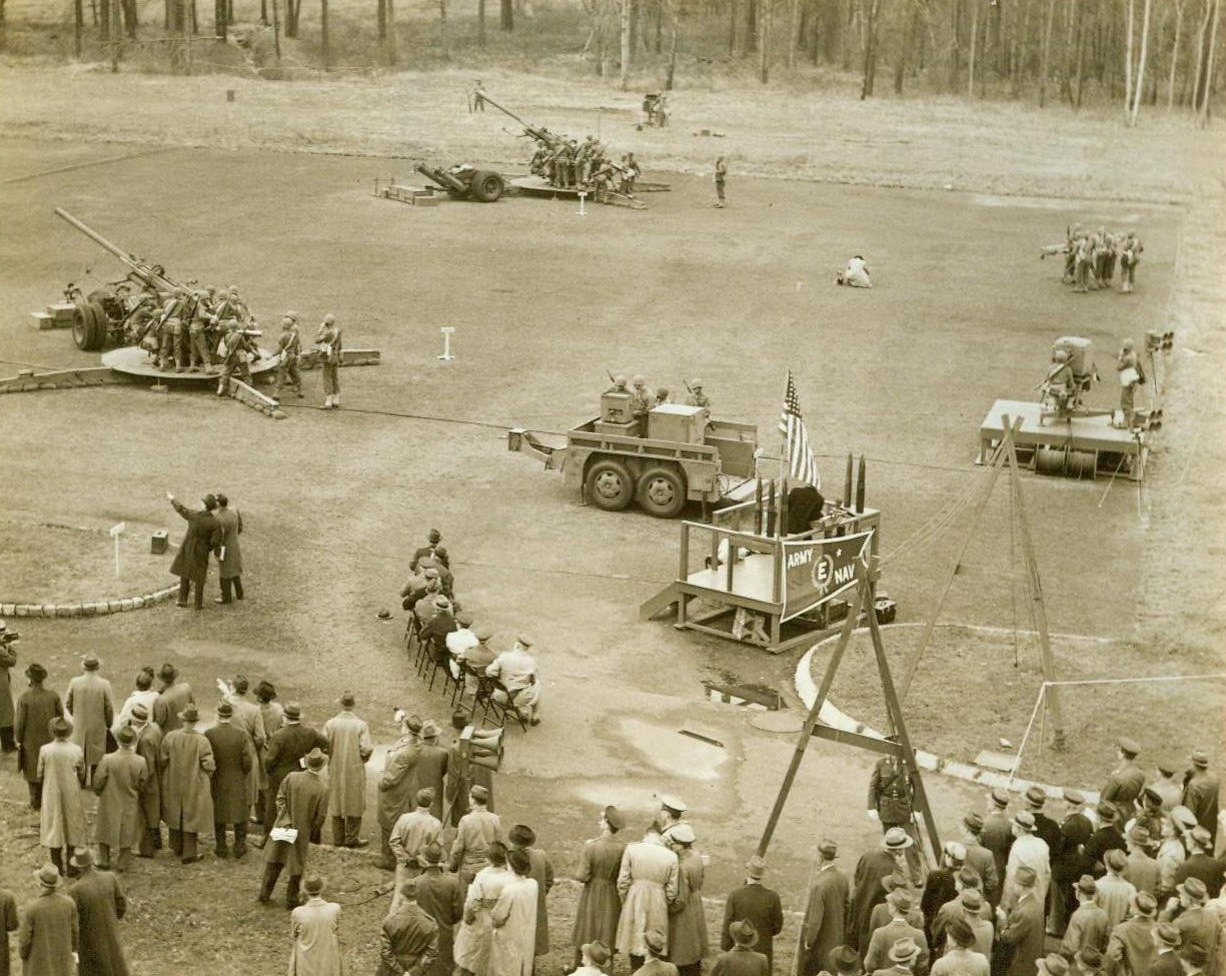
Electrical Impulse Guides Ack-Ack Shells, 11/10/1943. Murray Hill, N.J. -- Here is a general view of the Army demonstration of the new M9 gun pointer, shown at the Bell Telephone Laboratory in Murray Hill yesterday. At left are two 90MM anti-aircraft guns; in center, to the left of flag, is the electrical computer which directs the guns; in right center is tracker unit and in right background is the height finder. 11/10/43 (ACME); in right center is tracker unit and in right background is the height finder. 11/10/43 (ACME);
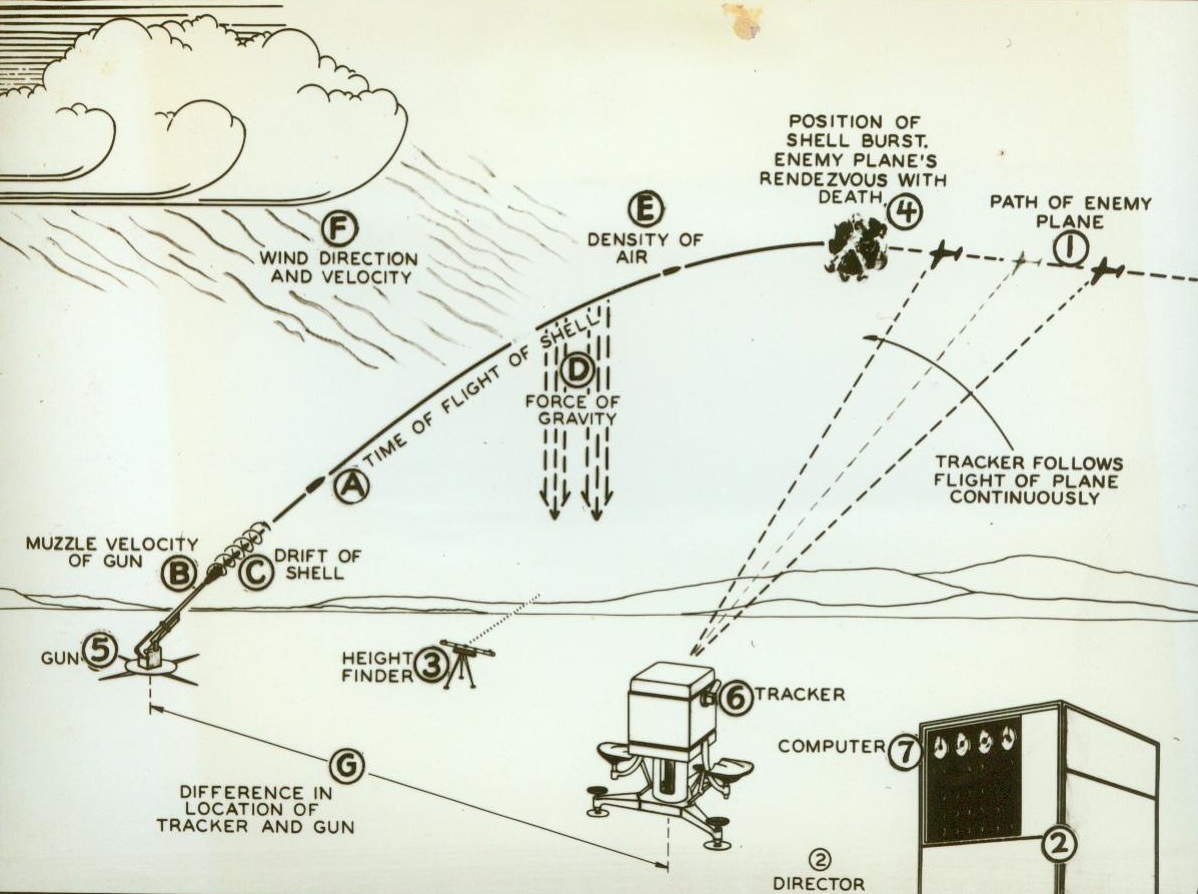
Electric "Brain" For Ack-Ack Guns, 11/10/1943. Murray Hill, N.J. -- This diagram shows how the Army's new M9 gun pointer operates. An enemy plane (1) looms in sight. The crews of the tracker (6) and of the height finder (3) spot the target and follow it in its flight. The computor (7) of the electrical director instantly measures the position of the target and predicts where the anti-aircraft gun (5) is to be aimed and how the fuse of the shell is to be set so that the shell will burst in the path of the plane at the predicted position (4). The electrical information derived by the computor is translated into mechanical movement at the gun to swing its muzzle automatically towards the target, making corrections for a number of factors. The time of flight of the shell (A) to the predicted position of the target (4) is dependent on the muzzle velocity of the gun (B) which in turn is governed by the temperature of the powder and the number of times the piece has been fired. The path of the shell is also influenced by its drift (C), which is the spin caused by the rifling of the gun, curving the shell to the right. At the same time the pull of gravity (D) Deflects the shell downward, and the varying density of the air (E) slows down the projectile more or less, while the direction and the velocity of the wind (F) either retards or pushes the shell ahead or to one side. The difference in location of the tracker and the gun (G) must also be taken into account. 11/10/43;
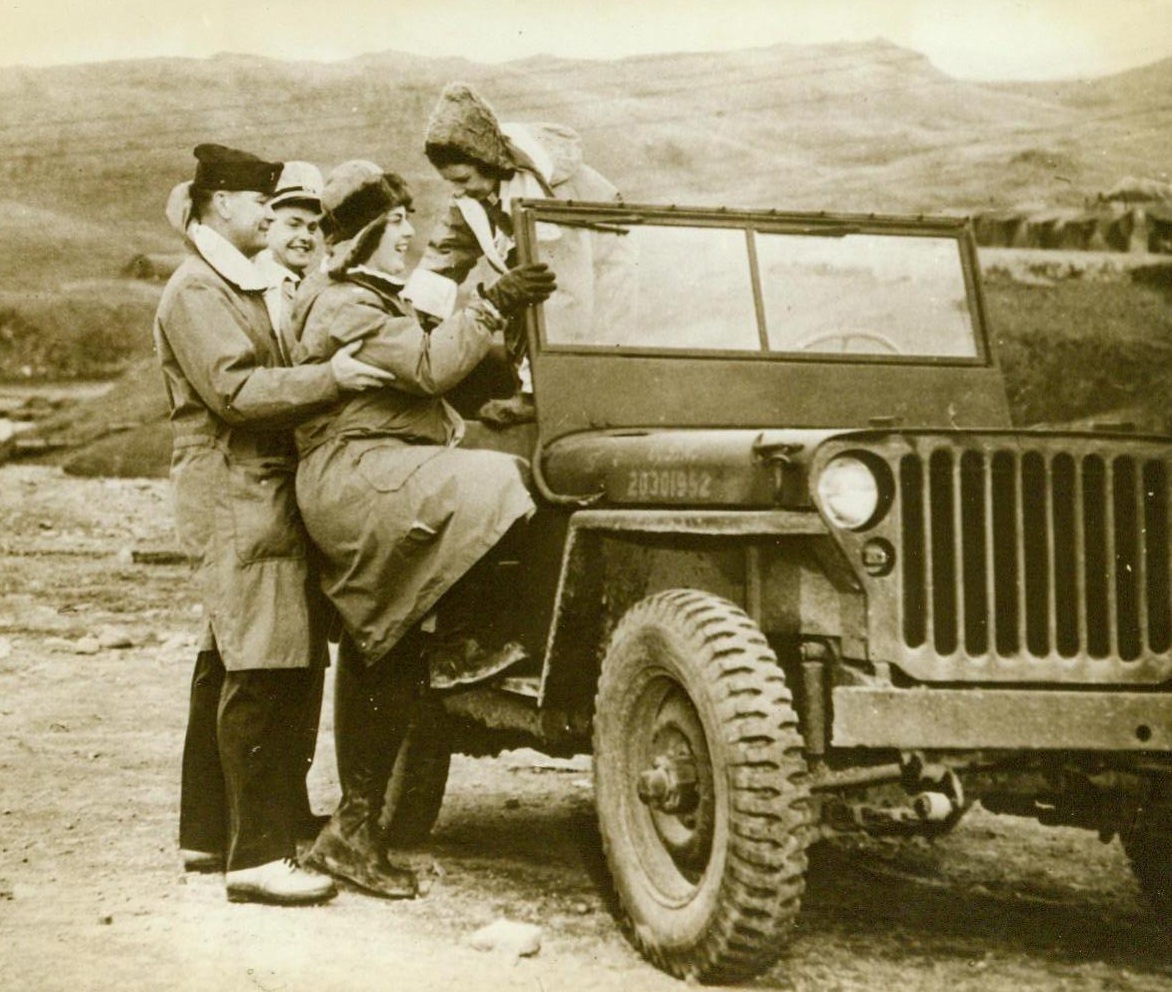
Modern Version Of The "Buggy Ride", 11/11/1943. Adak, Alaska -- Laughing gaily, two Navy nurses are helped aboard a jeep for a sightseeing trip around the Aleutian base. They are: Ensign Margaret Allen, of Denver, Colo., and Ensign Mary Louise Eckes, (right), of San Francisco, Calif., And Dickinson, N.D. The two U.S. Navy officers will act as hosts on the trip. (ACME);
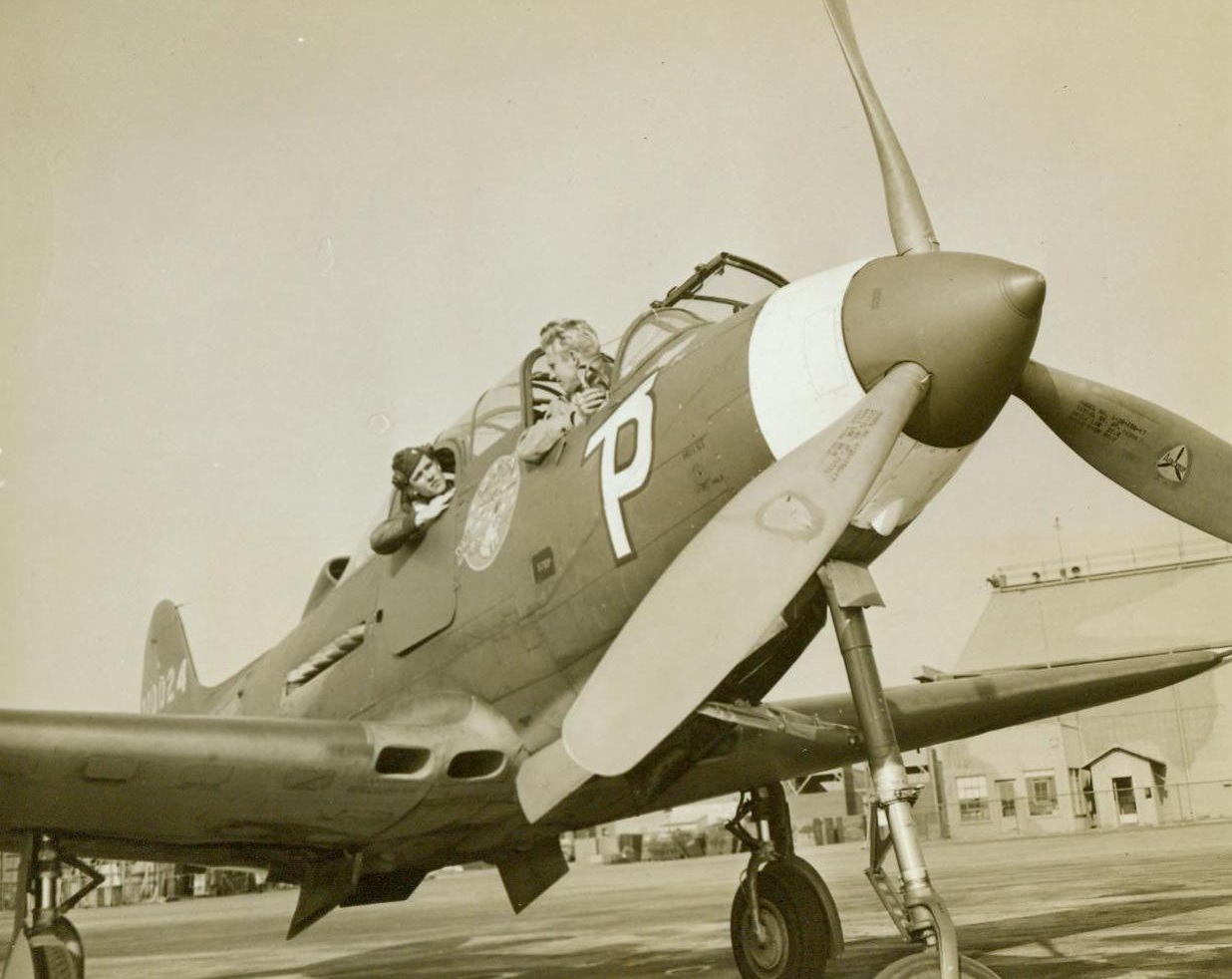
Aircobra Becomes "Hot" Trainer, 11/26/1943. Oakland, Calif. – The newest thing in racy Army trainers is the speedy Bell Aircobra P-39 fighter, with a second cockpit cut in the ship’s nose so that both trainee and instructor can fly. In the front seat is Capt. Charles Tucker, who recently returned from China where he flew with the 14th Air Force. Lt. L.V. Andrews sits behind him 11/26/43 (ACME);
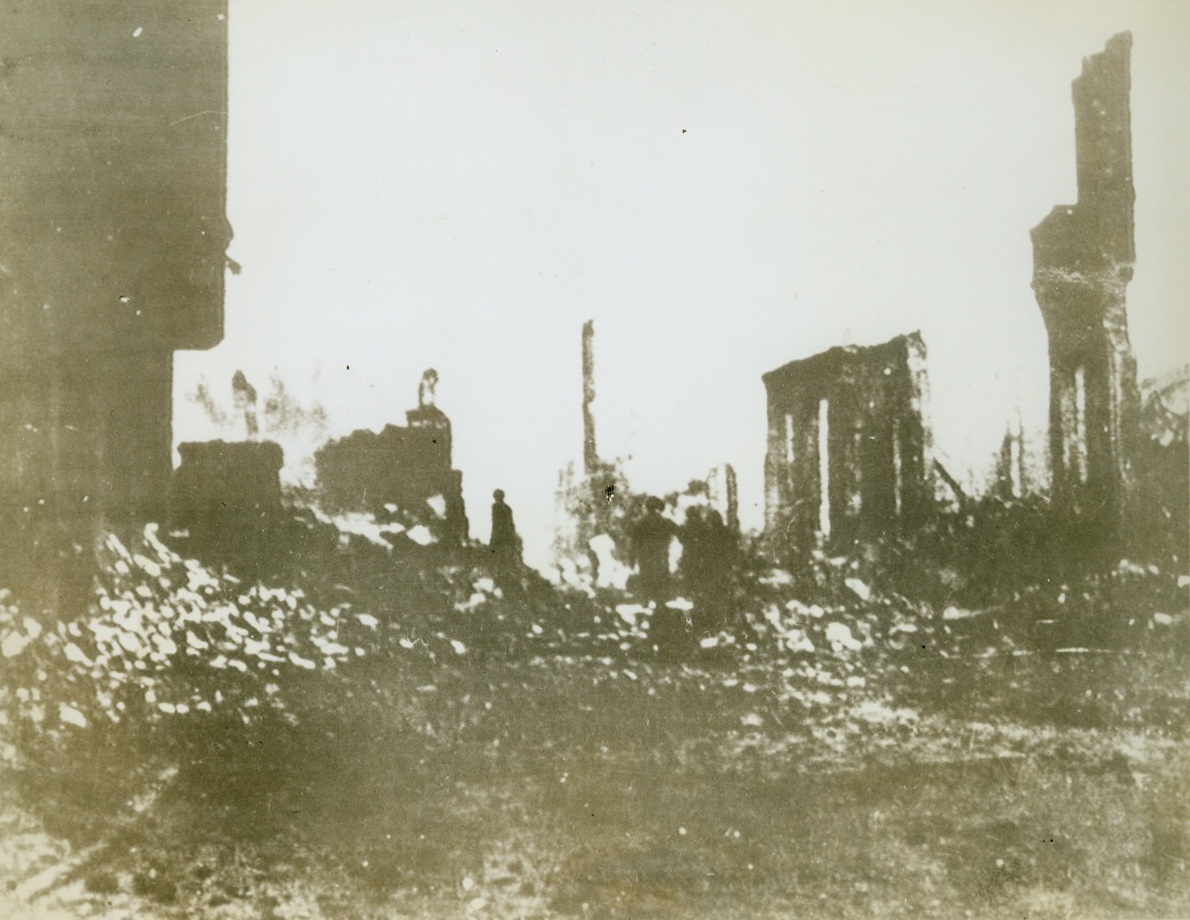
Hamburg Devastated by Allies, 11/22/1943. HAMBURG, GERMANY – The thousands of tons of explosives and incendiaries dropped on Hamburg by the Allies, have turned the German industrial center into a giant rubble heap where shocked civilian workers can do little to repair any damages. Reports escaping from Germany tell that the gas, electric, and even the water supply was cut off by Allied bombs. This British Official Photo, radioed from London, shows empty shells of buildings. Credit: (ACME Radiophoto);
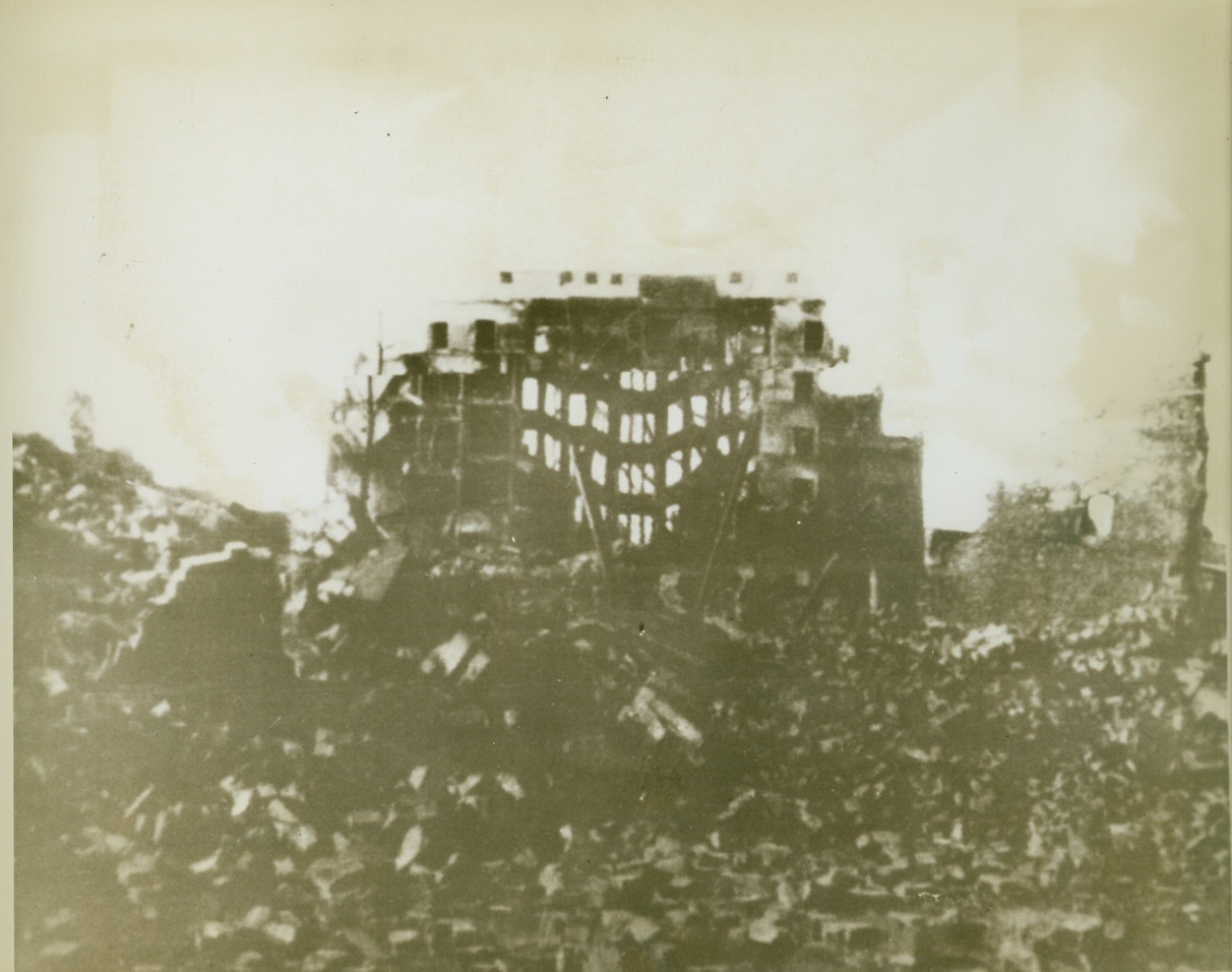
This is Hamburg, 11/22/1943. HAMBURG, GERMANY – The skeleton framework of part of a building is a fire-blackened ghost rising out of the rubble that is Hamburg. Concentrated Allied aerial assault has succeeded in leveling the industrial sections of the German city, demoralizing the population. (This is a British Official photo radioed from London.) Credit: (ACME Radiophoto);
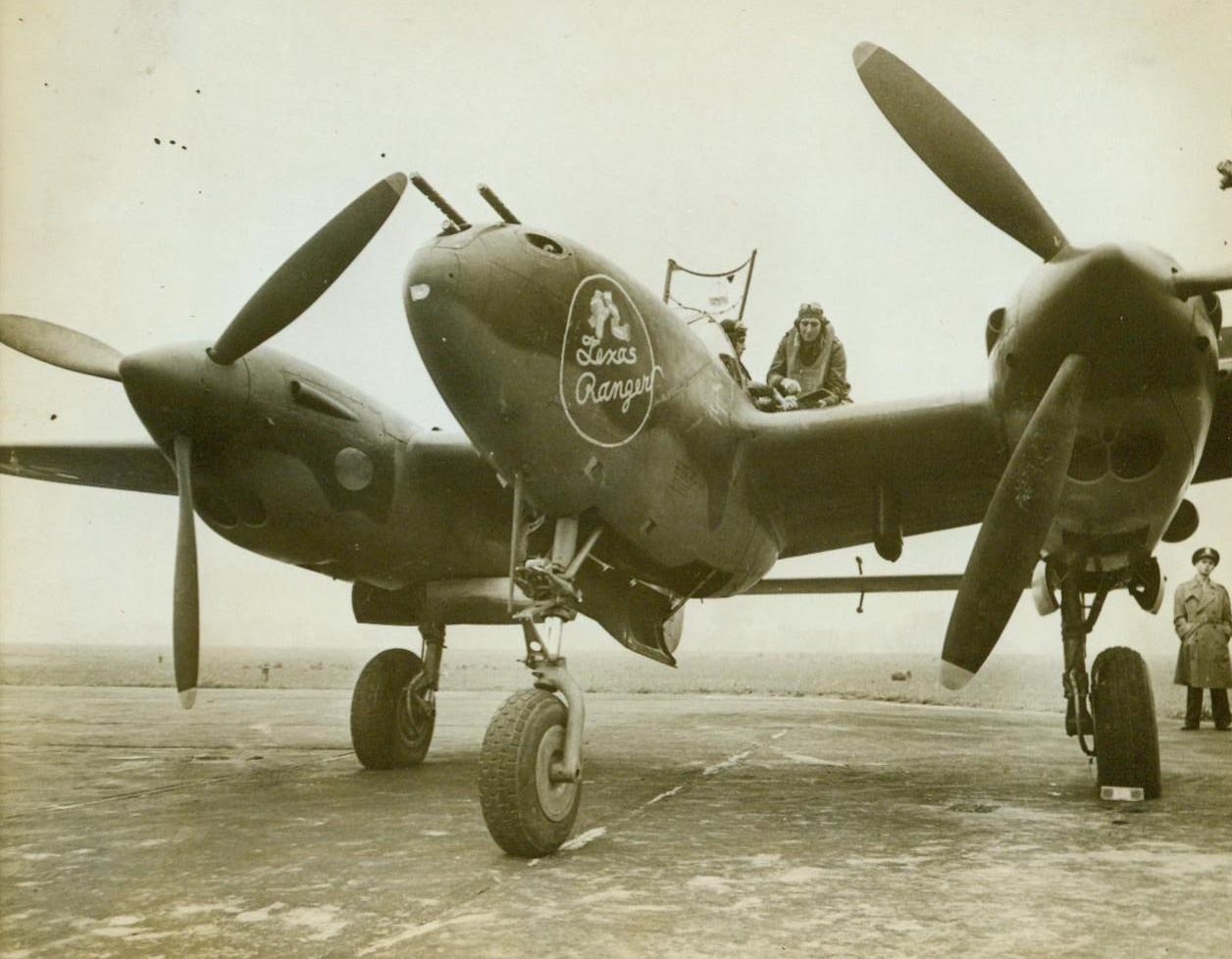
All Duty U.S. Plane In Britain, 11/1/1943. England – The lightning P-38, one of the most useful of all types of U.S.A.A.F. planes, now operates from bases in Britain. Lt. Col. Jack S. Jenkins, of Levelland, Texas, commanding officer of a U.S. Air Force station in Britain, is in the cockpit of his P-38 “Texas Ranger” just before the take-off. The two-engined high-wing monoplane performs many sky war tasks, as it is a fighter-bomber, low-level attack plane, and reconnaissance aircraft. 11/1/43 (ACME);
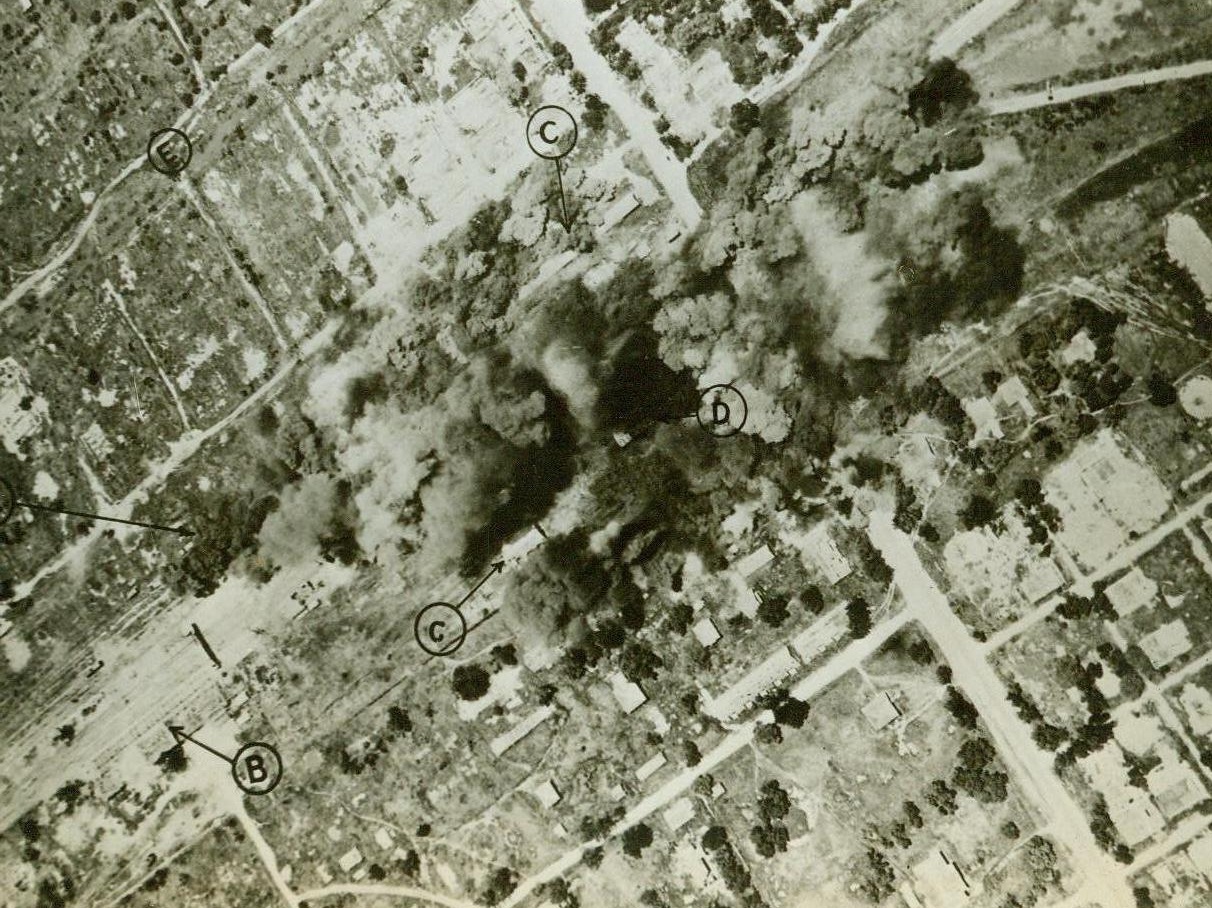
Bombs for Burma, 11/1/1943. This photo, just released in the United States shows bombs from American aircraft dropping on the important railroad junction at Thazi, Burma, during a recent raid. The letter “A” identifies tracks, while “B” shows warehouses, “E”, blasted warehouses, and “C”, trackage and sheds. 11/1/43 (U.S. Army Photo From ACME);
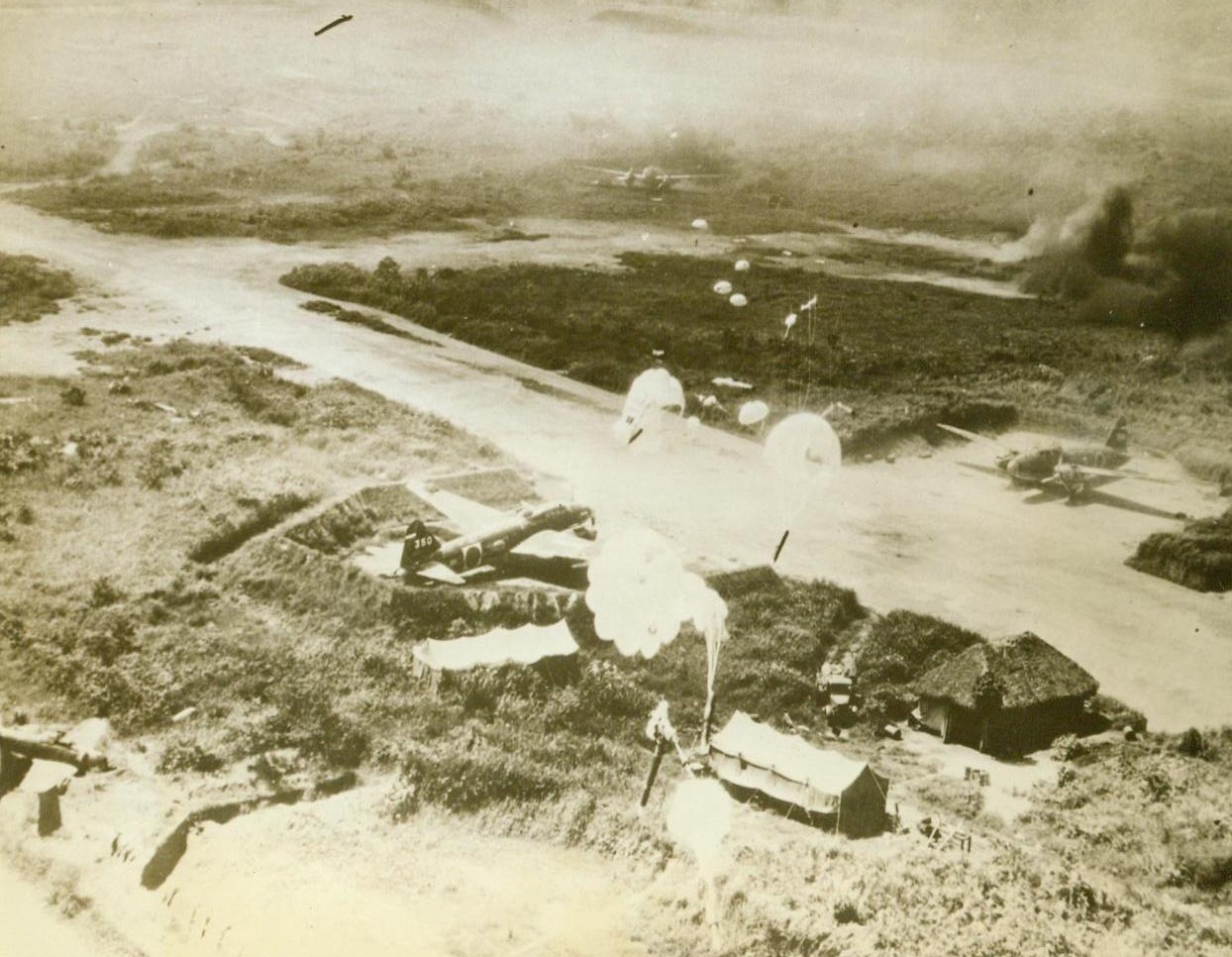
Yanks Blast 200 Jap Planes At Rabaul, 11/4/1943. This unusual photo, taken from a plane of the U.S. 5th Air Force, which was flying almost at rooftop level, shows a string of parachute bombs (from lower center to top center of photo), as they dropped on a section of the dispersal area of Vunakanau Airfield at Rabaul, New Britain, during a raid last Oct. 12. More than 200 Nip planes were destroyed or damaged in the raid, as well as ships and installations. Note Jap bombers in their revetments, while a zero fighter, (lower left) is cracked up in a ditch. Last Tuesday, Yank airmen struck at Rabaul again, damaging or destroying 26 ships and 108 planes. (U.S. Army Air Forces Photo From ACME);
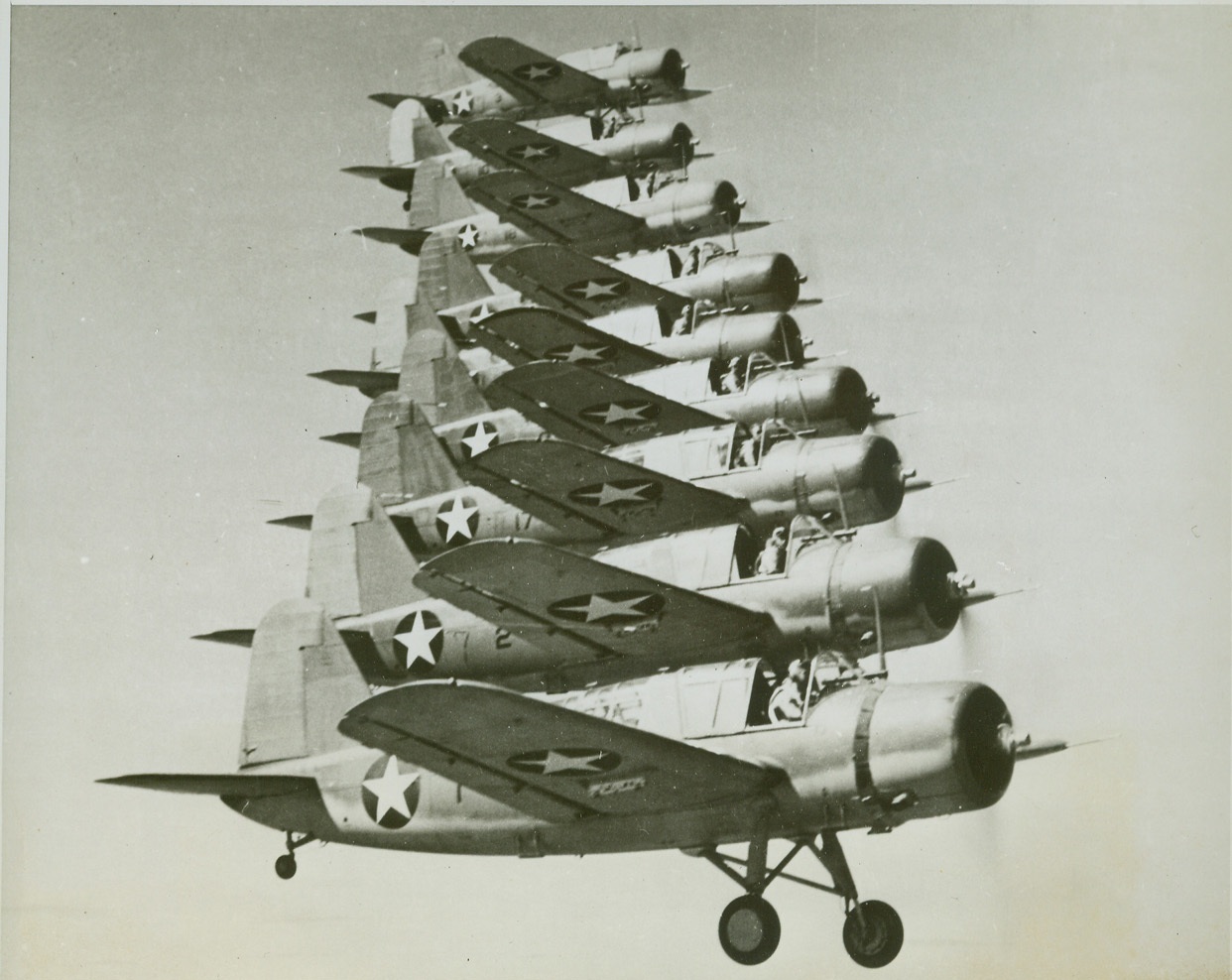
Flying Staircase, 11/9/1943. Nine Kingfisher scout planes (OS2U) of the Navy form a flying “staircase” by flying almost “cheek-to-cheek” during aerial maneuvers. Precision flying is almost matter of fact to Navy fliers. Credit: Official U.S. Navy photo from ACME;
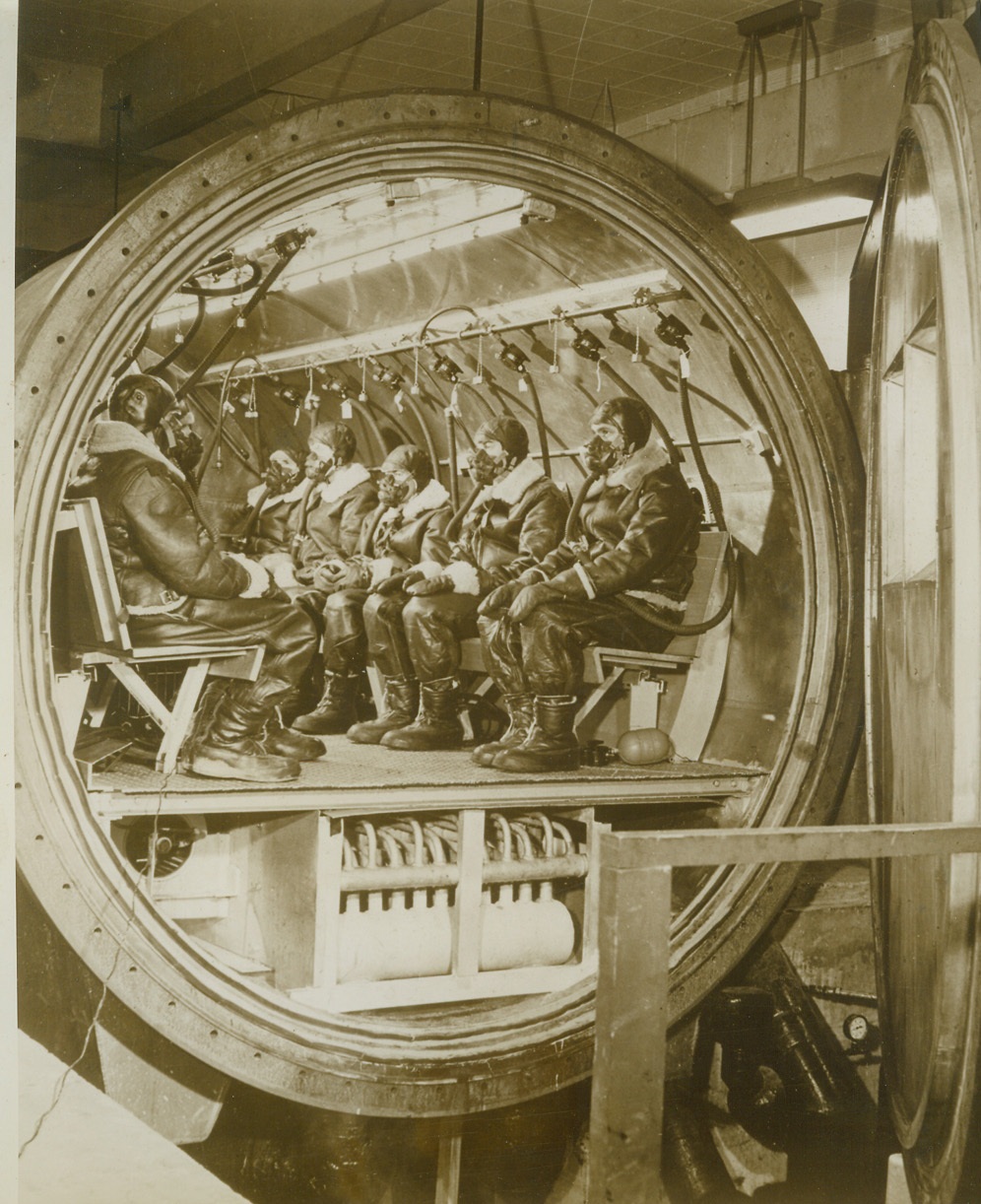
Aerial Guinea Pigs, 11/2/1943. Dayton, Ohio—Bundled up in cold weather gear and wearing oxygen masks, men at Wright Field, Dayton, Ohio, have their high-altitude reaction tested in the aero-medical laboratory. Relentless experiments to conquer the mysteries of upper-air flying are constantly being carried out in this laboratory. Credit: U.S. Army official photo from ACME;
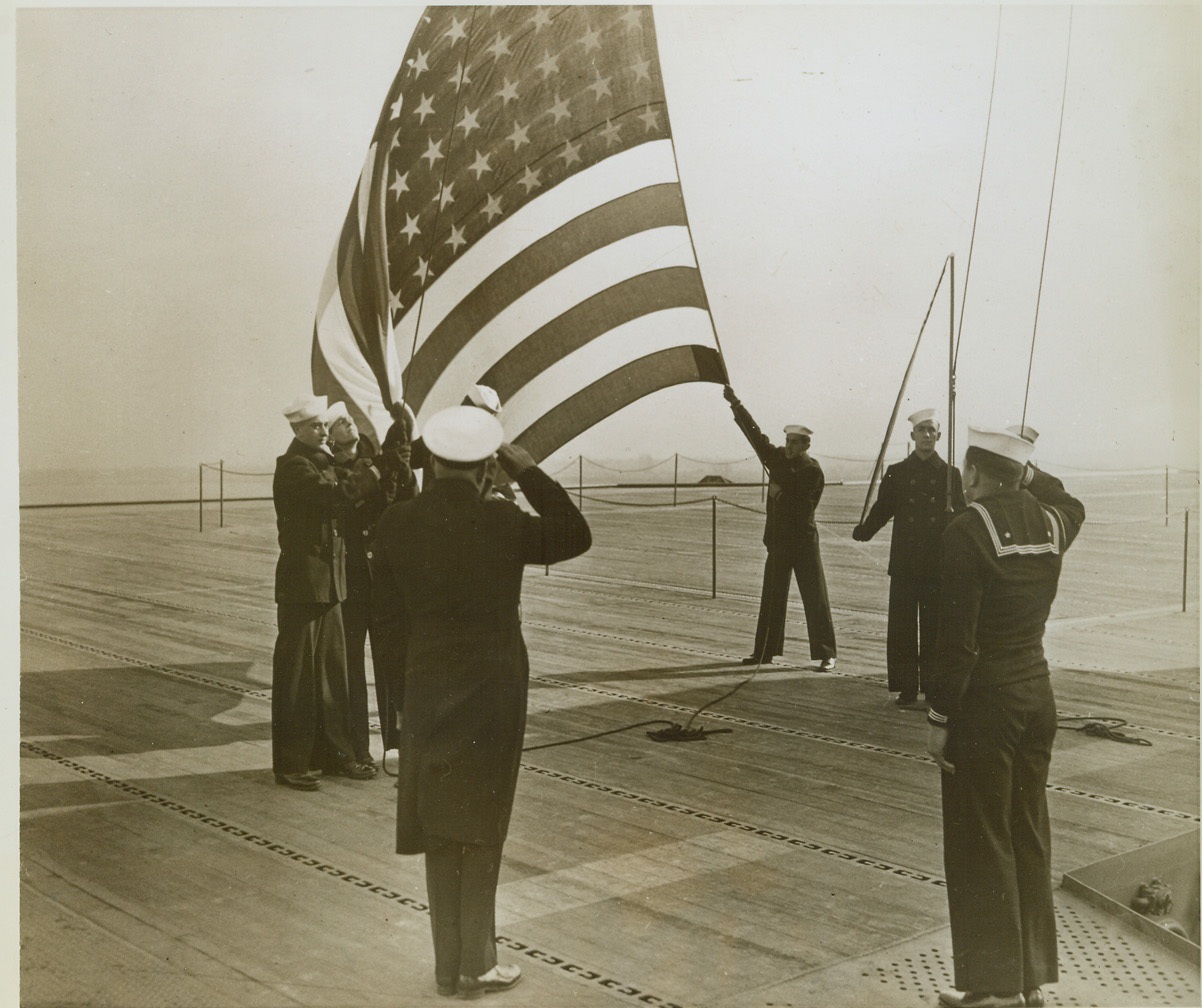
New Aircraft Carrier Honors Bataan, 11/17/1943. Philadelphia, PA.—A new carrier, named in honor of the heroes of Bataan was commissioned at the Philadelphia Navy Yard today. Ship’s officer and men raise the colors. Credit: ACME.;
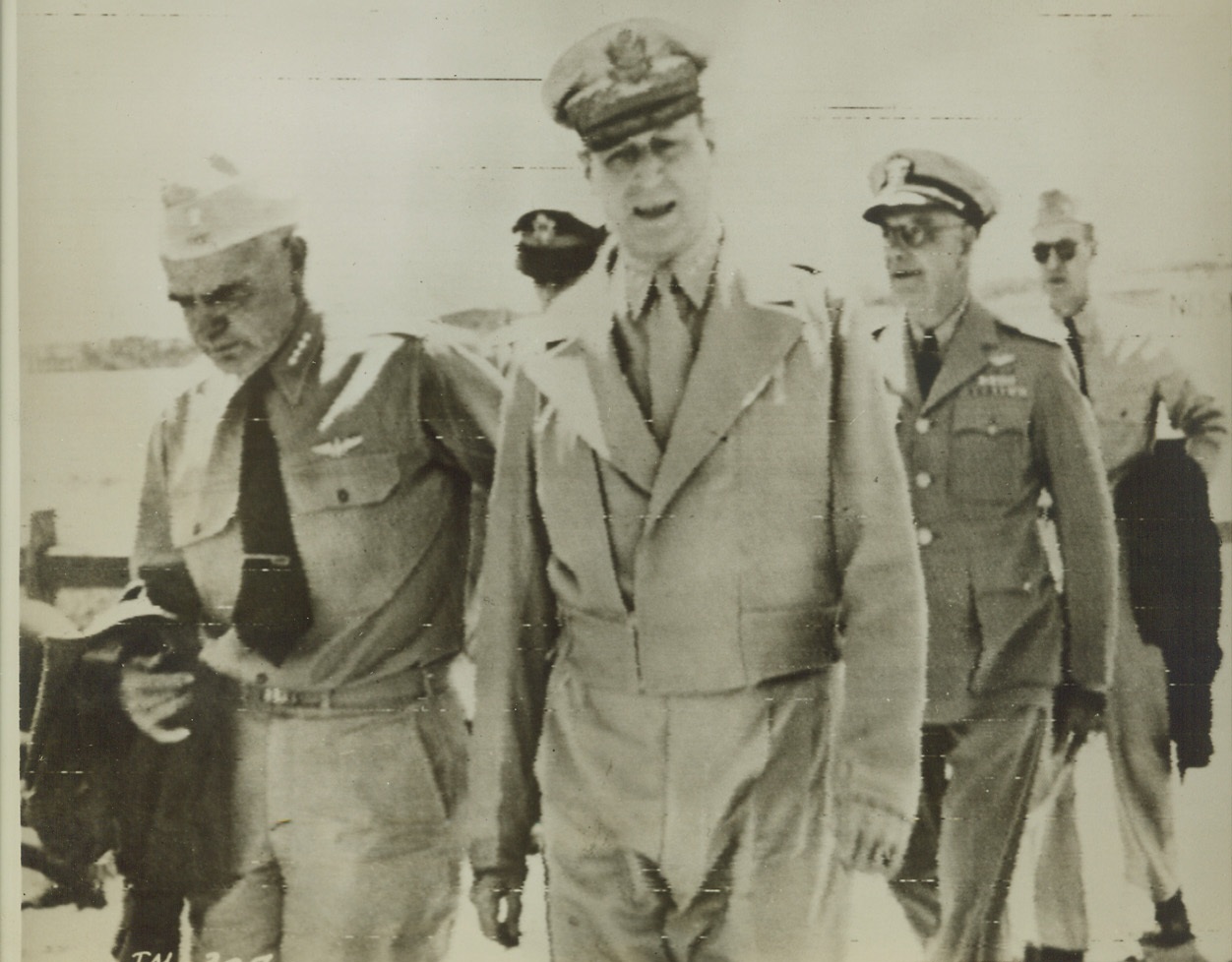
Plan More Jap Headaches, 11/3/1943. In this photo, flashed to the U.S. by radiotelephoto, Admiral William F. Halsey, Jr. (left), Commander of South Pacific Naval Forces, Gen. Douglas Macarthur, Allied Commander-in-Chief in the Southwest Pacific, and Vice Admiral A.S. Carpender, (right, behind Macarthur), Commander of Allied Naval Forces in the Southwest Pacific, are shown “somewhere in Australia,” just after Admiral Halsey’s arrival to confer on plans for the American offensive against the Japs at Bouganville. Credit: U.S. Navy photo via Army radio.;
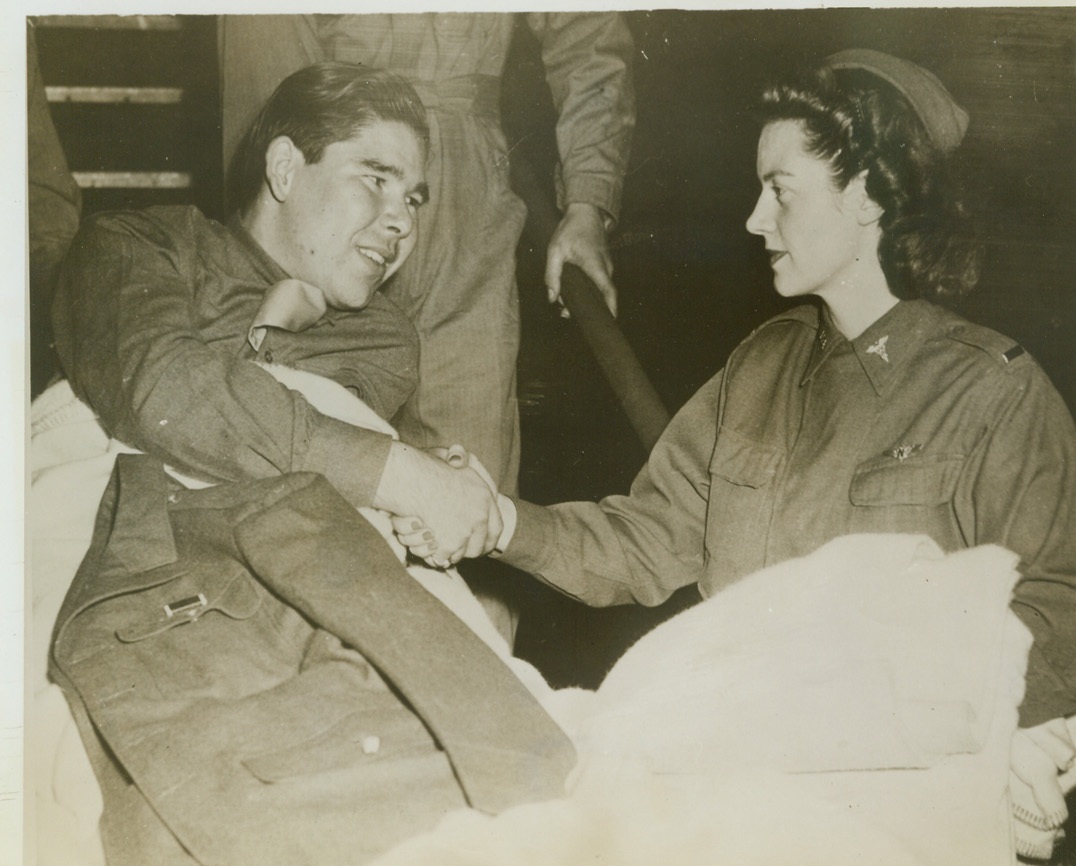
First American Wounded Repatriated From Germany, 11/3/1943. Washington, D.C.—Cpl. Rodney M. Graham, of Atoka, Okla., gives his thanks and bids farewell to 2nd Lt. L.E. Mathis, of Cape May, N.J., who accompanied the men on the trip as a flying nurse, upon arrival at Washington by plane. Graham was among the fourteen wounded American soldiers repatriated from Germany, the first under an agreement for the exchange of sick and wounded prisoners. The fighting men were then sent to Walter Reed Hospital. Credit: U.S. Army official photo from ACME.;

“RETURN TO THE FOLD” OR –“WELCOME BACK, DEAR MUSSO!” (A FARCE IN 6 ACTS), 11/30/1943. Herewith, we present excerpts from a stirring (it says here) movie film received from Lisbon, which would have one believe that Hitler’s Supermen have added an Eighth to the Seven Wonders of the World by rescuing an obviously bedraggled, and slightly motheaten Benito Mussolini from under the very guns of the Allies. Using dodges that would have utterly enthralled a modern “Tom Swift”, Der Fuehrer called in his strictly Aryan Parachute Corps, his Luftwaffe (maybe that’s where it was during the Battle of Russia!), and wound up by announcing over the German radio, with fanfare that only a Goebbels can inspire, that the great Italian leader had been “rescued” from his prison atop a peak in the Abruzzi Mountains near the village of Assergi, Italy. The “world-shattering” announcement was made last Sept. 16th, and only now, has this film been “allowed” to be “smuggled” out of Germany (Hollywood could have turned the whole thing out in a week or so!). Anyhow, here are a few scenes from the film, which bear the unmistakeable Goebbels touch and Hitlerian fantasy. “Safe, At Last!” – But this expression on the face of the once-powerful Mussolini makes one wonder if he didn’t realize that he had popped out of the “frying pan into the fire.” Credit: OWI Radiophoto from ACME;

IKE MEETS CHIPS, 11/16/1943. ITALY - Gen. Dwight D. Eisenhower, (far left), Allied Commander in the North African Theatre, is introduced to Pfc. Chips, an American dog of war, who received his stripe as Private First Class for silencing a German machine gun nest by jumping upon the Nazi who operated it. Standing over the dog at this spot on the Italian Front, is the animal’s master, Pvt. Morris Owens. Credit: U.S. Army photo via OWI Radiophoto from ACME;





 Trash & Recycling
Trash & Recycling
 Online Payments
Online Payments
 City Documents
City Documents
 Parks
Parks
 Traffic Court
Traffic Court
 CITY PARKS
CITY PARKS
 Outdoor Recreation
Outdoor Recreation
 Volunteer
Volunteer
 Home
Home TRANSLATE
TRANSLATE
